Check out the Hagerty Media homepage so you don’t miss a single story, or better yet, bookmark it. To get our best stories delivered right to your inbox, subscribe to our newsletters.

If the Indy 500 is “the greatest spectacle in racing,” serving as pace car for the race must be a marketing goldmine.
After all, a pace car is basically a rolling advertisement, driven on parade laps by a celebrity or famous athlete, and subsequently leading the procession of thundering, eager racers around the Brickyard to the green flag and during caution periods. It’s a lofty endorsement of the car’s worthiness to be on track at the same time as the real competitors. The winning driver even gets a pace car as a prize. Naturally, carmakers squeeze as much publicity out of the pace car glamour as possible. They continue that squeeze even after the race is over, offering limited edition replicas of the pace car, sprayed and stickered to look just like the ones used at Indy.
But are pace cars special just because marketing departments say they are? Do collectors buy into the “limited edition” cachet? How does the market treat them? Let’s dive into the history and explore the data.

Within the world of Indy pace car replicas there are DeSotos, Mustangs, Camaros, Firebirds, and even Fieros. Traditionally, the cars are decked out with graphics, decals, and loud paint until they’re about as subtle as a forest fire. The king of these “pace car editions,” though, is America’s sports car—the Corvette.
The Indy 500 had been around for nearly seven decades by the time Corvette was first chosen to pace the event in 1978. After that late start, though, America’s sports car has gotten more pace laps under its belt at Indy than any other model. This year, when an E-Ray will lead the field, marks the 21st time that a Corvette has served as pace car for the Indy 500.

The 1978 pace car wasn’t simply the start of Corvettes pacing the 500; it established a tradition of pace car collecting. Though Corvette celebrated its 25th anniversary in 1978, and the model got a new fastback rear end as well as a new interior, all the attention was on the pace car replica, a limited edition finished in black and silver with Indy 500 graphics. What was originally supposed to be a small batch for public consumption quickly ballooned to about one car for every Chevrolet dealer in the country. Pace car replicas comprised about 15 percent of Corvette production for the whole year.
In the end, GM built 6502 pace cars for ’78. An article in The Wall Street Journal titled “Few Want to Drive This Car, but Many Are Eager to Buy It,” touting the potential of the pace car to become a valuable collectors’ item and prompted people to snatch up ’78 pace cars for well over MSRP. Customers stuffed the cars into storage and waited for that sweet, sweet ROI.


Choosing which automobiles to buy as investments is never a sure thing, and nobody ever got rich off of ’78 Corvettes. However, Chevrolet has still released an official pace car replica for many (though not all) of the years a Corvette has paced Indy. After 1978, a few years passed before Corvette again got the honors in 1986. Chevrolet didn’t introduce a separate pace car replica but instead sold all 7315 Corvette convertibles in 1986 with Indy 500 decals, and it was up to the owner whether to apply them or not. In 1995 another Corvette convertible paced the 500, but Chevrolet again produced a separate model, this time painted in a brash purple and white and with a production total limited to just 527 units. The 1998 Corvette pace car is among the more famous, due to its almost painful combination of purple and yellow. Chevrolet built 1163 of them. The only other years in which Chevrolet sold a significant official run of pace car replicas to the public were 2007 and 2008, with 500 built for each year.



Relatively limited production and loud paint typically mean that pace car replicas sell for a decent premium over the equivalent base car, but the differences vary.
For 1978 pace cars, the difference from a base model is purely cosmetic, but the changes are significant. In addition to the paint job, each car got a full silver interior, better seats, glass T-tops, and alloy wheels. Even 46 years after all the hype, and despite not being that rare, a ’78 pace car is still worth significantly more than a “normal” ’78 Vette. Pace cars equipped with the range-topping L82 engine carry a condition #2 (“excellent”) value of $41,300, which is over 60 percent higher than a base car.


As for 1986 pace cars, things are a little different. Like the ’78 models, they’re not that rare—Chevrolet built 7315 over a quarter of production for the year. They also weren’t technically a limited edition, as all ’87 Corvette convertibles are “pace cars.” People selling one will often tout it as a “1986 Pace Car Edition,” when what they really mean is “1986 Corvette convertible.” Nevertheless, 1986 marked the first Corvette convertible since 1975, and 1986 convertibles command a slight premium over 1987 convertibles, with condition #2 values of $23,500 and $21,300, respectively.
For the purple-and-white 1995 Pace Car Convertible, production was much more limited with 527 built. Yet the premium for them isn’t huge. The condition #3 (“good”) value is $14,500 compared to $11,500 for the base car, but its #2 value of $27,800 is within a few hundred dollars of the base. The purple-and-yellow look-at-me-mobile that is the 1998 pace car also doesn’t cost all that much more than a base ’98 soft top. Its $32,800 condition #2 value is just 6.5 percent higher.


Corvette paced the 500 again in 2002, just ahead of the car’s 50th birthday in 2003. Chevrolet sold thousands of “50th Anniversary Edition” cars for the ’03 model year, all finished in a special shade of Anniversary Red Metallic over Shale two-tone leather. But Chevrolet also offered an “Indy 500 pace car” decal package to Anniversary Edition buyers for about $500. That’s a lot of money for some stickers, but they actually turned out to be a decent investment, as cars wearing them carry a #2 value of $37,100 compared to $33,000 for a regular ’03 50th Anniversary Edition.



The 2007 and 2008 Indy Pace Car replicas number 500 examples each. The ’07 Indy Pace Car Convertible carries a #2 value of $37,300 (11 percent higher than a base car), and the 2008 Indy Pace Car Coupe carries a #2 value of $42,400 (13 percent higher than a base car).
In addition to the pace car replicas you could buy at the dealer, there are the actual pace cars used for the race, which are naturally more desirable. There are also “track cars” (used by race officials and VIPs for the event) and “festival cars” (used in the Indianapolis 500 Festival Parade) that are often similar to the dedicated pace car. When the festival or track cars aren’t given out to execs or VIPs or otherwise come up for sale, they can be even more sought after by collectors than the production replicas. Some collectors are so crazy about pace cars that, for years when GM didn’t sell an official replica, they commission their own with special permission from Indianapolis Motor Speedway.



Sale prices for all of the above, though, are mixed. For example, one of three official pace cars used at the 2004 Indy 500 sold at auction last year for $38,500 and one of the Parade Cars from that year sold this January for $40,700, both of which seem low. As does the $59,400 for the 2019 Parade Car driven by Alexander Rossi. There are 2019 Corvettes on used car lots asking more than that. On the other end of the spectrum, a parade car from the 2005 race sold for $132,000 at auction this month, and one of the six official pace cars for the 2006 race sold for $242,000 at auction last year.

Since pace cars are sought out by collectors, they are sometimes sold as a collection. Back in 2018, a pace car collection of 16 Corvettes sold for $1.6M, which works out to an even $100K apiece. Which is a lot, but the group included four official track-used cars and five replicas that were commissioned by the owner and authorized by Indianapolis Motor Speedway because no official replicas were offered for those years. Another group of 18 sold at auction two years ago for $1.375M, or over $76,000 apiece. That group included two real pace cars used at the race and eight Indy-authorized replicas.
Corvette pace cars, then, are proven collectibles. They have been for over 40 years. They’re often not that rare. Their paint is often gaudy. They’re not any faster than a mechanically identical base model. But their connection to the greatest spectacle in racing, and their uniqueness, negates all that. The prices don’t lie, and we should indeed care about pace cars.
***
Check out the Hagerty Media homepage so you don’t miss a single story, or better yet, bookmark it. To get our best stories delivered right to your inbox, subscribe to our newsletters.
The post Should You Care About Corvette Pace Cars? appeared first on Hagerty Media.
]]>
Yenko is one of those storied names by that never fails to evoke strong images and stories from days gone by, at least among the bow tie and muscle car faithful. The dealership, the man, and the cars—along with the story behind them—are truly larger than life.
Though Yenko Chevrolet closed its doors in 1982, the name lives on with machines from Specialty Vehicle Engineering, itself a company with deep roots in the world of automotive performance. (Known prior to 2014 as Street Legal Performance, or SLP, they were the company behind the third- and fourth-generation Camaro SS and Firebird Firehawk, among others.) SVE’s latest Yenko-branded project, the Yenko/SC Corvette, combines looks and horsepower in that classic Yenko way but on a very modern platform.
The eighth-generation Corvette has been nothing if not polarizing to fans of America’s sportscar, but it’s nonetheless been wildly popular and has succeeded in bringing a younger audience to the model. From a performance perspective, it’s an obvious choice to get the Yenko treatment, even if the younger folks among those lusting after C8s might not be as familiar with the name. In a form consistent with older Yenko products as well as the existing lineup of Yenko/SC vehicles that SVE produces, this Corvette packs some serious performance.

The cosmetic treatment includes forged wheels and contrasting graphics that highlight the C8’s edgy styling. Like the stripes on Chevelles and Camaros of yore, these decals merely hint at the heavy work that’s been done under the hood. SVE turned the LT2 engine into a 1000 horsepower monster with a pair of turbochargers that pressure-feed the V-8 all the fresh air it can handle. To handle the boost, SVE upgraded the internals of the engine with a forged steel crankshaft, forged H-beam rods, forged 2618 aluminum pistons, ARP high strength head and main studs, CNC-ported high-flow cylinder heads with upgraded valvetrain, proprietary ground camshaft, custom intercooled intake manifold, custom valve covers with integrated oil separators, and an upgraded fuel system to support it all. According to SVE, the Tremec DCT transmission also receives upgrades, though the exact details are not in the promotional materials for the package.
It’s hard not to embrace the cool factor of a 1000-horsepower mid-engine Chevrolet—the eighth-generation Corvette already posted supercar performance metrics, so a 100% boost in power effectively makes the car a land-based rocket ship. Whether the exotic-looking C8 benefits from the nostalgic Yenko stripes is up for debate, but there’s no question that this build certainly lives up to the Yenko mythology. Pricing starts at $99,995, plus the cost of a new Corvette, of course. SVE will only build 10 Yenko/SC Corvettes in 2024 and another 50 in 2025. If you’re interested, you’ll need to head down to your Chevy dealer. This time around, a COPO form won’t be necessary.

***
Check out the Hagerty Media homepage so you don’t miss a single story, or better yet, bookmark it. To get our best stories delivered right to your inbox, subscribe to our newsletters.
The post New Yenko/SC Corvette to Pack 1000 Horsepower appeared first on Hagerty Media.
]]>
Chevy’s hybrid, all-wheel-drive, mid-engined C8 Corvette E-Ray will serve as the Indianapolis 500 pace car later this month at the hallmark event’s 108th running.
The E-Ray is Chevy’s quickest Corvette ever, with a claimed 0–60 time of just 2.5 seconds. It pairs a 6.2-liter, naturally-aspirated, 495-horse V-8 turning the rear wheels with an electric motor on the front axle that motivates the front wheels. The combined system output is a meaty 655 horsepower, and that electric drive unit alone is good for 160 hp and 125 lb-ft of torque.

We first rode in the E-Ray back in January of last year and quickly discovered that this was a very unique experience within the Corvette world. It was the first all-wheel-drive Corvette to reach production, and the first to employ hybrid tech in service of greater performance.
Then, last fall, we finally got behind the wheel of the E-Ray and confirmed that the hybrid drivetrain had serious performance potential, while also feeling like the ideal grand touring Corvette of the C8 pack.

The Artic White E-Ray should shine brightly leading the pack of speedway-spec IndyCars. It’s a clever nod from the series to choose a performance-oriented hybrid to lead the lineup, especially since the series finally announced that it will incorporate a hybrid component into the race cars’ drivetrains beginning in July.
The E-Ray will join a long list of Corvettes that have paced the greatest spectacle in racing; to date, no model has lapped ahead of the IndyCar field more than a Corvette. We’ve seen that past iterations of Corvette Pace cars have become sought-after collectibles, so we’re just warning you: Don’t be surprised if some sort of commemorative E-Ray Pace Car edition pops up at your local dealership soon after the race.
***
Check out the Hagerty Media homepage so you don’t miss a single story, or better yet, bookmark it. To get our best stories delivered right to your inbox, subscribe to our newsletters.
The post Hybrid Corvette E-Ray to Serve as Indianapolis 500 Pace Car appeared first on Hagerty Media.
]]>
I hadn’t had my ’57 Corvette long before it helped me accumulate a couple of tickets and a one-month license suspension. It was the kind of car that encouraged exuberance, and as a teenager in a car-crazy era, I couldn’t get enough of it.
Naturally, I used that enforced break from driving to modify my ‘Vette. I started by investing summer-job money in a Duntov cam and a set of solid lifters. Next came a manual gearbox. I couldn’t afford to swap in a four-speed, so I settled for a three-speed and paid a mechanic to install it and its clutch mechanism.
Then, once my license was restored and the ‘Vette was ready, a friend and I picked it up from the shop and test drove it out of town. We headed for a long, straight stretch of divided parkway with no houses or traffic where someone had painted 1/4-mile start and finish lines on the eastbound side. We wanted to try a fun run, so approaching that section on the westbound side, just cruising in third, I decided to punch it without downshifting to see how it pulled from low rpm. I was watching the road, not the speedometer, but we were likely up to 90 or so (in a 35-mph zone) before I backed off and braked for the stop at the next intersection.

When we got there, a pair of angry cops were waiting. “Do you know how fast you were going, kid?” one growled angrily. “No, officer,” I grinned, thinking they had merely heard the engine at high rpm and didn’t really have anything on me. I was not about to confess.
“We clocked you at 80,” he snarled. “Let me see your license.” It turned out they had radar hidden halfway down the road (unusual at the time) and were monitoring it from the corner. “Is that as fast as that car will go?” one officer sarcastically enquired while his partner was writing maybe the best ticket of his career. “Yeah … in first gear,” I snarked.
Before this ‘Vette, I had a well-used ’57 MGA, which was cool for school but slow, unreliable, and a little rusty. I lusted for something cooler and quicker and started threatening to trade it for an older Corvette. I even checked out a couple of not-so-cherry ‘54s and ‘55s.
My folks were not wealthy, but my father, a Nebraska farmer’s son, loved cars and was a skilled driver who had wheels as a kid. He believed his sons should, too. His affinity included Corvettes, and on a business trip to Detroit, he found this nice ‘57—a black base car with a detachable hardtop, a 245-horse twin-four-barrel 283-cubic inch V-8 and a Powerglide two-speed automatic. He talked the seller down to $1500 and brought it home. So, as a car-loving high-school senior, I ended up with the only Corvette around. Truly bad-ass!

Not only did the Corvette encourage my assertive driving habits, it also brought out my creativity, serving as a blank canvas that my teenage car-crazy self couldn’t help but personalize. When the inevitable big ticket that came after my 80-mph test run earned me a second license suspension, this time for three long months, I decided I would use the time off to customize my ‘Vette.
Growing up in the ‘50s and ‘60s, I had always had a thing for customized cars. I lusted over the best ones in magazines and built plastic car models with every cool modification I could manage. Why not apply that (questionable) skill to my own set of wheels? In those days, it was just a used sports car, not yet a coveted collectible.

I started by painting white racing stripes nose-to-tail. Then I removed every other tooth from the grille and blacked out its horizontal bar, leaving half as many teeth floating twice as far apart in the oval opening. I thought that was a good look for a toothy C1 Corvette (and still do). I also pulled off both front and rear license-plate brackets and the rear-fender chrome trim and added twin antennas, custom (’68 Olds wagon) taillamp lenses, and triple (’64 Pontiac Tempest) chrome strips in the coves. I also installed short lake pipes with removable caps, which tended to drag on driveway ramps and break off every week or two.

We didn’t have an abundance of aftermarket alloy wheels way back then, but we did have hubcaps. I tried chrome “moon” discs for a while, then switched to spun aluminum “racing” discs. Tire choices were limited to black- or whitewall bias-ply, and I didn’t have money for new ones anyway. The ho-hum, half-tread set of whitewalls that came on it would have to do.
I two-toned the orangey-red dash and seats, the latter with white upholstery paint, then paid a body shop to Bondo chrome exhaust tips into the rear fenders. Finally, I painted the inside of the trunk white and sweet-talked my visiting artist cousin into painting a cartoon skunk in there because we had christened my newly striped and customized ‘Vette “Li’l Stinkie.”

The doors and dash did look better painted white, but it wasn’t long before the paint on the seats began to crack and look awful, so I bought a set of seat covers to hide them. And the tightly restrained exhausts soon vibrated through the Bondo. Otherwise, I thought it looked pretty good. And it got a new white convertible top, which our family cat walked all over leaving indelible paw prints on it the first night it was home. I love animals but never liked that cat.

Because it still had the numerically low axle ratio that came with the Powerglide automatic, it was incredibly long-legged, good for 65 mph in first, over 100 in second and I don’t know what in third. I pushed it to 100 a couple times where I thought it was safe but had the good sense never to exceed that speed.
I even took it to the local drags one Sunday and won a trophy. It was a bit of a dog off the line, but while the other cars with their numerically high gear ratios were already in fourth halfway down the strip, Li’l Stinkie and I were cruising by in second gear just before the finish. Hilarious!
It also nearly killed me more than once. It suddenly slid sideways on a wet curvy four-lane during Friday rush-hour traffic on my way home from my summer construction job. I caught the slide and avoided getting battered, but that was a scary lesson for a teenager.
Scarier still was a near disaster on the night of my senior prom. After dropping girlfriend Marty home, I stupidly decided to try a late-night run on that makeshift drag strip. Well into second gear, a large dog suddenly appeared in my headlamps trotting down the middle of the road. I jammed on the brakes and swerved to miss it, which sent me into a series of left-right-left tank slappers.

Very fortunately, I knew enough even at 17 to understand that getting off the brakes would help me regain control, so I did and somehow avoided both the dog and the high curbs that likely would have flipped me into the puckerbrush on either side of the road. Whew!!! I was probably wearing the Sears seatbelt I had bought and installed but had no roll bar to keep the car off my head if it went belly up. Another very scary lesson—one I wouldn’t forget.
When it came time for college, my ‘Vette had to go because my dad needed the money. But my customization had badly damaged its value. “Your son pretty much ruined that car,” one dealer told him. Another who specialized in used Corvettes finally bought it for $1,200, as I recall. Years later, I encountered that guy working as a salesman at a different dealership and asked whether he remembered Li’l Stinkie. “Hell, boy,” he said, “I lost my ass on that car!”
Looking back, modifying that future classic was a major collector Corvette sacrilege, but this was an era before phrases like “matching numbers” and “period-correct” had much significance. In the moment, Li’l Stinkie embodied my car-crazy tastes, and I don’t think I’d change a thing.
***
Check out the Hagerty Media homepage so you don’t miss a single story, or better yet, bookmark it. To get our best stories delivered right to your inbox, subscribe to our newsletters.
The post Adventures in My High-School-Cool Custom ’57 Corvette appeared first on Hagerty Media.
]]>
Carrol writes:
I replaced a bad driver’s side telescoping sun visor on a 1982 Corvette. The problem I had was that the little retainer clip that fits over the spring keeps breaking (I’ve gone thru 2-3 clips) as I tried to install it. It appears that the replacement clips are thin aluminum and break easily while the old one, which I was able to resurrect, is steel. I need to replace the sunvisor again, but I need good retainer clips. Any suggestions?
Sajeev answers:
I’m gonna go out on a limb and suggest a workable replacement could be available at a hardware store, an industrial supply company (like Grainger), or one of thousands of online retailers on eBay or Amazon. All you need are some measurements from the old washer and a handy chart like this one from McMaster-Carr.

What you are looking for is called an “internal toothed lock washer” made of stainless steel, not aluminum. Stainless steel is significantly stronger, so it should hold that little spring nicely, and make your sun visor stay in its happy place against the windscreen.
So choose your hardware vendor, measure your current lock washer carefully, but feel free to buy a few different sizes if you have concerns about the accuracy of your measurements. The big concern is getting the correct outer diameter to fit into the C3’s windshield frame. The inner diameter likely won’t matter as much, because it gets crushed around the rod that holds the sun visor. Just get as close to the factory part and you should be good to go.
What say you, Hagerty Community?
Have a question you’d like answered on Piston Slap? Send your queries to pistonslap@hagerty.com—give us as much detail as possible so we can help! Keep in mind this is a weekly column, so if you need an expedited answer, please tell me in your email.
***
Check out the Hagerty Media homepage so you don’t miss a single story, or better yet, bookmark it. To get our best stories delivered right to your inbox, subscribe to our newsletters.
The post Piston Slap: (Internal) Teeth Gnashing About Lock Washers appeared first on Hagerty Media.
]]>
Back in 2007, rumors swirled about the “Blue Devil,” an even hairier and more capable Corvette than the C6 Z06 introduced a year earlier. With a name like that had and an already potent 505-hp Z06 to beat, expectations were high. But when Chevrolet turned the first C6 ZR1s loose, those expectations were met. The ZR1 badge was familiar from uber-Corvettes of old, but this was a new, massive leap forward for America’s sports car, and it wasn’t just the supercharged LS9 popping through the window in the hood that made it. The draw of the 2009-13 ZR1 has pulled in a surprising subset of enthusiasts. And while it’s never been cheap, it’s still one of the lowest-priced ways to buy into extreme performance.
By 2009, the sixth generation (C6) Corvette was in its fifth model year and selling well like the C5 before it. The taillights were still rounded—like a proper Corvette—but the chassis and powertrain had reached true world-class levels and was going to have trouble topping itself. The Z06 trim that arrived in 2006 was the lightest of all the sixth-gen cars and brought supercar performance on a budget, but despite the monumental improvements to the Corvette over the previous decade and a half, the C6 platform still had room for more power, and better handling thanks to downforce.
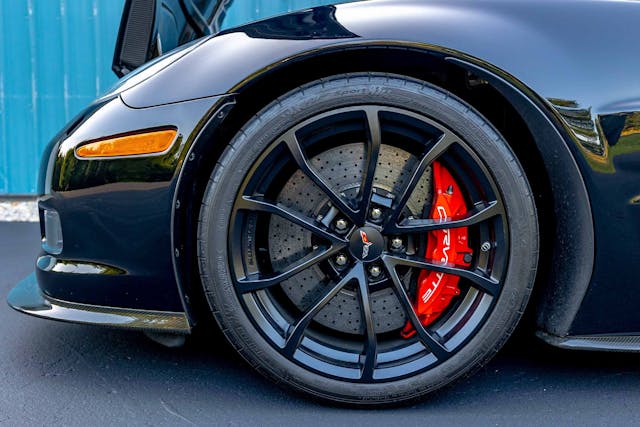


Internally named “Blue Devil” (an homage to GM CEO Rick Wagoner’s alma mater, Duke) the ZR1’s new engine was a supercharged 6.2-liter V8. The target was 100 horsepower-per-liter, but it left the factory with 638 hp and 595 lb-ft. The car could hit 60 in just over 3 seconds and top 200 mph. A front splitter helped keep the ZR1 stuck to the ground, while carbon fiber was utilized for the roof, hood, fenders and rocker moldings to keep weight down.
The power flows through a six-speed Tremec TR6060 manual transmission, which features the familiar and mildly annoying skip-shift solenoid, drivers to skip second and third gear when at light throttle and low RPM so the car could dance around the gas guzzler tax. This is easily fixed by either revving out a few hundred more RPM or installing an aftermarket skip shift eliminator that gives the driver the control over the transmission they paid for.
C6 ZR1s were incrementally improved over their production run, which wrapped with the 2013 model year. The 2012-13 cars, like this 2013 example, available on Hagerty Marketplace, sport improved seats, a new steering wheel design, other interior amenities, and slightly different gearing. Performance Traction Management, GM’s excellent stability control system, arrived in 2010.


With a base car as good as the C6, it’s not at all surprising that the ZR1 was a favorite of many drivers even if it was a slightly scary, even intimidating experience. The massive horsepower and torque numbers also lent to making the car sound far scarier than the driving experience tended to be in reality. The clutch take up is only fractionally heavier than a Z06, which combines with a long throttle pedal travel to make sure if you are only unleashing all 638 horsepower when you really want to.



The rest of the interior has a more premium feel and has aged a lot more gracefully than it’s predecessors, but that’s a low bar to beat. Overall, the ZR1 has a very similar cockpit to the lower C6 trims, with the exception of a manifold pressure gauge residing where the voltage meter sits in lower trims. It’s mainly the driving experience that will tell the driver they are behind the wheel of the top dog C6 rather than bits of flair on the dash.
And that experience, along with the raw numbers, has kept the car relevant and desirable even after a decade and a half. It’s arguably even more relevant now, at least to car enthusiasts. In just the last three years Hagerty’s insurance quote activity for the C6 ZR1 has risen 44%. Gen X and Millennials are the top buyers by generation, which goes against the stereotype of Corvettes being the bread and butter of Baby Boomers.
Our data also shows that overall values for the C6—the penultimate front-mid engine, rear-drive, true manual Corvette—have stayed relatively flat for several years, which suggests they are done depreciating. As for ZR1s, of which Chevrolet sold 4695 examples over five years, high-quality cars have seen notable appreciation while more used driver-condition examples have been fairly steady. Some perfect cars have sold for over $100K, and the original MSRP was in the low-$100K range, but currently the model’s condition #2 (“excellent”) value in the Hagerty Price Guide is $86,800. Not cheap, then, but its supercar speed combined with the ability to take to a Chevrolet dealer for service is hard to ignore. Performance per dollar has always been a big Corvette selling point. The C6 ZR1 simply pushed the performance envelope further than any Corvette before it. That, its relative rarity, and its status as the halo model for an entire generation of America’s sports car mean it never really left the Corvette conversation, and it likely never will.

***
Check out the Hagerty Media homepage so you don’t miss a single story, or better yet, bookmark it. To get our best stories delivered right to your inbox, subscribe to our newsletters.
The post C6 Corvette ZR1s Pack a Punch—and Tempting Value appeared first on Hagerty Media.
]]>
Welcome to Homegrown—a limited series about homebuilt cars and the ingenuity of their visionary creators. Do you know a car and builder that might fit the bill? Send us an email to tips@hagerty.com with the subject line HOMEGROWN. Read about more Homegrown creations here. —Ed.
The beauty of constructing a ride at home is that the builder can master his destiny from the tire patches to the roof. That’s how Hagerty member John Augelli, of Watertown, Connecticut, viewed the CORBENZ he created with his buddy Eric Strachan.
By day these two worked as police officers. In their off hours, they toiled over their homegrown ride, investing four years and $80,000 in the effort.
Augelli explains, “When this project started 25 years ago, Eric and I admired the look and feel of the Benz 280SL ‘pagoda’ but longed for the extra guts of a V-8. Simply swapping the German six for an American eight was unimaginative so we connived a more elaborate approach we christened CORBENZ.”
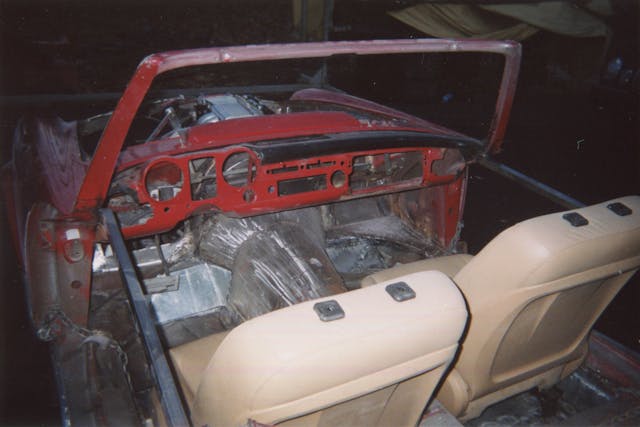
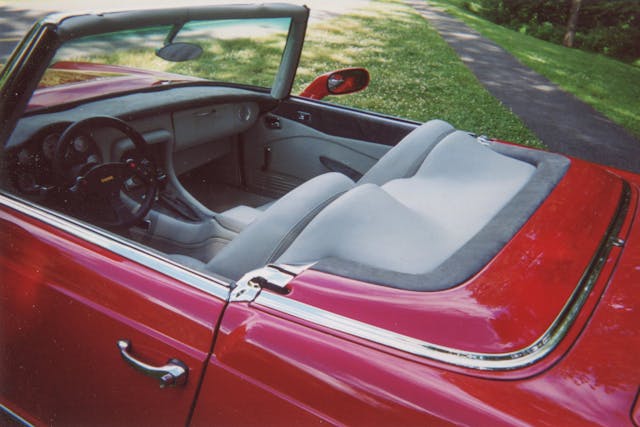

At age 16, Augelli began working on cars, starting with a rust-eradication effort on a ‘59 Ford Country Squire station wagon. “I needed $100 to fund a trip to the Cape so I pitched the repair job and earned the assignment,” he says. “After purchasing a bodywork reference book, a grinder, plastic filler, and steel wool, I went to work. Fortunately, the wagon was white so that my less-than-perfect finished surfaces looked fine. My persistence yielded a great time at the Cape.”
Thirty-five years later, Augelli had all the skills needed to collaborate with his buddy, who owned the Mercedes SL. “Our donor car was a 1987 Corvette coupe we bought at a salvage auction,” Augelli says. “Most of the Vette’s bodywork was trashed but the parts we were interested in—powertrain, frame, and chassis—were all salvageable. I focused on the labor while Eric covered out-of-pocket expenses—for upholstery, an engine overhaul, chrome plating, and the outside labor that was required.




“Picking the Corvette for running gear made sense because the C4’s wheelbase and track dimensions were close to the 1969 Mercedes we started with. Once I had whacked the lower part of the SL’s unibody structure, there was no turning back. The Corvette also had an aluminum radiator, plastic leaf springs, and aluminum brake calipers, which suited our needs. Its 5.7-liter V-8 with 240 horsepower was mated to a 700R4 automatic transmission. Our goal was tuning this custom’s personality to mimic my loud and obnoxious charm!
“Several of the tasks we faced were challenging. One was moving the V-8 engine five inches forward in the Corvette chassis. That in turn required relocating the steering linkage for clearance and adding five inches to the long aluminum beam that ties the rear of the transmission to the front of the differential. In addition, the rear wheelhouse openings had to be moved two inches to clear the 17-inch wheels and tires we added. And the original factory headlamps had to be reworked to clear our much wider engine.

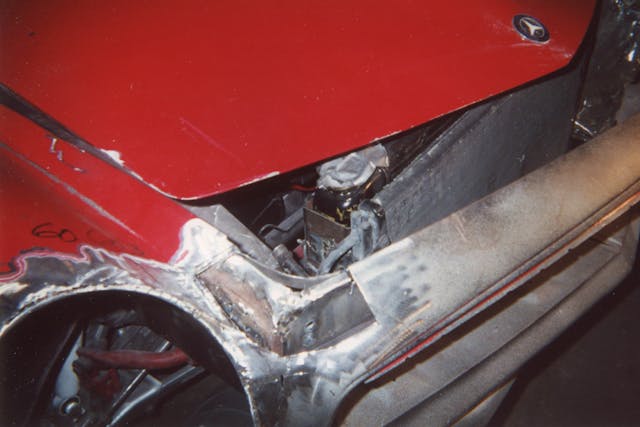
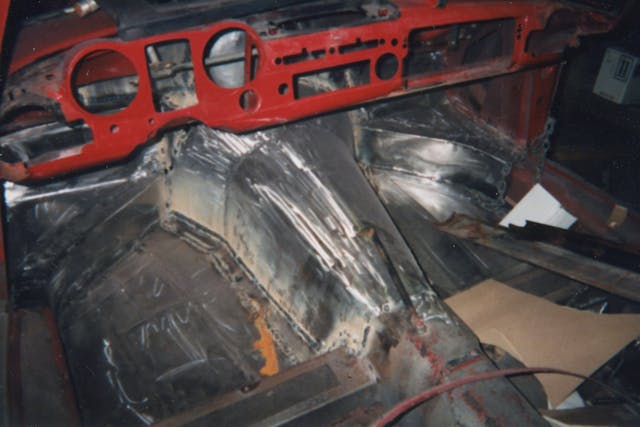




“The first test drives occurred in 2004. Practically everything worked as expected with the major exception being GM’s tuned-port electronically controlled fuel injection. After struggling with it for some time, we stripped that off, replacing it with a new more readily tunable Edelbrock four-barrel carburetor and intake manifold.

“Eric enjoyed driving our creation for several years before deciding he’d rather own the 1966 Ford Mustang GT K-code in my garage. After negotiating a swap, my wife and I drove the CORBENZ for thousands of miles. It never ceases to impress enthusiasts we encounter in traffic or at the gas station.
“Entertainment celebrity Howie Mandel once noticed this sports car in Mystic, Connecticut, inquiring if it was for sale! That Cosmos Red finish never hurts.
“Some critic once asked why I messed up such a valuable classic. My answer to him was, ‘Because I could!’”

***
Check out the Hagerty Media homepage so you don’t miss a single story, or better yet, bookmark it. To get our best stories delivered right to your inbox, subscribe to our newsletters.
The post Homegrown: The Split-Personality CORBENZ appeared first on Hagerty Media.
]]>
Say you just bought a fine-looking, Rally Red 1967 Corvette convertible. Naturally, you take it to a car show. As you’re backing into your assigned spot, a number of people gather around. You shut down the engine, and the bystanders ask you to open the hood of the Vette.
Then it dawns on you why they are anxious to see the engine. The “stinger” hood of your Corvette says the engine beneath it is a big-block 427. Your car’s exhaust note says otherwise. The attendees see the car—and you—as a fraud. And they are correct: Your Corvette’s engine is a slightly hopped-up small-block 327, but a previous owner bolted on that super-cool stinger hood and “off-road” side pipes. The car sure looks like a 427, but it is, in fact, a faux big-block … which is why you got the car for an affordable price.
This was me the first time—and every time after that—I entered my newly acquired ’67 ‘Vette in a collector-car show. I loved the look of that stinger hood but was uncomfortable with the unintended deception. I would jump out, pop the hood, and explain that it had been installed by a previous owner. I wasn’t trying to fool anyone … as if I could. That small-block ran well and sounded good—but it didn’t sound like a muscular big-block. Show-goers would nod, not saying much, and walk away, pleased to have detected and exposed fraud on the show field. Corvette collectors, I soon learned, take authenticity very seriously. As they should.

At that stage of my life, I thought I was done with the old-car hobby. I hadn’t owned an old car since the gorgeous ’67 Cadillac Eldorado I had for a while in the late ‘70s and the beautiful ’70 1/2 Chevy Camaro I had bought new, kept, and driven aggressively until I got married in 1982 and moved to California, with its high home prices (both good stories for other times). I had no more time, money, or energy for old cars and had grown tired of maintaining and working on them.
That ’67 was my second Corvette after the well-used ’57 I drove during my senior year in high school (another good story). As a busy auto writer and part-time racer, I reviewed new Corvettes and enjoyed more than a few adventures road-racing them. I sure didn’t need to own a Corvette, especially an old one.
In 1998, I founded a car show at Michigan State University that evolved the following year into the “Cars on Campus” (COC) invitational concours d’elegance. I attended shows all over Michigan looking for cars to invite to the growing event. After recruiting for most of the summer, I decided that talking to proud collector-car owners and inviting them to show their special cars at our event would be easier if I were an entrant rather than simply a spectator.
I started looking for a good collector car, and I found this relatively low-mileage, fairly good-condition ’67 (alleged) 427 ‘Vette roadster in the “For Sale” lot at a big show at the old Packard Proving Grounds in Shelby Township, Michigan. (The C2 has always been my favorite old Corvette and, for multiple reasons, the five-gill ’67 my favorite C2.)

I got the owner’s contact info and hurried home to discuss the purchase with my wife Jill, a long-time Corvette lover who happened to have a 2000 C5 convertible, wearing Michigan State University green, in our garage at the time. I was hoping she would go with me to take a good look at and drive the ’67, and, if we decided to buy it, agree to split the price and co-own the car. And she did! I can’t recall or locate any record of how much we paid for that car in June 2000, but I think it was something under $30K.
We joined the Michigan chapter of a national Corvette club and drove the ’67 up to one of the club’s events in Traverse City. While there, we enjoyed a rocking George Thorogood & the Destroyers concert at a hotel/casino and each happily pocketed the $20 the casino gave us to gamble. (We figured that driving a newly acquired 33-year-old Corvette there and back would be enough of a thrill.)
The Corvette performed well but showed some rough edges along the way. For starters, it was annoyingly noisy at freeway speeds. Yes, it was delicious, small-block, side-exhaust-V-8 noise, but the volume got old after a while. Water leaked into the cabin between the top and windshield when we encountered rain, and we had to manually pop up the headlamps at night. The brakes were barely there, the manual steering built some muscle, the window cranks were clunky, and the four-speed manual shifter was loose and cranky. At least the vertically mounted aftermarket AM/FM radio I had installed—with great difficulty—to replace the dysfunctional original unit worked fine!

Though she loves Corvettes, Jill quickly lost interest in driving the ’67. I took it to some other shows, including Cars on Campus at Michigan State, where I would park it, then busy myself running the event, thus avoiding the need to explain its faux 427 status. I decided to get its many flaws attended to by fellow journalist and friend Don Sherman. He had just restored his own (real) big-block ’67, a former drag car, and had written an excellent book about it, and he had volunteered to fix everything he could on ours for a reasonable hourly rate. I purchased a set of spiffy, cast-aluminum wheels that looked like the ’67 optional originals, along with replica redline radial tires to greatly improve the car’s look, ride, and handling, and delivered the car to Sherman’s house.
Don proved to be as good a Corvette mechanic as he was a writer. It’s too much detail to recount here, but he provided a running record of everything he did, from fixing the backup light, the pop-up-headlamps, and the door latches to adjusting the parking brake, steering, and shift linkages to installing my new wheels and tires and a new fuel tank (the original leaked), refurbishing the inside door panels, and resealing the engine oil pan to resolve some minor oil leakage.
Sherman also discovered that the car had some repaired crash damage on the driver’s side, and he communicated with the guy we bought it from to research its non-stock engine. It turned out that the car had been built with the base, 300-hp 327, but a previous owner had installed valve covers, an intake manifold, a higher-redline tach, and maybe a camshaft from an optional 350-hp engine, plus an aftermarket reproduction Edelbrock carburetor, to make it look like an L29 350. Happily, Don found that the engine block was original and its insides “fastidiously clean.”
The following May, ace auction announcer, historic car appraiser, and friend Ed Lucas, “after thoroughly examining this restored automobile and subsequently researching the information provided,” estimated our ’67 Corvette’s replacement value between $42,500 and $45,000. “It is obvious from inspecting this vehicle that it has received excellent care and maintenance and is in overall very good condition with low total mileage,” he wrote in his appraisal. “There is little or no evidence of wear or abuse.”
“Overall,” the report concluded, “the engine compartment is very clean, the exterior chrome and paint are in very good condition, and there is no evidence of underside rust… In fact, the undercarriage has been detailed… As a final point, it should be considered that this is a numbers-matching vehicle showing only 38,680 miles on the odometer.”
By then, “Cars on Campus” Concours had grown (with a great deal of work) into a very nice 200-car show on a field next to the president’s house on MSU’s beautiful campus. The event ended after 2002 when the university wanted more money and reduced its support. I was keeping the ’67 in a farmer’s barn (along with my 1991 Buick Reatta ragtop, another good story) a few miles from our home and took it out only occasionally.

One of those occasions each year was the “Rolling Sculpture” car show in downtown Ann Arbor, Michigan, where Sherman (who worked there for Automobile magazine at the time) saved a place for ours next to his beautifully restored big-block ’67 ‘Vette. They were chromatic opposites—ours red with black on its stinger hood, his black with red—and attracted a lot of attention parked there side-by-side.
We finally sold the ’67 in 2006 when we bought an early-build “captured fleet” Pontiac Solstice for a very friendly price. Hardly an appropriate substitution, I know, but I had just written a book on that model, my wife had fallen in love with it, and we were a little tired (again) of the hassle and expense of old-car ownership. Besides being a beautiful, fine-handling, fun-to-drive, and affordable little sports car, the Solstice also came with a full factory warranty.
I have no high-speed, hard-driving, or close-call experiences to relate from my time with that ’67 Corvette. Unlike in my youth, as a highly responsible adult uninterested in taking chances or collecting tickets, I drove it like the valuable collectible it was. I also can’t find or recall how much we sold it for, but (given Lucas’ appraisal), I think it was something over $40K. Not bad for a six-year run with a really cool classic Corvette, even if it was a faux 427.
***
Check out the Hagerty Media homepage so you don’t miss a single story, or better yet, bookmark it. To get our best stories delivered right to your inbox, subscribe to our newsletters.
The post My “Big Block” Corvette Got Me Back into Old Cars appeared first on Hagerty Media.
]]>
As the seasons change and rain clouds make way for fresh foliage and flowers, it’s easy to start daydreaming about open-air motoring. If you, like us, have been perusing the classifieds for a reasonably priced and fun convertible, these selections might broaden your horizon. Each can be had in #3 (Good) condition for less than $30,000, and offer a mix of performance, cruising capability, classic looks, or a blend of all three. Hopefully, there’s something here that gets your gears turning and conjuring up thoughts of top-down oceanside drives or aimless canyon exploration.
2009 Pontiac Solstice GXP

GM’s Kappa convertibles, sold in the U.S. as the Saturn Sky and Pontiac Solstice, were initially offered with a naturally aspirated, 177hp 2.4-liter four-cylinder engine. It wasn’t long, however, before Red Line and GXP trims, respectively, gave the twins GM’s first direct-injection engine, the 260hp 2.0L turbocharged LNF. GM even offered a tune and a 3-bar MAP sensor to manage more boost and net 290hp. The rare hardtop Solstice is a pricey collectible, but the convertible remains an affordable option. The car’s frequent criticism was its lack of luggage space. However, it does bring a solid chassis, sporty handling, and room for some serious rubber under those curvy fenders.
1998 Mitsubishi Eclipse Spyder GS-T

The Eagle Talon, Plymouth Laser, and Mitsubishi Eclipse offered buyers three flavors of stylish, affordable sport compact as part of the partnership known as Diamond Star Motors (DSM), named for the combined brand logos of Mitsubishi and Chrysler. Unfortunately for Plymouth fans, the Laser never made it into the second generation of the cars, which lasted from 1994-1998, and arguably had the best design. In more bad news for fans of Mopar brands, the Eagle, while available with the same powertrains as the Mitsubishi, was not offered as a convertible. The sole DSM drop-top is the Eclipse, and the GS-T is the most potent, packing a 210hp 2.0-liter turbocharged 4G63 engine.
2012 Chevrolet Corvette

C6 Corvettes are a lot of car for the money, especially the later models that ditched the 400hp, cathedral-port LS2 for the bump in displacement and better breathing of the LS3. The Grand Sport trim, with its wider bodywork, dry-sump oiling system, and track-tuned suspension, is barely out of range for this list, unless you’re in the market for an automatic. For those that insist on three pedals, the standard Corvette convertible comes in well under our price cap, and that gets you a Tremec TR-6060 six-speed manual trans, and a 430hp LS3 V-8 for a fabulous top-down soundtrack.
1971 Volkswagen Karmann Ghia

Despite sharing its underpinnings and powertrain with the VW Beetle, the Type 14 Karmann Ghia managed to look special thanks to its hand-finished body and concept car styling. Marking the end of an era, the 1971 models were the last to use thinner, more elegant bumpers. Enjoy the simple, easy-to-service Beetle drivetrain and ample aftermarket to keep this curvy cruiser running in tip-top shape for very little money.
1957 Ford Thunderbird

The final year of the first-generation Thunderbird brought exclusive styling with subtle fins that make Ford’s Jet Age taillights seem even more appropriate. Inside, a new dash pod with round gauges gave the ‘Bird a sportier look to reflect its boost in power over the previous year’s offerings. The 292-cubic inch, two-barrel V-8 base engine in 1957 is even more affordable, but we picked the 245hp four-barrel 312 version for our list. Both the dual-quad 312 and the supercharged 312 demand a lot more money, but a resourceful hot-rodder could tune up any of the Y-block V-8s to be plenty of fun, fun, fun.
1969 Mercury Cougar XR-7
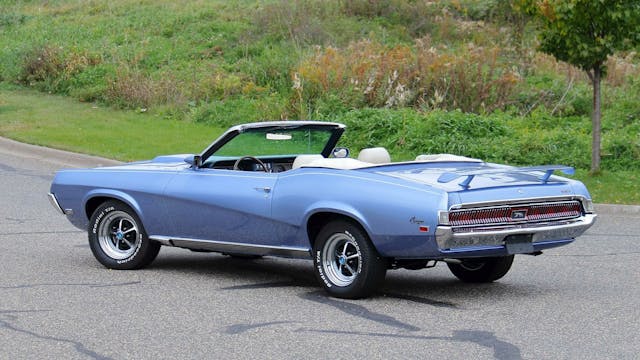
In 1967 and 1968, Mercury’s upscale pony car still had obvious Mustang roots. In 1969, things changed. Despite sharing a platform and powertrains with the Mustang, the Cougar looked like a different beast entirely, particularly in convertible form. As opposed to the Mustang’s quad-headlight front end, the Cougar’s hidden headlights were a preview of the 1970 Montego. The Cougar is a rare sight compared to a Mustang and its sweeping lines and muscular haunches make it an underappreciated example of Mercury’s muscle car-era styling. We picked a four-barrel, 351-powered example, which should provide ample power for top-down cruising. Both the 390 and 428 engine options fall outside our price range, but that’s OK, as we’re not drag racing with the top down anyway.
1987 Morgan 4/4

Speaking of drag racing, aside from the air-cooled VW, this Morgan is the least likely to show up at your local NHRA test-and-tune to go heads up against the local hotshots. That’s just not its scene. Packing 96hp, this minimalist machine is hand-built for the kind of top-down motoring exemplified by Pre-War British roadsters. Morgan just kept making them that way. Narrow, close to the road, and with the wind whipping around you and the engine buzzing, normal speeds will feel like race pace. The Ford Kent 1599cc crossflow engine was produced for decades and was used in several forms of motorsport worldwide, so there’s no shortage of knowledge and parts available.
***
Check out the Hagerty Media homepage so you don’t miss a single story, or better yet, bookmark it. To get our best stories delivered right to your inbox, subscribe to our newsletters.
The post Dreaming of Summer: 7 Convertibles for Less than $30K appeared first on Hagerty Media.
]]>
While the C8 Corvette already comes in varying levels of heat, the famous ZR1 moniker has yet to make its appearance on the mid-engine sports car from Chevrolet. That all changes this summer, when the next ZR1 will be unveiled. Until then, Chevrolet gave us a teaser video to whet our appetites.
While the alphanumeric made its debut in 1970, the ZR1 has been the flagship Corvette since the 1990 model year. The engines of ZR1 models have always been heavily enhanced, so we’re expecting nothing less from the newest iteration. Expectations are high for good reason: The base Stingray has 495 horses, the E-Ray hybrid a combined 650, and the Z06 670 ponies behind the passenger cabin.
We can only speculate about what we’ll see this summer, but we know the ZR1 will use a DOHC V-8, as in the good ol’ days of the C4: It might even use the flat-plane-crank LT6 architecture from the current Z06. Forced induction is all but guaranteed. We expect twin turbos, changing a precedent set by the last ZR1, whose powertrain was supercharged. Hybridization is unlikely in the upcoming ZR1; besides the E-Ray, a hybrid system will likely be reserved for the Zora, a 1000-hp beast of a C8 that is supposedly still in the works. Will the new ZR1 be the most powerful, and last, gas-only Corvette? Smart money says yes.
Expect the ZR1 to have more power than the Z06—probably 850 hp or so, delivered via a wholly unique driving experience. Watch this space for updates as we get them.
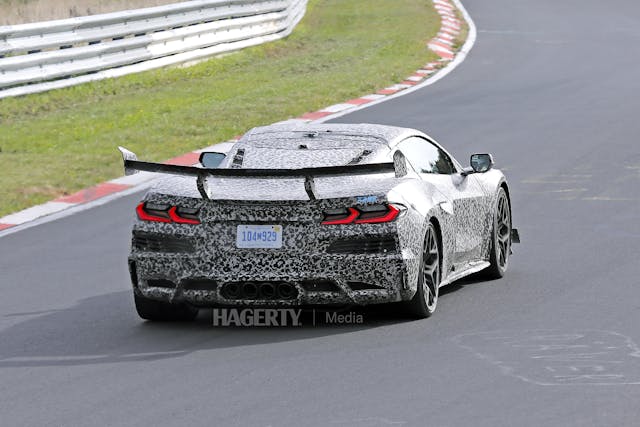



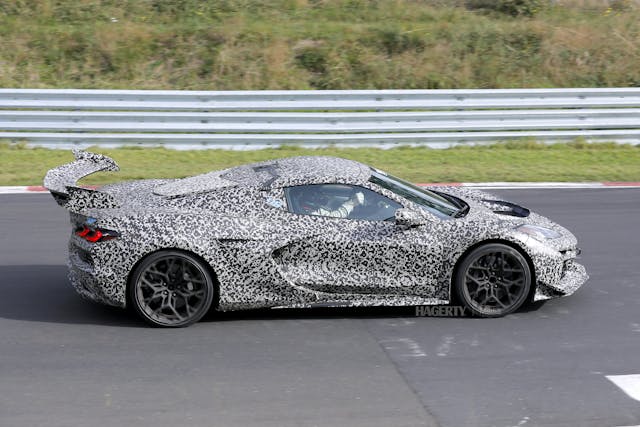
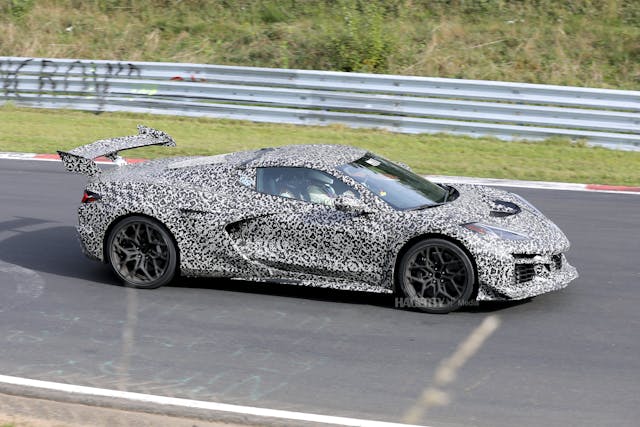
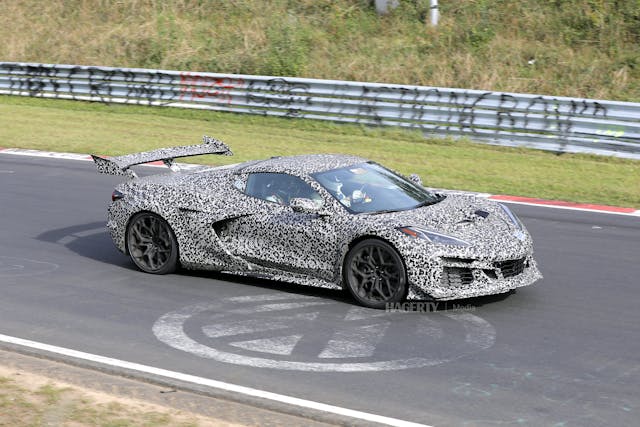


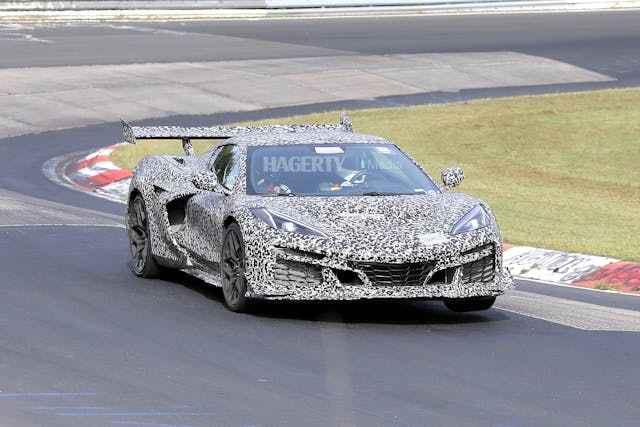

***
Check out the Hagerty Media homepage so you don’t miss a single story, or better yet, bookmark it. To get our best stories delivered right to your inbox, subscribe to our newsletters.
The post It’s Official: New Corvette ZR1 Arrives This Summer appeared first on Hagerty Media.
]]>
The Corvette has been “America’s sports car” for decades but like anything, some versions are more coveted than others. Preferences are part of nature but certain expectations come with a title like America’s Sports Car; mainly, that the car will indeed be sporty. Lingenfelter has long been one to help ensure that, and its latest set of upgrades for the C8 has finally made the midengine Corvette acceptable in my eyes.
Every good Corvette needs an engine displacing 427 cubic inches. The 427 has been an off-and-on again option since 1966, when the first 427 big-blocks were dropped between the fiberglass fenders on the assembly line in St. Louis, Missouri. The on-again, off-again relationship with the sacred seven-liter was worth celebrating multiple times, but the direction in which Chevrolet has indicated it is headed with the eighth-generation Vette means that any hopes of listening to a 427 lope through the quad exhaust of a C8 is a pipe dream.
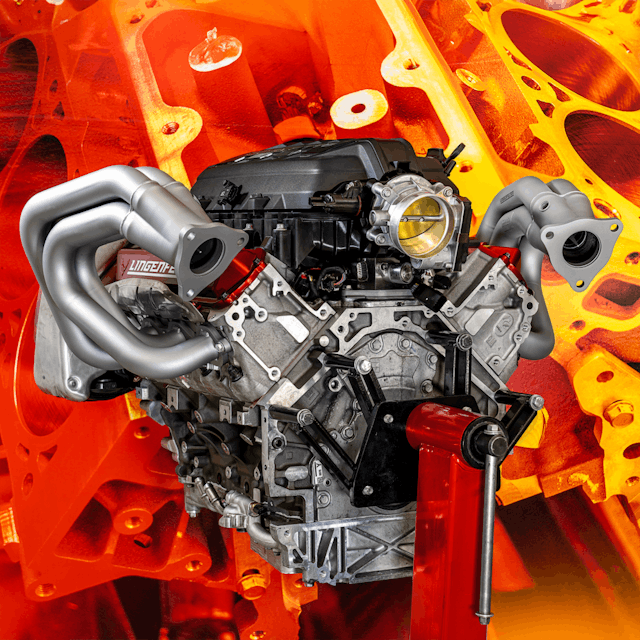
The team at Lingenfelter decided that couldn’t be and created the “Eliminator Spec” 427, which is drop-in ready for the C8. The engine is based on the LT2 that can already be found in the C8, and displacement is bumped from 376 cubic inches to the magic number by re-sleeving the block, swapping the crank, and tapping in a set of 4.125-inch Mahle pistons. Thanks to some cylinder head porting and a custom camshaft from COMP Cams, the naturally aspirated package makes a smooth 700 horsepower and 600 pound-feet of torque while still playing nice with the stock, eight-speed DCT.


The package requires you to stroke a check for just under $30,000, but the price does include installation, so you aren’t left with a cheap engine hoist and your friend’s set of box wrenches. Is it the cheapest way to make 700 hp in a C8? Probably not. Lingenfelter’s reimagined LT2 also puts out just 30 more horsepower than the LT6 in the Z06, and you don’t get the extensive chassis and brake upgrades of that flat-plane monster. Sometimes numbers matter, though, and for some Corvette faithful those numbers are 427.
***
Check out the Hagerty Media homepage so you don’t miss a single story, or better yet, bookmark it. To get our best stories delivered right to your inbox, subscribe to our newsletters.
The post The 427 Corvette Is Back, Thanks to Lingenfelter appeared first on Hagerty Media.
]]>
If you were skeptical that the Corvette got soft when it went hybrid, the results of the first third-party dyno session with the E-Ray will convince you of the answer: Definitely not.
True, the driveline of the 2024 Corvette E-Ray pairs a familiar V-8 engine (the LT2) with an electric motor, and a 1.9-kWh lithium-ion battery is tucked under the center console. But the motor and battery are only good for four miles of driving range, and you can’t charge the battery with an external plug. The decision to add an electric motor, which powers the front axle, was a creative way to get more power output and greater traction, which together generate quicker acceleration. Fuel economy, if you’re wondering, doesn’t improve at all over the regular Stingray, which lacks the electric motor: Highway mileage is actually lower, by 1 mpg, according to the EPA estimate.
Those weren’t the numbers you really wanted to know, though.

Okay. Chevrolet advertises the total output of the engine plus motor at 655 hp (measured at the crank, as most manufacturers do) and 595 lb-ft of torque. Of course, we all wanted to verify those for ourselves, and we finally can, thanks to one E-Ray owner named Steve (thanks, Steve!) who sent his Torch Red E-Ray to the GM performance specialists at Paragon Performance in Waukee, Iowa, for a dyno sesh. Being a conscientious owner, he had them drive the car from Kansas City to Waukee so that the engine got its mandatory 500-mile break-in period before running at full throttle on Paragon’s dyno.
Paragon was particular about setting up its dyno: The technicians linked the front roller to the back one with a giant belt to replicate real-world conditions, to which the electric motor and the engine would both contribute maximum power.
The results? 573 wheel horsepower—less than the factory number, as you’d expect, due to driveline losses—but 630 lb-ft of torque: 35 more than stock, even with those same losses.
We see you, Chevy …
Paragon didn’t stop there, of course. Graham, the host of the recorded session, walks us through the graphs, comparing the power curves of the E-Ray (in red) to those of the base car, the Stingray (blue), and to those of the track-focused Z06, which uses a different V-8 (the flat-plane-crank LT6) and no electric motor. The Stingray and the E-Ray are more comparable in mission and focus than the E-Ray and the Z06, so Graham starts there:

You might expect the electric motor to present as a more marked spike, but even as the motor reaches its maximum rpm, and as the heat generated by that motion begins to sap its power, the E-Ray makes more power than the base car through the entire rev range, including at redline, where it makes 100 more horses (at the wheels). From 2000 through about 4200 rpm, the hybrid Vette makes 200 more lb-ft than the base car, thanks to that electric motor. And Chevrolet only quoted the E-Ray’s electric motor at 160 hp and 125 lb-ft, measured at the crank!
Unsurprisingly, the Z06 (green) upstages both its siblings: After 6500 rpm, the horsepower curve generated by the flat-plane-crank model just keeps going, up to its redline of 8500 rpm.

It’s safe to say that the Corvette became a hybrid in the name of performance and power. Chevrolet’s reasoning will be further proven by the upcoming Zora, which is expected to combine the flat-plane-crank LT6 from the Z06 with two turbochargers (the combo that will distinguish the ZR-1) and an electric motor for the front axle. Steve, the owner of the E-Ray you see here, is putting his own spin on the formula: From Paragon Performance, this E-Ray will go to Wixom, Michigan, home of Corvette tuning shop Lingenfelter Performance, to receive its Magnuson supercharger kit. Thus blessed, the E-Ray will return to Paragon for another dyno sesh.
We like how you roll, Steve.
***
Check out the Hagerty Media homepage so you don’t miss a single story, or better yet, bookmark it. To get our best stories delivered right to your inbox, subscribe to our newsletters.
The post The Corvette E-Ray Makes Even More Torque Than You Think appeared first on Hagerty Media.
]]>
Wolves howl in the forest while on the hunt. So do car guys when they sense they may make a killing. That could explain why, during the run-up of classic Corvette values in the early 2000s, my friend Scott Young and I bought this 1964 convertible sight unseen. Reportedly built by a Milwaukee enthusiast in 1968, the “Executioner” competed at the strip and in regional International Show Car Association (ISCA) shows. Ultimately, however, the radical customizing turned a low-mileage 300-hp, four-speed Sting Ray into a nearly unsaleable oddity. We just didn’t know it yet.
Popular in the early 1960s, straight-axle drag conversions meant surgically altering the frame, and so began the journey of this genial Daytona Blue roadster into a medieval menace. Sawed off and discarded was the independent front suspension—a real value loss. In showboat tradition, chromed parts included the requisite tubular axle, steering box, and control arms. Revealing the brightwork were 12-spoke American Racing spindle-mount mags. Chrome likewise found the traction bars, the rear transverse spring, the driveshafts and control arms, the wheelie bars, and the push-bar (fashioned like an executioner’s axe).

Over the stock Daytona Blue, Milwaukee painter Butch Brinza applied a candy blue finish, which used fish scales to create a shimmery pop. The Corvette’s original blue vinyl interior ceded to diamond-tufted navy seats, floormats, door panels, and hardtop, which also sported a ventilated Plexiglas backlight. Still more chrome graced the rollbar, fire bottle, and butterfly steering wheel. All in for the win!
The once-mellow 327 had been stroked to 370 cubic inches and wore a chromed side-by-side manifold topped by dual quads and chromed scoops. Early in our stewardship, it vehemently resisted starting; something was afoul with cam and/or ignition timing. You’d swat the pedal and turn the key, and the engine would backfire dramatically. The predicament broke three starter motors, and once, a flame-front bigger than Krakatoa nearly torched the ceiling. Ultimately, a visiting friend requested a 9/16-inch wrench and reset the distributor. Thereafter, the Executioner started fine.

Driving that thing anywhere was another matter. Every couple of miles, the engine surged and stopped, then mulishly refused to restart. Looking back, I suspect the root was a clogged fuel line or filter, a tired pump, a plugged gas-cap vent, or some similarly easy issue. But when you don’t have a clue, you’re clueless. Ultimately, after nursing the Executioner to 20,458 miles, we tapped out. Naturally, selling that car was equally difficult. “We were the only ones who didn’t make money on a Corvette!” Scott joked. Yep, we were those guys.
No wonder—our execution was fatally flawed.
***
Check out the Hagerty Media homepage so you don’t miss a single story, or better yet, bookmark it. To get our best stories delivered right to your inbox, subscribe to our newsletters.
The post How a Medieval Midyear Corvette Killed Our Plan appeared first on Hagerty Media.
]]>
In 1994, the same year that Ayrton Senna left this mortal coil, the Channel Tunnel connected the United Kingdom to France, and Dale Earnhardt won his seventh and final NASCAR Cup championship, the National Corvette Museum in Bowling Green, Kentucky, opened its doors. The Corvette had just celebrated its 40th anniversary. That spring, the plant in Bowling Green had delivered 25 special convertibles to Indianapolis Motor Speedway for the inaugural running of NASCAR’s Brickyard 400. Around 23,000 copies of the 1994 model year Corvette, the third-to-last model year for the long-running C4 generation, would leave Bowling Green for garages around the world.
Today the C8, midengine Corvette is in its fifth model year of production. More than one team is campaigning the successor to the C8.R GTE, the Z06.R GT3, in the 2024 IMSA Weathertech Sportscar Championship, and the National Corvette Museum is preparing to celebrate its 30th anniversary in late August of 2024. Earlier this year, I interviewed Sharon Brawner, president and CEO of the museum from 2021 to 2024, to talk about the big milestone and to hear her thoughts on where America’s Sports Car is going next.

First, we had to discuss another, less happy anniversary for the museum: The sinkhole disaster on February 12, 2014.
“There are folks who still always ask about [the sinkhole], or [the sinkhole is] how they know about the National Corvette Museum,” said Brawner. “It’s kind of a double-edged sword. It’s one thing that [the sinkhole] put this museum and Bowling Green on an international stage. On one hand, that’s a benefit. On the other, it’s obviously a negative, too. Tragedy, unfortunately, does seek attention.”
According to Brawner, the 1980s-1990s technology used in the initial geological survey determined that all would be well for building the museum. Hindsight, of course, is 20/20, and if today’s tech had picked up on the limestone formations under the museum’s Skydome—which would collapse, swallowing several one-of-a-kind Corvettes 20 years after the museum’s opening—plans would have been made to build elsewhere.
“The museum tried to do everything that it could at the time to allow people to learn more about this museum and our collection and what we do here, even in the face of a tragedy,” said Brawner. “The [staff] did a tremendous job not letting it define us, but at the same time, taking advantage of it.”
When she took the reins in 2021, Brawner’s mission was to make clear that while the sinkhole disaster is a part of the museum’s 30-year tale, it’s not all that the museum is. To emphasize this stance, she organized a limited-engagement exhibition, named “Ground to Sky: The Sinkhole Reimagined,” which will be open through the summer, starting on June 14, 2024. This new exhibit covers the last decade since February 12, 2014, with an emphasis on what the museum, and the model that it celebrates, have accomplished in the last 10 years.

“If you know anything about Corvette history, then you certainly know the name Zora Arkus-Duntov,” said Brawner. “Zora started dreaming of a mid-engine Corvette back in the ’50s; this is not a new idea. It took many decades to find the right time and the right engineering prowess to pull off a very competitive, high-performance Corvette with a mid-engine [placement]. It’s not really all that surprising to all of us following [the car’s] history; it was really just a matter of time. And I think that when GM did it, they did it very well.”
Another evolution of the Corvette is in showrooms now: the hybrid E-Ray. Though this new Vette’s hybrid system is tailored more for performance than for fuel conservation, the fact that it’s a hybrid at all is more than a sign of the times, especially in light of General Motors’ push to convert its portfolio to battery power. Is it only a matter of time until the Corvette goes fully electric? And if so, when?
“I’m not privy to anything more than the general public is as far as how [the Corvette] will continue to evolve,” said Brawner. “I think that, from a historical perspective, how the car continues to develop in its engineering and design prowess is exciting for us as we make sure that we’re marking these historical moments, that [the museum] will allow our guests to understand what it means when these things happen with this car.”



The 30th anniversary celebration of the National Corvette Museum will have plenty to offer fans of America’s Sports Car, starting with the Corvette Caravan. Brawner says the museum is expecting 8000 Corvette fans from around the world to make the pilgrimage to southwestern Kentucky; if its predictions are accurate, the crowd will be the largest the museum has ever seen. Entertainment will feature a few country artists to be announced at a later time, while all sorts of celebrities from the Corvette world are expected to be in attendance. The city of Bowling Green will be a part of the 30th anniversary extravaganza as well, according to Brawner, with related events taking place away from the museum.

“This is a very important time for folks,” said Brawner. “They take off and make this their big summer vacation. We need to make sure that we’re really rising to the occasion to give them a variety of exciting events and activities to take advantage of. I can remember when the museum opened. I remember the thousands of Corvettes all up and down I-65, and what it meant to the people who love this car. There are many museums in this country that never see 30 years. This is a proud moment for this museum to boast that it’s been here for 30 years and going strong.”

We would be remiss to not mention another historical milestone for the National Corvette Museum: Though she has since moved on from her role as president and CEO of the museum, Sharon Brawner is the first woman to hold that position, having originally come over from the Country Music Hall of Fame and Museum in Nashville, where she spent nearly two decades before her appointment to the highest role at the National Corvette Museum. She may be a native of Kentucky, Brawner never thought she’d leave Nashville for Bowling Green, but COVID-19 changed her path.
“COVID changed a lot of things for a lot of folks, and I felt like it was time for me to take a break,” said Brawner. “I didn’t have a position when I left my tenure at the Country Music Hall of Fame; I just needed a break. I needed to move away from being in charge of so many things and lots of responsibilities. I needed to recharge. I actually left my position with no idea of what I was going to do.”
For six months, she spent time with her family. She celebrated the birth of her granddaughter in May of 2020 and, upon the passing of her father in 2019, moved her mother in with her and her husband. While she was bonding with her family and thinking about what would come next, the National Corvette Museum’s search team came calling. The opportunity was not one to pass up for Brawner, who had interviewed for several other positions, including the big one. After a lengthy interview process, Brawner became the museum’s fourth president and CEO in September 2021.

“I am very proud of [being the museum’s first woman CEO],” said Brawner. “I’ve had several steps in my career where I had been the first woman to do something, and I enjoy that. It’s not something that I have on my list of things I have to accomplish. I was the first woman to run an arena football team. I was the first woman to run a Triple-A baseball team. And I was the first woman to run this museum. Not many women run museums, period.”
Though some were skeptical about Brawner’s appointment, with some cynicism thrown in about her being just another big diversity hire, she says those concerns fell by the wayside due to her not only being a museum professional but also being a dyed-in-the-wool Corvette fan; she owns one and has grown up around America’s Sports Car. She has visited the museum frequently over the decades, starting with Opening Day back in 1994, when she attended with her father.

“One of the most interesting things about this museum is that we just continue to keep growing,” Brawner said. “We opened NCM Motorsports Park 10 years ago. Fifteen years ago, we opened our own insurance agency for collector cars. And the museum is 30 years old. What I can tell you is that this organization is not through growing. We continue to talk about future campus plans for this place. We’ve been fortunate and thoughtful enough to acquire land around the museum so that we can have future growth, whether it’s during my time as president and CEO or if it’s the next one.”
If you’re one of the thousands of fans headed to Bowling Green this summer in your beloved Corvette, make sure to tip your crossed-flags baseball cap to Brawner, who helped organize the party for America’s Sports Car—and the museum that holds its legacy.
***
Check out the Hagerty Media homepage so you don’t miss a single story, or better yet, bookmark it. To get our best stories delivered right to your inbox, subscribe to our newsletters.
The post National Corvette Museum President Talks Sinkhole, C8, and 30th Anniversary Celebrations appeared first on Hagerty Media.
]]>
As far as getaway cars are concerned, Chevrolet’s mid-engined C8 Corvette would probably acquit itself well. The raw American power from the LT2 V-8 and that agile chassis would certainly give you a decent chance of outrunning Five-Oh, if such a crisis presented itself. (Let’s get this out of the way: Don’t run away from the police.) However, if your getaway Vette happens to be chained to a 53-foot car hauler … along with nine other C8s … all still wrapped in delivery packaging … well, that would complicate things a bit.
According to a Facebook post from the Cochise County Sheriff’s Office, Twenty-three-year-old Isaiah Walker of Lawton, Oklahoma, was arrested on Thursday for multiple felony charges after he stole a semitruck and car hauler trailer laden with ten C8 Corvettes. Walker encountered the truck and trailer on Thursday at a Love’s Truck Stop along Interstate 10 in Wilcox, Arizona, just east of Tucson.
According to the driver, whom police say was the person who phoned in the theft, Walker talked to him for a bit but then pulled him out of the cab and climbed in himself. Walker then locked the door of the truck and drove the carrier out of the lot himself, according to police.
A chase ensued after a deputy from Cochise County located the truck a few miles away. According to police, Walker began to drive the truck recklessly once he realized he was being pursued, causing other vehicles to leave the roadway. A short while into the chase, the truck pulled over and stopped, and Walker was taken into custody by the deputy and another police officer from Wilcox.
Police say Walker “admitted to stealing the vehicle and advised that the Corvettes were not the reason and that he needed a truck to get home as he had just been released from prison.” It’s unclear whether or not Walker had just been released from prison when he stole the semi, but he has now been booked into the Cochise County jail for robbery, 11 counts of theft of means of transportation, and felony theft.
“I am extremely proud of the officer and deputy involved in this investigation,” said Wilcox police chief Dale Hadfield. “The deputy and officer showed great restraint and patience in bringing a serious crime to a peaceful resolution, all while keeping the property of others from being damaged. The stolen vehicle was safely recovered without damage and was released to the driver so he could continue his delivery.”
***
Check out the Hagerty Media homepage so you don’t miss a single story, or better yet, bookmark it. To get our best stories delivered right to your inbox, subscribe to our newsletters.
The post Semitruck Full of Corvettes Fails as Getaway Vehicle appeared first on Hagerty Media.
]]>
At Barrett-Jackson’s marquee Scottsdale auction last month, two trends stood out. They both have to do with custom cars. First, the sheer quantity of customized vehicles was overwhelming. Second, the customs consistently brought more—sometimes much more—than their stock year/make/model counterparts, even ones restored to factory specifications. Tradition dictates that modifying your car doesn’t add value to it and indeed often detracts from its value. The results at Barrett-Jackson, particularly for several vintage Corvettes, seem to fly in the face of that tradition.
First, some background. The term “custom car” has evolved over the past twenty years. In the past, it referred to re-imaginings in the tradition of Ed “Big Daddy” Roth. They were extravagant, fanciful, and creative. They displayed little of the original car they claimed as a starting point and nodded more to cartoons than to anything seen on the roads of the real world. Over the past couple of decades, those customs have merged with a new and increasingly popular category called “restomod.”

Coined by the team at Barrett-Jackson—Craig Jackson, Steve Davis, and Gary Bennett—in the mid-2000s, restomod refers to cars that are mostly stock-appearing on top (aside from a lower stance and large modern wheels) but have completely new underpinnings. Twenty-first-century drivetrains, upgraded suspension and brakes, and comfort features like modern air conditioning are the main ingredients. The end product is supposed to feature the performance, safety, and reliability of a new car while retaining the style and presence of a classic. These make up the majority of “customs” today, which have little connection with the creations of “Big Daddy” Roth.
Where buyers buy, builders build. For buyers and builders of restomods, Barrett-Jackson Scottsdale has increasingly been the go-to auction event. This has set up a contrast between the “customs” and their restored, stock-configured counterparts. The customs are winning the battle of the bids, and they were ubiquitous at WestWorld.
Custom Corvettes were particularly abundant, and two pairs exemplify the contrast between factory-correct and thoroughly customized. The customs are fresh, professionally built, and gorgeous, but the restored cars aren’t slackers, either, and both the stock Corvettes sold at prices appropriate to their condition, options, and documentation. In each case, though, the customs won out by a large margin.

First, the pair of 1958 Corvettes—Lots 1108.1 (stock) and 1338.1 (custom). Lot 1108.1 was a factory-correct black-over-blue car with a 283 cubic-inch, 270-hp dual-quad engine, four-speed manual, hardtop and soft top, heater, and radio. An older restoration, it showed some age and miles but was still close to showroom condition. It sold for $220,000.

Lot 1338.1, meanwhile, was painted in Cashmere over Linen leather and although it had a 1958 Corvette VIN, the chassis underneath was a modern frame by noted builder Art Morrison. It also featured a 6.2-liter LT1 engine from a 2023 Corvette as well as an automatic transmission, adjustable coilovers, 19-inch alloy wheels, Wilwood disc brakes, and air conditioning. Aside from some fit issues with the windshield and door posts, it was a gorgeous, comfortable, and surely exhilarating ride. It sold for $440,000—double the final price of the factory-correct ’58.

Then there were the 1963 coupes, lots 1363 (stock) and 1363.1 (custom). Lot 1363 was a Sebring Silver over black vinyl split-window coupe restored to like new. Not only that, it was a rare Z06 Competition model, which in 1963 got you a 327 cubic inch, 360-hp fuel-injected engine, Positraction rear end, heavy-duty shocks, larger front anti-roll bar, and upgraded brakes. It was Bloomington Gold certified and has been awarded NCRS Top Flight. A genuine Z06 is among the most valuable early Corvettes, and this one sold for $330,000.

Lot 1363.1, the very next car across the block in WestWorld, was another split-window coupe finished in black over red leather. Its modern drivetrain was made up of a Wegner LS9 block, an LT4 crankshaft, a Magnuson supercharger, and a Tremec T56 6-speed manual. It rode on a low chassis frame, also from Art Morrison, as well as coilovers and a multi-link suspension. Other upgrades included Wilwood brakes, Schott alloy wheels, Vintage air conditioning, and Recaro seats. It sold for $412,500.
The contrast goes beyond price because these are of course very different vehicles despite sharing the same year/make/model. The restomods are fresh and beautiful but also up-to-date in their performance and luxury equipment. They are each unique statements of style and exclusivity. Their appeal is immediately apparent, though they may only be driven a few miles to a show or in a parade, then exquisitely detailed to remove all traces of dust, dirt, or—God forbid—mud. But as they age, even with limited and careful use, their “edge” will soften. Patina is not the friend of the restomod. A digital touchscreen from 2024 in a 1964 Corvette may look awkward and out of place in 2044.
Factory-correct restored cars age and lose their edge, too, but to a far lesser extent. Should the restored cars get used to the point where they show patina, the act of re-restoring them can also help boost their value once more. Owning one of these Corvette customs is surely a satisfying experience, not only for the feeling behind the wheel but also for possessing a singular, intricately assembled, and detailed creation with a special combination of style, power, technical sophistication, and performance. Owning one of the carefully restored original configuration Corvettes is less distinctive, but also less subjective and more historically relevant as an authentic, unmolested piece of the era that produced them.
Different versions of the same car for different buyers, then. But the collector car market, which has long favored authentic factory-correct above all else, is now embracing custom creations with open arms.
***
Check out the Hagerty Media homepage so you don’t miss a single story, or better yet, bookmark it. To get our best stories delivered right to your inbox, subscribe to our newsletters.
The post For These Corvettes, the Stock vs. Modified Debate Has a Clear Winner appeared first on Hagerty Media.
]]>
This story is being updated throughout the week.
Posts and analysis: From Thursday, our first full day of coverage, click here. For Friday, click here. For Saturday, click here. For Sunday, click here.
As the rest of the nation begins to thaw out from a bitter cold spell, Arizona’s big January auctions are heating up. About 2200 cars await their turn across stages belonging to five different auction houses, and the Hagerty Insider team is on the ground to track the results. Stay tuned—we’ll be providing regular updates below throughout the week.
2024 got off to an exciting start with a record $224M in sales Mecum’s Kissimmee event, headlined by several top-shelf sales. Kissimmee also offered some levity, with buyer and seller behavior suggesting a return to a more normal, rational market after a few years of frenzied activity.
We’ll be watching closely to see if the Arizona auctions build upon that trend. Manager of Valuation Analytics John Wiley’s forecast suggests that with fewer star cars and the anticipation of a reduced sell-through rate, Arizona’s sales are likely to be down from last year’s $262.8M.
With a bevy of restomods, blue chip cars, and even a few oddballs, the Arizona auctions have plenty to offer—check in regularly to see the latest sales and analysis.
Preview: Putting the January auctions into context
Welcome All! James Hewitt here, one of Hagerty’s market analysts. Let’s start this show off by putting context to what January means for the collector car market and how it has changed.
“The January auctions” historically refers to the market-gauging spectacle that is the Arizona collector car auctions. For good reason: Barrett-Jackson first held an auction there in 1971 and have hosted an annual event at the WestWorld arena since 1989. That auction has grown to a massive 2023 sales total of $183M (81% more than 2021) and an entertainment event like no other that includes four other auction companies in 2024. That’s a lot of money changing hands at one event and sure makes it’s easy to forget the “January auctions” are now far more than Arizona… In the last three weeks alone:
- The single-auction world record total sales number was already broken. Mecum broke their own 2023 world record total by selling $224M of vehicles at their Kissimmee auction
- Over $100M of cars have already sold at online auctions (2700+ cars)
- Mecum offered more than 4000 cars at their Kissimmee auction for the first time ever: 65% more than the whole of the 2023 Arizona auctions combined
One market pulse to check in January has now become three: Arizona, Kissimmee, and online.
What does the pulse say going into Arizona?
Our short term memory makes it easy to forget what normal is. Look long term: last two to three years of COVID boom were anything but normal. This is normal.
-
- Long term: Mecum’s average sell-through rate (STR) since 2010 for its Kissimmee auction is 68%. Excluding the 2021-2023 COVID boom, 70% is the best STR since tying 2016’s
- Short term: Kissimmee’s STR of 70% was a drop of 9 percentage points from 2023 (largest year-over-year drop in Kissimmee STR ever) and 16 percentage points from the 2022 Kissimmee high of 86%
Has the market hit a plateau and we can’t squeeze anymore out of it? Online auction total sales are plateauing despite more lots offered. Total sales at Mecum Kissimmee were a January single auction record, but just barely and it took more lots offered to do it. The most valuable cars are doing very well and demand is strong. The $2.5M+ segment at Kissimmee bounced back from 2023. 66% sold this year vs 29% last year:
-
- Ferrari Enzo bought for $4.1M in 2022 sold for $4.5M this go around
- Ferrari F40 hit a high bid of $2.55M at Amelia Island 2023 but sold with a high bid of $3.1M/final price of $3.41M at Kissimmee
Mecum’s Kissimmee auction celebrated its 25th anniversary this year. It’s hard to argue with the massive growth seen below but how much can the collector car market grow to keep up? Kissimmee added more lots but the number that met their reserve price fell. This led to almost flat total sales. At the same time, the Arizona auctions have been near a $250M ceiling since the 2016 high.
What are we watching as the week progresses?
We’ll be paying close attention to the sell-through rate (percentage of cars which meet their reserve price) and performance vs Hagerty Price Guide values of $1M+ cars—these performed very well at Mecum’s Kissimmee auction, and I predict 2024 will see $1M+ cars outperform other segments.
Changes in Hagerty Price Guide values of these cars are showing strong performance:
Modified vehicles—tastes are evolving, and modified vehicles are becoming more numerous—and more valuable—and Arizona is a strong destination for them.
Modifications used to be a way to turn less desirable vintage rides into something more marketable, but now it is common even for desirable vehicles like the ’63 Corvettes and ’67 Fastback Mustangs to get the restomod treatment. The market is responding by paying more for modified vehicles as their share of total sales grows faster than their share of vehicles consigned.
…
Sunday, January 28th
5:32 PM: A new twist on an old tradition: Barrett-Jackson ends Arizona Auction week with a Mercedes-Benz, although this one is an SSK replica. A $27,500 farewell.—Brian Rabold, VP Automotive Intelligence
12:35 PM: Barrett-Jackson is working its way through the final lots of the week. Meanwhile, preliminary results from RM Sotheby’s and Bonhams are as follows:
RM Sotheby’s
2024
Cumulative Total: $22.9M
62/84 lots sold: 74% sell-through rate
Average Sale Price: $369,962
2023
Cumulative Total: $44.0M
79/87 lots sold: 91% sell-through rate
Average Sale Price: $557,414
Bonhams
2024
Cumulative Total: $12.0M
68/85 lots sold: 80% sell-through rate
Average Sale Price: $176,522
2023
Cumulative Total: $30.0M
106/126 lots sold: 84% sell-through rate
Average Sale Price: $283,357
Shrinking totals and lower average prices from both events are significant, but more a reflection of a different mix of cars this year than a correcting market.—Brian Rabold, VP Automotive Intelligence
…
Saturday, January 27th
10:30 PM: Top 10 sales of Saturday
- 1956 Mercedes-Benz 300SL Gullwing sold for $ 3,410,000 (Barrett-Jackson)
- 2018 Bugatti Chiron sold for $ 2,970,000 (Barrett-Jackson)
- 1937 Mercedes-Benz 540K Special Roadster sold for $ 2,420,000 (Barrett-Jackson)
- 2005 Porsche Carrera GT sold for $ 1,870,000 (Barrett-Jackson)
- 2015 Porsche 918 Spyder sold for $ 1,787,500 (Barrett-Jackson)
- 2012 Lexus LFA sold for $ 1,650,000 (Barrett-Jackson)
- 2019 Ford GT sold for $ 1,375,000 (Barrett-Jackson)
- 2017 Ferrari F12tdf sold for $ 1,347,500 (Barrett-Jackson)
- (tie) 1997 Lamborghini Diablo VT sold for $ 1,100,000 (Barrett-Jackson)
- 1967 Chevrolet Corvette Base sold for $ 1,100,000 (Barrett-Jackson)
8:50 PM: Sometimes one vehicle can tell the story of the market, especially one with a very different view when looking short-term vs long-term. This 1967 Ford Mustang Eleanor Tribute Edition has sold four times (2019, 2022, 2023, and 2024) at auction. The sale price today came in at $143k; a 56% drop from its 2022 $330k sale price. Opening up that view shows the sale price was nearly exactly on its late 2019 sale price. What might appear like a plummeting market on some cars is really a return to normal levels seen before the COVID frenzy. — James Hewitt, Senior Data Analyst
8:24 PM: Another world record; this one maybe even more unexpected than the 300SL: A 1997 Lamborghini Diablo VT Roadster formerly owner by Donald Trump has sold for $1.1M. This sets a new world record at auction for the model. — James Hewitt, Senior Data Analyst
8:18 PM: Barrett’s 300SL sets a new world record price for a non-alloy Gullwing (coupe) at $3.41M. This chart puts into perspective how staggeringly high the sale is versus comparable Gullwing auction sales. The right car at the right time… — James Hewitt, Senior Data Analyst
7:03 PM: Time in the market trumps timing the market. Here are some stats on cars held for more and less than four years and the median percent change in the bid across appearances:
- 4+ years: bid to 8% higher than the previous appearance
- Less than four years: 0% difference
At least you still got to drive it in those four years, right? — James Hewitt, Senior Data Analyst
6:43 PM: When “wrapper car” and “barn find” collide. This one-of-547 1987 Buick GNX shows just 282 miles, still has the plastic on the seats, and was reportedly in a garage from 1988 until coming to Scottsdale. But one look at the car reveals dust, dirt, cracked bumper fillers and other signs of not-so-careful storage. Barrett-Jackson had ropes around it, possibly to keep people from wiping away that precious barn find dust, but a few people swiped it with their fingers anyway. In the end, the low odometer reading won out because it sold for $231,000, between its #1 (best-in-the-world) and #2 (excellent) value in the Hagerty Price Guide. —Andrew Newton, Senior Auction Editor

6:00 PM: This 1956 Mercedes-Benz 300SL was immaculate and desirably equipped and the bidders agreed, selling for a whopping $3.41 million including fees. This Gullwing brought a stunning 30% above our #1 condition value (accounting for options), showing that exceptional cars will always bring exceptional prices.—Greg Ingold, Hagerty Price Guide editor
5:57 PM: Back at the beginning of the week I suggested to research any lot to see if it had come to auction before (513 cars at the Arizona auctions have been to auction before—223 of those have been at auction within the last year), and I called out a 2014 Mercedes-Benz G63 AMG 6×6 Brabus as an example. After being auctioned six times from four different auction companies, it sold today for an all-in price of $880k. Previously it sold for $1.175M and $1.21M, and missed at a $1M high bid.—James Hewitt, Senior Data Analyst
5:30 PM: A $39K 1967 Lincoln Continental from Mecum’s Indy 2023 auction got the clean-up treatment to become a $143k Continental this week.—James Hewitt, Senior Data Analyst
4:53 PM: Barrett-Jackson sees strong results again with this 1937 Mercedes-Benz 540K Special Roadster out of the Don Williams collection, netting $2,420,000 all in.—Greg Ingold, Hagerty Price Guide editor
4:37 PM: There were two 2019 Porsche 911 Speedsters on offer in Scottsdale: one at Barrett-Jackson, the other at RM Sotheby’s. The RM car brought a respectable $456,000, came with 299 miles on the clock, wore a paint-to sample-color, and had an MSRP of $345,160. The Barrett car, however had triple the miles at 1,079 and a much lower MSRP of $295,030. The final price on that one? $550,000! That same car was bid to $333k in November 2022.—Greg Ingold, Hagerty Price Guide editor
3:29 PM: 24 years after the movie Gone in 60 Seconds was released, the Eleanor Mustang craze is still strong. While a departure from the original movie car, this replica still commanded a staggering $440,000. If that feels like a lot of money, it is, but at least it comes with a nifty couch made from a ’67 Mustang front end done up to look like the movie car!—Greg Ingold, Hagerty Price Guide editor
1:32 PM: Celebrity status often dictates a hefty premium above average market values, but not always. In this case, the $49,500 that Kris Jenner’s 1956 Thunderbird brought was marginally above a condition-appropriate value, proving that name recognition alone doesn’t equate to bundles of cash on the auction block.—Greg Ingold, Hagerty Price Guide editor

1:00 PM: Barrett-Jackson has been a key component in popularizing custom cars. Evidence of that popularity: 11 of this year’s 14 1963 Corvettes for sale at WestWorld, are customized.—Adam Wilcox, Senior Analyst
12:40 PM: We’re used to 1990s GM pickups being cheap. There are a ton of them out there still being used as work trucks and they’re not quite old enough to be “classics,” either. But they are old enough for people to feel nostalgic, and this 1994 Chevy Silverado 1500 is a 2166-mile cream puff in very ’90s Teal Metallic sold earlier this week for a shocking $57,200, well over twice its original 30-year-old sticker price.—Andrew Newton, Senior Auction Editor

12:12 PM: The Lexus LFA Nurburgring that will sell today previously went unsold on BaT only a month ago with a $1.720m high bid. This was a year after it sold on BaT for $1.630m.—Adam Wilcox, Senior Analyst

11:35 AM: Yet another example that cars usually make lousy investments. This 1990 Corvette ZR-1 was supposedly bought by its one and only owner “for collector purposes,” then was immediately trucked to a storage facility, only to emerge in late 2023 for service to get it road-worthy. It shows just 19 miles, and it sold here in Scottsdale for $35,200. But its window sticker reads $60,650 ($146K in today’s dollars). If you had put 60 grand in Apple stock 34 years ago, you’d have an 8-figure return today instead of barely $35,000.—Andrew Newton, Senior Auction Editor

11:10 AM: Our old friend the, um, uniquely modified restomod E-Type from Mecum Monterey last year surfaced again in Scottsdale. Someone has since removed some of the appendages and cleaned it up a bit. It sold for $66K in Arizona vs. $50K in California, so it looks like the cleanup paid off.—Andrew Newton, Senior Auction Editor


Friday, January 26th
Top 10 sales of Friday:
- 1961 Mercedes-Benz 300SL $1,215,000 (Worldwide Auctioneers)
- 1969 Ford Mustang Boss 429 $440,000 (Barrett-Jackson)
- 2009 Lamborghini Murcielago LP640 $346,000 (Worldwide Auctioneers)
- 1940 Packard Custom Super Eight Darrin $335,000 (Worldwide Auctioneers)
- 1967 Chevrolet C10 1/2 Ton $330,000 (Barrett-Jackson)
- 1970 Chevrolet Chevelle $280,500 (Barrett-Jackson)
- 1968 Dodge Charger $275,000 (Barrett-Jackson)
- 2008 Mercedes-Benz CLK63 AMG Black Series $247,500 (Barrett-Jackson)
- 1965 Superformance MKIII Cobra $242,000 (Barrett-Jackson)
- (Tie) 2023 Chevrolet Corvette Z06 $225,500 (Barrett-Jackson)
9:12 PM: On the flip side we have cars that sold for less than expected: Would you rather a 2001 Ferrari 360 for $71.5k (#4 Hagerty Price Guide value of $73k) or a 2004 Lamborghini Gallardo for $78k (Hagerty Price Guide #4 value $80k)?
Overall, exotics from the 2010s haven’t fared very well, On average this week they have sold for 7% below the Hagerty #3 value. The two outliers are a 2008 Ferrari F430 and 2010 Ferrari 599 GTB that sold for close to their #2 values. The poor performance of this decade coincides with a slump we are observing in late model cars not doing as well. At Mecum’s Kissimmee auction at the beginning of the month only 57% of cars three years old or newer sold. That’s compared to 81% at their 2022 auction during peak new car frenzy— James Hewitt, Senior Data Analyst
8:48 PM: That sold for HOW MUCH? Here is a sampling of five American cars that sold for double to triple the Hagerty Price Guide #1 value. It goes to show auctions are a roll of the dice and the right car at the right time can far exceed market expectations.
- 1970 Mercury Cyclone – $198k
- 1970 Chevrolet Camaro Z/28 – $176k
- 1964 Chevrolet Corvette 327/365hp convertible – $192k
- 1977 Pontiac Firebird Trans Am – $115.5k
- 2019 Chevrolet Corvette Z06 – $165k
— James Hewitt, Senior Data Analyst
8:40 PM: The “Minter” name is worth more than gold in the Thunderbird world. Barrett sold a 1957 Ford Thunderbird roadster for $220k. The Hagerty #1 value? $81.4k. Minter’s name nearly tripled it. — James Hewitt, Senior Data Analyst
8:14 PM: Big money for mid-century American style! A 1960 Cadillac Eldorado Biarritz convertible just sold for $193,600, right at our #1 condition value. However, we conditioned this vehicle at a #2-, which puts the sale price 42% above its condition appropriate value. — Adam Wilcox, Senior Data Analyst
6:32 PM: Our team of data crunchers often looks at the performance of vehicles versus their Hagerty Price Guide value to see what sells above, on, or below the market. Right now cars below $100k are faring much better than $100k+: 58% of them have sold above the condition appropriate Hagerty Price Guide value vs only 29% above (and 44% below) for $100k+. — James Hewitt, Senior Data Analyst
5:33 PM: If you think there are more vintage trucks crossing the block than you remember, you’re right. While the share of trucks and SUVs in Scottsdale is down slightly from their 22.9% peak in 2023, this year’s 21.9% is significantly higher than the pre-pandemic Arizona auctions. Just shows how popular vintage trucks have become. — Adam Wilcox, Senior Data Analyst
5:02 PM: You might have heard of a famous Oregon-based Porsche shop called Emory Motorsports that created the outlaw 356s. What you might not have known is their 356s sell for a staggering $750k on the open market. RM sold a 1957 Porsche 356 A Outlaw by Emory for $747,500 this week. That same car had been for sale at Porsche of Colorado Springs for $749,890 for several months. Maybe the buyer is in Arizona and wanted to save $2500 on shipping? — James Hewitt, Senior Data Analyst
3:33 PM: An Elkhart Lake Blue 2019 Corvette Z06 sold for $165,000 at Barrett-Jackson – nearly double its #1 value. That’s a pretty hefty sum for the final year a Corvette was built with a front-engine and manual-transmission. The fact that this same car sold for $65k less only a year ago, shows how quickly “the last” of something can become wildly collectable. — Adam Wilcox, Senior Data Analyst
3:25 PM: Six figure electric car! Not something you thought you’d hear this week, but that’s exactly what happened. Worldwide’s offering of a rare and unique 1918 Detroit Electric just netted a hefty sum of $112,000. Take that Tesla! — Greg Ingold, Hagerty Price Guide Editor
2:36 PM: A new, in-wrapper 1989 Chevrolet Blazer with only 21 actual miles just sold for $154,000 at Barret-Jackson, more than triple its #1 value. Proof the vintage SUV market is still red-hot for unique examples. — Adam Wilcox, Senior Data Analyst
2:28 PM: A pair of crusty, garage find Brits just crossed the block, a 1951 Jaguar XK120 Roadster and 1963 Morgan Plus Four selling for $30,800 and $16,800 respectively, showing that while the garage find phenomenon is still a thing, but not all bidders will abandon their senses to own one. — Greg Ingold, Hagerty Price Guide Editor
1:43 PM: Worldwide’s first seven-figure sale of the day comes curtesy of a striking black 1961 Mercedes-Benz 300SL roadster. After careful bidding, it brought $1,215,000 with buyers premium. — Greg Ingold, Hagerty Price Guide Editor

1:04 PM: It would be kind of corny if it was just done up to look like a police car, but this 1972 AMC Javelin SST actually did see use with the Alabama State Police in the ‘70s. It’s since been restored and sold here for $52,800, which is almost twice its #1 value. — Andrew Newton, Senior Auction Editor

12:38 PM: Body number 1 Sunbeam Tiger crossed the Worldwide block to much fanfare, well known and documented and out of a 4 year restoration, the car brought a strong $134,400 including premium – besting our #1 value by 19%. — Greg Ingold, Hagerty Price Guide Editor

11:58 AM: Worldwide’s biggest sale so far jives with the theme of the week – newer cars selling well. A 4,300 mile, 2009 Lamborghini Murcielago LP640 Roadster sells for $346,000 including premium. Perhaps adding to the Lamborghini stereotype, the driver was vlogging from the block as bidding progressed. — Greg Ingold, Hagerty Price Guide Editor

11:42 AM: Several high-dollar H1 Alphas selling this week, but $14,300 for a 17-mile, military-spec Hummer seems like a ton (more like 4 tons) of truck for the money, no? — Andrew Newton, Senior Auction Editor

11:33 AM: Officially Ford Motor Company’s 100-millionth vehicle, this is surely the world’s nicest, most significant, and at $37,400 most expensive ‘78 Ford Fairmont – an odd but real distinction. Sometimes a simple date, an event or a number can make up the majority of an otherwise unremarkable car’s value, and this is a prime example of that. — Andrew Newton, Senior Auction Editor

11:02 AM: Worldwide’s one day sale has begun at Singh Meadows in Tempe. Over the next few hours, around 100 cars will cross the block ranging from prewar classics to modern exotics, we’re in the room watching it all. — Greg Ingold, Hagerty Price Guide Editor
9:05 AM: On the schedule for today, 98 cars will cross the block at Worldwide’s one-day auction. Barrett-Jackson will continue with the fifth day of their seven-day auction. MAG will continue with their second day of their three-day auction. — Adam Wilcox, Senior Data Analyst
…
Thursday, January 25th
10:20 PM: Overall Top 10 Sales from all auctions through Thursday:
- 2022 Bugatti Chiron Super Sport Coupe sold for $5,175,000 (Bonhams)
- 2020 McLaren Speedtail Coupe sold for $2,012,500 (RM Sotheby’s)
- 1938 Mercedes-Benz 540K Sindelfingen Special Roadster sold for $1,545,000 (RM Sotheby’s)
- 1936 Bugatti Type 57 Atalante Coupe sold for $1,380,000 (Bonhams)
- 1963 Ferrari 250 GT Lusso Coupe sold for $1,352,500 (RM Sotheby’s)
- 1963 Shelby Cobra 289 W&S Roadster sold for $1,215,000 (RM Sotheby’s)
- 2021 Ford GT Mk II sold for $1,006,000 (RM Sotheby’s)
- 1965 Aston Martin DB5 Coupe sold for $797,000 (RM Sotheby’s)
- 1957 Porsche 356A Outlaw Coupe sold for $747,500 (RM Sotheby’s)
- 1984 Audi Quattro Sport Coupe sold for $665,000 (RM Sotheby’s)
10:01 PM: Is it a buyer’s market or seller’s market? Considering the median difference in price between today and the last time it was at auction of a vehicle last seen at auction in the last four years is 0% it might be safe to say it is a healthy market for all involved. — James Hewitt, Senior Data Analyst
7:03 PM: Buy low sell high (or the unfortunate oppposite…). It’s no secret I love repeat sales – let’s look at some of the best and worst so far.
Best:
- 1961 Cadillac Series 62: From $33k in June 2023 to $81.4K today
- 1941 Lincoln PLM Custom Limousine: From $33k two months ago to $72k today
Worst:
- 1986 Ford Bronco: From $60k in 2021 to $46k in 2023 to $27k today. This Bronco isn’t garnering the bids it once was.
- 1966 Wolseley Hornet Mk II: Bought at the start of the COVID collector car frenzy for $26k and sold today for $8k.
— James Hewitt, Senior Data Analyst
6:59 PM: The right venue makes all the difference. Barrett’s heavily modified 1957 Chevrolet Custom Cameo pickup sold for $104,500 this week. That same truck was bid to only $37K in early 2020 on Bring a Trailer. After all, Barrett-Jackson’s Arizona auction is known for being the Mecca of modified cars. — James Hewitt, Senior Data Analyst
6:50 PM: The Audi Sport Quattro is a rare sight at auctions, with only 214 produced. But, this one at RM just sold for $665,000 setting a record for the model and besting our #1 condition value by nearly $100k. — Adam Wilcox
5:49 PM: $324,000 for the 2014 Ferrari FF at RM is nearly double it’s current #1 condition value. This bodes well for this years Hagerty Bull Market List. The most important part of that sale – it was a 90 mile car. It shows the FF has collector value or some buyers feel it provides something newer models can’t. — Adam Wilcox and James Hewitt.

5:34 PM: Someone got a whole heck of a lot of car in RM’s $215,000 Lynx-built 1970 Jaguar XK-SS recreation. Great way to drive a legend for both a fraction of the price and a fraction of the worry. — C.G., Hagerty Contributor
5:32 PM: RM was able to scrape past the $1M mark to get $1.006M for a 2021 Ford GT MKII: a car with a $1.2M base MSRP. That’s a far cry from the $2M sale prices achieved by the first 2nd-generation Ford GTs coming to market when the MSRP was closer to $450K. A first-generation 2006 Heritage Edition achieved $550k. Base MSRP back then? $140K.
— James Hewitt, Senior Data Analyst
4:57 PM: $456,000 for a 991.2 Speedster goes for $200,000 more than RM’s earlier $257,600 991.2 GT3 RS. Both are right inline with the Price Guide, but quite a spread between a technically “better” performance sports car and its limited, heritage-inspired sibling.— C.G., Hagerty Contributor
4:31 PM: RM’s 1938 Mercedes-Benz 540 K Special Roadster sells at no reserve for $1.545M all in today. That same car sold nine years earlier for $1.87M. — James Hewitt, Senior Data Analyst
4:05 PM: Lots 128 and 130 at RM almost gave us the opportunity to gage the Dino vs Daytona market. In recent years, the value of “Chairs and Flares” optioned Ferrari Dinos surpassed the Ferrari Daytona, where the Dino’s chairs borrowed their style. However, the 1973 Dino 246 GTS didn’t make reserve with a $550k high bid, so the $570,000 hammer on the no-reserve 1972 Ferrari 365 GTB/4 Daytona won this round. — Adam Wilcox, Senior Data Analyst

3:02 PM: At RM, A very gorgeous and very yellow 1969 Corvette Convertible with the exceptionally rare L89-Code 427 saw lively bidding, selling for $313,000 and blowing past #1 condition value. These cars rarely come up for sale and bidding here shows that the best and rarest cars still bring exceptional prices. — Greg Ingold, Hagerty Price Guide Editor
2:34 PM: It’s not just muscle and restomods bringing money at Barrett-Jackson. This all-stock, low-mile but used 1989 Toyota MR2 is in #2- condition but sold for $51,700, about 6 grand over its #1 value. — Andrew Newton, Senior Auction Editor
2:34 PM: Lot 108 at RM, a 1975 Porsche 911 Carrera which sold with a final bid $80k short of its low estimate, may have looked like a disappointing sale, but its sale price of $134,400 is 12% above its #1 condition value when options are accounted for. Not bad for a car we gave a #2- condition. — James Hewitt, Senior Data Analyst
2:29 PM: Over at Barrett-Jackson, a 1970 Chevrolet Camaro Z/28 with 11,788 actual miles just sold for $176,000, double its #1 condition value. — Adam Wilcox, Senior Data Analyst
2:02 PM: RM’s 85-lot auction is underway, starting with their first lot, a 1939 American Bantam Roadster, hammering 25% above its high estimate of $35,000. — Adam Wilcox, Senior Data Analyst
1:37 PM: After the Cadillac V16 no sale, Bonhams’ other two pre-war heavy weights went with mixed results. While neither were bid past their low estimates, only one went on to new owners. The 1931 Duesenberg Model J Convertible, which was shown at the 1931 Paris Salon and originally sold to Queen Maria of Yugoslavia, failed to sell with a high bid of $1,880,000. However, the 1936 Bugatti Type 57 Atalante Sunroof Coupe (pictured below) sold for $1,380,000. — Adam Wilcox, Senior Data Analyst

12:52 PM: On the other end of the spectrum… Fun, rarity and cute factor per dollar are all way high on this 1969 Moretti 500, which sold for just over $10K at Bonhams. One of just 50 built, it’s a little scruffy but very charming. — Andrew Newton, Senior Auction Editor

12:47 PM: Bonhams’ 2022 Bugatti Chiron Super Sport 300+ hammered “sold!” at a whopping $4.7 million high bid. The offering represents one of the biggest potential sales of the week, but with a reported eight brought into the country at this specification, where will you find another? — Greg Ingold, Hagerty Price Guide Editor

12:28 PM: Sometimes the parking lot can rival the cars in the tent. A small sample from outside Bonhams. — Brian Rabold, V.P. of Automotive Intelligence




12:12 PM: Bonhams offering of a 1964 Ford Galaxie Convertible with 99 original miles showed up in a big way. Spending several minutes on the block, this time capsule was bid up in steady increments to over double #1 condition, this goes to show that the right car in the right place will bring out the bidders. — Greg Ingold, Hagerty Price Guide Editor
12:00 PM: Spitting rain has turned the Bonhams show field into a marsh. It’s fun to watch hulking, chrome-covered Deuseys cut ridges through the muck. For some cars here, this is the first time they’ve seen rain in decades. — C.G., Hagerty Contributor
11:45 AM: At Bonhams, the 1930 Cadillac 452 V-16 Roadster failed to sell after a bidding slowdown at roughly $140,000 under low-estimate. That’s a shame, as for Pre-War American metal, it doesn’t get much more blue-chip than this. And, as a perfect contrast, the 1951 Kaiser Deluxe that immediately followed saw quick bidding that pushed the winning bid to the $35,000 high estimate. — C.G., Hagerty Contributor

11:00 AM: The first 15 lots at Bonhams were offered with no reserve and sold with varying degrees of success. A 1966 Aston Martin DB6 Saloon sold for $268,800 (29% over its appropriate Hagerty Price Guide condition (#4+) value). The best buy of the group was the 1959 Citroen ID 19 Berline which sold for $19,040 after fees, half its low estimate. — Adam Wilcox, Senior Data Analyst
10:17 AM: Bonhams is about to begin. There is a great lineup of cars with some big pre-war headliners such as a 1936 Bugatti Type 57 Atalante, 1930 Cadillac V16 Roadster, and 1931 Duesenberg Model J, however the biggest anticipated sale is for a 2022 Bugatti Chiron Super Sport with a $5.5M high estimate. — Greg Ingold, Hagerty Price Guide Editor
9:00 AM: On the schedule for today, Bonhams and RM Sotheby’s will both hold their single-day auctions, and Barrett-Jackson will continue the fourth day of its week-long auction. — Adam Wilcox, Senior Data Analyst
8:15 AM: Checking into my hotel in the heart of Phoenix, and again, a quick conversation with the check-in desk proved Barrett-Jackson is the name-brand of the week, as that’s all you’ll hear from locals. — C.G., Hagerty Contributor
Wednesday, January 24th

10:15 PM: The most expensive vehicle to sell so far is a unique 2009 Chevrolet Corvette that was customized to look like a ’63 split-window Corvette. At $128.7k it also costs as much as a split-window Corvette…
10:00 PM: If you’re looking for a bidding thrill on a budget make sure you get in and out early. The average price of the a vehicle creeps up substantially as the week goes on. This is after only three days at Barrett-Jackson’s auction:
7:57 PM: Top tip: as you’re prepping to bid on cars make sure to research if they have come to auction before. Many have: 513 cars at the Arizona auctions have been to auction before – 223 of those have been at auction within the last year. Take this 2014 Mercedes-Benz G63 AMG 6×6 Brabus for example: in the last two years we have seen this exact vehicle auctioned six times at four different auction companies. The high bid has ranged by a staggering $450k, from a high of $1.35M in late 2021 to a low of $900k in March 2022, and the two times it managed to sell had an all-in price of $1.175M and $1.21M. At Broad Arrow’s August 2023 Monterey auction it reached a $1M high bid and failed to sell. Any guesses on what it will get bid to (or sell for) this week? — James Hewitt, Senior Data Analyst
12:05 PM: We’ve landed in Scottsdale and are surveying some of the lots that will be heading across the block tomorrow. This 1948 Citroen 2CV at Bonhams is a rare model from the first year of production. It’s a little rough around the edges but charming. Features unique to early 2CVs include: a corrugated hood, early-style grille, and a full-length folding roof. The 9-horsepower 2-cylinder was good for a 0–25mph time of 42.4 seconds. 60mph was out of the question. — Andrew Newton, Senior Auction Editor

The post We’re Live at the Arizona Auctions appeared first on Hagerty Media.
]]>
In the world of motorsports, it’s the leaders who set the pace. Well, except when the pace car is on track. Keeping a whole field of racers from running wild and free is an important job, especially at prestigious events like the Indianapolis 500. That particular race is so prestigious that when Indy’s race stewards bequeath the honor upon a car manufacturer, it often makes a special edition of the model that paces the race that year. This 1998 Chevrolet Corvette is one such example. It also seems to have lived in a time capsule for 26 years.
The 1998 Indianapolis 500 took the green flag on April 24, and the unapologetically bold pace car stole the show. The new, fifth-generation Corvette had just been introduced for the 1997 model year, and the 1998 model performed pace-car duties, making ’98 the 11th time a Chevrolet had paced the race and the fourth time the Corvette got the call-up. Behind the wheel for the start of the race was racing legend Parnelli Jones.


John Middlebrook, who is now retired but who served for decades as GM’s vice president for global sales, service, and marketing, says: “We told the designers we wanted something that would grab people immediately, and they didn’t disappoint us.”
The color paint is “Pace Car Purple Metallic” on the window sticker, though the shade also goes by the name Radar Blue. Combined with bright yellow wheels and a yellow-and-black two-tone interior, it is a bold color scheme. The appearance of the special edition available to the public was identical to that of the real pace car and, unlike some other models that have paced the Indy 500, the Corvette’s 345-hp LS1 V-8 required no modifications to reach the speeds required. This meant that the cars found in dealer showrooms were not only visually but also mechanically identical to the real deal.


Pace-car editions of the C5 could be ordered with an automatic or a manual transmission. A total of 1163 pace-car-edition Corvettes were produced in 1998, and 547 of those (just under half) received the six-speed manual. One of those manual-transmission cars is currently up for auction on Hagerty Marketplace, and the more engaging gearbox is only part of the appeal.
This particular car is also sporting double-digit mileage from new, with just 70 showing on the odometer. None of the dealer prep has been done, which means that, despite those 7o miles, this car looks like it has just rolled off the delivery truck. With just two owners from new, this Corvette is now ready to find a new home. The auction is set to close on January 22 at 3 p.m.
Will the third owner want to preserve the low mileage, or give this car some exercise? We won’t judge either way: The performance-per-dollar value of the C5 Corvette is difficult to match, and the cool factor of doing your best Parnelli-Jones-at-Indy impersonation behind the wheel of this Vette is pretty high.


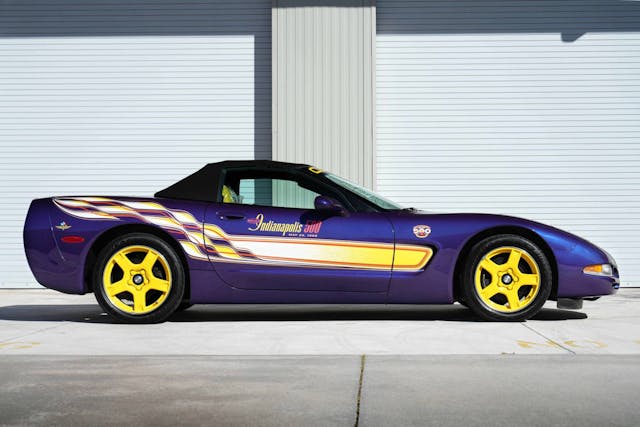
***
Check out the Hagerty Media homepage so you don’t miss a single story, or better yet, bookmark it. To get our best stories delivered right to your inbox, subscribe to our newsletters.
The post Auction Pick of the Week: 1998 Corvette Pace Car appeared first on Hagerty Media.
]]>

Yes, ladies and gentlemen, that headline is correct. I am indeed writing about a Corvette Stingray. No Oldsmobile Ninety-Eight Regencys or Plymouth Gran Fury Broughams this week; maybe next time. I have an obvious bias for ’70s luxury cars, woody station wagons, and Volvos, but I do like Corvettes. It just takes a really special one to attract my attention, simply because I see so many at shows and cruise nights. As for this one, I just went nuts when I saw it. As you may surmise, the main reason is the color combination: Brands Hatch Green with a lovely matching green interior!

My favorite color is green, and my favorite green is jade green, particularly the shade seen on most all Ford Motor Company products circa 1975–79. This is not just a coincidence. My maternal grandparents had a triple-jade 1977 Ford LTD II Brougham when I was really little, and I deeply imprinted on that car!

Today’s featured car was seen last year at the Maple City Cruise Night, held in the small Illinois college town of Monmouth, Illinois. It is less than an hour away from me and I attend every year. This time I met up with my friend Jess (she’s a local), and we wandered around for quite a while—in between stopping in local downtown establishments for refreshments, of course.
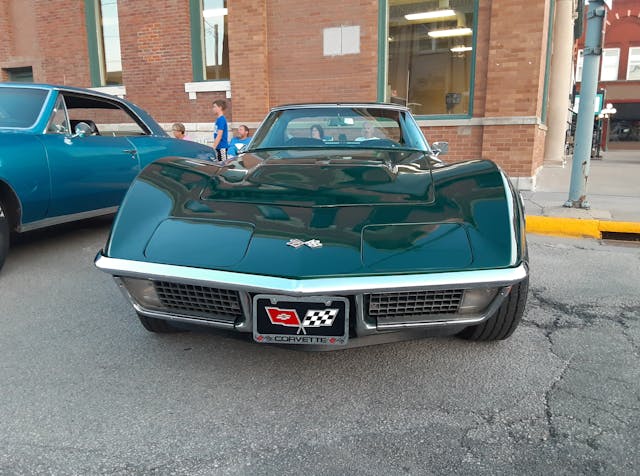
Every year I thoroughly wear myself out walking, and this year was no exception. I wish I’d taken more pictures of this car, but it was right at the time I was ready to go home. I was tired, and it was getting dark. But I still had to stop for a couple minutes and take the pictures seen here, because of that fantastic green paint! Even better, it had a matching dark green interior.

I had a hard time pinning down the year at first, largely because I was on my way back to the car when I finally spotted it. As a result, I foolishly didn’t take a picture of the info sheet on the wiper with the model year on it. I knew it was a 1970–72 Corvette Stingray, but as I’m more into Designer Edition Continental Mark IVs and Cadillac Fleetwood Talismans, I couldn’t immediately pin down the model year.

Fortunately, I have the 1983 copy of the Illustrated Corvette Buyer’s Guide (picked up for a dollar at a local antique mall—such a deal!) and was able to discern first, that the green interior was not available in 1972.

Green exterior was available all three years, but it was a different shade each model year. In 1970, it was Donnybrooke Green, in ’71 it was Brands Hatch Green, and in ’72 (the last year for chrome front bumpers) it was Elkhart Green. As our featured car had that gorgeous jade hue to it, I was able to positively ID it as a ’71.

I didn’t know this color was available on 1971 Corvettes before I saw this car. It is now my favorite 1970–72 Corvette color; prior to now my favorite was probably War Bonnet Yellow or Ontario Orange. But what can I say? I’m a sucker for a green classic car.

The 1971 Chevrolet Corvette Stingray wasn’t much different from the 1970, which itself was a minor facelift of the 1968–69 version. The most noticeable exterior difference was the chrome eggcrate grille and squared-off turn signal lenses. Said turn signal lenses went from clear to amber lenses pretty early in production, and there were a few new colors (including the green on this one!), but that was about it.

Base price was $5496 ($41,668 today) for the coupe and $5259 ($39,871) for the convertible; the 270-horsepower, 350-cubic-inch V-8 was standard, breathing through a single four-barrel carburetor; today’s car has an optional 454 V-8, which was available in 365-hp LS5, 425-hp LS6, and 425-hp ZR2 tunes. A total of 21,801 were built for the 1971 model year.

I keep hoping I’ll see this beauty at another show, but despite attending many of them in 2023, unfortunately I have yet to run across it again.
***
Check out the Hagerty Media homepage so you don’t miss a single story, or better yet, bookmark it. To get our best stories delivered right to your inbox, subscribe to our newsletters.
The post 1971 Corvette Stingray: Down the Brands Hatch appeared first on Hagerty Media.
]]>
It’s Corvette Jeopardy! Here are your answers: Riverside Red. Ermine White. Silver Blue. Tuxedo Black. Sebring Silver. Saddle Tan. Daytona Blue.
The question: What are the seven colors Chevrolet painted its 1963 Corvette Split-Window coupes?
We mention this because, at the Corvette-heavy Mecum Kissimmee auction to be held January 2–14 in Florida, one of the most coveted groups of cars among the 4000 to be sold features seven Split-Window coupes, one in each available color. Mecum is calling it the Colorama Spilt-Window Collection, but we hesitate to call it a collection because it’s basically a group of Corvettes assembled by a dealer, ProTeam Corvette Sales, to sell through Mecum as individual lots. But the cars are getting a lot of traction in the Corvette-centric media, and with good reason.


Bill Mitchell’s design team, which included talented designers such as a very young Peter Brock and Larry Shinoda, designed a fastback Corvette that looked—well, marvelous. For the rear window, they decided to use two pieces of glass, split by a few inches of body-colored fiberglass and framed by aluminum strips. That was in 1963. For 1964, the split window was replaced by a solid piece of curved glass, thus making the 1963 Split-Window an immediate collectors’ item. They dubbed it the Sting Ray (two words; it wasn’t one word until 1969).
Some 10,594 Split-Window Corvettes were built, as well as roughly the same number of convertibles. There have been plenty of collectible Corvettes built in the car’s 70-year history, and the Split-Windows are near the top of the list.

So what kind of money are we talking about here?
The most expensive of the seven Split-Windows is likely to be the Daytona Blue one. It has the coveted Z06 performance package, as well as an interesting backstory: It was exported new to Australia, where it was converted to right-hand drive. All the Colorama Corvettes have some version of the 327-cubic-inch V-8 and four-speed manual transmissions; this one has 360 horsepower. (The 327 also came in 300- and 340-horsepower versions, and all are represented in this group.) Mecum is valuing the Australian Z06 at $450,000–$500,000.
The Riverside Red Split-Window carries Mecum’s lowest estimate at $225,000–$275,000. It’s a lovely numbers-matching car, with low-mileage (47,844), and was the subject of a body-on restoration and an engine rebuild. However, it doesn’t have fuel injection (four of the seven cars do), and it doesn’t have the provenance the rest have, such as a Bloomington Gold certification.

The remainder of the cars are valued slightly higher than the Riverside Red representative, and less than the Z06. Perhaps the most interesting of that lot is the Ermine White model ($250,000–$275,000). It was a present from Jesse James (West Coast Choppers, Monster Garage) to actress Sandra Bullock, presumably during their marriage, which lasted from 2005 to 2010. Bullock subsequently donated the Corvette to charity (sigh). As for James, he is currently married to adult film star Bonnie Rotten. Bullock never remarried.
Click here for the Mecum listing of the Colorama Split-Window Collection. You can also click here to look at the spilt-window Corvettes that ProTeam Corvette Sales has in stock, starting at $149,000 for a Riverside Red model.
***
Check out the Hagerty Media homepage so you don’t miss a single story, or better yet, bookmark it. To get our best stories delivered right to your inbox, subscribe to our newsletters.
The post What color of Split-Window would you buy? Mecum has all 7 appeared first on Hagerty Media.
]]>
On a crisp November morning, a conga line of men in short-sleeved Mopar shirts shuffled inside the Donald E. Stephens Convention Center near Chicago. Perhaps in their excitement to behold the mass of American horsepower on display at the Muscle Car and Corvette Nationals (MCACN), the Mopar men forgot their jackets.
Now in its 14th year, MCACN offers a handpicked selection of top-tier, well, muscle cars and Corvettes. That’s to say nothing of the generous quantity of hot rods, drag racers, and restomods also on display at this enormous show.

Your author is admittedly not much of a car show guy. And I’m better versed in the JDM and drifting spheres than the golden-era muscle world. On its surface, the appeal of MCACN seemed, at first blush, elusive. The cars were tightly packed together. Velvet ropes and signboards with superlative declarations obstructed views. The overhead lights were harsh. None if that is optimal for photography.
Walking around and occasionally keying in on a few select cars of interest—that seemed the thing to do. Executing on that plan brought back to mind the many hours of Mecum auction coverage I watched as a kid. It all came back to me.
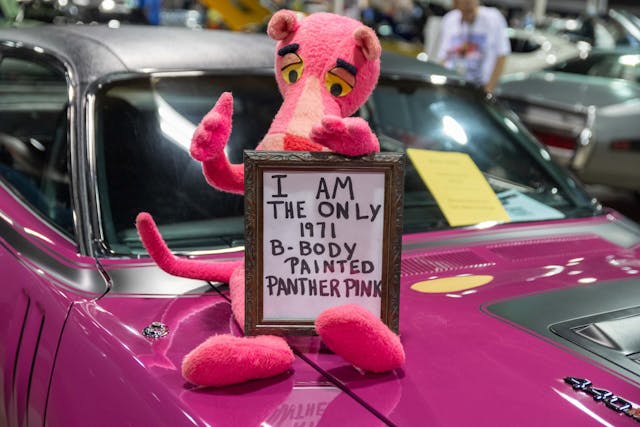

“Oh dang, there’s an AAR ‘Cuda,” I thought to myself. And another one. And another one. And another one. The tributes to the Trans Am Barracuda’s campaigned by Dan Gurney’s All American Racers are rare and valuable. Plymouth only built 2724 them, and our price guide has one in excellent condition—like the ones at the show—valued at $153,000.

The smorgasbord of high-end muscle didn’t stop at Mopars. For the Chevy guys and gals, there were plenty of Chevelles, Camaros, and of course, Corvettes. I lost count of how many perfect C2 Vettes were in attendance, many of which had a 427 badge on the stinger. For the Ford lovers, particularly Mustang fans, there were seemingly endless lines of Mach 1s, Bosses, and Saleen Fox-bodies.


If you’re not a champion of factory-restored or original cars, there were plenty of custom creations on the convention floor at MCACN. Do you remember the Barris “T” Buggy? Well, the memorable ride by the King of Kustoms was also on display. You could take home a model of the Buggy for $15 dollars … or the car itself for an undisclosed amount.


As I took in the embarrassment of muscle-car riches, I noticed that younger people like myself are far outnumbered by an older, grayer crowd. Which makes sense: The collector car market is largely driven by nostalgia, and majority of the cars on display were from the 1960s and 1970s. But in a lucky stroke for the hobby, MCACN seems to be aware of the phenomenon; it showcased categories like “Future Generation Invitational” to draw in fresh blood.
Case in point: “I’ve been taking him here since he was this tall,” Jonathan Herrick said, first gesturing to his waist, then to his son Nathan. “Now he has a car in the show.” The 19-year-old beamed as he stood by his first car, a very clean, all-black 1999 Corvette.

The future looks bright for the continued interest in American muscle, both new and old. It’s only a matter of time before Nathan and I are shuffling into the convention center in branded, short-sleeve shirts, too excited to remember our jackets.








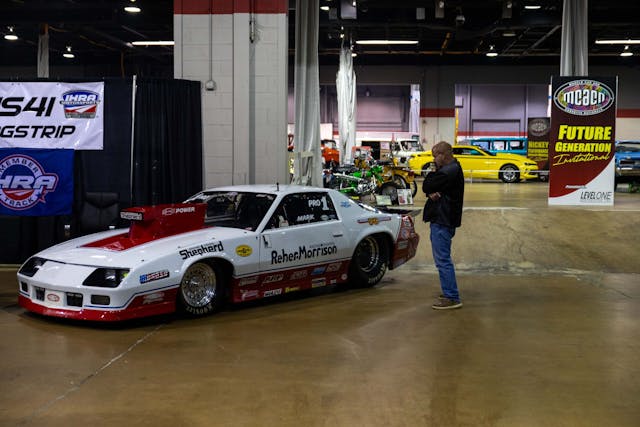
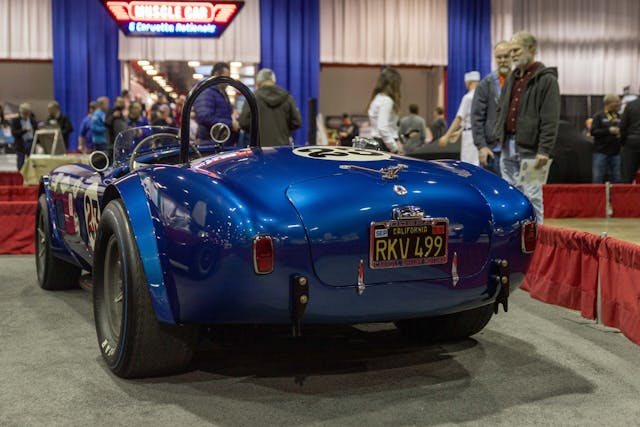
***
Check out the Hagerty Media homepage so you don’t miss a single story, or better yet, bookmark it. To get our best stories delivered right to your inbox, subscribe to our newsletters.
The post Muscle Car & Corvette Nationals 2023 was a vision of my future appeared first on Hagerty Media.
]]>
Corvette history is littered with fascinating one-off design experiments. Some, like the ’59 Stingray Racer, have remained etched into our collective memory. But many more faded into oblivion the moment the auto show’s lights switched off—very much the case for the Vettes penned by Italy’s most renowned design firms.
Pininfarina Rondine (1963)

Perhaps the best known of these so-called Italian Corvettes, the Pininfarina Rondine was a running prototype first presented at the 1963 Paris Motor Show.
Equipped with a 327 small-block V-8 and a four-speed manual transmission, the Rondine was built on the chassis of a brand-new 1963 Sting Ray (VIN number 99574) directly supplied to Pininfarina by GM. The idea behind the study, commissioned by Chevrolet itself, was to see an Italian take on the Corvette. But little did GM know that once the Vette arrived at Pininfarina’s workshop, the designer tasked with creating a new body for it was Detroit native Tom Tjaarda.


Whether Tjaarda’s elegant, smooth lines were an improvement over the iconic Sting Ray we know and love largely depends on individual taste. Still, GM’s top brass was reportedly satisfied with the exercise, including design supremo Bill Mitchell and Corvette’s chief engineer Zora Arkus-Duntov. Nonetheless, Pininfarina’s hopes for a production version were soon quashed, so the Rondine remained a one-off. The Turinese firm kept the Rondine in its company museum until financial difficulties forced it to put it on sale at Barrett-Jackson’s 2008 Scottsdale auction, where it fetched $1.6 million.

The name “Rondine” is the Italian for “swallow” and was inspired by the car’s peculiar rear-end design, vaguely reminiscent of the bird’s tail. But if GM did nothing with the Rondine, the visionaries at Pininfarina were never the ones to let a good idea go to waste. When Fiat came knocking at Pininfarina’s door for a spider derivative of the upcoming 124, Tjaarda skillfully adapted the Rondine’s design theme to Fiat’s small roadster, which went on to become a beloved Italian classic.
Bertone Ramarro (1984)

Presented at the 1984 Auto Expo in Los Angeles, the Ramarro (a little green lizard common in the Piedmontese countryside) was Bertone’s radical take on the recently launched C4 Corvette.
In fact, the donor car was the Vette from Chevrolet’s 1983 Geneva Motor Show stand, which GM gifted to Bertone after the show ended. Bertone’s designers knew that trying to improve upon the new Corvette’s very accomplished design would have been pointless. But they also knew that if their Corvette couldn’t be better than Chevrolet’s original, then it ought to be bolder. A lot bolder.
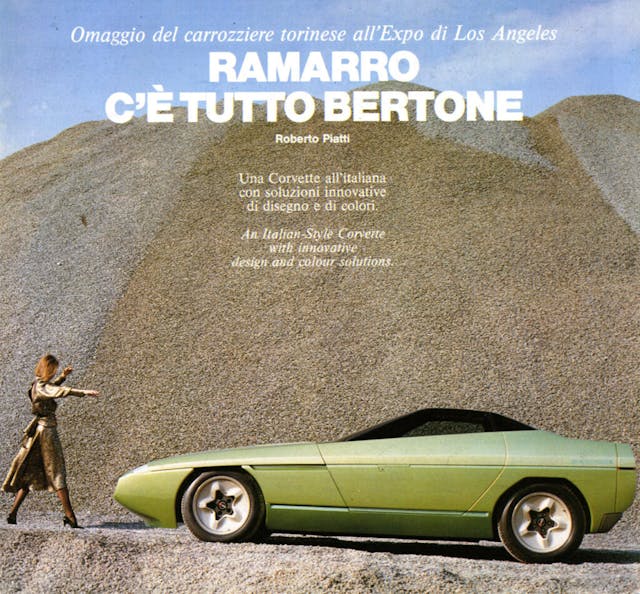
Created under the direction of Marc Deschamps, the Ramarro was an almost brutal wedge design. The sharply cut-off rear end was ten inches shorter than the donor ‘Vette and housed the engine and air-con radiators. That’s because their space at the front of the car was taken by the space-saver spare wheel to further lower the car’s nose compared to the original.
The C4 Corvette’s generous glasshouse was substituted by what looked like a jet fighter’s canopy: the entire roof was dark, with the pillars disguised by the smoked glass. Access to the cabin was via two large sliding doors, which revealed a cabin upholstered in leather whose color and texture were meant to evoke the lizard’s skin.


The Ramarro was a fully functional, running vehicle. However, once its motor show run was over, it mostly sat in Bertone’s museum until the firm’s bankruptcy in 2014. The whole collection was bought at auction by the Automotoclub Storico Italiano in 2015, and the Ramarro has since appeared in many events and exhibitions. But as Richard Corliss once wrote, nothing ages as quickly as yesterday’s visions of the future: The Ramarro has lost none of its shock factor, but it’s become more of a charming period piece than a design classic.
Bertone Nivola (1990)
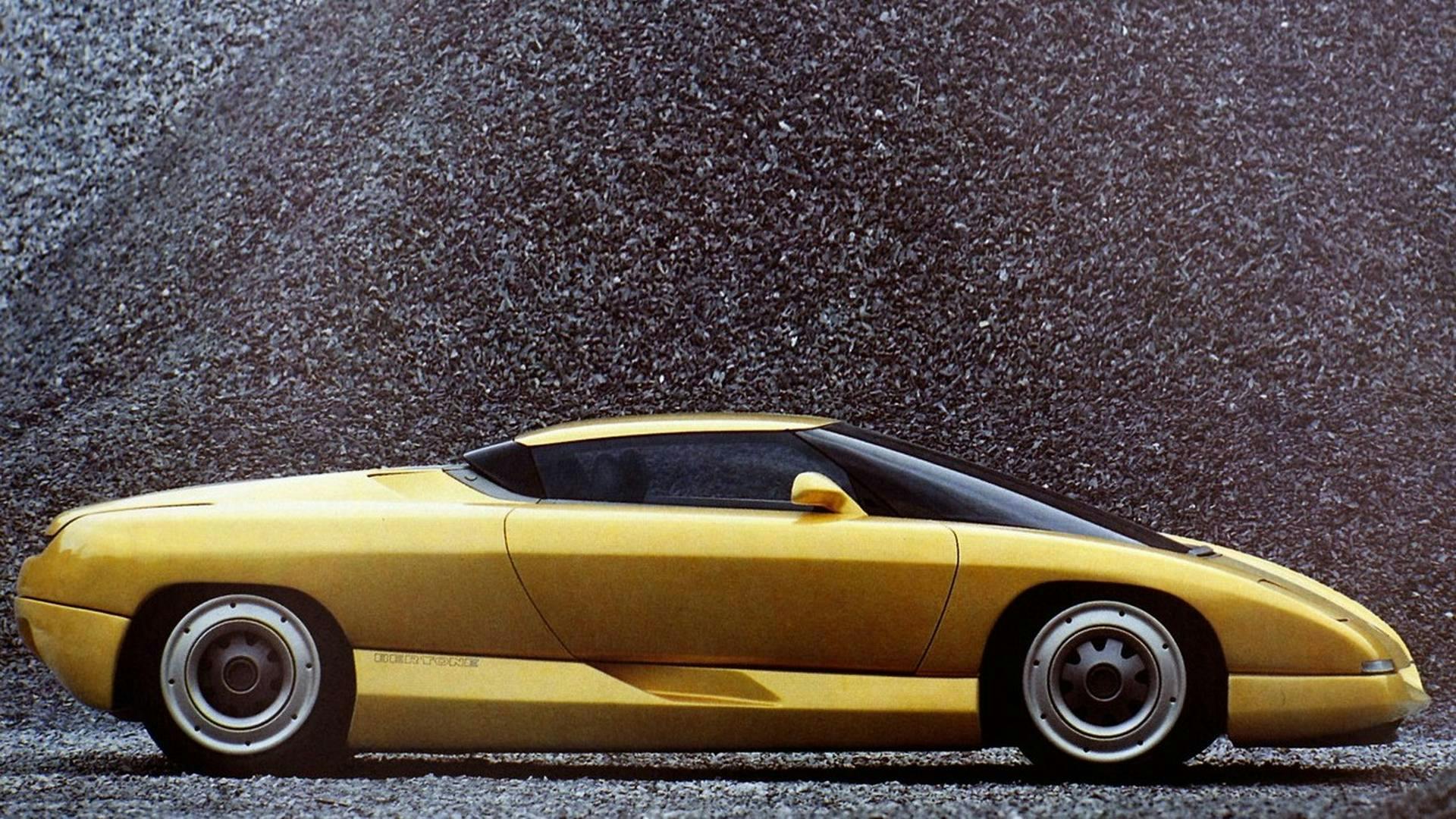


Named after the legendary Italian racing driver Tazio Nuvolari, the Bertone Nivola appears on this list out of sheer completism more than anything else. That’s because it’s a “Corvette-engined” design study rather than a “Corvette-based” one.
The quad-cam LT5 V-8 from the Corvette ZR-1 was placed amidship in a tubular steel frame, mated to the ZF transaxle from the De Tomaso Pantera. But citing the Nivola as one of the many mid-engined Corvette concepts that paved the way for the current C8 generation would be a stretch. That’s because GM’s involvement with the project was limited to the engine supply, and the Nivola wore no Chevrolet or Corvette badges.
ItalDesign Moray (2003)

Presented at the 2003 Geneva Motor Show, the Moray was Giorgetto Giugiaro’s way to commemorate the Corvette’s 50th anniversary. That’s why, rather than an attempt to reinvent the Corvette, Giugiaro’s Moray was more of a loving tribute to the classic Vettes of yore.
Built as a fully functional prototype on a Corvette C5 chassis, the Moray’s sensuous curves harked back to the C3 generation and legendary show cars like the Manta Ray. Rather than a traditional roof, the Moray had two large removable glass canopies hinged on a central “spine” that can be read as a clever homage to the ’63 “split-window” Corvette. But my favorite part of the design is the front end, with its ultra-slim headlights positioned on the outer edges of the bodywork. This way, Giugiaro recreated the “eyeless” look of previous Corvette generations while doing away with the classic pop-up lights.

The name Moray (the English name for the eel-type fish Muraena Helena) was in itself another nod to the Corvettes from the Bill Mitchell era, whose shapes were famously inspired by marine creatures.
Bertone Mantide (2009)

Presented in 2009, the Mantide (the Italian word for mantis) was a one-off penned under the direction of Jason Castriota during Bertone’s twilight years.
Commissioned by a private collector, the Mantide was built on the chassis and running gear of the C6-generation Corvette ZR1. Thanks to the ample use of carbon fiber, Bertone claimed a 250 pounds weight saving over the donor Vette. On top of that, The Mantide’s somewhat contrived body design produced, according to Bertone, 25 percent less drag than the Corvette despite a 30 percent increase in downforce.

The Mantide was initially presented in red but later repainted in pearlescent white, which led some to speculate about a limited production run that never actually happened. What still wears the original red is the full-size styling model for the Mantide, which remained part of Bertone’s collection.
Much to the credit of GM’s designers, not even Italy’s greatest stylists ever managed to create a Corvette that looked better than the regular production models. But still, if you had to pick one, which of these Italian Vettes would you have liked to see in production? Drop a comment below.
***
Check out the Hagerty Media homepage so you don’t miss a single story, or better yet, bookmark it. To get our best stories delivered right to your inbox, subscribe to our newsletters.
The post These 5 Italian beauties hide Corvette bones appeared first on Hagerty Media.
]]>
Alan Poster, much to his chagrin (and astonishment), has already received more than his 15 minutes of fame, all because his new 1968 Chevrolet Corvette Stingray convertible was stolen less than three months after he bought it.
Actually, the theft of the Corvette wasn’t what made Poster famous; it was the return of that stolen Corvette that made him famous. That’s because the car was gone for 37 years before it was miraculously returned to him.
Now, more than five decades after Poster first saw that C3 in a New York dealership and spent pretty much every cent he had on it, he’s saying goodbye to the car once again. Willingly, this time.
“It’s a crazy story,” Poster says of the Corvette’s wild journey, “… a really crazy story.”

It was January 1969, and the 26-year-old guitar salesman was fighting the winter blues. Fresh off a divorce, the Brooklyn native took solace in driving his blue Corvette ragtop, even on snow-covered roads. Although The New York Times later reported that Poster purchased the C3 to ease the pain of his breakup, Poster says he bought it before his divorce. The sports car, based on Larry Shinoda’s radical Mako Shark concept, rolled off the assembly line on July 16, 1968 and was shipped to a Chevrolet dealer in Great Neck, on Long Island. Poster, perhaps already mourning the demise of his personal relationship—or maybe expediting it—was enthralled with the Corvette and shelled out about $6000 for it. That would be $55,320 today.
“I got the Corvette in the divorce,” he says now, “and she got everything else.”
Poster told The Times in 2006 that it was a financial stretch to buy his dream car. “I didn’t have a lot of money. I went out on a limb to get this thing. It was an egocentric muscle car that just came out. Back then, Corvette was hot as heck. [Owning one] was an absolute fantasy of mine.”


Poster lived in Queens at the time and drove the Vette fast whenever he could. He also liked to impress women with it. In fact, on the night before the car was stolen, he was picking up a date and returned to the car just in time to thwart an attempted theft. “People were yelling, ‘Kill him!’ but I let the guy go,” Poster says. “I actually started laughing. I thought that was a little severe.”
As it turned out, he had only postponed the inevitable.

The following night, when Poster went to pick up the Corvette at a parking garage, the attendant returned and said it was gone. Poster reported it stolen on January 22, 1969. Just three weeks into the new year, his C3 was the 6620th automobile swiped in New York in 1969. By year’s end, that number had risen to 78,000.
Poster never received an insurance settlement for the Vette because he didn’t have the money to insure it. “I was heartbroken,” he says. “It was a big wake-up call. I never thought I’d see it again.”
As the years passed, the odds of recovering the car grew. Poster moved to California and settled in Petaluma, just north of San Francisco’s Golden Gate Bridge. In 1976, he founded Ace Products Group, which makes gear for musicians—things like bags, cases, cables, stands, adapters, and connectors. His business became a huge global success, and it allowed him to travel around the world “a hundred times,” he says. It also afforded Poster a yellow 1974 Corvette. “I was still trying to live my dream,” he admits. He eventually sold the car and moved on.

Then, nearly four decades after his 1968 Corvette convertible was swiped in New York, Poster received a phone call from the New York Police Department, saying his car had been located. He thought the call was a prank.
It wasn’t. Somehow, Poster’s Corvette had mysteriously followed him to California. Although he hadn’t insured it way back when, the theft had been reported to the National Insurance Crime Bureau, which maintains a database of stolen vehicles. Before an automobile can be shipped out of the country, U.S. Customs routinely runs the VIN through that database. On December 7, 2005, as three classic cars were about to be shipped to Sweden, Customs got a hit: One of the cars, a ’68 Corvette, was flagged as stolen in New York on January 22, 1969. There was no other information—no name, no address, not even a record of the police bureau where the theft had been reported.
Contacted by the California Highway Patrol, the NYPD suddenly had a lot of work to do, and they had to do it quickly. If the owner wasn’t found by January 1, the Corvette would be released to its Swedish buyer.


As The Times explained in 2006, Cliff Bieder and William Heiser, two detectives in the auto crimes division in Queens, were assigned the case. “It was the equivalent of finding a needle in a haystack,” Heiser said at the time. After four days of meticulously searching through microfilm, “Our eyes were hurting,” Bieder said. Then, on December 23, Heiser scored. “I thought [my partner] was going to pass out.”
Locating Poster didn’t take very long; the two detectives spoke to the buyer of Poster’s last house, who said he had moved to California. They soon found Poster through his company, and on Christmas Eve, Bieder called him at his office.
“He said, ‘You had a car stolen in ’69? A Corvette? We have your car,’” Poster explains. “I thought, ‘This is a scam, a cruel joke.’ They had to convince me that it was true.”

The CHP picked up Poster and drove him to see the Corvette for himself. The media, which had been alerted ahead of time, was waiting for him to arrive.
“It was really something,” Poster says. “When I got out of the police car, there were cameras everywhere. It seemed like 40 or 50 people were asking questions. It was insane. I thought, ‘I’m not built for this.’ In retrospect it was fun, but going through it was not.”
The story was on TV, radio, and in newspapers all over the country, and Poster was inundated with calls and emails for weeks. “The woman that I’d taken on that blind date the night before it was stolen, she called me. I got a call from an old girlfriend that I hadn’t seen in years. I even got a proposal, but I had no interest in that,” Poster says with a laugh.
“My accountant was in Brazil at the time, and he saw my picture on the front of a newspaper there and he thought, ‘Oh, oh. What did he do?’ It was a big deal. That story was everywhere. It was crazy for a while. One day I thought, ‘I don’t want to be famous anymore.’”

Poster initially had big dreams for the car, but it never materialized. “I drove it only once after I got it back,” he laments. “It had been painted silver before it was returned to me, and the interior had been changed to red, so I had it repainted blue like it was (Le Mans Blue Poly 976, to be exact, over a blue interior). I tried to rekindle my excitement for it, but it felt different—that was another life. I was going to take it to shows and tell the story, but it never happened. Everything had changed. Looking back, I should have done something with it; I regret that I didn’t. It was big news.”
Even comedian Jerry Lewis saw the story, and he wanted the car. “His people contacted me and offered me a hundred grand for it,” Poster says. “I told them ‘Nah, I’m going to have fun with it.’”



He didn’t. Instead, the car sat for years. Several months ago, Poster decided to bring the Corvette up to snuff so he could sell it, and he enlisted the help of Nathan Stratton, who assisted him in selling a 1988 Mercedes-Benz 560SL years earlier. They refreshed it cosmetically and mechanically, but most importantly they installed an original (but not the original) 327-cubic-inch V-8 engine, since the one with which the Corvette was born had been swapped out somewhere along the line.
“We did our best to make it look like it did before it was stolen,” Poster says, “and I think it does.”

The car’s odometer shows 60,000 miles, but most of those were driven by strangers. The New York Post reported at the time that there were three prior owners of the Corvette dating to 2001, including the person shipping it to Sweden, but since those people apparently had no idea the car was hot, they were not charged. The thief who stole the C3 in January 1969 has never been identified.
Poster’s Corvette will soon be offered on BringATrailer.com, and since a ’68 Corvette Stingray convertible in #2 (Excellent) condition has an average value of $53,700, he will finally get his $6000 back. But that isn’t the reason he has decided to part with it.

“I just turned 80 … 80! I can’t believe that,” Poster says with a laugh. “My life is a lot different now than it was back then. I live on a houseboat in Sausalito—the SS Maggie (built in 1889), which I bought four years ago. I didn’t used to believe in ghosts, but I do now. That thing (the houseboat) is haunted. Plus, I have an apartment in New York. I own a Range Rover. I’m in a different place.
“You know, I’m just so grateful. A lot of great things have happened to me, including getting the Corvette back. Now it’s time for it to go to someone else.”
This time around, however, if Poster wants to check on his old flame from time to time, he’ll know where to find it.
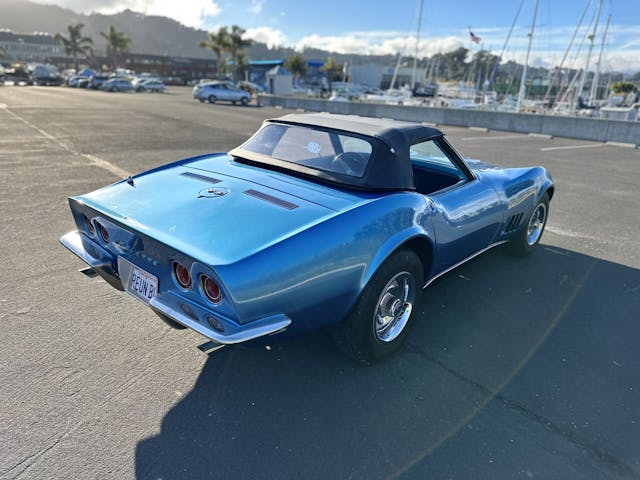









***
Check out the Hagerty Media homepage so you don’t miss a single story, or better yet, bookmark it. To get our best stories delivered right to your inbox, subscribe to our newsletters.
The post Famously reunited with stolen Corvette, Alan Poster will soon let it go appeared first on Hagerty Media.
]]>
Everybody loves a bargain, whether it’s happy hour beers at your local, BOGO at the book store, or a two-fer at your favorite online retailer. Heck, in some jurisdictions, Black Friday has somehow turned into the entire month of November. In this economy, you’ll hear few complaints.
There are deals to be found throughout the classic car market as well, and, lucky for us, that includes the performance realm occupied by America’s Sports Car. Despite a few eye-watering results in 2023, like the $3.14M record price RM Sotheby’s achieved in January for a 1969 ZL-1 convertible, Corvettes have always represented good value for money. After digging into the data from our most recent update to the Hagerty Price Guide, we’ve determined that these seven Corvettes—one from each generation, excluding today’s C8—are the cheapest examples you can buy right now. Unsurprisingly, they hover around base-model territory, but a Corvette is a Corvette, and it’s almost impossible to go wrong.
For this exercise, we’re focusing on examples in #2 condition (Excellent), which means they drive like new and might even win you a trophy at a regional car show. If there’s someone on your “Nice List” this holiday season, now might be the perfect time to shop.
C1 (1953–62)
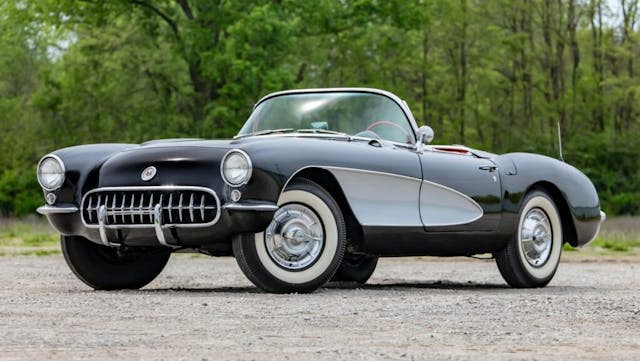
1956 Convertible
The 1956 Corvette represented a complete overhaul from the models that preceded it, the most notable difference being those gorgeous side coves sometimes set off by two-tone paint. Following the V-8’s introduction in 1955, three different 265-cid V-8 configurations were offered in ’56, with outputs of 210, 225, and 240 horsepower. The penny saver here is the base car, breathing through a four-barrel carb and putting its adequate power to the back wheels through a three-speed manual transmission. Following a modest rise in prices that began with the onset of the pandemic, prices peaked around April 2022 before settling back to pre-pandemic levels. Today, a car in #2 shape sells for about $70,500. Figure around $60,000 if it’s equipped with the Powerglide automatic.
C2 (1963–67)

1964 Convertible
Chevy’s 1963 redesign of the Corvette gave us a coupe for the first time, and what a coupe it was; the one-year-only Split-Window Corvette is rightly regarded as one of the most beautiful cars to ever hit the road. The rest of the Corvettes in second-gen lineup were no slouches, either. Open or closed, you can’t go wrong. Take the ’64 327/250 convertible, for instance. In this configuration, with the optional four-speed manual and single Carter four-barrel, it’s sitting at about $64,000, and closer to $51,000 if equipped with the base three-speed manual. It’ll never be a match—on the street or the auction block—for its hi-po 327/375 fuelie counterpart ($89,400 for a #2), but you’ll hardly care when you’re buying million-dollar looks for Silverado money.
C3 (1968–82)

1976 Coupe
The swoopy, pointy, sexy “Shark” Corvette hit the streets in 1968, and though it would trade its chrome bumpers for even more fantastic plastic by 1974, the basic shape soldiered on into the early ’80s, by which point more than 542,000 had been produced—roughly equal to total production of C1, C2, and C4 Corvettes combined. While few enthusiasts would ever accuse a ’76 Corvette of being potent, a nicely kept 180-hp L48 coupe is a joy to own. They also take us into affordable, sub-$20K territory, with an average sale price of $19,500. That may seem cheap, and prices appear to be leveling off as we end the year, but keep in mind these cars have gained nearly 64 percent in value since 2018, which means that if the best time to buy one was five years ago, then certainly the second-best time is today.
C4 (1984–96)

1986 Coupe
When it arrived, the fourth-gen Corvette was a revelation in every way, a world-class performer underpinned by an all-new chassis, with a funky digital dash to rival the finest Texas Instruments calculator in the land. After debuting with 205 hp, base cars quickly got a bump to 230, and for 1986, a convertible model returned to the lineup following an 11-year absence. It’s the ’86 coupe we’re interested in, however, and at around $17,900, it’s the cheapest Corvette of them all. But for how long? The five-year trajectory on these cars has seen them gain 50 percent, and they’re still headed up.
C5 (1997–2004)

1997 Coupe
Until mid-2021, fifth-gen Corvettes represented one of the best bang-for-buck ratios in the performance-car world. Today, at an average #2 price of $26,400, they’ve gained the attention of collectors, but they’re still a solid deal. And with 345 horses on tap from that terrific LS1 V-8, a near 50/50 weight balance, and 30 mpg possible on the highway, there is little this Corvette can’t do. The ’97 model year was coupe-only, and the automatic transmission was standard, so these days it generally means a 10 percent discount. If you prefer two pedals, it’s a good way to save yourself some dough. If you prefer the wind in your hair, however, maybe consider our next pick.
C6 (2005–13)

2005 Convertible
Prices have cooled in 2023 on all but the very best ’05 Corvettes. Thankfully, a #2 condition car is not the very best, so a convertible at $32,000 is a stellar deal. Especially when you consider the 400-hp LS2 lugging it around. In fact, the kind of performance this car delivers for the price is almost unfair; an ’05 Porsche 911 convertible in similar fettle will set you back $55K, for example. There’s no intermediate shaft bearing issue to fret over in the Corvette, either. Win-win.
C7 (2014–19)

2014 Stingray Coupe
Before Chevy made the dramatic switch to a mid-engine layout for the C8 Corvette, the seventh-gen car gave enthusiasts everything they could want from a front engine/rear-drive layout. The car featured a 455-hp LT1 V-8 mated to an all-new seven-speed manual gearbox that offered rev-matching, a carbon fiber hood and removable roof panels, plus a more premium interior (finally!) and a full suite of gizmos designed for coddling and convenience. We don’t currently feature these in the Hagerty Price Guide, but you can get yourself into one for around $48,600, and when compared to some of the very latest, very snoozy new-car offerings, why wouldn’t you?
***
Check out the Hagerty Media homepage so you don’t miss a single story, or better yet, bookmark it. To get our best stories delivered right to your inbox, subscribe to our newsletters.
The post From mild to wild, these are the 7 cheapest Corvettes right now appeared first on Hagerty Media.
]]>
With eight generations to choose from, you’ve got to be a killjoy not to love one Corvette or the other. What the early roadsters lack in speed they make up with classic charm. The sold-out C8s are America’s feasible Ferraris. The six tweener generations broom away workaday misery in the first mile of any weekend excursion.
But what if you could mix and match your favorite Corvette design features without consuming more than a single slice of precious garage space? That’s precisely what Russ Weid of Chelsea, Michigan, has achieved with his 2013 C6 Corvette dressed as a Mid Year (1963–67). Weid’s hinged headlamps, beefy hood, and flared front fenders match the 1967 Corvette’s nosepiece. The tapered roof and split-window backlight pay homage to the ’63 factory Corvette coupe.

Weid bought his Corvette nearly new in Dallas a decade ago with a base 6.2-liter 430-hp V-8 and six-speed manual transmission. Karl Kustom (KK) over Tuxedo Black paint. Their fastidiously made skins are hand-laminated fiberglass bonded with vinyl-ester resin. KK also fitted new custom bumpers, aluminum grille bars, and door handles to Weid’s Corvette. Known as a “split build” because two model-year designs are replicated, the body makeover cost Weid $95,000. Only 14 of the 64 Corvettes converted by KK embodied this split-year configuration.





To add energy under the hood, Weid added a low-pressure Edelbrock E-Force supercharger. He estimates that upgrade yields about 550 horsepower. A new Billy Boat cat-back exhaust system includes two cross-flow mufflers and a flamboyant quartet of pipe tips. Weid’s wife Diane helped EVOD Industries design the unique custom forged-aluminum wheels wearing P275/35ZR-18 front and P325/30ZR-19 rear red-line radials.
The cost of these mods added to the $50,000 core charge yields a bottom line crowding $170,000. The retired Chrysler test driver and mechanic is convinced he made a shrewd investment. The stock suspension provides a nicely controlled ride and the engine’s thunder never overwhelms conversation. Weid confirms, “Even though I’ve owned my Corvette for a decade, it’s still a thoroughly enjoyable treat. Every spring that I remove it from its winter storage bubble, I feel like a giddy 16-year-old!”



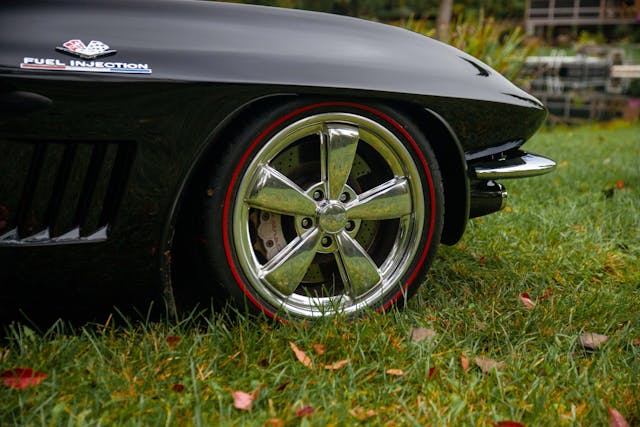



***
Check out the Hagerty Media homepage so you don’t miss a single story, or better yet, bookmark it. To get our best stories delivered right to your inbox, subscribe to our newsletters.
The post Mixed Metaphor: Russ Weid’s Corvette blends the breed’s best attributes appeared first on Hagerty Media.
]]>
Pull a thread on a sweater, and you may reduce it to a ball of yarn. When trying to unravel automotive history, you also sometimes end up with a yarn or two. Here’s an example: Perhaps because it was the only show car in the history of General Motors’ Motorama that actually became a car you could buy in showrooms, the Corvette earned such positive reception from the public that GM executives decided to green-light the concept. That legend is likely not true, at least the part about why the Corvette was approved for production.
Here’s the real story. Chevrolet brand manager Thomas Keating wanted a product to compete with the British sports cars, which had become popular in America following WWII thanks to GIs returning from the UK and Europe. The two-seat, rear-drive, open-top Vette certainly got a strong reception. A true part of Corvette lore concerns an attendee at New York’s Waldorf Astoria, where GM first showed the car, who was so impressed by the car’s potential and disappointed in its driveline (a six-cylinder engine and two-speed automatic transmission) that he wrote a letter to Chevrolet’s head engineer, Ed Cole, who hired the young engineer. His name was Zora Arkus Duntov, and he went on to become the Corvette’s chief engineer for decades.
Since that first Corvette show car (EX-52), concepts have played an important role in the history of the brand, shaping both production models and brand enthusiasm. To Corvette enthusiasts, Bill Mitchell’s 1959 Stingray and the Mako Shark II are almost as familiar as the Split Window or the C3. In my exploration of the mid-engine, all-wheel drive Corvette concepts that preceded the new, hybrid/AWD E-Ray, I came across a number of Corvette concepts that are worthy of attention. Some are better known than others, and not all of them are precisely Corvettes, but all of them had some kind of role in shaping the brand.
The Duntov Mule

First, let’s get back to Zora. After he was hired on at GM, he wrote a four-page memo encouraging his superiors to make cars that would appeal to the hot-rodders of his day. It was Duntov who convinced Cole to take the small-block, overhead-valve V-8 in development for Chevy sedans and put it into the Corvette, turning the two-seater into a true performance car. The result was EX-87, currently owned by Ken Lingenfelter and better known as the Duntov Mule.
Not only is EX-87 literally the first Corvette with a V-8 engine, but it also has a provenance and pedigree that is a bit hard to believe. The engineer tasked with installing that engine in a production ’54 chassis was three-time Indy 500 winner Mauri Rose. The famed operator of Daytona’s “Best Damn Garage in Town,” Smokey Yunick, was responsible for tuning the V-8 prototype. Duntov set speed records in it. The cut-down windshield, tonneau cover over the passenger seat, and tail fin (for high-speed stability) were also Duntov’s ideas, as was increasing the displacement of the engine from 265 to 307 cubic inches.
1961 Mako Shark I
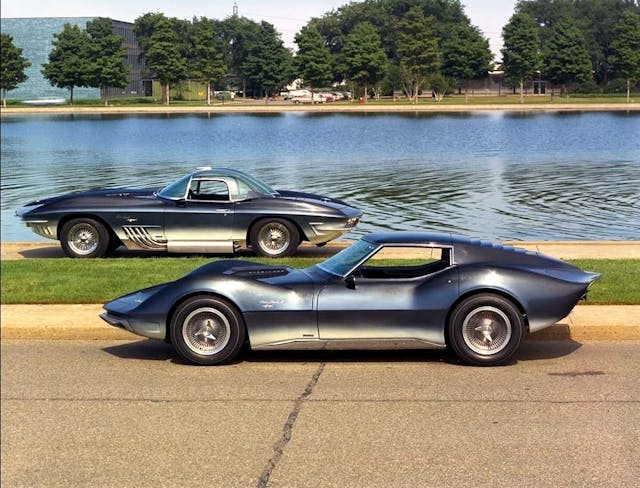
If you’re wondering why the Corvette was nicknamed Stingray, that’s because Bill Mitchell, who followed Harley Earl as GM’s head of styling, liked to go deep-sea fishing. He followed up 1959’s Stingray racer and show car with XP-755, the original Mako Shark.
Not as well known today as the Mako Shark II, which presaged the production version of the third-gen, or C3, Corvette (1968–82), the first Mako Shark was based on the second-gen car (C2). It had a streamlined front end that came to a point, six taillights, and an impressive paint job that faded, roof to rocker panels, from blue to white. The color scheme reproduced the coloration of the actual mako shark, an example of which was displayed by Mitchell in his office.
The way the story goes, when the styling team repeatedly failed to paint-match the shark’s colors to Mitchell’s satisfaction, they snuck into his office one night and repainted the fish to match the car.
1962 Corvair Monza GT
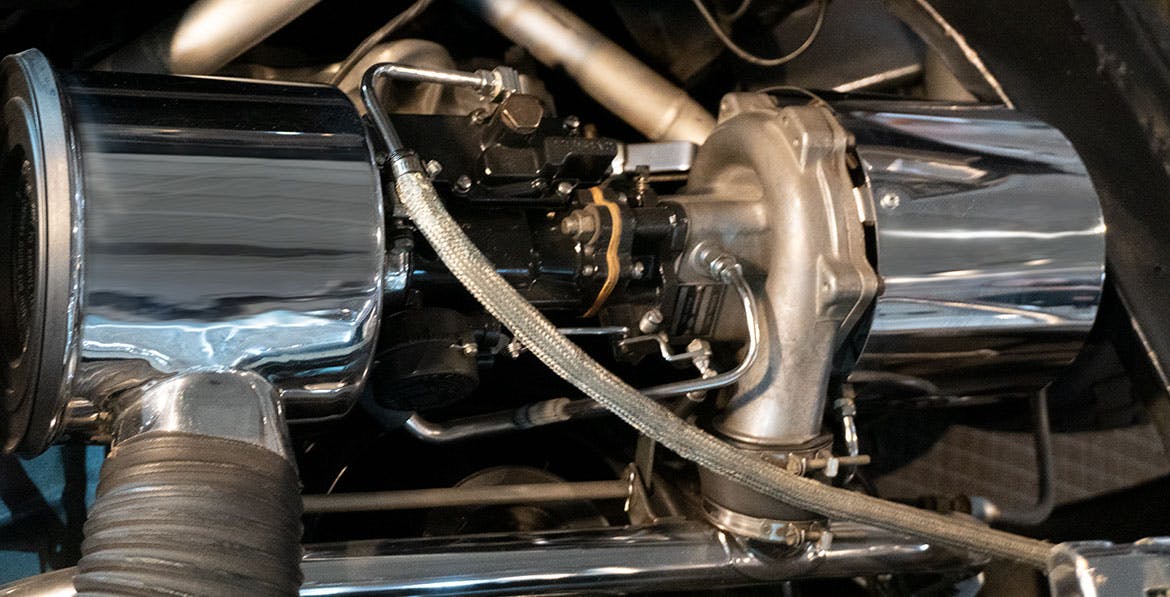
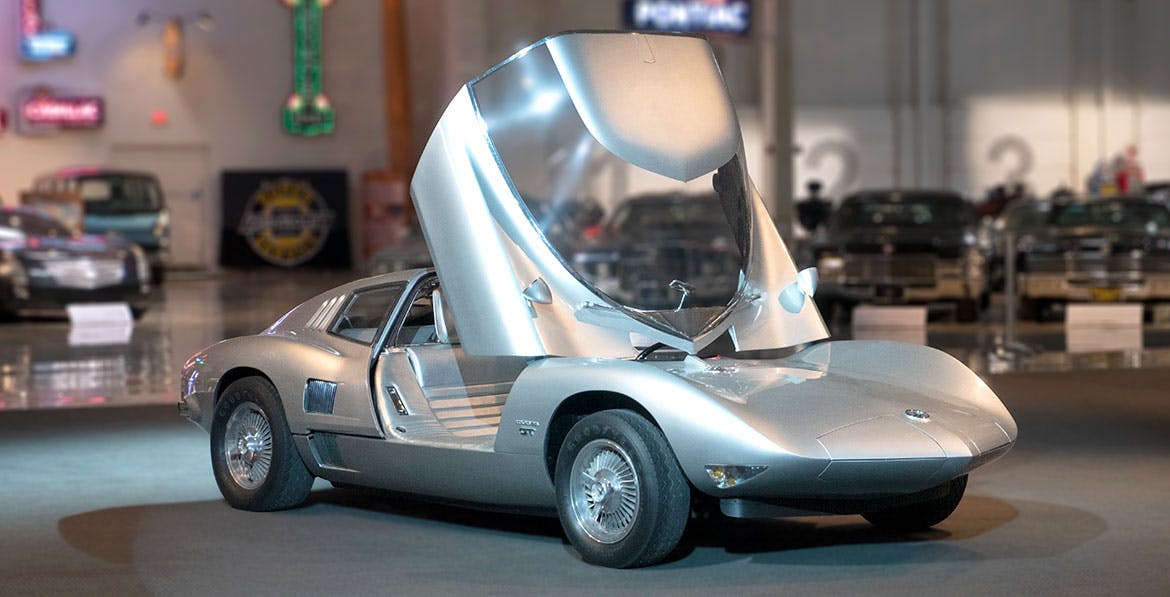


Yes, the Monza GT was branded as a Corvair concept and used an engine (an air-cooled, horizontally opposed turbocharged six-cylinder) from the production car—mounted in the middle, not the back, of the chassis. However, XP-777 and its open-roof sibling Monza SS, designed by Larry Shinoda and Tony Lapine, may have been the first expression of the styling themes expressed in Mako Shark II and the third-generation Corvette. The chassis for the Monza GT was also the basis for the 1963 Corvette GS-II, also penned by Shinoda, and part of the Corvette Grand Sport racing program. While the GS-II never raced, it became the basis for Jim Hall’s Chaparral 2C racer.
1967 Astro I

For 1967 Larry Shinoda took the design themes of the Monza GT and Monza SS to a radical extreme with the extremely low Astro I, also based on a Corvair. At just 35.5 inches tall, it is even lower than the Ford GT40. GM’s official history of the car says that it was “designed to investigate the visual potential of automobile aerodynamic characteristics” and that it “dramatically demonstrated the harmony that could be achieved between aesthetics and aerodynamics.”
With a roofline that low, ingress via conventional door was problematic, so roof and side glass were integrated into a clamshell that tilted rearward. To save driver and passenger from plopping down into such low seats, the chairs automatically raised when the canopy was opened and lowered as it retracted. Chevrolet said that the Astro I was powered by an experimental, overhead-cam version of the Corvair six-cylinder, but it’s not clear whether that engine was actually ever fitted to the Astro I.
1969 Manta Ray

I’d like to show you a photo of what the 1965 Mako Shark II, XP-830, looks like today but that influential Corvette concept, also designed by Larry Shinoda, no longer exists—at least under that name.
For the 1969 Detroit Auto Show, Mitchell’s team modified the Mako Shark II into the Manta Ray concept, expanding the Corvette’s aquatic menagerie. The Manta Ray had a longtail rear end, a styling feature that would show up in the Aerovette family of concepts (we’ll get to those in a bit), a “sugar scoop” rear glass treatment, a flip-up roof panel, tiny side mirrors, pop-up turn signal lights, a deep front spoiler, and side exhaust pipes—the last perhaps intended as a nod to the original 1959 Stingray. The Manta Ray was powered by the aluminum-block ZL-1 engine developed by Chevrolet with Bruce McLaren for use in the Can-Am racing series.

In a bit of concept-car trivia, the Manta Ray Corvette was not the first Manta Ray car. In 1951, a couple of West Coast customizers, Glen Hire and Vernon Antoine, built a highly modified Studebaker called the Manta Ray that bears more than a little resemblance to Harley Earl’s famous LeSabre concept.
1973 Aerovette

One of the better-known Corvette concepts that never reached production is the Aerovette. Its origins lie in the XP-880 mid-engined Astro II concept, first revealed at the 1968 New York Auto Show. Less extreme than the Astro I, the Aerovette had actual doors, a front storage hold, and a clamshell-style rear end that lifted to allow access to the transversely mounted V-8 engine.
Duntov’s team then developed two prototypes for what was tagged XP-882. Chevy general manager John DeLorean initially canceled the program, deeming it too costly, but when Ford announced the DeTomaso Pantera would be sold at its Lincoln-Mercury dealers, the program was revived and one of the XP-882s displayed at the 1970 New York show.

At the same time, General Motors was developing its own version of the rotary Wankel engine for the Vega small car. In 1972, DeLorean approved additional development of the XP-882 chassis, leading to the XP-895, powered by a pair of the two-rotor Wankels ganged together to make a 420-hp, four-rotor powerplant. A sibling, two-rotor car dubbed XP-897 was also developed. Both of those concepts were shown in 1973, before the oil crisis sparked by the Yom Kippur War and increasingly stringent emissions regulations put the kibosh on rotaries, which are relatively thirsty and dirty.

The exterior styling of the rotary-powered Corvette concepts was much rounder and organic than the production Corvette of the era. The two cars wore distinctive fender flares and NACA ducts on their hoods.
Three years later, in 1976, the four-rotor engine in XP-895 was swapped out for a 400 cubic-inch V-8. The car was renamed Aerovette and, according to reports, it was approved for production for the 1980 model year, albeit with a 350-cubic-inch small-block Chevy V-8.
By 1976, John DeLorean had moved on to his own self-named venture. It may be just a coincidence that, like the Delorean DMC-12, the Aerovette was given gullwing doors. Unfortunately for Corvette fans hoping for the new design, all advocates for producing the Aerovette (Duntov, Mitchell, Ed Cole) had retired by then, and new Corvette chief Dave McLellan, after deciding that the conventional front-engine layout was more economical and would have better performance than the Aerovette, killed that program.


Reynolds Aluminum Corvette

The reason why the Aerovette had poorer performance was that, unlike the production Corvette with a composite body, the Aerovette’s skin was steel, making it 100 pounds heavier than a 1973 Corvette coupe. DeLorean, who then was still at GM, turned to Reynolds Metals.
Reynolds, the same folks who make aluminum foil used in kitchens, had been a GM supplier for over a decade, providing the alloy used in Corvair engines, Corvette intake manifolds, bell housings, and other parts, along with the specialty alloy used in the ZL1 block, L88 head, and all-aluminum Vega motors. Reynolds made an exact copy of XP-895 out of 2036-T4 aluminum, a special alloy that could be spot-welded. Even then, some epoxy adhesive was used to make the hand-fabricated body. The result shaved 450 pounds off the weight, making the body almost 40 percent lighter. While it weighed significantly less, it was also significantly more expensive to produce than either a steel or composite body.
2009 Stingray concept



The most recent Corvette concept was the 2009 Stingray, intended to preview the seventh-generation Corvette, which was introduced in 2013. Interestingly, it may be the least well-known of the Corvette concepts here. Given the design brief of making a retro-modern Corvette, the Stingray, which also had a starring role as an Autobot in one of the Transformer movies, mashed up the split rear window of the ’63 C2 with contemporary scissor doors and a clamshell hood. Although the Stingray was part of the C7’s development, it also anticipated the newest C8 Corvette, the E-Ray, in that it was a mild-hybrid.
If you had to pick one, which one of these concepts would you tell Chevy to put into production? Drop a comment below.





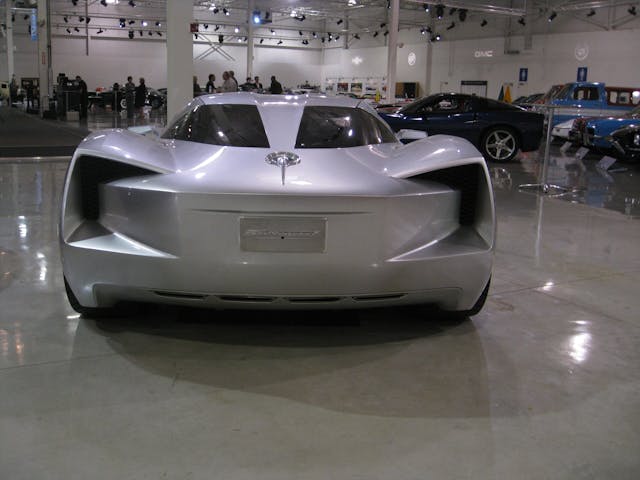


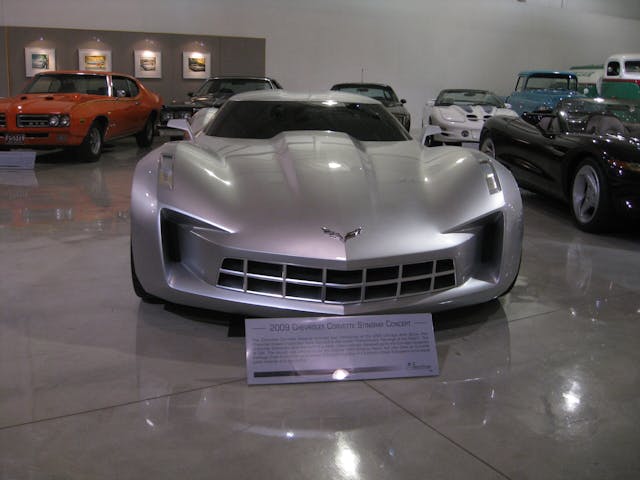



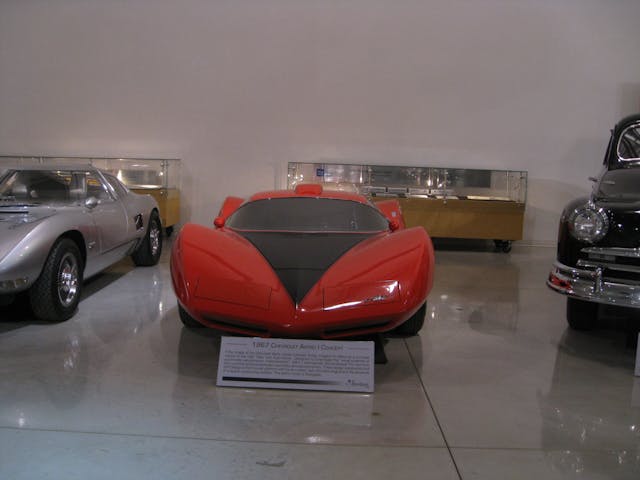
















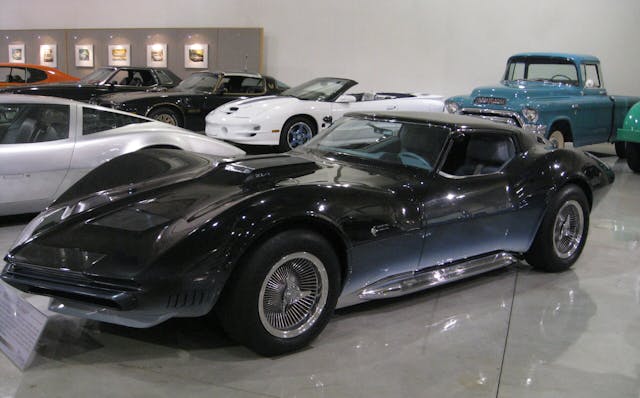






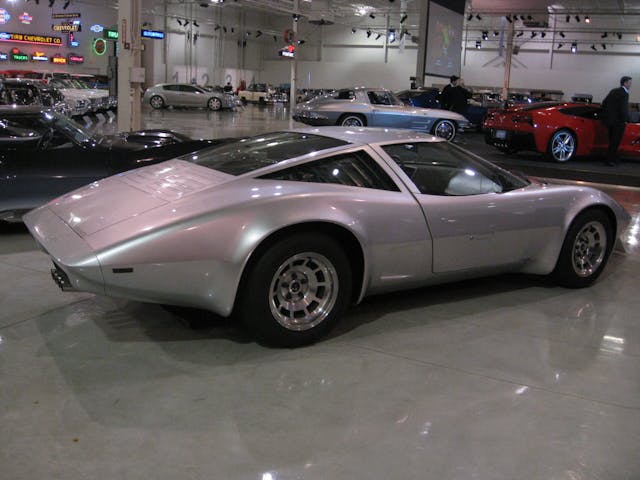
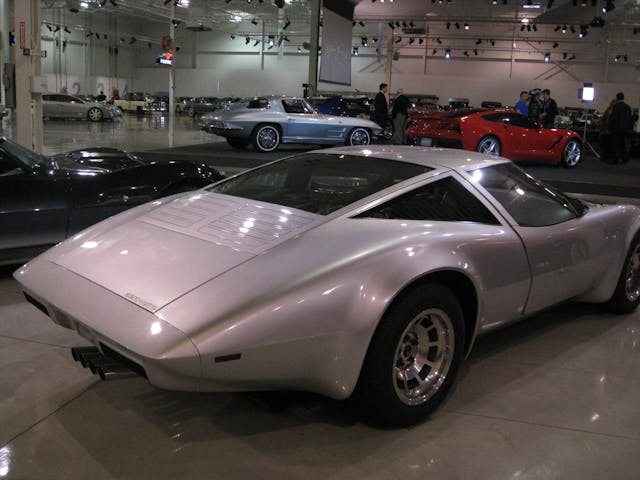















***
Check out the Hagerty Media homepage so you don’t miss a single story, or better yet, bookmark it. To get our best stories delivered right to your inbox, subscribe to our newsletters.
The post 8 Corvette(ish) concepts you may or may not know appeared first on Hagerty Media.
]]>
You almost certainly know about the original DeLorean, the time-machine car from Back to the Future. You may also know that there are multiple car companies with “DeLorean” in their names. You probably do not know whether to believe the rumors that one of those companies plans to build a new DeLorean car based on the current-generation Corvette.
Believe them, the CEO of DeLorean Next Generation Motors (DNG) told Hagerty.
“I needed to find a way to build an affordable car for the DeLorean community,” says Kathryn DeLorean. “They’ll be heartbroken forever if I don’t give them something.”

Her solution: Buy a Corvette and have DeLorean Next Gen Motors replace the Chevy fiberglass with a body of DNG’s own design, complete with gullwing doors. The changes will be more than skin deep, too: DNG is working with aftermarket performance builders to bring this car to market.
Hang on, you may be thinking. What about the other DeLorean company, the one that’s making the Alpha5? That outfit is based in Texas, not New Jersey, and headed not by a member of John Z.’s family but by Joost de Vries, an executive who spent six years at Karma Automotive. Further complicating matters is that de Vries’ company is not to be confused with Classic DMC, founded by Stephen Wynne. A Liverpool mechanic who claimed rights to the DeLorean name in 1995, Wynne obtained the original company’s parts inventory and factory drawings. With them, he built a successful business servicing and reproducing parts for the original 9000 or so DMC-12s. (Wynne holds a minority ownership stake in what now bills itself DeLorean Motor Company, the makers of the Alpha5 who were until recently known as DeLorean Reimagined.)
If you smell a legal battle in the future, that nose is working.

Company origins aside, the products proposed by each DeLorean-named firm are easy to tell apart. Designed by ItalDesign and unveiled at the 2022 Pebble Beach Concours d’Elegance, the Alpha5 shown above is only available as an EV. Specs are few: a targeted range of 300+ miles, a battery pack with a capacity of more than 100 kWh, a drag coefficient of 0.23, 0 to 60 mph in under 3 seconds, and a top speed of 155. Cambridge Audio will supply the stereo. Kelley Blue Book says that the company is targeting a starting price around $125,000. Like all the numbers above, that, too, is an estimate.
Rather than take on the Alpha5 with a direct competitor, DNG has chosen a two-pronged approach, aiming significantly below and above Alpha5. At the top of DNG’s proposed hierarchy sits the Model JZD, a hand-built model of which only 42 will be made. (If you have to ask why, you haven’t read The Hitchhiker’s Guide to the Galaxy.) It will, naturally, be priced far above $125K. The Corvette-based model, which so far does not have its own name, will be the more accessible model in Kat’s portfolio.
A base Corvette, as she pointed out, is a car that many normal people can aspire to own. From that statement, we expect that the planned bodykit is intended for the base C8, which costs a hair below $70K and packs a naturally aspirated LT2 V-8 making 490 hp and 465 lb-ft of torque. (Corvette faithful will note we were assiduous in our pursuit of affordability and did not even spec the Z51 package for this theoretical exercise.)

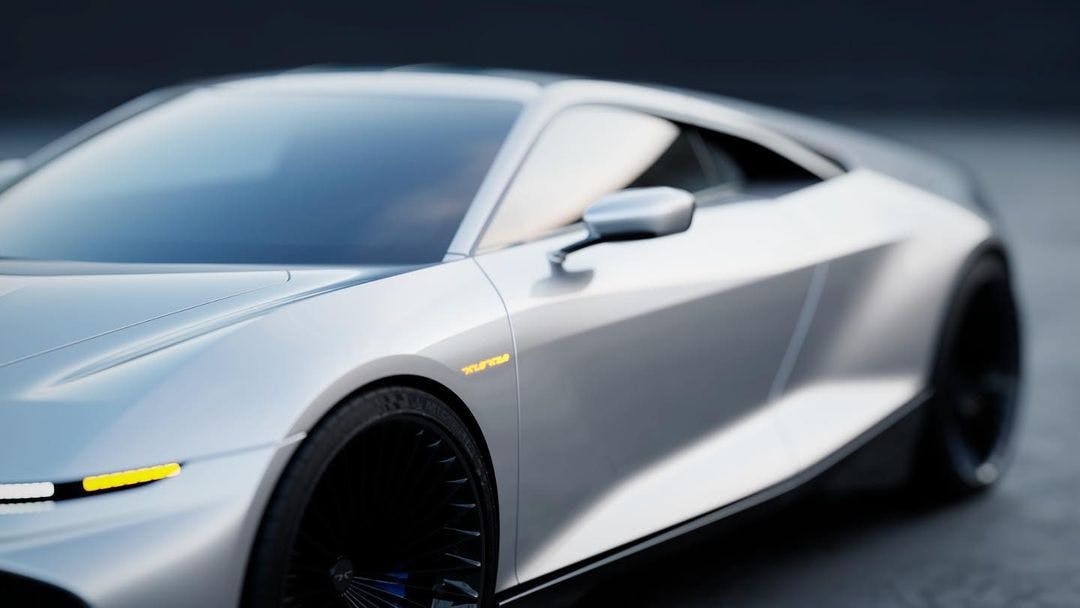
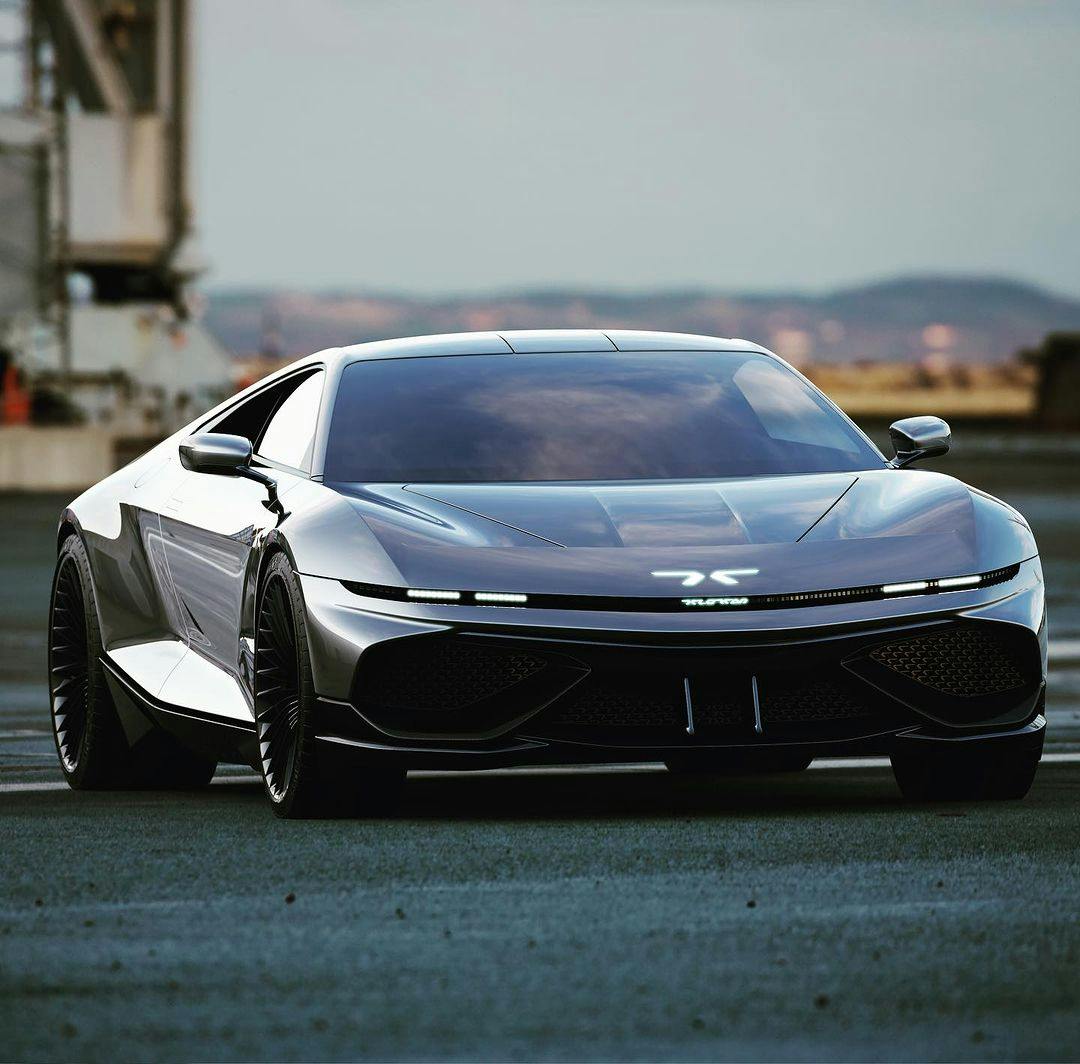
Thanks to the traditional Corvette targa top, which required Chevrolet to route the rollcage away from the tops of the front-hinged doors, Kat says that a gullwing conversion is doable. Whether the DeLorean body kit would also fit on the wider-bodied Z06 or on the hybrid, AWD E-Ray, we don’t know. For now, all we have are renders, penned by Ángel Guerra, an automotive designer and modeler who spent six years with Croatian EV firm Rimac and stuck with the company after its merger with Bugatti in 2021.
Choosing a Corvette as the foundation of an affordable DeLorean is only fitting, Kat says. Though most know John Z. as the head of his own company, he established his career at General Motors, a firm with which he spent 17 years. From ’69 to ’72, he was head of Chevrolet and, according to his daughter, was pushing hard for the Corvette to move to a midengine platform, something the model’s godfather, Zora Arkus-Duntov, also supported. After John left Chevy in 1973 to found DMC, he even tried to purchase the engineering for the mid-engine Aerovette—but Chevrolet, understandably, denied him.
A DeLorean-bodied Corvette, Kat says, “allows me to finish my dad’s story. I’m building him his dream car.”
One thing is for sure: The story of the DeLorean car in the 21st century is only getting started.

***
Check out the Hagerty Media homepage so you don’t miss a single story, or better yet, bookmark it. To get our best stories delivered right to your inbox, subscribe to our newsletters.
The post EXCLUSIVE: V-8 DeLorean on the way, based on C8 Corvette appeared first on Hagerty Media.
]]>
Standing alongside the bright blue CERV III concept—a 650-horse, mid-engined, all-wheel-drive Corvette concept from 1990—Corvette chief engineer Tadge Juechter sought to explain the new E-Ray in a historical context. We were in Denver, at the first-drive event for Chevrolet’s first production all-wheel-drive Vette, the first to have an electric drive motor.
Juechter reminded us, too, that Corvette dabbled in powering all four wheels with the CERV II concept, completed by Corvette legend Zora Arkus-Duntov in 1964. Then, as now, additional technologies like all-wheel drive were added to amplify performance. In the 2024 Corvette E-Ray, Juechter noted, electrification is a means to that end.
“This is a performance hybrid, and the result of what sports car maniacs do when they get ahold of this technology,” he said. “We knew we were going to do an all-wheel-drive car when we committed to a mid-engine platform, so we studied options for mechanical or electric drive for the front wheels. The outcome wasn’t even close.”




In interviews on site, other members of the Corvette team confirmed that the E-Ray’s V-8-in-back/electric-motor-up-front layout was optimal for packaging, for keeping parasitic drivetrain losses at bay, and for overall performance. Knowing that powering four wheels inevitably adds heft, they stressed their efforts to trim weight wherever they could. The electric front drivetrain components (all of which are built in-house), along with changes to the front shock towers to accommodate the axles, add about 265 pounds over the Z06. (You can take a deep dive into more technical aspects of the E-Ray here.)
Specs: 2024 Chevrolet Corvette E-Ray
Price: $104,900 (Price as tested: $130,905)
Powertrain: 6.2-liter V-8, permanent magnet motor with 1.9-kWh lithium-ion battery; 8-speed dual-clutch automatic
Horsepower: 655 combined (495 gas/160 electric)
Torque: 595 lb-ft combined (470 gas/125 electric)
Layout: all-wheel-drive, two-door, two-passenger coupe
EPA-rated fuel economy: 16 city, 24 highway, 19 combined
0–60 mph: 2.5 sec
Competitors: Porsche 911, Mercedes-AMG GT
Though the E-Ray is a hybrid, it is not a plug-in. As such, its small battery does not permit much pure-electric drive range—four miles, tops. Its purpose is to enable a more versatile all-weather, all-season Corvette with a very approachable 655 total system horsepower, 160 of which electrically powers the front wheels. It also launches like no other production Corvette in history. Zero-to-sixty comes in 2.5 seconds, a tenth quicker than the Z06 and four-tenths quicker than the Z51 Stingray.
Drag-race prowess aside, the E-Ray is positioned as a high-tech grand-touring option in an expanding Corvette lineup designed to meet a broader array of buyers. Think Z06 pace, absent the edgy, track-focused chassis tuning and the LT6 engine’s flat-plane-crank wail.


We were handed the keys to a Sea Wolf Gray Tricoat Corvette E-Ray—a new color for 2024—and encouraged to disappear into Colorado’s Rocky Mountains. At $130,905, this top-trim 3LZ example came packed with $9880 worth of aesthetic bits, including carbon-fiber accents inside and out, a red engine cover, and black exhaust tips. Other add-ons: the popular Front Lift (a $2595 option that is certainly cheaper than front bumper repairs) and the $500 Performance Package (larger rear wickers and Michelin Pilot Sport 4S summer tires). To demonstrate just how capable the E-Ray was on the base tire, however, our tester was re-fitted with Pilot Sport all-seasons.
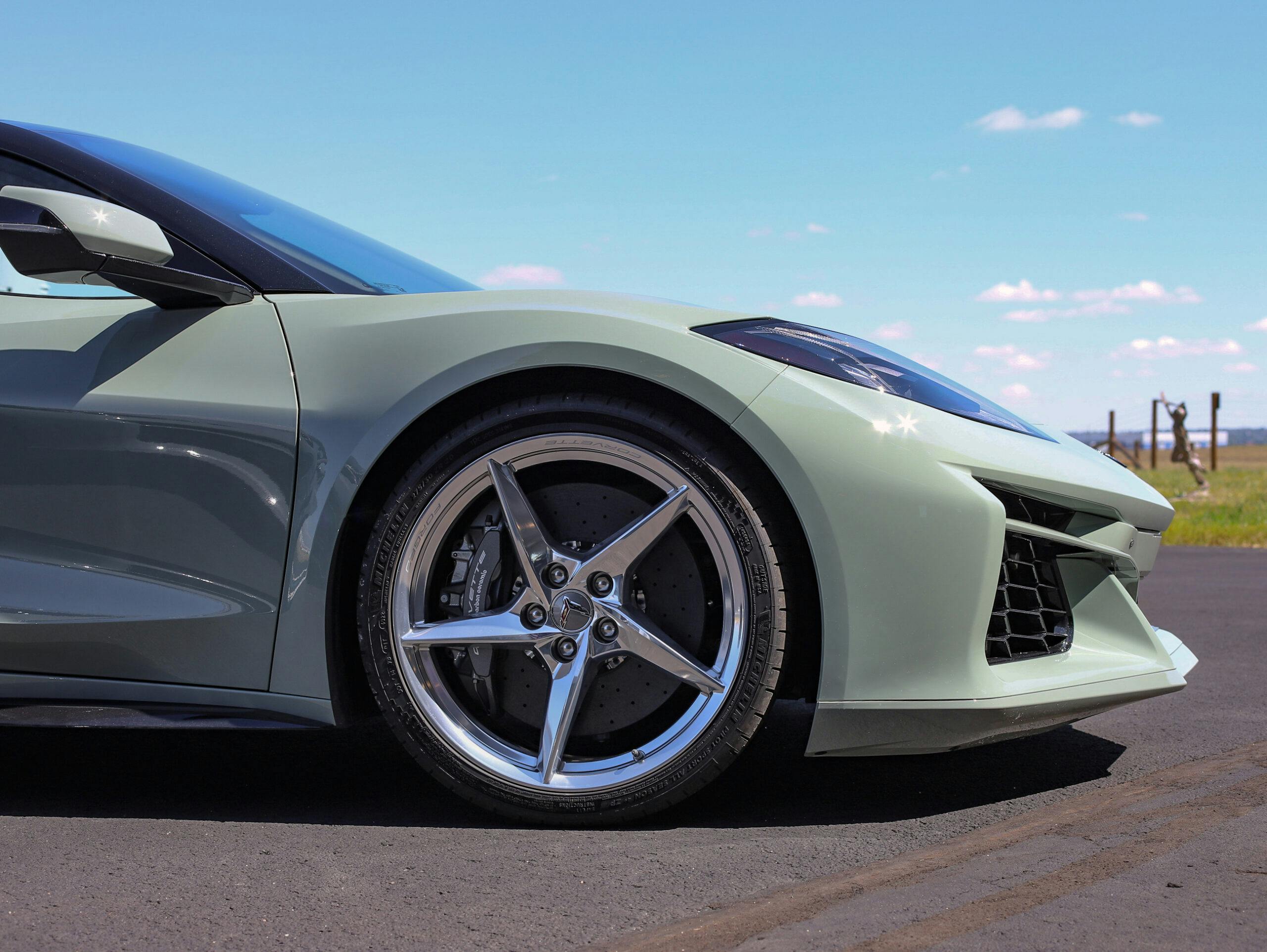

The first thing you notice when you walk up to the E-Ray is the absence of black accents. All of the car’s body panels are shared with the Z06, but the front fascia and the strakes along the enormous side intakes are instead painted to match the color of the body. The handsome, thin five-spoke wheels look like they came out of a Ferrari catalog, more sports car style than motorsport-butch. Even in flashy look-at-me colors, the E-Ray gives off an air of restraint when compared with the more manic Z06.
Inside, as has been the case since the inception of the C8, you can order your interior as ostentatious or as toned-down as you like. The E-Ray’s interior is the same as the others in the lineup, though a new color—Artemis, a soft green-gray hue—has been added. Our car’s Natural tan coverings, accompanied by a wash of carbon accents, felt in line with the car’s price point and near-luxury comfort pretenses.

We opted to start our journey in Stealth mode. It’s the E-Ray’s pure-electric function, intended for leaving your neighborhood without angering the Joneses next door. Novel silence and a slight hum filled the cabin as I poked the start button. That’s about all Stealth mode provides, however. Air conditioning is not available in this mode, as the 1.9-kWh lithium-ion battery doesn’t pack enough punch. Once you reach the limits of the battery (either by mileage, by exceeding 45 mph, or by using more than 30 percent throttle) the 495-horse 6.2-liter LT2 V-8 kicks on, and the only way to return to Stealth mode is to shut off the car and restart it. All this is to say, the E-Ray is not an electric sports car in the sense some people might expect. The electrification supplements, deepens, and alters the scope of Corvette performance and the environments in which it is usable; in this context, Stealth mode is best thought of more as a handy add-on than a prominent feature.
It didn’t take long for us to appreciate the E-Ray’s grand touring recipe. Eighth-generation Corvettes have been competent cruisers since day one, and even the Z06 isn’t too jarring for long journeys. The E-Ray, though, takes that a step further. Bolstered by its electric motor, there’s a dissonance between the E-Ray’s unburdened, almost relaxed V-8 sounds and the immense pace the car so effortlessly carries. It’s a wholly different personality than the Z06’s urgent, ever-thrumming sound and sharp-edged handling.

Because of that, during the early part of our road drive, we found ourselves wondering whether the E-Ray was too docile and buttoned down for something of its looks and capabilities. As our route began to bend through the mountains west of Denver and we pushed the car harder, the E-Ray began to hint at its potential, but always with an unflappable, “I got this” demeanor.
Effortless power delivery and a stratospheric performance envelope constitute the E-Ray’s personality. Torque arrives early and linearly to all four wheels, backed up by Michelin all-seasons (345-section in the rear, the largest such tires offered on a street car) that offer far more grip than can be safely used on the street. The pull from the front axle—a feeling that takes some getting used to in a Corvette—builds trust that the front end will actively guide the car’s trajectory as you exit corners on throttle. The uniquely tuned Magnetic Ride Control suspension, softer than the Z06’s, keeps the chassis poised and unperturbed by imperfections. There’s very little theater associated with carrying speed in this car, and never a moment on the street when the E-Ray feels like it will run out of give.




That said, the E-Ray is still fun. It’s still a C8 Corvette, which means it delivers all of the brilliant chassis feedback we’ve come to expect from recent General Motors performance vehicles, including the Cadillac CT4-V and CT5-V Blackwings. Even the steering, now forced to accommodate the additional mechanical components and thrust of all-wheel drive, conveys a clear sense of what the front end is up to.
We did, however, encounter a foible unfamiliar to the Corvette faithful: torque steer. Heading into a valley, while on throttle and driving over changing camber on a low-grip surface, the wheel pulled left in a quick instant. Over our hours of street and track driving in the E-Ray, this jitter only occurred with one perfect confluence of circumstances. But it served as a salient reminder: the E-Ray is a different kind of Corvette.
How different? These same all-wheel-drive dynamics put to rest any concerns about the E-Ray’s personality at the rough-surfaced Pikes Peak International Raceway (PPIR). With enough room to fully stretch its legs, the E-Ray’s relaxed confidence on the street translated to approachability on track.

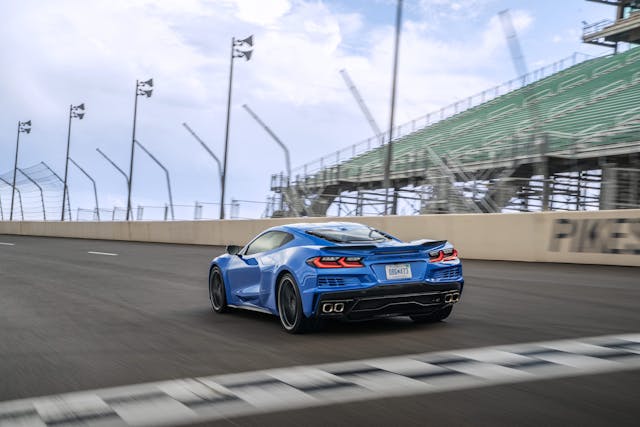

“The stability that’s built into the car is a little bit on purpose, and a little bit comes for free,” explained vehicle dynamics engineer Stephen Padilla. “Given the broader mission envelope of the E-Ray, we set up the suspension to yield a Corvette that’s easier to quickly get comfortable with compared to the Z06. And the fundamentals of an all-wheel-drive platform are inherently going to contribute to that goal.”
Effectively applying 655 horses to road course pavement is rarely this easy. Despite the gritty surface, the E-Ray (equipped with the Michelin Pilot Sport 4S summer tires for the track session) launches without fuss, hurtling past triple digits in seconds.
PPIR’s road-course-oval configuration contains several pavement transitions that require vigilance at speed, but the E-Ray traversed them with confidence. As we modulated the standard carbon-ceramic brakes with the ever-firm pedal, the eight-speed dual-clutch transmission grabbed the proper downshift every time, without hesitation.

While you’ve got your eyes up in the brake zone in preparation to crank the wheel at corner entry, the E-Ray’s regenerative braking charges the battery. Optimized for continuous discharge and recharge, the battery is capable of several laps at full capability around this one-minute circuit. The system is always active and never fully discharges. When the battery is low, the motor will adjust its protocol and contribute primarily during on-throttle cornering to maintain consistent handling dynamics. The Charge+ mode more actively uses the electric motor as a generator to replenish the battery.

Unless you’re trail braking, the E-Ray gives a faint brush of turn-in understeer at the limit. Remember—this is the kinder, gentler high-horsepower Corvette. Your fastest pace requires getting the car pointed to corner exit as soon as possible, and then stomping on the throttle; from corner apex to the edge of the track is where the E-Ray’s all-wheel drive and brutal thrust shine. Its chassis is not knife-edge precise like the Z06—nor is it supposed to be—but the E-Ray will lay down a seriously fast lap without unsettling drivers with less experience or suboptimal car control.
Unfortunately, our track time was cut short by a warning notification from the Performance Traction Management system (GM’s driver aid featuring adjustable traction and stability control, commonly called PTM). The other two drivers on track with us suffered the same fault. GM has since told us it was the result of a preproduction bug that has since been worked out of the system. The E-Ray is the first car in which PTM—renowned for its scalability and non-intrusiveness—has been used in an all-wheel drive configuration. In this application the system has the benefit of an additional front axle to dial inputs, but that sword cuts the other way in the form of added complexity.

To stress the E-Ray’s agility and capacity to misbehave with the best of its rear-wheel-drive Corvette siblings, Chevy offered up an autocross course with a drift circle. All-wheel-drive calibration engineer Jason Fahland shared a bit of guidance as we sat between the start cones: “The E-Ray takes less countersteer input than you would need in a rear-wheel-drive car. If you keep more steering lock in it,” he added, “it’s going to keep that side slip going.”

The big-fendered E-Ray scythed through the cones better than you might expect, pulling toward apexes with the nose under measured throttle and happily rotating the rear at full tilt. Breaking the rear end loose on the drift circle came like this: Initiate the turn, find the lateral limit, and then stab the throttle. Holding the drift proved a more delicate balance between just the right throttle inputs and, as Fahland said, less countersteer than we’re accustomed to. With another session to practice (and perhaps another set of tires, since we threw a cord in a cloud of tire smoke on our second trip around the circle), we’d have cracked the code. Not all the journos present could get the car sideways, though, and some complained of understeer. At the end of the day, the E-Ray will flatter most drivers.

That the all-wheel-drive E-Ray can enthusiastically drift, turn a lap time within a breath of a Z06, and then cruise along quietly while coddling its occupants is a testament to the technology and tuning behind it. Difficult as it is for yours truly—an adamant track rat—to admit, not everyone who wants a Corvette can live with the Z06’s high-intensity, feverish personality. Still, most wouldn’t mind similar pace, and the E-Ray provides it with a bit less amygdala tickle.
Over its seven-decade run, the Corvette has meant a lot of different things to a lot of people: Road course terror. Summertime companion. Quarter-mile monster. But it’s always been an American innovator. The E-Ray is all of those. Now, Chevy would argue, it’s also an all-weather cruiser. Through that lens, the groundbreaking E-Ray needs little explanation.
2024 Corvette E-Ray
Highs: A high threshold that isn’t hard to reach; monstrous launch; pace on the street feels effortless.
Lows: Light on personality at lower speed; preproduction tech hiccups limited our seat time; price tag for the top trim is no joke.
Takeaway: An all-American, grand touring, modern marvel.












***
Check out the Hagerty Media homepage so you don’t miss a single story, or better yet, bookmark it. To get our best stories delivered right to your inbox, subscribe to our newsletters.
The post 2024 Corvette E-Ray First Drive: Unstressed express appeared first on Hagerty Media.
]]>
Search for “all-wheel-drive Corvette” and you’ll get pages and pages of results pointing to the new, hybrid C8 Corvette E-Ray, which has an electric motor powering the front wheels in addition to the V-8 combustion engine driving the rears. You might also find any one of a number of C3 Vette bodies mounted, monster truck–style, on 4WD SUV or truck chassis. If you dig deeper, though, you’ll discover that more than 30 years ago, General Motors made a pair of nearly production-ready Corvette concepts with all-wheel drive baked into their designs, and just like the AWD E-Ray, they were also mid-engine cars. Those vehicles would be the 1986 Corvette Indy and 1990 CERV III concepts.

If you’re pedantic, as I am, though, you might quibble with calling them the first all-wheel-drive, mid-engine Corvettes, because another predates them. The CERV III concept was the last of a trio of experimental mid-engine performance cars developed under the direction of Corvette chief engineer Zora Arkus-Duntov. CERV originally stood for Chevrolet Experimental Research Vehicles and was the appellation used for the Corvette team’s forays into mid-engine design, starting with the CERV I in 1962, which was GM’s version of the mid-engine open-wheel racers then starting to dominate Formula One and soon to win at Indianapolis with a Ford-powered Lotus.

CERV I had a conventional rear-wheel-drive layout, but CERV II was not just the first mid-engine car out of the Corvette program with four-wheel drive, it may well have been the first car in general with that layout and drive configuration. The U.S. Patent and Trademark Office certainly thought it was novel, granting Duntov a patent. Perhaps it was too novel. With a torque converter and two-speed Powerglide transmissions at both ends of the longitudinally mounted V-8, I don’t believe any other car, concept or production, has ever had a similar drivetrain.

If the CERV II may look a bit like it could have competed with the Ford GT40, there’s good reason, because that’s exactly what Duntov and Chevrolet general manager Semon “Bunkie” Knudsen had in mind: taking it endurance racing at Sebring and Le Mans. Whether or not Knudsen and Duntov had gotten word of the GT40, the project started in 1962 and was completed in 1964. Larry Shinoda, who drew the 1963 Corvette, and Tony Lapine, later head of styling for Porsche, were responsible for the styling of the body wrapped around the aluminum monocoque. The original plan was to build six of them for a team of three cars, but then the word came down from GM brass to get out of racing, at least publicly.

Some of that technology, though, made it out the back door of GM’s Tech Center. If the work of Shinoda and Lapine also makes you think of Jim Hall’s Chaparral racers, the resemblance may not be a mere coincidence. Hall had a close relationship with GM’s skunkworks, which got around corporate rules by testing cars at Hall’s Rattlesnake Raceway near Midland. Midland, Texas, that is, not Midland, Michigan—far from Detroit’s prying eyes. The Chaparral 2A was pretty much a reskinned Grand Sport II, which was developed at the same time as the CERV II, and shared much of its technology. Besides the Chaparral’s aerodynamic wizardry, they were revolutionary for using automatic transmissions, just like the CERV II, only just one per vehicle. Hall is reported to have had seat time in the CERV II during its development.

It would be more than two decades before another mid-engine, all-wheel-drive Corvette would make an appearance.

By the mid 1980s, General Motors owned Lotus, and working with Lotus Engineering it developed a 2.6-liter twin-turbo V-8 capable of 600 horsepower. It’s not clear if GM ever intended to go racing with that engine, but 1986 was the same year the production Corvette was chosen to be the pace car at the Indianapolis 500, and that engine was theoretically the basis of a sensual concept called the Corvette Indy. The Indy had all the bells and whistles: a composite monocoque; a long and lean but muscular carbon fiber and Kevlar body designed by Chuck Jordan and Tom Peters; four wheel steering-by-wire; ABS and traction control (remember, this was almost 40 years ago); electronic throttle control; and active suspension. That last was supplied by Lotus in addition to the engine work.
It’s not clear exactly how engineers effected all-wheel drive in a car with a transverse V-8 mounted midship and a transmission aft of the engine. They would have had to route power around the engine or have a second drive off of the flywheel. Remember, though, this is a company that used a chain drive and an oil sump with a hole through it for an axle shaft in the original FWD Cadillac Eldorado. I’m sure they figured out a way to get motive force to the front wheels.

HVAC and infotainment controls were mounted on the scissor doors, which when closed formed the Indy’s panoramic roof. Inside was a center-mounted CRT display with an early navigation system. It took just six weeks for Peters and Jordan to go from drawings to a full-size clay made by Cecomp in Turin. That was a pure show car, which may explain why there were no functional side windows, or much interior space. Reaction to the show car was, however, strong enough that the Corvette team made two more Indys, a fiberglass pushmobile for the show circuit and a functional one used for testing. Instead of a screaming, small-displacement twin-turbo proposed for the concept, the engineering car had the Lotus-designed 32-valve DOHC 5.7-liter V-8 later used in the C4 ZR1, with 380 horsepower. Said to be capable of 180 mph, the working Corvette Indy is in GM’s corporate collection, while the clay mockup is at the National Corvette Museum in Bowling Green, Kentucky.

Although the Corvette Indy was not a practical vehicle, GM seems to have given actual thought to producing its offspring, the CERV III, revealed at the 1990 Detroit auto show. It spiffed up the Indy with a more exotic mix of composite materials, this time including Nomex, and suspension pieces made of titanium. A CRT display was controlled by something that could probably operate a gamepad and there was a cassette-based moving-map nav system, again years before GPS was available for civilian use. Mechanical improvements were two Garret T3 turbos that upped engine output to 650 hp, a three-speed Hydramatic turned into a six-speed, and dual brake discs at each wheel.
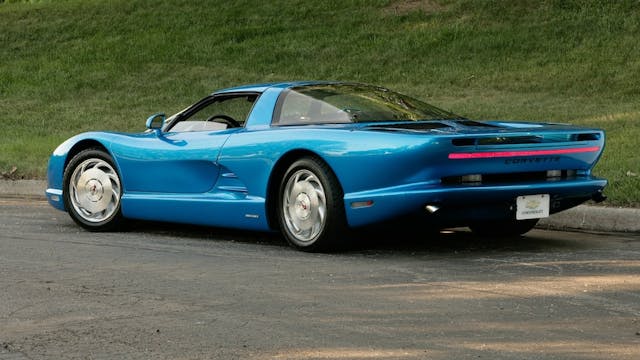
Styling changes also indicate at least some consideration for production. The nose was shorter than the Indy’s and higher off of the ground, to comply with federal bumper height requirements. Side glass was shaped so it could go down and wheel arches provided enough clearance for real world suspension travel. Like the Indy, the CERV III had scissor doors, only with with a conventional roof, whose profile was shared with the production C5 Corvette. Capable of 225 mph, 0–60 mph in under 4 seconds, and able to pull 1.1 g on the skidpad, the CERV III had supercar performance for its day. Two things kept it from production, though. GM executive Mark Reuss said that the early, 1990-era computer-controlled active suspension had too much latency, and GM bean counters said they’d have to charge between $300,000 and $400,000 at a time when a base Corvette coupe was $32K and a ZR1 was $59K. Like CERV I and CERV II, CERV III is in GM’s corporate collection.
It’s conceivable that GM could have made a simpler, less expensive version without all the gizmos, the steering by wire, four-wheel steering, trick brakes, expensive four-cam aluminum engine, etc. And the world would have seen a mid-engine corvette decades before the C8. By then, however, GM managers decided to go with the legacy front-engine layout and instead make incremental improvements in the C5 Corvette.
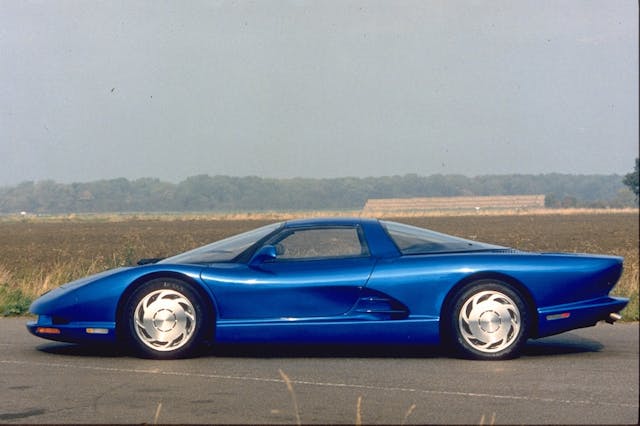
















***
Check out the Hagerty Media homepage so you don’t miss a single story, or better yet, bookmark it. To get our best stories delivered right to your inbox, subscribe to our newsletters.
The post No, the E-Ray isn’t the first Corvette with all-wheel drive appeared first on Hagerty Media.
]]>
Spy Photographers have captured images of what appears to be a C8 Corvette ZR1 development mule undergoing dynamic testing at the Nürburgring Nordschliefe in Eifel, Germany.

Holy wing, batman.
The ZR1 will be the gnarliest C8 yet, wilder than either the razor-sharp Z06 or the future-focused hybrid Corvette E-Ray. The photographers claim that the ZR1 was testing two different rear wing configurations, but we only see one in this gallery. That said, we did see another ZR1 mule earlier this year that definitely has a smaller wing on it, so we’ll roll with their claim.
There’s precedent for two different wings. The C7 ZR1 offered two different aero packages—the base one and a much more aggressive ZTK package which was capable of producing 1000 lbs of downforce. Expect a similarly bonkers number for the wilder of the two packages on the C8 ZR1, assuming that we will get two variants. Heck, there might even be active aero, a-la the Porsche 911 GT3 RS.

Aside from the rear wing, there are a few other bodywork tweaks that stick out. First, those vents on the hood: The ZR1 will, predictably, build huge amounts of heat from any number of high-performance engineering components. Those openings are likely heat extractors to help manage temps on the front brakes, or perhaps as an exit for the air flowing over one of the ZR1’s many, many heat exchangers.

Second: There are two little vents just behind the main intake channels on the sides of the car. We’ll speculate here: The ZR1 is expected to use an upgraded, twin-turbo variant of the LT6 DOHC V-8 engine that powers the Z06. In the ZR1, it’s rumored that this engine will be called the LT7 and could pump out nearly 800–850 hp. Perhaps those openings are separate intakes directly ramming air into the turbos? Maybe they’re new channels to blast ambient air onto the dual-clutch automatic transmission that’s going to be banging off gear shifts at a frantic pace? Cooling ducts for the rear brakes, which look extremely large? Whatever they’re for, we dig ’em.

As far as shoes go, the mule seen here has some ridiculously wide rear wheels, likely necessary to cope with all the power that this beast is going to be putting down. The fronts aren’t exactly svelte either, and the sticky rubber that’s sure to come standard here should make for exceptionally deft handling traits. (GM engineers are kind of wizards when it comes to that stuff.)
It’s unlikely that we’ll see any sort of hybridization in the ZR1—that honor will likely be reserved for the Zora, an even wilder version of the C8 that’s supposedly also in the works. If that’s true, the C8 ZR1 could be the final pure-ICE Corvette ever, a milestone that will certainly carry weight with collectors and enthusiasts down the road.

If the thing drives as menacing as it looks, it might be time for tracks everywhere to dust off those lap record boards. The new king of the Corvettes is coming.






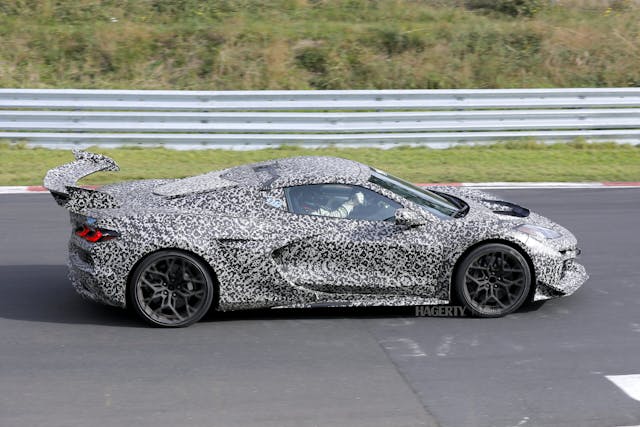




***
Check out the Hagerty Media homepage so you don’t miss a single story, or better yet, bookmark it. To get our best stories delivered right to your inbox, subscribe to our newsletters.
The post C8 Corvette ZR1 spied charging ’round the ‘Ring with mega wing appeared first on Hagerty Media.
]]>

Since 1963, the International Show Car Association (ISCA) has been ubiquitous in the world of indoor, large-scale car shows. Thanks to the participants, judges, and event planners, we’ve seen decade after decade of advancements in design, engineering, and technology. Times change, but some efforts are timeless. Rarely do we get to see a former ISCA show car that survived and thrived after its 15 minutes of fame—and that’s where this particular 1964 Corvette convertible (discovered via Barnfinds) comes into focus.
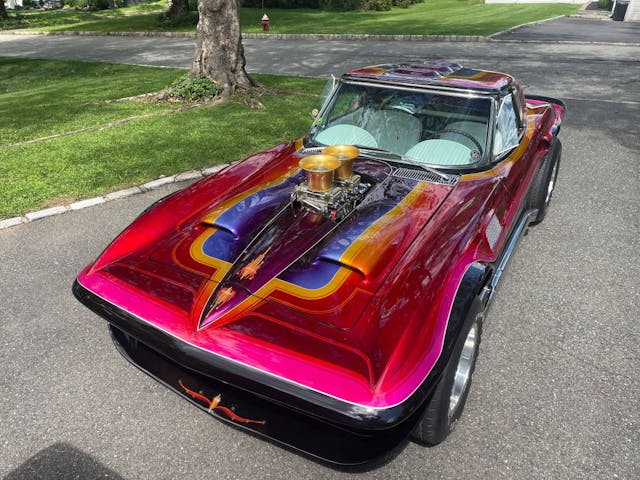


It’s currently for sale on Craigslist with an asking price of $69,500. It is a fair ask for just about any C2 Mid Year Corvette, but the provenance presented here goes far beyond being a unique options-list configuration. The seller states this Corvette entered the ISCA show circuit in the late 1960s, and was the “number one ISCA competition show car and points winner in its class for the ’66–67 year.”
Those claims might sound like those of a stereotypical seller, working overtime to tart up a car to unsuspecting buyers, but the sheer volume of historical documentation in this Craigslist ad suggests otherwise.
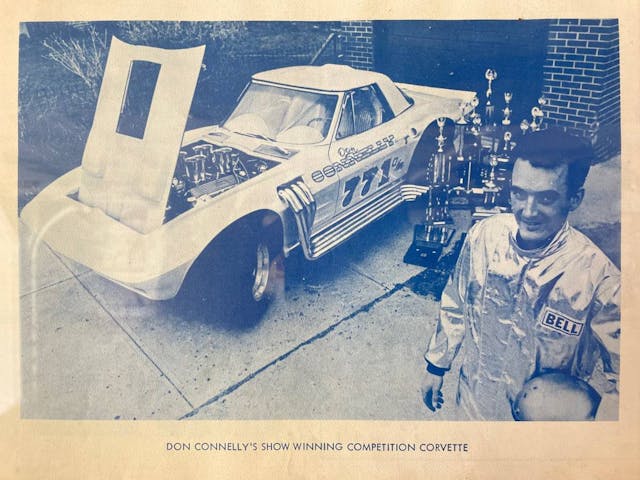

The seller states this Mid Year Corvette was originally finished in Ermine White with a 375-hp “fuelie” small-block, complete with a four-speed manual transmission and a rear end with 4.11:1 gears. But its owner, Don Connelly, modified the Corvette to be a Pikes Peak race car in 1965, which then made the transition to ISCA stunner. As the photos above show, this Corvette has seen several paint jobs, different sets of long-tube headers, various induction systems, and different graphics.

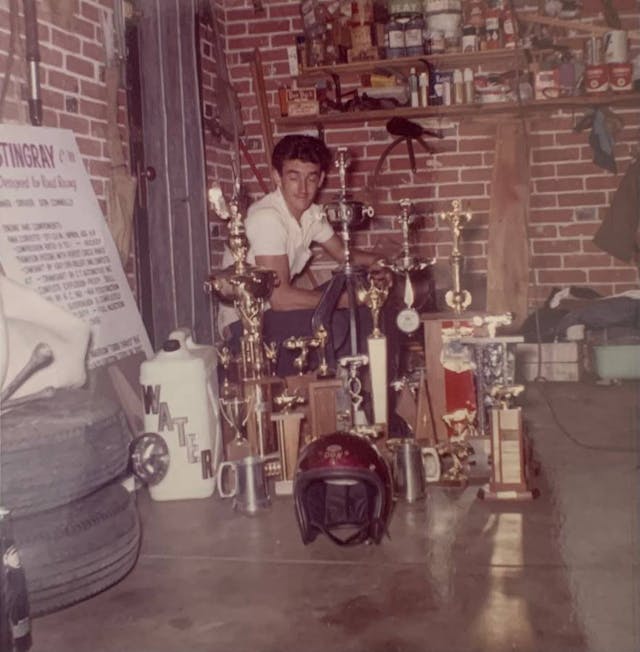


The seller suggests Don’s Corvette had multiple paint schemes “from ’65 to early ’70s,” including this yellow-ish hue seen in vintage photographs. (That’s definitely not the factory Ermine White.) Clearly, Don was proud of his car: You can spot him in these photos with a large number of trophies, presumably from a car that the promotional material suggests is the “Number One Competition show car in the USA.”


The interior shows the same level of attention to detail, though it is more restrained than the exterior’s race liveries or later paint jobs. The cream-colored tuck and roll upholstery really highlights the Mid Year Corvette’s elegant, dual-cove dashboard and removable hard top. The Hurst shifter and chromed rollbar are probably race items that survived the Corvette’s transition into a show car. Which begs the question, do modern show cars with racing bits affixed to them owe a debt of gratitude to Don and his 1964 Corvette?



The Corvette’s underside is still show-car fresh. It suggests that vintage ISCA entries didn’t need extensive chrome plating, loud colors, or impressive hardware polished to perfection to steal the judges’ hearts. Instead, we see what makes the Mid Year Corvette so special: a fully independent suspension, finished in black, dirt-free to this day.

The polished-up and chromed-out engine bay has everything a 1960s show car with a small-block Chevy needs to wow the crowds, but the real money was spent on making the Mid Year’s body. The paint job is period-correct for a show car from the late ’60s or early ’70s, and the seller states this lacquer finish “shows beautifully.” There are dual hood scoops, open-air cleaners, a frenched antenna, dovetailed rear fascia, pinstriping, mag wheels, etc. but the real beauty lies in the fact that everything remains in time-capsule condition. Of course, that time capsule isn’t from 1964, and that’s why this Corvette is worth discussing.
How this 1964 Corvette survived the 1990s and 2000s in this condition speaks volumes about its owner(s). I have heard of a 1970s-era custom Mid Year being returned to stock by a new owner with no connection to the custom work: Such builds fall into disrepair over time and are often more valuable when restored to stock. Let’s also remember that Corvette fiberglass repair panels are readily available and fairly easy to install by most trained body shops. All of this makes this particular Corvette a true survivor worthy of sitting next to a factory fresh L-88. Perhaps more so, because it retains the vibes of when a small-block, Mid Year Corvette was heavily depreciated, not terribly appreciated.
If the pictures are any indication, this Corvette stands on its period-correct show car attributes very well. Even better, it proves how the right paint job, wheels, and custom parts of an era can make any car look great, long after it makes its exit, stage left from the show-car scene. We’re just lucky this ISCA Corvette survived the “hard times” so that it can thrive today.

***
Check out the Hagerty Media homepage so you don’t miss a single story, or better yet, bookmark it. To get our best stories delivered right to your inbox, subscribe to our newsletters.
The post We’re glad nobody restored this groovy Corvette to factory-spec appeared first on Hagerty Media.
]]>
Larry Carpenter has a long history with Chevrolet Corvettes, stretching back more than 40 years. The backstory of one of his more recent purchases, however, is still clouded in mystery. This ’56 was a former drag racer and certainly must have had a colorful past, but Carpenter, of Ogden, Utah, hasn’t had much luck digging into its quarter-mile exploits. Perhaps you or someone you know remembers seeing this straight-axle Corvette competing in Modified Sports Car classes in the ’60s and can help shed some light on details. Here’s a look:

Carpenter’s love of Corvettes goes back to his teens. “My dad was a Ford man,” said Carpenter, who let brand loyalty skip a generation. “In high school, I decided I wanted a Corvette.” His father thought that Corvettes were hard to work on. We suppose anyone who’s tried to service a big-block Corvette would have a tough time arguing. Despite his father’s protests, Carpenter bought his first Corvette just before his senior year in high school. It was a 1964 convertible with a 365-horsepower L76 327.

“I’ve probably had about 35 different Corvettes.” Carpenter admitted. His collection was never too large though, because his desire for a different Corvette would necessitate selling one to free up the room and the money to grab another. Today though, he’s less interested in selling any of his current fleet to acquire a new one. Over the past 40 years or so, Carpenter’s collection has included mostly second-and third-generation Corvettes. If there’s one theme tying them all together, it’s that none have remained stock. On the contrary, Carpenter seems to have a habit of buying banged-up race cars or basket cases and giving them a new life, with little reverence for concours-type restorations. “I’m not a purist,” Carpenter stated, completely at peace with the fact that his cars would be shunned by the National Corvette Restorers Society. “To me, NCRS means ‘No Components Remain Stock’.”
Indeed, his idea of a “100-point” car is one that has 100 aftermarket parts. We’re not casting aspersions on Carpenter’s taste, far from it: We’re fans of race-prepped ‘Vett`es and the godfather of Corvettes himself, Zora Arkus-Duntov, was a big proponent of giving Corvette buyers the parts needed to make them competitors on the track. Even if Carpenter’s Corvettes don’t remain stock, there is a theme, and it’s often a period-correct look from the late ‘60s to early ‘70s.
The car that’s spent the most time in Carpenter’s fleet is a ’66 coupe he’s owned since about 2014. It was a big-block drag racer that Carpenter swapped to a small-block and then back to a big-block. “It’s really a hot rod,” Carpenter explained, and it’s now equipped as a road racer, complete with Hooker side pipes. He also owns a 1972 Stingray that wears side pipes along with Torque Thrust wheels and an L88 hood.




Carpenter’s wife, Sandie, drives the 1960 Corvette that you see here. That was the first C1 Corvette in their stable. That car was purchased in the summer of 2016 as a running and driving car, but it was in the process of being stripped for paint. The fiberglass was in excellent shape, so it didn’t require any special work. The body was taken off the frame, the car was painted, and everything else was freshened up, including the engine. It had been equipped with a rather plain 350, but in keeping with Carpenter’s “day two”, or in this case, “year 10” aesthetic, the engine was treated to forged pistons, a more potent top end, and LT-1 livery, although it does use the famous Duntov 30-30 cam which offers a bit more high-rpm performance than the stock LT-1 bumpstick.
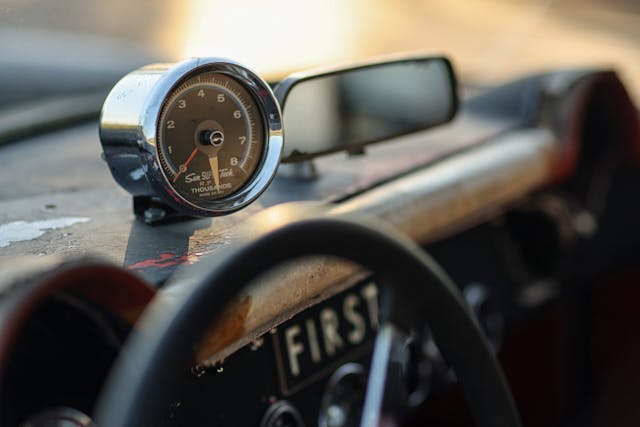
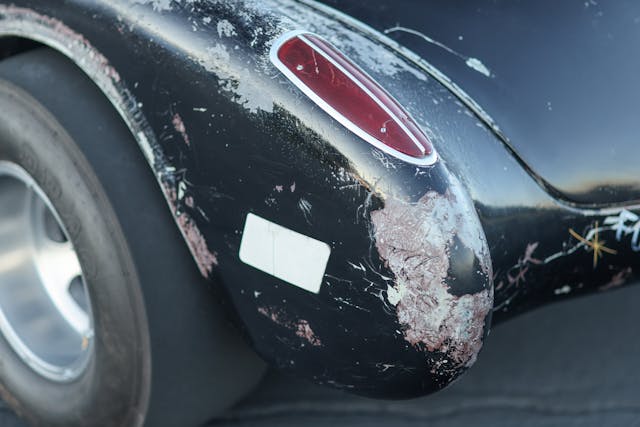

Carpenter purchased this 1956 Corvette in July 2017 from a buyer who picked it up from the previous owner’s estate. As best as Carpenter can tell, the car was based in the San Francisco Bay area and raced in its solid-axle configuration into the mid-1980s, at which point the car was driven off the end of a dragstrip. “That doesn’t surprise me. . . It didn’t have any front brakes.” Carpenter explained. According to the seller, the car hit a hay bale, although Carpenter attests that whatever it hit was far more stout than that, considering the damage to the body and the chassis.
The story goes that the damaged car was dragged back home, the engine and trans were removed, and it was parked next to a chicken coop. That part of the story tracks, as Carpenter noted that there was a definite lack of spider or spider webs when poking about the car’s interior and undercarriage during its rebuild. Score one for organic pest control.


When he bought it, the car featured hand-painted lettering on the side that read “Profile in Black” with the owners “Owen and Hankins” also mentioned. Carpenter did discover that there appears to have been a change in the partnership or perhaps a falling out as the Owens was mostly sanded off and the “and” was painted over. Despite spending years trying to track down the car’s history and posting on various vintage car and hot rod message boards, Carpenter hasn’t had any luck tracking down the family of the previous owners.
In the meantime, Carpenter decided to make it his car and got rid of most of the lettering, although he did leave plenty of the car’s patina. The track accident left the passenger side front fender hanging on by a thread, or rather several fiberglass threads. He repaired the damage as delicately as possible, keeping the “STP” sticker intact. “It was more work than if you’d done it the normal way, but it hides the damage well,” Carpenter said. Despite cleaning up the body and repairing the frame damage, plenty of the car’s original character is intact, from the cracked paint to the original lettering on the back. It’s tough to make out, but the hand-lettering reads “Function at the Junction” which Carpenter believes may reference a West Coast dragstrip.

With no engine or trans in the car, Carpenter chose a combination that he thought was appropriate. He found a used 327 with a worn-out block and salvaged its rotating assembly and fuelie heads. He also scored a seasoned 327 block and brought it to a machine shop, giving the machinist instructions to bore it to match his vintage .040-over pistons, but not to hot tank it, as he planned to run the engine without painting it to keep it looking vintage.
“I tried to keep this car as period correct as I could” — Larry Carpenter
The engine was outfitted with late-‘60s-appropriate speed parts, including the Edelbrock TR-1 “shoebox” tunnel ram and matching 660CFM Holley center-squirter carbs. Since the car still had a Joe Hunt decal, it seemed fitting to equip the 327 with a Joe Hunt magneto. Carpenter also found an appropriate exhaust, a used pair of Hooker fender-well headers meant for an early Nova. They were an almost perfect fit, and just as important, they look the part.

Because the car’s real racing days were over, Carpenter worked on making the car more streetable without losing its racy edge. “I had to rebuild the front end, the frame, and suspension. It was antiquated and sketchy. I don’t know how that guy dared to drive down the track,” said Carpenter. The straight axle, still of unknown origin, was rebuilt and it also got some much-needed front brakes, as Sandie’s 1960 Corvette donated its stock drums when it was upgraded to discs. The 327 is linked to an M-21 four-speed by way of an Ansen NHRA blowproof bellhousing with a Hurst shifter. It sends power to a Pontiac/Olds 9.3-inch rear axle fitted with a spool and 5.38:1 gears. Like we said, it still has plenty of race car manners.

Carpenter has done quite a job in making this car look as a survivor race car should, despite having to make plenty of repairs. As much as we love its current look, both Carpenter and all of us here at Hagerty Media would love to see how it presented in its heyday. If you remember seeing this car on the dragstrip when it was a quarter-mile contender, please share your story and we’ll help you get in touch with Carpenter so that he can be a caretaker of not only the current car, but also its racing legacy.







***
Check out the Hagerty Media homepage so you don’t miss a single story, or better yet, bookmark it. To get our best stories delivered right to your inbox, subscribe to our newsletters.
The post Mystery History: Do you recognize this vintage Corvette racer? appeared first on Hagerty Media.
]]>
The Rolex Motorsports Reunion, held each year during Monterey Car Week, always brings out rare and beautiful race cars and presents them on one of motorsports most recognizable tracks, Laguna Seca. For 2023, the event highlighted Corvette’s momentous impact on the racing world by displaying more than 20 historic Corvette racers and development cars. A few of them even fired up and took to the tarmac to give spectators a taste of racing days gone by.

Corvette has a long and illustrious racing pedigree that stretches back to the 1950s, shortly after the beautiful two-seater debuted. While America’s Sports Car got off to an inauspicious start due to its ho-hum Blue Flame Six powerplant, the legendary Chevy small-block V-8 debuted in 1955 and more than made up for it. The earliest Corvette featured at the display was a 1956 Corvette SR1, one of just two remaining of the six built. These SR1 cars were fitted with heavy-duty drum brakes, Halibrand magnesium wheels, and the famed “Duntov” cam to really transform the V-8.




Shown in the lead image at the top of the page all displayed together, four development cars were on hand that foreshadowed the C8 Corvette‘s transition to a mid-engine layout and all four of them hit the track for parade laps. The open-wheel 1960 CERV I looks like a contemporary Indy car, while the 1964 CERV II covered its wheels yet kept the sporting aspirations with its speedster roofline. Both the 1973 Aerovette and the 1990 CERV III, on the other hand, look like concept cars that could have headed to production.

Thanks to Corvette engineer and hot rod guru Zora Arkus-Duntov, the small-block would be the spearhead of Chevrolet racing for years, although we can’t ignore the Chevy big-block. Several important Corvette racers were on display that made a case for large displacement engines. Tom McIntyre brought out his 1963 Corvette Z06, formerly owned by the legendary Mickey Thompson. This was one of two Corvettes prepped for Daytona Speed Week 1963 to be fitted with the Mark II 427 engine known as the “Mystery Motor” as it was shrouded in secrecy. The engine, likely still warm from the foundry, was essentially a rough draft of what would become the Mark IV big-block that we all know as the 396, 427, and 454 V-8s of the muscle car era. While its original engine was gone when he purchased the car, McIntyre was able to buy a Mystery Motor from Smokey Yunick’s estate and get the car back under 427 power.


This curvy, big-block-powered 1968 Corvette was prepped to race at the 1973 24 Hours of Le Mans and found a spot on the grid as part of Ferrari’s North American Racing Team (NART). It placed a respectable 7th in class and 15th overall, but went on to win its class at Sebring later that year.


We can’t mention curvy big-block ‘Vettes without showing off these two C3s and their outrageously flared fiberglass. It doesn’t get any more ’70s than these two. The red Greenwood Corvette is a race veteran and still has a surprising amount of its original equipment. The NACA-ducted IMSA Supervette, also from Greenwood, features a tube chassis to go along with its drastically restyled fiberglass body.




Both big- and small-block-powered C2s were on display, including the successful 1963 Grand Sport Chassis 004 and the Roger Penske Chevrolet 1966 L88 Corvette. The Grand Sport won its class in Nassau in 1963, while the L88 had back-to-back class wins at the 1966 Daytona 24 Hours and Sebring 12 Hours.

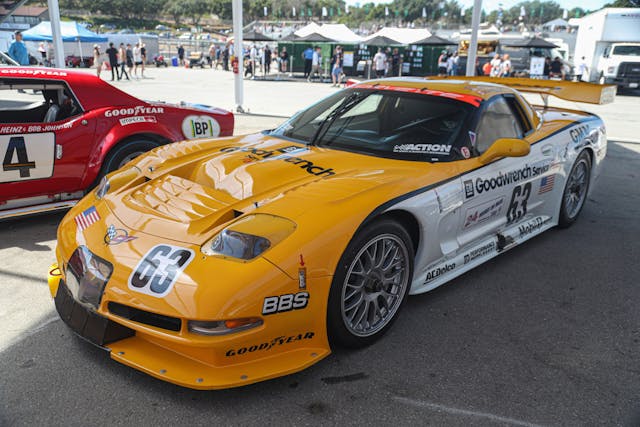

We can’t talk about endurance-race-winning Corvettes without mentioning the dominating late-model Corvette race cars like the C5R and C8.R. Three examples were on display, including a C8.R that looked like it came straight off the track.
The Corvette display at the Rolex Motorsports Reunion was the best gathering of Corvette racing history in one place that we can remember seeing. If you didn’t get a chance to see it in person, we recommend visiting the Petersen Automotive Museum where some of these cars were headed after Monterey.

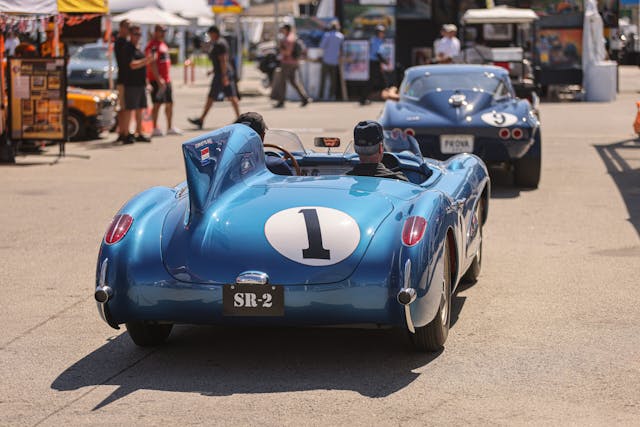


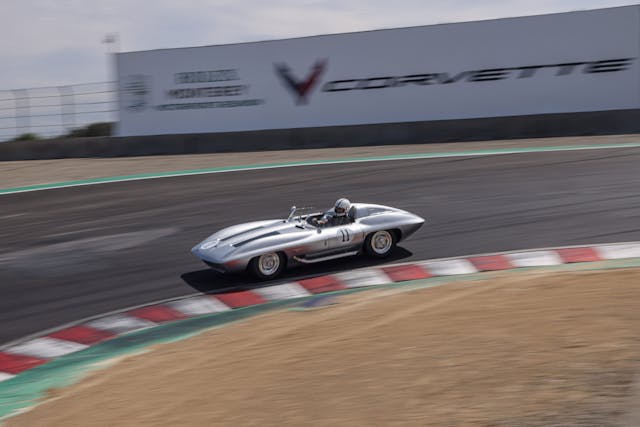



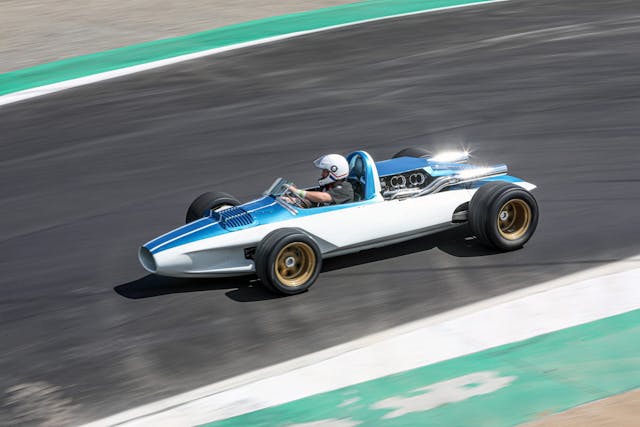









The post Rolex Motorsports Reunion celebrates Corvette’s 70th anniversary with host of legendary cars appeared first on Hagerty Media.
]]>
The automotive aftermarket has a way of enabling enterprising enthusiasts to create the versions of our cars that we often wish we could have purchased direct from the factory. Occasionally these support brands build something they hope the OEM will sell. Sometimes, their hopes are realized: Think of the historic relationship between Shelby and Ford, which allows supercharged GT500 Mustangs to sit on the same dealer lots as Escapes and F-150s. The yellow Corvette starring in Jay Leno’s Garage this week was one such hopeful, but you probably haven’t heard about it.
It almost takes a second to see the changes made by Tecstar to the silhouette of this 2002 Z06, clothed in the bright Tiger Yellow paint. No grabby graphics or badges here—the company was going for a subtle yet still polarizing look. The combination of aftermarket wheels and a body kit is understated, and that was exactly what Tecstar wanted: It hoped that Chevrolet would sell the hot-rodded Corvette through its dealer base. The automaker had teased the idea of a tuned Z06 in 2001, at SEMA, with the 742-hp Tiger Shark concept, following it up with 2002’s slightly tamer, 516-hp White Shark concept.
(The latter inspired the Tecstar body kit worn by Leno’s car. Confusingly, Tecstar then named the kit the Tiger Shark, not White Shark. Go figure.)
Why not give the people what they wanted: a visually distinct, hotter version of the Z06? Tecstar got to work to show Chevrolet it could build exactly that.
The Tiger Shark kit was designed for the Z06, which appeared for the 2001 model year and set the bar pretty high for both aesthetics and performance. (We included it on our 2023 Bull Market List for good reason.) Tecstar’s aesthetic improvements started out front with a completely new front bumper and hood, along with a new rear bumper as well. Though the horizontal contours are similar, the Tiger Shark front fascia is significantly different than the one made by Chevrolet.
Leno admits this is about the third front splitter he has put on his Z06 due to how low it hangs and its propensity to catch on obstacles. The low, rigid air dam of the Tiger Shark front end likely explains why Tecstar didn’t lower the Corvette’s suspension, even though the large wheel gaps look a little out of place on such a slick car.
The changes made by Tecstar under the Z06’s hood are less likely to spark controversy. The factory-installed V8 got a replacement crankshaft that bumps the stroke up and gives displacement a nice hike, from 376 to 402 cubic inches—again, matching the 2002 White Shark show car. With the addition of a nice exhaust and some other tuning, Tecstar’s Z06 had 525 horsepower—up from 385. Jay’s Corvette was modified even further before the comedian bought it: It is currently sporting an LS7 engine from the sixth-generation Z06. Jay has proven multiple times that he is not above an engine swap, even for an already hot car, so this is right up his alley.
Leno’s Tiger Shark provides an interesting look at what it takes to sell the Big Three on tuned versions of their own vehicles. Though the Tiger Shark kit never had the successful factory backing that Tecstar hoped for, a Michigan-based company did revive the kit in 2015. (Tecstar is long gone, acquired by Quantum Corporations in 2005.) You can buy your own today, unpainted, for $1960.
Unlike the designs of some tuners and aftermarket companies, which can quickly look dated, the Tiger Shark kit retains enough of the beautifully aging C5 shape to still look classy twenty years later. We think that’s pretty impressive.
***
Check out the Hagerty Media homepage so you don’t miss a single story, or better yet, bookmark it. To get our best stories delivered right to your inbox, subscribe to our newsletters.
The post Jay Leno drives the hotter C5 Z06 that could have been appeared first on Hagerty Media.
]]>
The Petersen Museum’s newest exhibit, Corvettes in Competition: Racing America’s Sports Car, contains examples of Corvette’s vast racing history over seven decades. From a 1953 model that was fitted with a V-8 to a C7.R, the exhibit—located in the Charles Nearburg Motorsports Gallery on the second floor—has examples of Corvette’s illustrious road racing history from every generation except for the C8. Which is understandable, as those C8s are still a long way from retirement.


Early C1 Corvettes, with their Blue Flame Six engines, weren’t really cut out to be sports cars compared to the V-8-powered models that debuted in 1955. Still Chevrolet put considerable effort into making the Corvette a worthy competitor. You can thank Zora Arkus-Duntov for that; it was he that pushed for Corvette and its Chevy small-block V-8 to be that hot-rodder’s go-to powerplant.

In the wake of the disaster at Le Mans in 1955, the Automobile Manufacturers Association called for a ban on manufacturer-backed racing efforts in 1957. Arkus-Duntov sprung into action, spearheading the Grand Sport program to get lightweight, high-performance Corvettes into the hands of racers. Chevrolet put the brakes on the program after just five examples were built, and this one, chassis 004, was the most successful in competition. It placed third overall at Nassau during Bahamas Speed Week 1963, piloted by Dick Thompson.
The Corvette didn’t have an official factory racing team for ages, though Corvettes nevertheless found their way onto tracks across America and around the world.
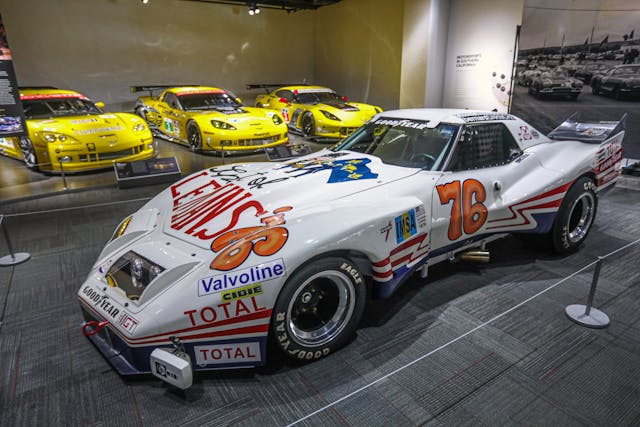


Perhaps spurred by the Callaway LM, which proved to be very competitive in its class at the 24 Hours of Le Mans as a privateer, Chevrolet eventually got back into endurance racing on the world stage. The 1995 Callaway LM pictured above won the GT2 pole and finished 3rd in class before going on to win the 1996 SSCA Pro World Challenge Series.




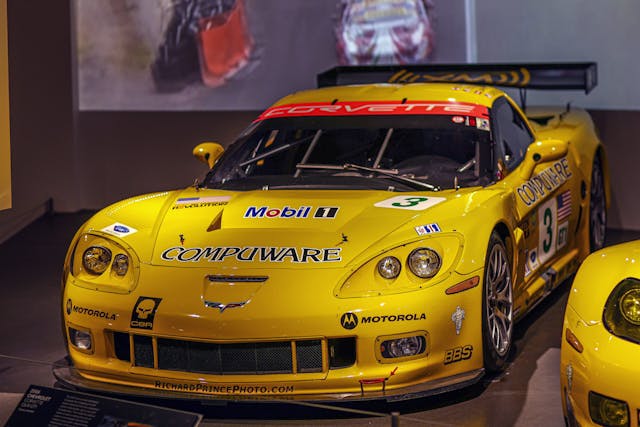

Corvette Racing has won its class at Le Mans nine times since its founding in 1999, and the team also took home four wins at Daytona. A C5-R, two classes of C6.R, and a C7.R make for an impressive display of the era.
If you’d like to see these thoroughbred machines in person, visit Petersen.org for tickets.
The post New Petersen Museum exhibit highlights Corvette’s racing pedigree appeared first on Hagerty Media.
]]>
Chevrolet built just 4640 Corvettes between 1953 and 1955, which makes each survivor of this initial “C1” design a special car in its own right. But perhaps none is quite as special as the 1954 Corvette prototype that will go under the hammer at Gooding & Company’s Pebble Beach auction on August 18 and 19. Because the mere fact this ‘Vette still exists at all is exceptional.


This car’s story goes back all the way to the very beginning of the Corvette program, prior to ’53, when GM built a batch of around 15 pre-production prototypes for experimental and display use. Largely hand-built, these vehicles were issued only a four-digit S.O. (“Shop Order”) code for internal use rather than a regular production-code number, as would have been used for a salable car.
Known initially as S.O. 2000, this particular Corvette prototype began life as a pale yellow hardtop model. It didn’t stay that way for long, though. Dismantled in early 1954, its body returned to GM’s design department where it received a new “S.O. 2151” code as well as a new chassis.

Most important in this context, the car got a fresh look. Under the watch of GM’s legendary design chief Harley Earl, this Corvette was transformed into a so-called “Proposal Car,” a prototype built for GM management to evaluate the styling changes intended for the Corvette’s 1955 model year. Given that the scope of this project was a simple facelift, likely meant to rekindle interest in the Corvette amid flagging sales, the car’s fundamental design and proportions didn’t change. Nevertheless, it’s an intriguing glimpse into Earl’s ideas for the Corvette’s evolution, highlighting a somewhat different design direction from the one he eventually chose for the model’s subsequent 1956 revamp.



In automobile design, the period between the end of World War II and 1960 was characterized by an intense creative exchange between the two sides of the Atlantic. On the one hand, to people in war-ravaged Europe, the triumphant U.S.A. represented a beacon of progress, the promise of a brighter future. In car design terms, this translated into European automakers’ wide adoption of design elements like wraparound glass and tailfins.
On the other hand, Detroit’s stylists sought inspiration from the Old World’s design heritage to lend a certain prestige and sophistication to their mass-market offerings. This Corvette prototype serves as an excellent case in point.


Design cues like the aggressive egg-crate grille, non-functional hood scoop, and slanted air outlets on the front fenders were all lifted straight from period Ferraris. Chevrolet’s curvaceous little roadster originated from Harley Earl’s desire to create an all-American answer to the growing success of European sports cars, so the look of this proposed facelift seems to further build on that original idea.


Interestingly, the decorative chrome trim pieces adorning the fender’s air outlets are only present on the left side of the car. The same goes with the Corvette script, which is also placed differently from left to right. A convenient way to evaluate different options using a single model, such asymmetrical prototypes are still a staple of every automaker’s design process.

The most notable styling change at the rear of S.O. 2151 is the trunk lid, whose shape is redolent of the ’54 Motorama’s fastback Corvair show car. The exhaust tips integrated into the rear bumperette’s design are another noteworthy feature, if only because they are the sole design element from this Corvette that made it onto the redesigned 1956 model.
General Motors ultimately decided not to change the Corvette’s appearance for the 1955 model year. With just 700 cars produced that year, the Corvette program was hanging by a thread and was ultimately, albeit indirectly, saved by the Ford Motor Company. As the Thunderbird outsold the Corvette more than 20 times over in ’55, GM reimagined the Corvette for 1956 with better weather protection, roll-up windows, and an overall glitzier appearance.

For GM or any other automaker, cars like S.O. 2151 are development tools. It may seem cold and shortsighted through a retrospective lens, but once such prototypes serve their purpose, their life expectancy can usually be measured in weeks. So, although we may never know exactly how this unique Corvette managed to escape destruction, let alone slip into private hands, it’s important to recognize its survival as an exceptional occurrence.
Following a painstaking restoration that took three years and brought this forgotten piece of Corvette history back to its appearance during its (fleeting) glory days of mid-1954, S.O. 2151 made its public debut at The Amelia in March this year.

Given the car’s unique status and significance, it comes as no surprise that Gooding & Company estimates it could fetch between $1.5M and $2M on the auction block, which means it could become the most expensive “C1” Corvette ever sold. That honor currently belongs to a 1962 Corvette “Gulf Oil” race car, which sold for $1.65M in 2015 at an RM Sotheby’s auction.
Although few people can afford to bid for the privilege of being this Corvette’s next custodian, those who saved, lovingly restored, and documented it all made a priceless contribution to the preservation of automobile history. That makes us all a little bit richer, no?






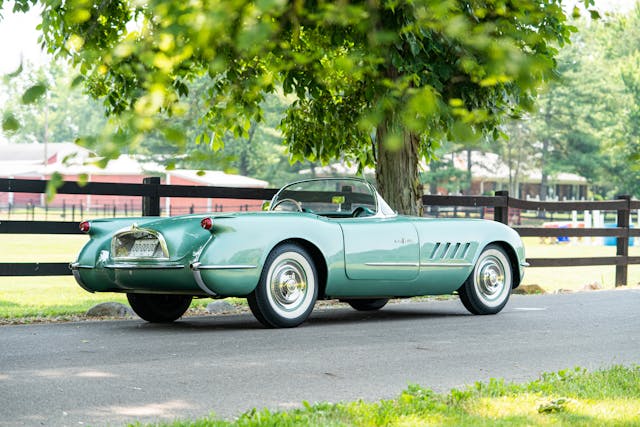












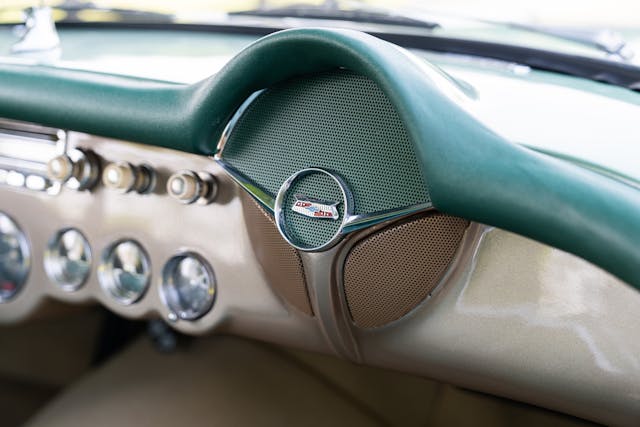
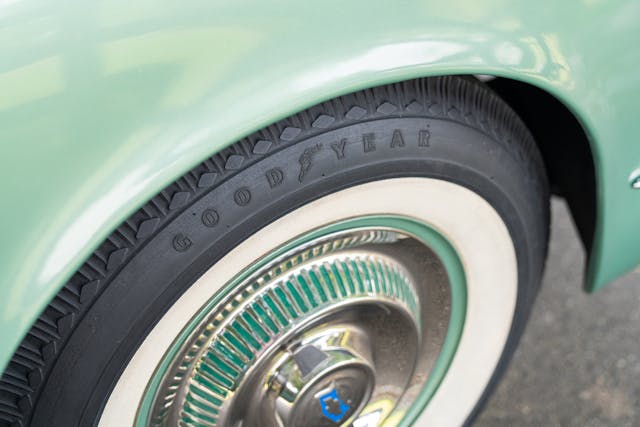


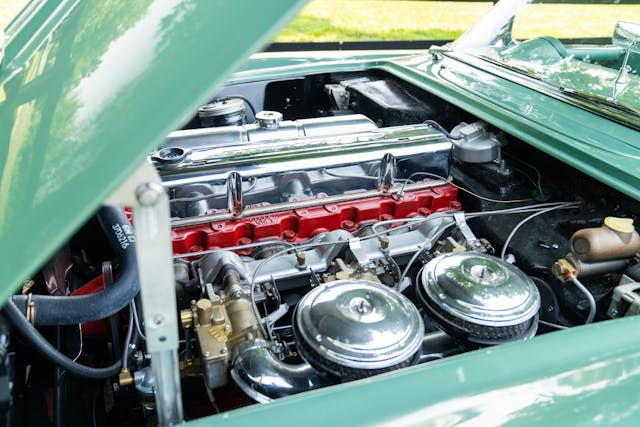

**
Matteo Licata received his degree in Transportation Design from Turin’s IED (Istituto Europeo di Design) in 2006. He worked as an automobile designer for about a decade, including a stint in the then-Fiat Group’s Turin design studio, during which his proposal for the interior of the 2010–20 Alfa Romeo Giulietta was selected for production. He next joined Changan’s European design studio in Turin and then EDAG in Barcelona, Spain. Licata currently teaches automobile design history to the Transportation Design bachelor students of IAAD (Istituto di Arte Applicata e Design) in Turin.
***
The post 1954 Corvette Prototype: A Euro-flair design that never was appeared first on Hagerty Media.
]]>
Chevrolet’s recent news laying out a roadmap for the new Corvette Racing by Pratt Miller Motorsports partnership has both the Corvette and racing communities buzzing. The Corvette Z06 GT3.R customer car program will be a first for the company, going well beyond various race-prep packages the Corvette offered in decades past.
A look back at the factory-backed Corvette Racing’s 25 years of competition shows 125 track victories, including nine class wins at the 24 Hours of Le Mans. The most recent was this past June with the C8.R. That’s a stellar record that should make all Corvette owners and enthusiasts proud.

Missing from Chevy’s exciting racing news, however, was any acknowledgment that the Corvette, now in its 70th year of production, has been racing since nearly the beginning, and often with no factory support. For example, did you know that a 1954 Corvette raced in that year’s LaCarrera Panamerica? The car, campaigned by Bill Von Esser and Ernest Pultz, competed in the infamously dangerous, nearly 2,000-mile road race through Mexico with its Blue Flame six and Powerglide two-speed automatic transmission. This intrepid Vette racer did not finish the grueling contest, but then, just 85 of 150 cars entered did.
In that case, and uncounted thousands of others spanning decades, Corvette racers operated out of their own pockets, sometimes with notable sponsors but often without.
That part of motorsports history is not commemorated much outside of the Corvette community.
Corvette enthusiast, historian, and former vintage racer Jan Hyde is doing something about that. He owns and manages the Registry of Corvette Racecars, a vast online archive he describes as “Corvette racers on tour.” Its mission is to catalog the Corvette racecars and drivers that established the Chevy sports car as a motorsports icon, in road racing and drag racing.

Built on the same software used by museums to catalog and cross-reference their inventories, the Registry has so far cataloged 1600 Corvettes and counting, with historical information and about 20,000 images. The site is a breeze to use, and it presents a very deep and well-organized rabbit hole for Corvette and classic racing enthusiasts to explore.
Registry users can search by numerous categories, including: Corvette generation (C1-C8); model year; specific cars; drivers; races and race series; racecar numbers; vehicle descriptions; associated people, and more.

You can even search by a photographer’s name, and some of the people in the photos are searchable, as well. For example, entering “Zora Arkus-Duntov” or “Don Yenko” as search terms brings up all records in which they are referenced throughout the database. Or, click on drivers’ names to bring up other cars they raced. It’s a great tool for tracing individual car history and ownership.
Access to the Registry is available by membership, with $30, $50, and $100 levels charged annually. Having “road tested” the site, we’ll say this research tool can be addictive, pulling you into parts of Corvette racing history that might be unfamiliar.
Corvette heroes, famous and not
Hyde wanted the Registry to also spotlight the Corvette racecar drivers, from the grassroots to pro, including road racing and drag racing.
“We catalog the stories about a self-reliant bunch that confronted GM’s denial of racing involvement by expending their own blood, sweat, and tears to race Corvettes over a very long time,” Hyde tells Hagerty.com. “They had to beg, borrow, and steal parts and often made (and sold) their own.”



The “self-reliant bunch” as Hyde calls them includes names that diehard Corvette enthusiasts may recognize: Delmo Johnson, Grady Davis, Don Yenko, Jim Jeffords, Tony DeLorenzo, Deloy Naeb, John Greenwood, Rick Mancuso, Doug Bergen, Rich Sloma, Rick Dittman, Milton “Babe” Headly, Dick Moroso, Gregg Pickett, Dan Fuery, Alan Sevadjian, Doug Rippie, Lou Gigliotti, Kim Baker, Bob Ruman, Kerry Hitt, Sonny Whelen, and many more.
They raced in in FIA, Trans Am, IMSA, ALMS, Grand-Am, SCCA, NHRA, Corvette Challenge, World Challenge and other series. Entering any race series or sanctioning body in the search fields will bring up cars across the eight Corvette generations.
History in motion

In our review of this sprawling database, we headed right for the C2 tab and immediately zeroed in on the second car listed, Mickey Thompson’s 1963 Z06 Corvette. It was one of two built to race in the NASCAR American Challenge Cup, a sports car race that competed on the Daytona oval. This pair of Corvettes debuted the Mk. II S 427 cubic-inch “Mystery Motor” a week before the engine raced in an Impala in the Daytona 500 NASCAR race.
On the same page, you’ll find the Dana Chevrolet-sponsored 1967 L88 Corvette that raced at Le Mans, as well as 1963 Grand Sport #1 and Grand Sport #2. Delving deeper into the C2 section brings up more rarities as well as several hundred SCCA and vintage racers.
Digging into the other Corvette generation sections yields similar intriguing finds.
Corvette Challenge

The Registry of Corvette racecars includes the privately organized 1988-1989 Corvette Challenge one-marque series privately formed after the SCCA booted the C4 Vette from its Showroom Stock series–for winning too much! In case you might remember this as a Chevrolet-run series, it was not.
“The Corvette Challenge organized by John Powell was paid for by dealerships,” Hyde says. “It was the same for the C4 GTP managed by Rick Hendrick in the name of research and development and sponsored by Goodwrench.”
Chevy only built the specially equipped Corvette Challenge cars when a dealer, Malcolm Konner Chevrolet in Paramus, New Jersey, placed an order for the first batch of 50, selling them to racers through other Chevy dealers. The Registry includes many of the cars used, with driver information.
Diehard Corvette racing fan

Hyde’s infatuation with Corvettes and Corvette racing began as a teenager growing up in Pittsburgh. He credits that spark to the corporate-sponsored private Corvette racing team started by Grady Davis, a top executive with Gulf Research and Development Company. Chevy dealer Don Yenko and Dr. Dick Thompson were the drivers. (Thompson was known as “The Flying Dentist”). All three men are members of the Corvette Hall of Fame.
Retired from a 40-year career in investment banking and real estate, Hyde still owns and drives the 1960 Corvette fuelie he bought in 1964 while living in San Francisco. That summer, he drove cross-country to start Harvard Business School and used the car as daily transportation, even after settling in Brooklyn, New York, where he still lives.
In Brooklyn, Hyde met Corvette racer Frank Dominianni, whose shop was in nearby Valley Stream. He bought one of Dominianni’s racing engines, and it’s still under his Corvette’s hood. Later, Hyde bought one of his retired Corvette racecars and campaigned it in vintage racing for 15 years.
Creating the Registry

The idea of starting the Registry hatched some years ago with Hyde’s friend and colleague, Jim Gessner, who is well known in the Corvette world. Gessner has been locating, buying, collecting, and selling Corvettes since 1969 and does so today through his website, vettefinderjim.com.
“Jim began collecting information on C1 and C2 Corvette racecars and putting it into spreadsheets,” says Hyde. “We got them printed, and they were huge! We had to lay them out on the floor to read. I suggested doing a website.”
Hyde and Gessner initially worked with Corvette author Wayne Ellwood, with Hyde investing in the legal work to incorporate the new venture. “I ended up taking over ownership,” he says. When the database software he was using became obsolete a few years ago, Hyde transferred the information into a museum software package called PastPerfect, a three-month process.
Preserving history, even when it’s been erased

Hyde makes all updates himself, incorporating information from “a lot of contributors.” He explains that in collecting and reviewing the material, he and his team can solve some mysteries about Corvette racecars and correct the record when necessary.
“I personally know the histories of many cars, and I can tell the authentic cars,” Hyde says.
A key benefit of the site, he points out, is that enthusiasts and collectors can see how a car looked when it raced and how it evolved as it moved from owner to owner and series to series over the years. It also shows that, for some cars, race history gets erased when collectors restore a Corvette racecar to original factory condition, rather than preserve it as it raced.


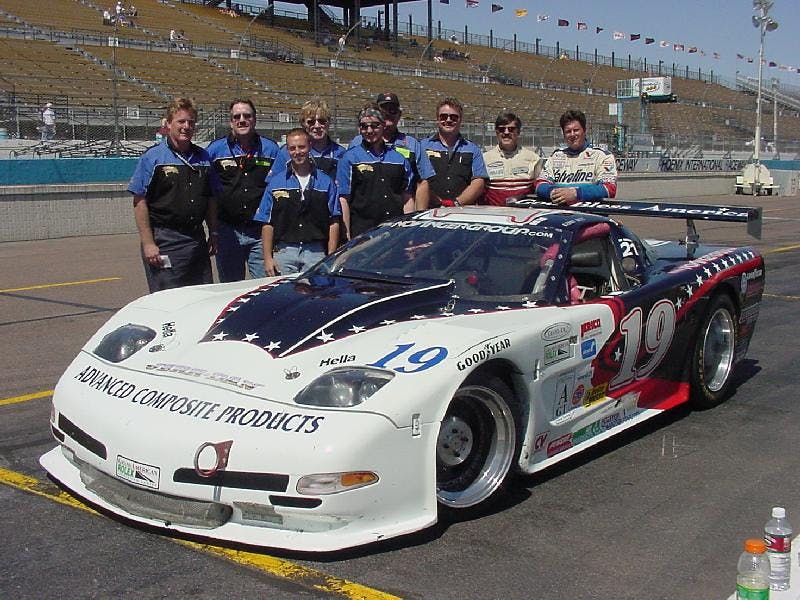
Hyde emphasizes the “live” nature of the Registry. “It’s a project that never ends. It will never be 100 percent correct, but we’re aiming to not be 100 percent wrong.”
Now 82, Hyde is considering options to ensure that the Registry of Corvette Racecars will outlive him. “My goal is for this tool to be preserved by others to keep it going. It takes time and money,” he says. This inveterate Corvette enthusiast is open to ideas.
***
Check out the Hagerty Media homepage so you don’t miss a single story, or better yet, bookmark it. To get our best stories delivered right to your inbox, subscribe to our newsletters.
The post Registry of Corvette Racecars chronicles 70 years of history, one car at a time appeared first on Hagerty Media.
]]>
Chevrolet has taken its pricing configurator live at Chevrolet.com for the three 2024 Corvette models.
Well, most of it.
The E-Ray starts at $104,495 for the coupe and $111,495 for the convertible, and you can price out a specific model. The Z06 starts at $108,100, and “as shown, $128,650,” but when you try to price the Z06 coupe and convertible out, you get, “See dealer for pricing,” perhaps suggesting Chevrolet knows that there’s still going to be a healthy markup added to the list price due to supply and demand.
For 2023, the Z06 coupe started at $106,695, and the convertible at $114,195. You can still price out the 2023 models, just not the 2024 cars.

By comparison, the base 2024 Stingray coupe starts at a relatively bargain price of $66,300 (just $405 more than 2023) or $67,895 with shipping. The convertible starts at $74,895 with shipping. The Manufacturer’s Suggested Retail Price does not include “tax, title, license, Dealer Fees and optional equipment.” We capitalized Dealer Fees for effect.
Clicking almost all the options for the Stingray coupe, including the $6345 Z51 performance package, took us to $99,650, but you can have a very nice Stingray for far less. The configurator automatically adds in the $1595 destination charge.
Adding up the $74,895 convertible the way we’d configure it—the Z51 package and mostly standard equipment for the rest—took the price to a more sensible $88,235.

As for the E-Ray, we went middle of the road with the coupe, adding a handful of accessories including the ZER performance package (just $500), and ended up at $131,385. As for the convertible, we again added a modest amount of features, including the cheapest package, the 1LZ, which took the price to $111,495. We then selected the killer Amplify Orange Tintcoat for $995, the carbon fiber wheels (a whopping $13,500), a base interior, and that ZER package, which took the price to $125,900.
As mentioned, you’ll have to see your dealer to completely price out the Z06. We wish you and your pocketbook the best of luck.
***
Check out the Hagerty Media homepage so you don’t miss a single story, or better yet, bookmark it. To get our best stories delivered right to your inbox, subscribe to our newsletters.
The post Finally, build your dream 2024 E-Ray on Corvette’s website appeared first on Hagerty Media.
]]>
Metallic exhaust roar echoed through the hillside as I wound along Ohio’s Kokosing River. Overhead cams whirred and the engine swept through its sweet spot between 4500 and 6500 rpm. Shifting at redline, I was rewarded by another eager rush in the meat of the powerband. It’s hard to believe this is a big American V-8. Now, as in 1990, the Chevrolet Corvette ZR-1 is a revelation.
So revelatory, in fact, that it shocked General Motors’ own engine division into a frenzy of activity. GM engineers were so taken aback at the decision from on high to hire Lotus to design the ZR-1’s high-performance LT5 engine—and Mercury Marine for its construction—that they quickly got to work on new small-block V-8 designs. The result was in the car behind us, a 2004 Corvette Z06.
These two bygone bosses of Bowling Green obviously have a lot in common—flip-up headlamps, about 400 horses under their hoods, and capable handling. Here’s something else: Both can be had today in excellent condition for around $45,000, according to the latest Hagerty Price Guide. That’s quite a steal considering the recent run-up for other performance cars of the era (a roughly contemporary Toyota Supra Turbo, for instance, will easily run you six figures).
Of course, we couldn’t help but wonder which Vette is better. Father and son Hagerty members Rick and Rocky Yusi own pristine, low-mile examples of each and graciously shared them to help us understand what sets these cars apart. Together, we disappeared into the hills of southeast Ohio to find answers.
C4 ZR-1

Engaging with a C4 Corvette is an exercise in immersion. Or maybe it’s contortion. Slide over the famously large sill and slither down into the deeply bolstered bucket seat, and you’re completely enveloped by a high transmission tunnel and driver-oriented dash. You’re now of this Corvette, not merely in it.
Nowadays this cockpit—complete with orange-over-charcoal analog gauges, digital display, and acres of small buttons—screams RADwood. But in period, the futuristic design ethic was intended to break completely with prior generations of America’s sports car. “The C4 was a modern statement: It didn’t look back at heritage,” retired GM designer John Cafaro told me in a phone interview.



Brash as it is, there’s not much to the cabin or the design as a whole that tips off the casual observer that this version of the Corvette is a supercar slayer. “I love the way it looks and all the subtle ways it’s different from the base car, but I do wish Chevy made it stand out a bit more,” admitted Rick, who bought this ZR-1 new in 1990. The tachometer’s 7000-rpm redline is the only hint at the marvel that is under the clamshell hood.


The standard Corvette in 1990 had a pushrod, iron-block 5.7-liter L98 V-8 that produced 245 horsepower at 4000 rpm. The ZR-1’s engine, known as the LT5, carried over only the displacement and bore spacing. Its block and cylinder heads were aluminum. Dual overhead cams actuated 32 valves (versus 16 in the standard car). It made 375 horsepower at 5800 rpm—around the fuel cutoff for the standard car.
I fired up the LT5 and left the college-town charm of Wooster via a sweeping state route dotted with Amish farms. The bucket seat cosseted me with a vast array of power and pneumatic adjustments. Meanwhile, the three-way adjustable Selective Ride Control dampers—a feature that debuted on the ZR-1 and paved the way for similar tech in later models—impressively blunted road imperfections when set to Touring, the softest mode.

Along with that comfort, though, comes some softness in the controls. This is a car from a different era, after all. Initial application of the brake pedal is 1990s-GM squishy, although it firms up with increased pressure. The weighty, mechanical shifter atop the ZF six-speed box has a rubbery give as you reach each detent.
The asphalt roller coaster bends began south of Millersburg, where the scenery evolved from undulating corn and soy fields to rocky, rolling hills. I stiffened the ZR-1’s damper settings to Sport and then to Performance. Even in modern cars, selectable drive modes can be more gimmick than substance, but not here. The dampers deftly responded to imperfections and helped the car stay utterly poised as I pitched from left to right.

The harder you drive the ZR-1, though, the more it reveals the one dynamic trait that belies its age: the chassis itself. At anything more than about 6/10ths pace, the frame flexes through camber changes. The car never gets upset, but when pushed, the compliant chassis’ additional motion distracts from the experience. Turning the ride control setting from Performance down to Sport softens the dampers, enabling smoother, less wobbly transitions, yet I found myself wondering how much more dynamic the ZR-1 would feel had its structure been further stiffened to let that superb suspension more effectively do its job.
Despite that, I emerged from the twisty river-bottom roads with some newfound respect for the ZR-1. Remember: Less than a decade prior to this car’s debut, the Corvette was a still 190-hp weakling. This car made clear that Chevrolet wanted to build a world-class sports car, and the seriousness of that intention still shines through when you’re driving it today.

C5 Z06

On to the Z06. The design is clearly less of a departure from what had come before than the C4. The General Motors that developed the C5 in the 1990s was more cautious—and had a considerably smaller pocketbook—than the one that had spawned the C4 in the early ’80s. Cafaro, who was chief designer for the C5, noted that special care had to be taken to appease various departments, including what he affectionately calls “the toothpaste and detergent folks” in marketing. “One little controversy could’ve killed the car,” he said. By 2004, the C5’s last year, Chevy had relaxed enough to allow a carbon-fiber hood and stripe package for the Commemorative Edition, as on the Yusis’ car. Today it’s worth slightly more than other C5 Z06s.
Styling aside, the generational difference from the ZR-1 immediately presented itself upon opening the door: Those massive side sills are gone. You can simply get into the car without first having to practice yoga.

Those sills shrank because the C5’s chassis, four times stiffer, incorporated hydro-formed frame rails and a strengthened center tunnel. The concerted effort to increase rigidity went hand in hand with making the C5 accessible to a wider array of people. A longer wheelbase increased cabin space, as did repositioning the gas tanks to behind the seats.
Most of that practicality carried over to the high-performance Z06, which debuted in 2001. The Z06’s flat, wide seats surely did better in focus groups than the ZR-1’s, since they’re able to take in a broad swath of humanity, although they don’t hold you nearly as well in aggressive maneuvers. (Sport buckets, available in the base coupe and convertible, didn’t make it into the Z06 due to their extra weight.) Those same focus groups also nixed the pseudo-digital gauges, so you stare at more traditional analog gauges. As a result of the efforts to make the C5 more approachable, the Z06 feels more utilitarian and less of an occasion than the ZR-1.

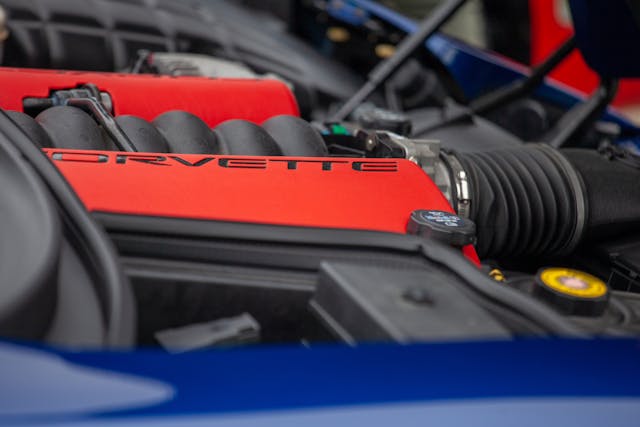
At least, until you fire up the 405-horse, 5.7-liter V-8. The standard, lightweight titanium exhaust emitted a docile burble that turned raw and throaty when I rolled onto the throttle. The LS6, as this engine is known, is on its face less exotic than the ZR-1’s LT5: It’s a pushrod engine and makes only 55 horsepower more than the contemporary base Corvette. Yet that only speaks to how profoundly the tried-and-true small-block had changed in the intervening years. The LS-series V-8, which debuted with the C5 for 1997 and eventually proliferated to millions of trucks and SUVs (not to mention hot rods and restomods of all stripes), was the most significant update to GM’s bread-and-butter V-8 since it debuted in the 1950s. An aluminum block was baked in from the start, as were high-compression aluminum cylinder heads.
The LS6 was the first true rock star of this engine family, with even higher (10.5:1) compression, better-breathing intake manifold and cylinder heads, and myriad tweaks to the internals. The result is an engine that pulls linearly—and hard—from about 2000 rpm and barely lets up by its 6500-rpm red-line. You can rev it out or stick the gearbox in third or fourth and count on low-end torque to muscle through a corner.

The Z06’s controls would be at home in a current sports car. Moderately heavy steering offers feedback but isn’t particularly lively—for better and for worse, it’s similar to many modern racks. The shifter’s throws are long but crisper than in the ZR-1. The brakes inspire confidence with a firm and linear pedal. And, thanks to the relocation of the transmission to the rear of the car, the Z06’s footbox allows plenty of room for fancy pedal work.

Returning to the route along the Kokosing, I discover how progressive and predictable the Z06 is, especially for something with this much brawn. The nonadjustable suspension allows for plenty of body roll in assertive driving, but it’s always well composed. You quickly get used to this trait, and it becomes part of how you set the car through a corner. The chassis does exhibit some flex, but it’s dramatically less than the ZR-1’s. Overall, the 3100-pound Z06 feels big but never unwieldy, even on tight, technical roads.
As the day ended, I slotted the Z06’s shifter into sixth gear and settled into a cruise. The car quietly soaked up the miles and nosed close to 30 mpg at the speed limit. It was almost funny; in contrast to the ZR-1, the only thing I needed to adjust to bring out the Z06’s differing personalities was what gear I was in.

***

What we have here, despite the apparent similarities and comparable values, are two very different slices of apple pie. The ZR-1 is more complex and full of character. It is also, from a design and historical standpoint, more significant—we’re talking about the first Corvette in decades that truly went toe-to-toe with the best in the world. Perhaps for those reasons, trailer-queen ZR-1s tend to fetch considerably more than similarly pampered Z06s.
If you’re looking to drive a lot, it’s hard to argue with a Z06. Say what you will about GM’s obsession at the time with metrics and ergonomics; it yielded a sports car you can still easily use every day to fetch groceries—and then embarrass younger and more expensive cars at a weekend track day. It’s truly a Goldilocks car. That versatility and usability help explain why it’s generally appreciating faster than the ZR-1—and why we put it on our most recent Bull Market List.
Ultimately, both exude “Corvette” and offer heaps of performance and personality. I end the day still wondering which $45K classic I would choose, but more so, I’m grateful to have experienced them both.
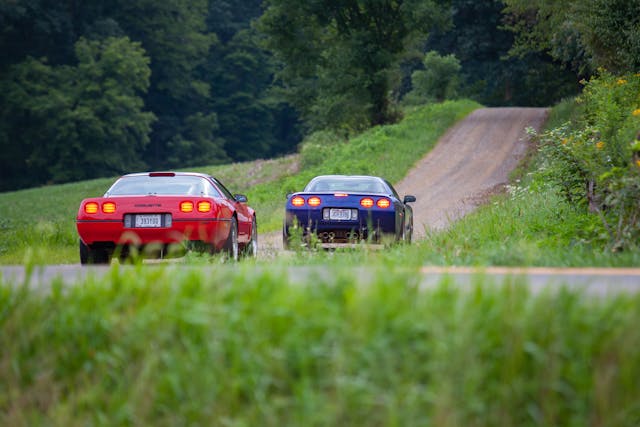




***
This article first appeared in Hagerty Drivers Club magazine. Click here to subscribe and join the club.
Check out the Hagerty Media homepage so you don’t miss a single story, or better yet, bookmark it. To get our best stories delivered right to your inbox, subscribe to our newsletters.
The post Ready, Vette, Go: C4 ZR-1 and C5 Z06 bring bang for the buck appeared first on Hagerty Media.
]]>
Fear not, Barbie fans—the bowtie brand is back in the playhouse garage. Coming to theaters on July 21, 2023, is a new Barbie blockbuster written by Greta Gerwig and her husband, Noah Baumbach. Gerwig directed the movie as well, which follows Barbie’s 2020-era-appropriate existential crisis. Amid the frenzy she gets a sweet set of wheels—a classic first-generation Corvette. Barbie has had plenty of dalliances with America’s sports car, but her most recent was a C5, about two decades ago.
America’s relationship with Barbie started in the ’50s, when Mattel co-founder Ruth Handler noticed her daughter eschewing her baby dolls for paper adult versions. An idea was born, and on March 9, 1959, Barbie debuted at the New York Toy Fair. The long-legged blond with eyeshadow that matched her cornflower blue eyes became the first adult-looking mass-produced doll in the United States. Handler’s daughter’s name was Barbara, but she also had a son named Kenneth. Ken, Barbie’s male sidekick, came along in 1961.
By the early ’60s, the iconic doll’s star was on the rise. She did what most celebrities do with their first big paycheck: She bought a car. Her first was a 1962 Austin Healey 3000 MkII. It came in a variety of colors, including a sedate brown with a blue interior as well as her now-signature pink. But golly, a girl from the fictional Willow, Wisconsin, couldn’t be driving around in a foreign car, so eventually Barbie got herself a Corvette.

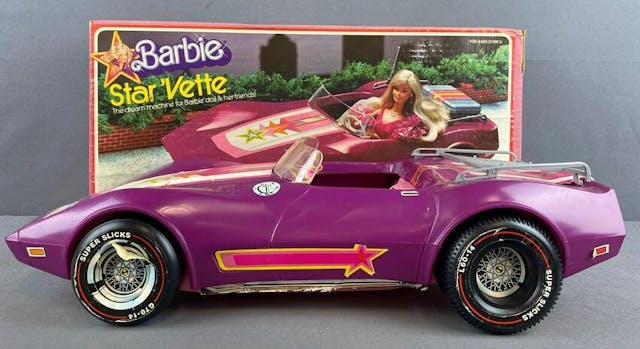
The third-generation Corvette (C3) was her first, making mid-’70s Barbie’s American dream come true. Dubbed the Star ‘Vette, this magenta-colored beauty donned the slim mid-section and fat fenders from the pens of Chevrolet designers Zora Arkus-Duntov and Bill Mitchell. Then there’s Barbie who, if she were an actual woman instead of a doll, would have been anatomically impossible.
Barbie’s pink convertible came with star decals for the hood and door panels. A luggage rack came with a snap-on suitcase. (This being a Corvette, we can assume two sets of golf clubs fit in the trunk.) The interior came fully loaded with a tape deck and three cassettes. It also sported sport bucket seats, a CB radio, and a working steering wheel that turned the front wheels, and sweet “G70-14 Super Slicks” tires.

In 1979, the Barbie Super ’Vette hit toy stores with remote-control capability, though, since it was corded, you’d have to walk alongside Barbie and her plastic man as you cruised the living room. The Super ‘Vette’s sunshine yellow hue sparkled over a blue interior. The toy version seems to have snagged the post mid-cycle refresh details in concert with the big-person version, including the front and rear bumpers revised for federal safety compliance. Barbie is law-abiding, but we’re assuming the RC version’s electric power meant it was exempt from Malaise Era emissions controls.
Mattel took some creative license taken, however, as the real-life 1975 Vette was the final one of the C3 generation to don a convertible top. Ingress and egress would never have been so easy in a coupe, and it helped that 1967 marked the first year Barbie started bending her legs and could swivel at the waist thanks to “Twist ‘N Turn” technology.
There were only two engine options for the real-world, late-model C3: a 350-cubic-inch small-block that made 165 horsepower and the L82, which made substantially more, with 205 max output. Barbie, one imagines, opted for the bigger engine just to see if she could blow any of Ken’s hair back. By 1980 we got the final of Barbie’s C3 iterations. The interior even gained a TV screen—how prescient! The box came with the verbiage “push it everywhere,” which is not the ideal situation for real-deal Vette owners.
Mattel stayed on the Corvette bandwagon into the Dave McLellan–designed C4 generation, built between 1984 and 1996. Brand-new from the chassis up, the C4 represented a sea change for America’s sports car, and Barbie had several. As the C4 shifted from a fiberglass body-on-frame to what GM called a “uniframe” U-shaped frame construction, Barbie also got some significant changes. This was the ’80s, so Great Shape Barbie arrived in her leotard-and-leg-warmers outfit. The C4 got more power during its tenure, up to 375 hp if you got the LT5-equipped ZR-1; the improvement of Barbie’s core strength after adding Jazzercize to her workout regimen is impossible to quantify.

Barbie’s first C4 showed up at toy dealers in 1983 as the sparkling metallic pink Ultra ‘Vette. Around 1984 another Mattel C4 appeared, named Silver ‘Vette, for obvious reasons. While the clean design of this 1980s-era Corvette felt understated by the decade’s excess-laden standards, the Silver ‘Vette came loaded with “lots of realistic features” as the box proclaimed: vanity plates, chrome wheels (stickers), and a working hatchback window.
While we’ve only had eight generations of Corvette, Barbie has seen closer to 12 major facial changes. This doesn’t take into account her myriad mid-cycle refreshes as different makeup trends came and went.
Barbie has run for President of the United States every year since 1992. That year, to reflect this new stoic Barbie, Mattel left the cutesy naming conventions behind; it was now just the Barbie Corvette. Today you can find a pink-on-pink example on eBay for anywhere from $15 (a well-played-with driver) to $75 for a sealed, new-in-box specimen.

Over the years, the Corvette saw its share of race tracks, doing duty as pace car for Indy over several years of its run. Barbie herself, no stranger to motorsports, first appeared to the NASCAR crowd in 1998 with, yes, NASCAR Barbie, in honor of the 50th Anniversary. Helmet and firesuit in hand, Barbie was ready to take the wheel. In 2000, Barbie belted in for Scuderia Ferrari, becoming an F1 driver for the yellow and red. (There was a car, too but it was a limited edition that only sold at the 2004 International Barbie Doll Collections Convention in Chicago.) Let’s hope it’s not much longer until a real live woman can claim an F1 seat.
By the mid-2000s Barbie took a step back from the cockpit, dressing in Dale Jr.—and Jeff Gordon-inspired streetwear, but by 2009, she was back in the driver’s seat again when Race Car Driver Barbie showed up ready for the starting grid.



Radio Shack, back when that was still a thing, offered up a gift set that featured the new-for-1997 C5 as a proper remote-control unit. From what I can tell, it’s her only example of the C5 and the final Corvette Barbie would have. The pale-pink-over-white car could turn and reverse and came with chrome wheels (plastic, not stickers this time), a quad exhaust, vanity plates, and power from four C batteries. Purists may consider the Corvette E-Ray to be the first to drive its wheels with battery power, but Barbie thinks otherwise.
The real-life C5 got the LS1 engine and a new transmission—a rear-mounted transaxle—as well as hydroformed box frame that improved stability, especially on the convertibles. Barbie thanks you, Chevy.


Barbie’s first-generation Corvette (C1) in the 2023 movie is scaled smaller in size but retains the pastel-shaded, two-toned details of the original. This officially marks the first time Barbie has claimed a C1 in the driveway. There’s actually one in every Barbie’s garage (yes, every Barbie in the movie is named Barbie). The director, Gerwig, clearly has excellent taste.
Barbie rarely rides in the passenger seat of her cars, but she did once when her sister, Skipper, went to the DMV. The Student Driver gift set came complete with driver handbook, traffic signal charts, and an insurance card.
Barbie’s passion for driving and cars has hopefully fueled the love of cars for girls and young women across the globe. Now, come on Mattel, put her in a C8.


***
Check out the Hagerty Media homepage so you don’t miss a single story, or better yet, bookmark it. To get our best stories delivered right to your inbox, subscribe to our newsletters.
The post In the Barbie garage, Corvette is queen appeared first on Hagerty Media.
]]>
Bay Harbor, Michigan, looks built for a postcard. From the clear blue waters of its namesake harbor to the tidy main drag to the world-class golf course draped along the Lake Michigan shoreline, it is a little slice of summer heaven. For one weekend in late June, that main drag, the harbor, and the surrounding lawn become an automotive enthusiast’s field of dreams.
2023’s Bay Harbor Classic Car & Boat Festival featured something for every car nut: Prewar icons, British roadsters, American muscle cars, and modern supercars like the mid-engine Corvette Z06. Between the carbon fiber, polished chrome, lacquered wood, and the sun, I wouldn’t be surprised if you could have seen the twinkling from space.


While automotive eye candy was available everywhere you turned, one car had a presence like no other: A 1933 Duesenberg Model J “Sweep Panel” Dual-Cowl Phaeton owned by Bob Grooters, one of the show’s organizers. The striking two-tone red and black paint, paired with pristine whitewall tires and loads of sparkling metalwork, set off the monolithic lines of this art deco star.

No matter how many images you pore over on Google, no combination of pixels can convey the majesty of a Duesenberg in real life. There’s a certain scale to the car in person that gets lost in even the most artful photos. When I stood next to the driver’s seat and looked down the front of the car, I was shocked by how far away that angular hood ornament sat.
The brash grandeur of dinner plate-sized headlights and an engine cover that could double as a canoe somehow balance perfectly with subtle flourishes like the contoured metalwork atop the grille and the brushed aluminum of the instrument panel cover. The sumptuous cabin felt like the perfect perch for the industry magnates who bought these cars new. Witness a car like this, and the seven-figure price tags Duesenbergs routinely command at auction suddenly make sense.

The ’33 Model J wasn’t even the only Duesenberg at the show; there were two others. There was also a 1935 Duesenberg SJN, a special Model J car that combined the supercharged Lycoming straight-eight engine from the SJ with the lower, wider Rollston bodywork of the JN. This white-over-black example is one of just four Rollston-bodied cars, and it’s the only one with the factory-supercharged Lycoming straight-eight. The other Duesy was a 1934 Model J four-door Arlington sedan by Derham in stunning black and red.
The rest of the Bay Harbour show boasted stunners from every era. A Jaguar owners club showed out in force, bringing everything from E-Types to XJs. A British car club brought out an original Mini as well as a few Austin-Healeys and Triumphs. There was a whole row of C8 Corvettes, the star of which was a white Z06 70th Anniversary model.


At one point, an Amphicar even puttered right through the harbor and up the boat ramp onto the main street. That harbor housed plenty of classic wooden boats, the star of which was a massive cruiser that goes by the name Pilgrim. On the lawn of a restaurant that abuts the harbor sat a collection of soap-box derby cars with sleek bodywork and wafer-thin wheels, celebrating a bygone era of mechanical ingenuity.



Up the main drag were a few German stars like a Porsche 356 Coupe and a BMW Z3 M Coupe, more affectionately known as a “Clownshoe.” A Ram SRT-10 pickup sat across the way, its hood wide open to show off the Viper-sourced V-10. If you fancied more modern exotics, a few Ferraris and McLarens were just a stone’s throw away around the corner.

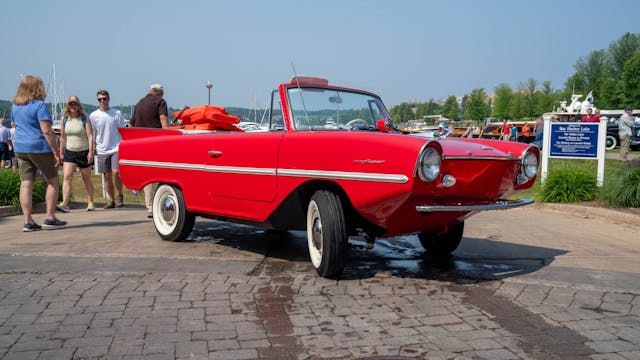



If you find yourself in Northern Michigan in late June of next year, be on the lookout for the Bay Harbor Classic Car & Boat Festival. The show is free to spectators and a delightful way to spend a summer Saturday, whether or not you have a car on the lawn.

















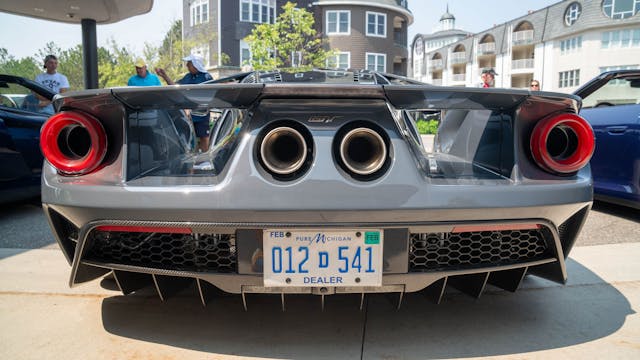



***
Check out the Hagerty Media homepage so you don’t miss a single story, or better yet, bookmark it. To get our best stories delivered right to your inbox, subscribe to our newsletters.
The post There’s nothing like seeing a Duesenberg in person appeared first on Hagerty Media.
]]>
What better birthday to celebrate right before America’s than the Corvette’s? 70 years ago today, the first example of America’s sports car rolled out of the factory in Flint, Michigan.
Building that first car was an interesting process. The Ford Model T might have brought the production line to popularity 45 years earlier, but the first Corvette was hand-assembled. Workers at the Flint factory took the parts, pieces, and materials and painstakingly combined them into a functional automobile. That 1953 model was equipped with a Blue Flame inline-six engine mated to a two-speed Powerglide transmission—ironic, considering how many of the Corvette faithful consider the lack of three pedals in the eighth and latest generation to be an atrocity.

No matter how polarizing that drivetrain might be now, it was the Corvette’s body construction, not its transmission, that made waves at the time. Fiberglass was best known as a boat hull material; it was not yet widely used for car production.
Chevrolet’s fiberglass molds shaped a curvy little roadster, complete with plastic curtains, instead of windows, that snapped into place. All 1953 Corvettes were sprayed Polo White, with interiors upholstered in red. Despite the lack of color options, it took two days to assemble the first models. For comparison, it takes the Corvette factory in Bowling Green, Kentucky, three shifts to build a C8—roughly, a day and a half. Considering how much the Corvette has changed since those very simple, white-wall-tire cars of the ’50s, let alone how many more options are on the C8’s build sheet, that pace is pretty darn impressive.
What the Corvette would become could have only been a dream for those early owners. A new C8 Z06 can clear a quarter-mile at 131 mph before a 1953 Corvette has even reached 60 mph. What or where will the Corvette be next is certainly a great debate, but one thing is clear: Few American cars have such a beloved, long-running lineage.





***
Check out the Hagerty Media homepage so you don’t miss a single story, or better yet, bookmark it. To get our best stories delivered right to your inbox, subscribe to our newsletters.
The post 70 years ago, the first Corvette was born appeared first on Hagerty Media.
]]>
More accustomed to his eight-second drag Camaro, Sean Cagle wasn’t swayed by the idea of lapping a road course in a basic production car. A persuasive friend insisted he try it. About a decade ago, when Cagle finally got his road course maiden voyage in an SVT Cobra track-prepped by Caliber Customs, the drag racer began singing a different tune.
“I remember wondering, ‘When the hell is he going to brake?’ I knew we were going to crash, but the car stuck. I just couldn’t believe a basic Mustang could do that,” he says.
Cagle wanted to feed his newfound love for cornering. Building a domestic track car that could match his drag Camaro for performance stats seemed costly, however. As long as he wasn’t crashing into other cars, he figured, he could swing it. That thinking steered him away from wheel-to-wheel competition and into the wild world of time attack.
From Camaro to Corvette
In time attack, it’s one car on track at a time. Driver and car compete against the clock. For his battle against the stopwatch, Cagle started with another Camaro—a fourth-gen like his drag car—but ultimately went for a bolder, smaller, lighter, and more aerodynamic build: a C5 Corvette Fixed Roof Coupe (FRC). Naturally, he partnered with Caliber Customs and owner, Matt Lambrecht, for maintenance, modifications, and race support out of Madera, California, north of Fresno. After adding a cage, a Racetech bucket seat, a cam, an exhaust, and a set of Toyo R888 tires, Sean was already setting laps on the 13CW configuration of Buttonwillow Raceway in the 1:55 range. Pretty remarkable for a lightly tuned, $15,000 car.

The C5 Corvette, even in stock trim, is a great road course machine. The manual transaxle helps with traction, the V-8 motor is plenty pokey, weight is moderate, and the driver enjoys a direct, unfiltered connection to the car via each input. That said, the steering is a bit slow in a motorsport context, but the feel through the wheel is encouraging and the steering effort, once the tires are warm, is high. The front end feels intuitive and easy to place. There are no invasive driver aids in this car, so it can bite, but the Corvette FRC is not as unforgiving a car as some would believe.
Performance tuning is all about chasing equilibrium, and Cagle’s modified C5 was suddenly lighter and capable of much more grip than was compatible with the factory leaf spring suspension rates. The consequence was ridiculous body roll, which Caliber solved with a set of double-adjustable Penske shocks, along with that AP Racing Radi-Cal front brakes. (The C5’s entry cost is low, but it does eat up consumables like tires and brakes.)
Once the car had put up some competitive times, closer to the low 1:50s, Cagle and Lambrecht felt confident they could make a mark in the Global Time Attack race series. Their first event was at Buttonwillow in March 2016; the C5 took first place in the Limited RWD class with a time of 1:53.34 around the 13CW configuration.
Beginner’s luck? Careful preparation? Cagle didn’t care. He’d found success in a competitive environment, and the culture of the series suited his temperament.
“Country boys” make their mark
Global Time Attack hosts a fiercely competitive field that includes a number of six-figure builds, but the entrants nevertheless maintain a casual, supportive atmosphere. “I’ve had my competitors lend us tools and parts when, otherwise, we would’ve been screwed,” Cagle says. Try finding that in comparable road racing series.

Sean and Caliber describe themselves as the “country boys” of Global Time Attack. They pride themselves not only on their ability to hang with the larger and better-funded teams, but also their contribution to the convivial atmosphere in the pits. “We see ourselves as the jokers of the GTA bunch and we party hard,” Cagle explains. “If you’ve been by our pits after the sun’s set, you’ve likely been offered one of the fine whiskies we’ve tabled.”
The pressure to find those last vital tenths is palpable, however. For Cagle, it’s the main force that keeps him coming back. “I’ve got one lap, a $2000 set of sticker tires, friends and family watching, 190 beats a minute, and I’m gridded up against some incredible drivers. It takes all my focus. I’m getting chills thinking about it,” he gushes.
Forced induction
Toward the end of his first season, the C5’s 5.7-liter LS1 V-8 started losing oil pressure. It was a good opportunity for Cagle and Lambrecht to pause, discuss a rebuild, and map out their grand plans for the future. The next mountain to climb: Global Time Attack’s Unlimited class and a lap goal of under 1:40 on Buttonwillow 13CW.
To shave off more than 13 seconds they’d have to double the Corvette’s power output. A highly-strung, 7.0-liter LS7 V-8 could have met their power goals, but not cheaply or for very long. The duo thought back to their teenage years, when they raced their turbocharged Camaro at the drag strip with great success. “Our thinking was simple,” Sean explains. “Turbos might give us the power we needed with better reliability than what the normally aspirated [LS7] engine could offer.”
There were other upsides: “We also wanted the whistling noises.”
Snappy turbocharging seemed to check all the boxes, but Cagle and Lambrecht knew they could not skimp on hardware. Any lag that would delay throttle application was a non-starter. They settled on an 6.0-liter LS2 V-8 (standard on the subsequent C6-generation Corvette), filled it with tougher internals, bored it to 6.1 liters, and fitted it with a Holley Dominator ECU. The stage was set for the best boost on the market.
With optimal throttle response as the goal, they took a page from the book of then-Ultimate-series-leader Will Au-Yeung, who ran a BorgWarner EFR turbocharger. This range of high-tech turbo technology, specifically the EFR 7163 model, suited Cagle’s C5 FRC build for a two important reasons:
- Tight Packaging: To fit a turbo and its piping on both sides of the engine, behind the front axle and low in the chassis, the system had to be compact. The EFR is not particularly large.
- Turbine Wheel Mass: The EFR’s titanium aluminide compressor wheel is 50 percent lighter than the same-sized wheel made of Inconel, making it one of the lightest on the market. Less mass means less lag, which means a response and drivability closer to that of a normally aspirated engine.
They settled on a pair of small-frame EFR 7163s. The two turbos allow for nearly 1000 horsepower and can transition from full vacuum to their full 16 pounds boost in 0.4 seconds.

That feisty response imposed some restrictions on the length of the car’s sessions. Quick boost response requires a compact turbine housing, but pushing all of that boost through the an 0.85 A/R (area over boost) housing caused exhaust temperatures to soar as high as 1860°F. That’s 160 degrees hotter than the compressor wheel is rated for.
The build quality of the EFR turbo, they figured, was solid enough to handle the excess heat, but concerns remained during the first outing with this new motor. Cagle had to be cognizant of the temperature during his initial laps, making sure to keep the engine sufficiently cool as he started taking mental notes on the new setup.
Spinning plates
Time attack is all about setting the fastest-possible lap, which is a carefully coordinated endeavor. The C5’s turbo temperature limitations permit one fast pass before the turbos overheat, among a number of other crucial variables to juggle.
The most visible strategy is that the Corvette’s tires are kept under warmer blankets, making it one of the few cars in Global Time Attack to do so. Because of these critical target temperatures, the car cannot sit on the grid awaiting its turn. As a result, it is always the last to join, escorted past the queue like a detained criminal onto an airplane. After setting its one fast lap, it’s usually the first ushered off the track.
Then there’s the matter of fuel: The race car’s Radium fuel cell holds a mere eight gallons. By the time the car leaves the pits, completes an out-lap, a flying lap, and an in-lap it’s 5 gallons lighter in under 5.5 minutes or so.
Even without the fuel constraints, it’d be tough for any driver to last much longer behind the wheel. The engine’s oil catch can vents some of its contents into the cabin, but because the entire cockpit is sealed to reduce drag the vapors don’t dissipate. “After one lap, my eyes were watering,” said Time Attack ace Kevin Burke after a couple casual laps in the car.
Clutch temperature is another thing to monitor: Cagle only needs third and fourth gear to round Buttonwillow, so he doesn’t need to shift all that often. He must, however, remember to completely release the clutch pedal before applying throttle or the clutch will slip. More slip yields higher clutch temps.
As we look, Cagle sets out tentatively for his session, careful not to overcook the turbos or the tires. (The car has no traction control, either.) All told it is a fairly straightforward driving experience, he notes, provided the driver respects the copious power on tap—and all of the essential operating windows.

Burke agreed, impressed with its approachability and capability: “It rides on clouds and absorbs every curb. The on-limit behavior is progressive. You don’t realize how fast you’re going because it works so well.”
Driving is but one part of a complicated development process targeting the car’s ultimate potential. After rolling back into the pits, Lambrecht plugs his laptop into the car’s computer, rifles through minute data points: exhaust gas temperature, turbo wheel speed, throttle input, fueling, crankcase pressure, knock activity. After the download comes a quick debrief before Cagle suits up for another run.
A cleansing fire
It wasn’t always so seamless. Back during their first outing with the turbo motor, Cagle and Lambrecht were still learning how to get the car to behave. With a build of this magnitude, one or two errors are understandable, but they turned out to have disastrous consequences.
At the time of the fateful incident in November 2018, the C5’s crankcase ventilation catch can was located above the downpipe. There were no signs during dyno testing that this should be cause for concern, but that changed out in the real world. Once the lateral g forces came into play that first track day, engine oil worked its way out the valve cover breathers and completely filled the catch can, all in the space of one hot lap.
By the time Cagle started his second lap, he saw smoke. The flames spread faster than he could react, preventing him from unlatching the hood, grabbing the extinguisher, and pointing it at the source in time. His desperate attempts to douse the fire through a hood vent were in vain.



He dropped the dinky fire bottle and felt his heart sink, turning to witness the support truck taking the long way to the scene. By the time it arrived, he was already walking away from the charred wreckage.
The Corvette needed new front body panels, new plastics, new turbos, a new wiring harness, and a smattering of other bits that had been irrevocably burned. Cagle had some reservations about fixing the car, given the scale of the damage, but he’d committed to the cause—as did the team who took responsibility for the fluke catastrophe. Everyone resolves to rebuild the car better than before.


Phoenix reborn
By the time the crisped car made it back to Caliber Customs, the team was already planning a big-time return. A few additions promised improved high-speed performance. Along with a complete AJ Hartman Aero package, Caliber added KW EXR three-way coilovers. Optimized with trackside support from KW’s lead engineer, this suspension helped the car confidently attack curbs at higher speed.
The team also sourced an engine block from a 6.2-liter LSA V-8, within which additional webbing allowed for more boost. A full manual Tilton pedal/master setup helped improve brake feel, and fine-turning the brake system for travel, pressure, bite, and release made it a confidence-inspiring setup. With no ABS on board the C5, Cagle was grateful for all the feedback he could get.




With a motorsports-grade harness, the best of five sampled heat wraps, a Dailey Engineering dry sump, a relocated catch can, and the bit between their teeth, Cagle and crew returned to Global Time Attack for the 2019 Finals at Buttonwillow. “We wanted redemption,” Lambrecht declares.

Feeling the wind in his sails, Cagle strapped into the latest iteration of his dream car and set a time of 1:44 on his first flying lap. Clearly, he’d lost nothing from the time away. The team’s final time at that event was a 1:43.2, placing them in second place behind champion drifter and road racer Dai Yoshihara. Redemption achieved.

Though the C5 build had proven its capability, Cagle and Caliber took another stab at the last Global Time Attack Finals in November of 2022. They made quite a splash, logging a 1:40.2 that bested decade-long Billy Johnson’s RWD Unlimited record. Many whiskies were poured that evening.

Better still, on-board data indicated the car had more to give—a 1:38 was feasible. That time was even projected using predictive timing software during the competition, at least until the boost pressure crept up too high and triggered the system to cut ignition for several seconds. With a little luck, sub-40s are well within reach.
“I have a love-hate relationship with this car,” Cagle says. “It requires so much from me and the rest of the team. I have to rely on these knowledgeable, meticulous professionals—Matt, Mikey, Nick, and Steve—to run this car. It’s a complicated machine, so everyone has to be sharp.

“I can live with that, though. That is the price of going extremely fast—and it’s a price I was willing to pay since I wanted to see what it was capable of with the best people and products thrown at it.”
Breaking their own record at Buttonwillow 13CW is the next big goal. For all the necessary stars to align demands an unparalleled organizational effort from the outset, but the players involved consider it a deeply rewarding one to pursue. Cagle and Lambrecht, along with the rest of Caliber Customs, may yet manage that one perfect lap.






***
Check out the Hagerty Media homepage so you don’t miss a single story, or better yet, bookmark it. To get our best stories delivered right to your inbox, subscribe to our newsletters.
The post This 1000-hp C5 Corvette won’t quit until that one perfect lap appeared first on Hagerty Media.
]]>

It wasn’t just because of the rain that would absolutely soak part of the 8.5-mile course and leave the rest of the track dry. It wasn’t because of the huge, 62-car field, a size that had forced race organizers to turn away entries.
It wasn’t even because Ferrari was competing for the overall win, for the first time in 50 years, back in the “Ford vs. Ferrari” era. And it wasn’t just because Ferrari won, in an incredibly popular victory.
The 2023 24 Hours of Le Mans felt different because it was different.

That difference began way back on January 24, 2020, before a packed and moderately skeptical crowd at the Daytona International Speedway conference room, where IMSA, the ACO, and the WEC announced that they had reached an agreement: There would be a new Prototype sports car that would compete without changes in the top class of IMSA as well as the WEC, and that would include the 24 Hours of Le Mans.
“I’ll believe it when I see it,” muttered one team representative.
For years, you needed two entirely separate Prototype cars to run in IMSA, and in the WEC and Le Mans, effectively locking IMSA teams out of Le Mans. This agreement would fix that. By Le Mans in 2022, American teams would just need to put their cars on a boat or an airplane and ship them to Le Mans for a chance to run for the overall win, something that hadn’t happened for decades.
COVID intervened, and the introduction of the new car would be delayed until 2023. In IMSA it would be called the GTP car, overseas they would continue to refer to it as the Hypercar.

When the green flag fell last Saturday at the 24 Hours of Le Mans, three Cadillacs and three Porsches, cars that had debuted at the Rolex 24 at Daytona in January, were on the grid. Next year they will be joined by a pair of Lamborghinis, and possibly even Acuras, if IMSA can talk the company into competing at Le Mans, with Acura having debuted their car at Daytona but decided to remain stateside.
The Cadillacs and Porsches were joined by a pair of Ferraris that were new for 2023, the first time the company had competed at the top level at Le Mans in decades. They would line up next to a pair of Toyota Hypercars, which had won the race five years straight, and a pair of cars from U.S. entrepreneur Jim Glickenhaus that had been racing at Le Mans. Peugeot also joined the field, along with cars from Alpine and other manufacturers, all built or converted to the new common specifications.
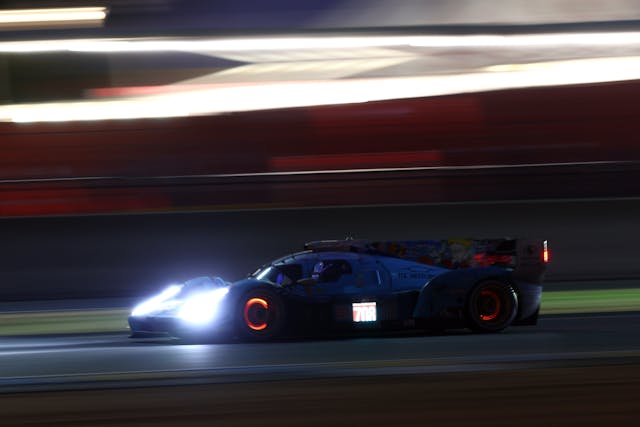
What some doubters had said would never happen, happened. IMSA President John Doonan, who helped pen the agreement that was ratified in August of 2021, was giddy. “Just super pumped,” he told Hagerty from Le Mans, midway through the event. “The media coverage has been so incredibly positive. Really, really happy with how things are going.”

By the time the checkered flag fell Sunday afternoon Le Mans time, multiple manufacturers, including Cadillac, had taken turns at the front of the field, its first time back at Le Mans since a rather halfhearted effort had ended in 2002.
In the end, Ferrari would break Toyota’s streak, though the manufacturer was a close runner-up, with Cadillac third and fourth. It was arguably the most exciting Le Mans since 2000, when BMW, Nissan, and Mercedes ended their participation, and Audi began its long run of domination, succeeded eventually by Toyota.

2023 marks a new era in sports-car racing in general, Le Mans in particular. It was Ferrari’s first outright win in 58 years, and IMSA officials will be lobbying the brand to get the team to race at the Rolex 24 at Daytona in coming years.
Other Le Mans notables
Corvette Racing, in its final full-factory effort before turning the brand over to privateer customer teams next year, won in convincing style after an early suspension problem put the single-car team two laps down. The TV coverage gave a tremendous amount of time to 51-year-old Ben Keating, a gentleman, non-professional driver who owns 28 auto dealerships in Texas, and races for fun.

Keating may be the most accomplished gentleman driver in years. He won his class last year and won the GT class a couple of years before, only to have the victory taken away while he was standing at the Houston airport baggage claim after Le Mans technical inspectors found that his privateer Ford GT’s gas tank contained “about one Coke can too much fuel,” as Keating said at the time.
Team owner Roger Penske, who has trophies from multiple major races but the 24 Hours of Le Mans, entered three Porsches at Le Mans hoping to add one more victory to his resume. But the Porsches suffered both mechanical gremlins and on-track incidents, with ninth the best that one of the Porsches could do in the 62-car field. IndyCar rival Chip Ganassi did collect a trophy from Le Mans, though, as he operates the Cadillac team that finished on the podium.

NASCAR sent a much-modified Chevrolet Camaro Cup car to compete in the exhibition-only, one-car Garage 56 class, much to the delight of the crowd. “Fans love the car,” Doonan said. Drivers were seven-time Cup champ Jimmie Johnson, Formula 1 champ Jensen Button, and sports car ace Mike Rockenfeller. The car was almost as quick as the GT cars, running as high as 25th overall, before a lengthy driveline repair sent the car back to 39th in the field. Overall, Doonan said, it was a major success, with some of what the Hendrick Motorsports-led effort possibly ending up in NASCAR as more and more emphasis is placed on road course and street racing.
It was announced earlier that the lone WEC race in the states, which would draw the majority of the Hypercars to America, would no longer be part of the Super Sebring weekend, but would instead run at the Circuit of the Americas in Austin. It’s a blow to Sebring, but they’ll do fine with the traditional Mobil 1 Twelve Hours of Sebring next March as a standalone.
***
Check out the Hagerty Media homepage so you don’t miss a single story, or better yet, bookmark it. To get our best stories delivered right to your inbox, subscribe to our newsletters.
The post Why this year’s rain-soaked Le Mans felt different appeared first on Hagerty Media.
]]>
Growing up in Jackson Heights, Queens, I was the neighborhood kid who would always detail all the older kids’ vehicles in the neighborhood. The C3 Corvette was always a lifelong love for me. I really loved the car so much. When I retired in 2010, I could finally fulfill my dream and try to find one.
I searched for a few years, and then I found a 1972 Corvette in Texas. It was just what I was looking for, so I pulled the trigger and purchased it in 2017. It’s been a six-year project; the car spent an entire year in paint. Everything was taken off. Jeff Buchak, the owner of Paradigm Automotive in Sparkill, New York, is a genius. He has done cars for the Pebble Beach Concours d’Elegance and for the SEMA show. Jeff does really high-end work. The paint is flawless, the gaps are flawless. I’m pretty much a perfectionist, and we made it perfect.
I was a fan of all the blues of the ’70s that Corvette did. There was Briar Blue, Targa Blue, Le Mans Blue. We took all the blues that Corvette offered for 1972, and we made one blend. The paint is unbelievable, because depending on the lighting conditions, it can look like Targa Blue, and then if it’s a little lighter, it may look a little bit like Briar Blue.
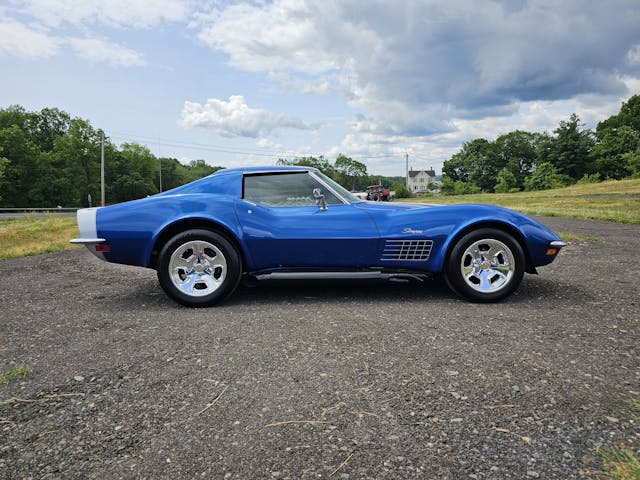
The engine is the numbers-matching 350 stock block. I like to go fast, so we stroked it out to a 383 and replaced the carburetor with a Holley Terminator EFI. We did all kinds of high-performance work with the trick flow heads and the cam and everything. I did the EFI and certain mods to it because I wanted it to be reliable. I wanted to be able to hop in the car and drive without incident. I take it to a lot of shows in the tri-state area, New York, New Jersey, and Connecticut. I belong to the Rockland Rodders Car Club in Rockland County, New York, and I belong to the All-American Corvette Club in Paramus, New Jersey. I want to try to do my part to get more younger people involved in it, and more involved in the hobby.



When I’m at a show, my car doors are open, I have kids in there, and I don’t care if they get it dirty or if they have ice cream on their hands. The car can always be cleaned. When you get a 12-year-old or a 10-year-old and you say, “Go sit in the car, take some pictures,” their eyes light up, and it means the world to them. They’re hooked at an early age. It’s these simple things that car people can do to get the younger generation into the hobby.
I had a young kid come up to me and say, “Thank you so much.” And I said, “Thank you for what?” He replied, “For preserving history. For giving my generation the opportunity to see what a 1972 Corvette Stingray looks like. And to enjoy it.” I had a tear come to my eye. And I said, “Oh, man. No, it’s my pleasure.” The younger people, they love it, they appreciate it, and hopefully, we can recruit that young generation of gearheads together into the hobby.







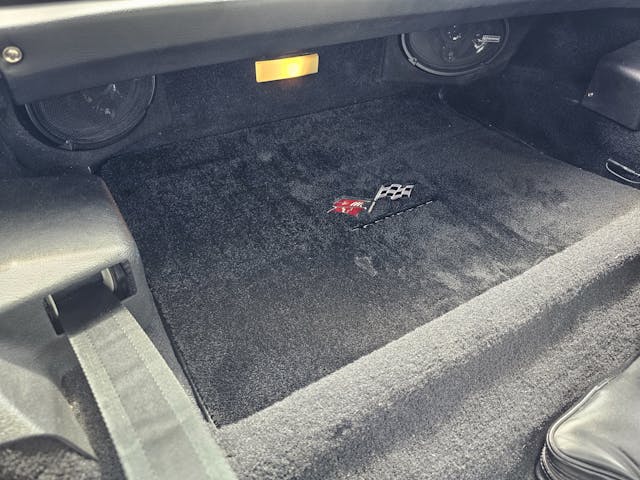


***
Check out the Hagerty Media homepage so you don’t miss a single story, or better yet, bookmark it. To get our best stories delivered right to your inbox, subscribe to our newsletters.
The post This 1972 Chevrolet Corvette fulfilled my lifelong dream appeared first on Hagerty Media.
]]>

“I’m searching for a low-miles collector car, and it has to have an original, numbers-matching motor.” So says nearly everyone when looking for their next classic car. But why?
Part of it is undoubtedly groupthink. We have aged into this hobby believing that these are the best cars. But is that true?
In the case of low miles, it ain’t necessarily so. A 20-year-old car showing 2500 original miles, be it a Ferrari, Porsche, or Honda, is a collector’s dream come true, right? Well, possibly—it depends how long the car has sat without attention. If it’s been a while, “waking up” that car might be a complicated (read: expensive) undertaking. The tires have aged out. The fuel tank might be filled with a smelly gelatinous version of gasoline. And any internal-combustion engine, sitting without the benefit of lubrication, will likely need serious attention.
Maybe those 2500 miles were collected at a rate of about 100 per year. Are the belts and hoses the original, aged-cracked rubber ones? Was the exhaust system ever warmed up enough to heat and vaporize the moisture trapped inside, or is the system now full of rust?
Let’s look at it from another angle. Is it worth it to you to pay a 30, 40, or 50 percent premium to get a 2500-mile car over a 25,000-mile example? This is a question only you can answer, but it’s something worth thinking hard about, especially if your plan is to drive the car instead of placing it in bubble wrap for most of your life. In doing the math for most cars, putting an additional 25,000 miles on a car that already has 25,000 miles on it will cost much less in depreciation than starting with a 2500-miler and adding your own 25,000 miles.

On the note of “numbers matching,” almost no one knows what that term actually means. That’s because it is interpreted many different ways by many different people. In the very broadest of broad strokes, one could reasonably interpret “numbers-matching” as a car with all the original parts that contained serial-style numbers, which were placed on the vehicle when manufactured. Now, does that mean if one tire was replaced after a blowout, the car is no longer numbers-matching? Tires have numbers, right? You might think I’m exaggerating, but we’ve all seen an ad that details “originality” to an extreme.
Newsflash: Before “matching numbers” was a thing, when your engine blew up under warranty, you actually wanted a new one, not some rebuild done by the guys in the shop. But somewhere along the line people started believing their cars were as pure as the driven snow—that surely Zora, Enzo, Henry, or Butzi had built the thing themselves.
I had a client 20 years ago ask for advice on buying a C2 Corvette. Among his must-haves was matching numbers, which he interpreted as the serial number of the engine matching that of the chassis. His intent was to have fun with the car, to drive it, to wrench on it, and to bond over it with his preteen son (who loved Corvettes). Eventually, he said, he wanted to give his son the car, possibly as a college graduation present.
He was stretching his budget to find the right example, so I pointed he could get a car with a replacement engine (in Corvette-speak known as a NOM, for non-original motor) for perhaps $15,000 less. Intrigued, he did the math. He wasn’t buying the car as an investment; he was buying for fun. He didn’t care about ever showing it or having it judged. So he bought a great car that was everything he and his son wanted. The NOM was a later crate motor that proved to be a reliable powerplant from day one. Today, his son enjoys the car every bit as much, perhaps even more, than if it had come with the original motor.

If you’re shopping for a car to drive and enjoy—which I suppose most of us actually do—buying against the grain can save money in the long run. If you can afford the best, with low miles and matching numbers, feel free. I’m just saying that often there is no reason to eliminate a “lesser” car with higher miles or a replacement engine. The old-timers will tell you that someone else worked out the bugs for you.
I’m not here to tell you how to spend your money. But I am here to give you complete permission to buy what YOU want, not what your friends want. Besides, unless you’re selling, no one has to know.
***
Want a better understanding of what’s driving collector car values? Sign up for the Hagerty Insider newsletter.
The post Is a low-mile, numbers-matching classic actually what you want? appeared first on Hagerty Media.
]]>

Steven writes:
While my 1993 Corvette’s gas gauge and (new) sending unit/fuel pump assembly test fine, the gauge consistently reads 6 to 7 gallons low. My question to you is, would bending the float arm down about 25 degrees make the gas gauge more accurate?
Sajeev answers:
Hi Stephen: I think you are on to something. I am hoping that new sending unit’s float arm was bent while in transit, or incorrectly bent from the factory. If that doesn’t work, I wonder if the sending unit is defective.
Steven adds:
Actually this is the third sending unit installed by my mechanic. All of them read low by about 6 to 7 gallons. For some reason the shop refuses to bend the float arm after I made several requests to do so. I take it from your reply that would be an acceptable solution.
Apparently GM has discontinued the original ’93 Corvette sending unit assembly, but the aftermarket fitment was installed after two Delcos. All of them read low!

Sajeev:
Well if it’s the THIRD sending unit, I am less optimistic this is the solution. You said the gas gauge is fine, but I wonder if the wiring has some resistance problem between the tank and the gauge. I would also see if there’s a voltage drop on that purple(?) sending unit wire. Maybe the mechanic already checked that?
Steven:
Thanks for your replies. I assume the mechanic checked all the wires in between for shorts, resistance, etc. The ohms read correctly at full and empty.
Sajeev:
I would ask the mechanic about the wiring, as it never hurts to rule out that variable from your equation. Once answered, go ahead and bend the sending unit, because either it will work or the sending unit doesn’t provide correct resistance (I think its 0 to 90 ohms) for your factory fuel gauge. If the latter is true and GM mis-spec’d the replacement part, it will never work correctly … no matter how you bend it.
It’s entirely possible that the part is not the right one for your Corvette, and no bending will help. If you still have the original sending unit, there are places where you can get it rebuilt. And the more I think about this scenario, the more I think your original part needs to be reconditioned to actually fix your problem.
Have a question you’d like answered on Piston Slap? Send your queries to pistonslap@hagerty.com—give us as much detail as possible so we can help! Keep in mind this is a weekly column, so if you need an expedited answer, please tell me in your email.
***
Check out the Hagerty Media homepage so you don’t miss a single story, or better yet, bookmark it. To get our best stories delivered right to your inbox, subscribe to our newsletters.
The post Piston Slap: Going full send on a Corvette sending unit? appeared first on Hagerty Media.
]]>

Corvette Z06 will pace the 107th Indianapolis 500
Intake: For the 20th time since 1978, a Chevrolet Corvette will pace the field for the Indianapolis 500 this year. It’s the 34th Chevrolet to pace the Indy 500, dating back to 1948. This year’s Z06 pace car features a Red Mist Metallic exterior paint, a two-tone Jet Black and Sky Cool Gray interior with Torch Red accents, and forged aluminum wheels finished in Tech Bronze. It’s powered by a 5.5-liter LT6 engine with 670 horsepower, making it the highest-horsepower naturally aspirated V-8 engine ever to hit the market in a production car. It’ll be the first hardtop convertible version of the Corvette to pace the race.
Exhaust: “We are honored to be pacing the 107th running of the Indianapolis 500 with the Corvette Z06 convertible,” Scott Bell, Global Chevrolet vice president, revealed. “Chevrolet and IndyCar share the same spirit of competition, and we are proud the Z06 will lead the pack across the bricks at Indianapolis Motor Speedway.” The 107th running of the Indianapolis 500 will take place on Sunday, May 28. — Steven Cole Smith
End of the road for Mercedes’ slinky CLS-Class 4-door coupe






Intake: Mercedes-Benz has announced that the CLS-Class 4-door coupe sedan will cease production at the end of August. A statement provided to Hagerty by Mercedes spokeswoman Cathleen Decker said the following: “In consideration of the global growth potential, and as part of our strategic product portfolio planning, we have decided to end the lifecycle of the CLS on August 31 with the changeover of the E-Class to the 214 model series.” Last year, the company announced intentions to streamline its portfolio and strip out some of the excess that was filling hyper-niche areas, a decision that appears to have led to this result. Mercedes now sees the E-Class as a fitting platform to take over the ground that the CLS used to cover. Decker’s statement also mentioned that the EQE and EQS electric models have eaten into the market that the CLS would normally try to conquer. Thankfully, Mercedes-AMG’s raucous 843-hp AMG GT 4-door coupe will remain.
Exhaust: As automakers rush to make the expensive transition to electrification, trimming small-volume models from the gas-burning portfolio comes as no surprise. Since the CLS-Class and the E-Class share underpinnings, it makes sense to whittle that duo—which are cars, remember, and those don’t sell like they used to—down to one more thoughtfully-executed model. We’ll be sad to see the slinky styling go, but we’re far from surprised by the move. — Nathan Petroelje
Lexus teases a larger three-row SUV called the TX

Intake: Lexus has released an image of the Lexus TX, with the caption, “Something big is coming!” That’s a reference to the TX’s three-row seating. It’s expected to be a sibling of the Toyota Grand Highlander, which has already been shown. The pair will be built in Toyota’s Indiana plant. Car and Driver found Lexus trademarks for the names TX350 and TX500h that suggest it will offer both gas V-6 and hybrid versions.
Exhaust: The TX will give Lexus a new three-row SUV, adding to the smaller existing three-row RX L, which is pretty cramped in the back. Like most big Toyota and Lexus SUVs, it should sell like the proverbial hotcakes and run forever. We expect to see the whole vehicle soon, perhaps before June. — SCS
Polestar cutting production, staff

Intake: Swedish electric vehicle maker Polestar lowered its 2023 production guidance on Thursday and said it would cut its staff by 10 percent, citing a delayed production start for its Polestar 3 and a challenging environment for the industry, says Reuters. Polestar now expects to produce between 60,000 and 70,000 cars this year, versus the previously predicted 80,000. “It has been a tough quarter for EV startups, who face mounting competition from new Chinese players as well as from more established brands,” Reuters says. “An ongoing price war started by Tesla, in addition to high interest rates, has put a further squeeze on the already cash-strapped startups.
Exhaust: Polestar said the production start of its Polestar 3 would be delayed until the first quarter of 2024 instead of the initial mid-2023 start. The company said the delay was due to Volvo Cars, which produces its cars and is delaying its own EX90, having to do further software development and testing. — SCS
Nikola pivots toward hydrogen

Intake: Nikola, the manufacturer of big electric tractor-trailer trucks, is pivoting toward hydrogen for the North American market, according to Automotive News. “Nikola is retooling its strategy. Executives said they’ll refocus operations in North America with an emphasis on fuel cell trucks and a nascent hydrogen refueling business, HYLA.” The Phoenix-based manufacturer, like most startups, is burning through cash, losing upwards of $150 million per quarter, and holds about $150 million in cash and receivables on its balance sheet. About half of Nikola’s spending can be attributed to ramping up production of fuel cells.
Exhaust: Hydrogen is a viable fuel for big trucks, and it would seem, in North America anyway, that Nikola is deeding over the electric big-truck business to Tesla, and attacking from a different direction. Nikola closed at 86 cents per share on Tuesday and opened at 83 cents per unit on Wednesday. Over the past year, Nikola shares have declined 85 percent. At this time last year, Nikola traded at $5.57 per share. — SCS
Subaru ramping up electric production

Intake: Subaru plans to sell 400,000 electric vehicles a year in 2029 by adding a second EV production line in Japan, signaling a dramatic ramp-up as it tries to get 40 percent of its global sales from electrified vehicles by decade’s end. As part of the rapid expansion plan, Subaru said it will also roll out four all-electric crossovers by the end of 2026, a jump from the single vehicle in the brand’s current portfolio, says Automotive News. All of the upcoming EVs are expected to be offered in the U.S., incoming CEO Atsushi Osaki said.
Exhaust: Subaru has been late to the EV party, but appears to be making up for that. In a quarterly call, Subaru announced that operating profit nearly tripled in the company’s fiscal year ended March 31. “Under the roadmap,” Automotive News said, “Subaru will add a dedicated EV assembly line at its Oizumi plant in Japan as early as 2027, with capacity for 200,000 vehicles a year. That will complement a line at the nearby Yajima plant that will deliver capacity for 200,000 EVs a year from around 2026.” — SCS
***
Check out the Hagerty Media homepage so you don’t miss a single story, or better yet, bookmark it. To get our best stories delivered right to your inbox, subscribe to our newsletters.
The post Corvette Z06 to pace Indy 500, Mercedes axes CLS-Class, Polestar cuts production appeared first on Hagerty Media.
]]>
First it was banned, and now it isn’t.
The National Council of Corvette Clubs, which encompasses about 250 clubs in 16 regions and more than 19,000 members, lifted the ban on the Chevrolet Corvette E-Ray from Council-backed competition events. Not only was the E-Ray barred from on-track competition, but the rules also required E-Rays (plus all other hybrids and EVs) to park at least 30 feet from buildings or other cars.
The cause for concern is lithium-ion battery fires, which can’t be extinguished quickly or easily using normal methods. Multiple racetracks are figuring out how to navigate the risk of these incidents, which can be much more difficult to extinguish than conventional battery fires.
According to CorvetteBlogger.com, General Motors became involved last week, likely sensitive to the kind of publicity the as-yet unreleased hybrid E-Ray was getting.

“Prior to Friday’s reversal,” the website’s story said, “we spoke about it with Corvette Product Manager Harlan Charles, who says they had already discussed it with the NCCC and that it was all a misunderstanding. He said the rule change was passed before the E-Ray was revealed, and Chevy’s engineers maintain that the battery packs in the E-Ray are very safe for competitive events. Harlan points out that these same kinds of performance hybrids are currently racing in the top classes at IMSA and Le Mans.”
Apparently that was enough for the NCCC to reverse course. Club President Deb Murphy sent out the following memo to members: “National Council of Corvette Clubs has adjusted section 1.8.14 of our event rules to allow for the inclusion of hybrid vehicles in NCCC events. The rule was originally intended to only apply to fully electric vehicles. The Chevrolet Corvette E-Ray will be allowed to compete. I believe the quickest Corvette in history will be a great addition to our future events.”
Murphy told Hagerty.com that it was “an error in our rulebook. Hybrid was NEVER meant to be included.”
So the E-Ray gets a reprieve for on-track activities, assuming, of course, such events won’t be held at a track the bans electric and hybrid vehicles.
***
Check out the Hagerty Media homepage so you don’t miss a single story, or better yet, bookmark it. To get our best stories delivered right to your inbox, subscribe to our newsletters.
The post National Council of Corvette Clubs lifts competition ban on E-Ray appeared first on Hagerty Media.
]]>20170726012512)
If you’re a Corvette aficionado, you know that Zora Arkus-Duntov’s birthday falls on Christmas Day. This April, the month in which he passed away, we’re revisiting a lesser-known chapter of Duntov’s story. This piece originally ran on our site in June of 2017. —Ed.
When you hear the sound of a raspy flat-six in a Porsche 911, it’s likely you don’t think of Zora Arkus-Duntov. After all, he’s Mr. Corvette. Most credit Duntov for saving the Corvette after GM nearly killed it due to poor sales after the Ford Thunderbird debuted in 1955. He also took many risks to establish the Corvette’s racing pedigree during a time when GM was officially not involved in motorsports.
But things may have been different if one of the Corvette’s rivals had its way. Duntov had a golden opportunity to join Porsche in the mid-1950s after distinguishing himself with two class wins at Le Mans while driving for Porsche. He also solved an engineering issue on the Porsche 356 and had carte blanche to join the legendary German automaker.
Duntov, of course, would have been more than happy to race for his own employer at Le Mans or anywhere else, but no such driving opportunities existed at GM in the early 1950s. The corporation was still riding the crest of a postwar demand for cars and trucks, and racing was not part of its immediate business plan.
But Chevrolet chief engineer Ed Cole foresaw the need for Chevrolet and GM to generate excitement among younger buyers as well as to make its products better through the disciplines of racing. This fact would at least open the door for Duntov himself to race, even if Chevrolet wasn’t.
What led to the Porsche connection? Duntov had established some visibility as a driver in Europe, having competed at Le Mans for Sydney Allard and his British sports car enterprise back in 1953 and ’54. Duntov had worked for Allard in London for several years in the late 1940s, and that connection resulted in the offer of a seat. (Duntov DNF’d both years with mechanical problems.)
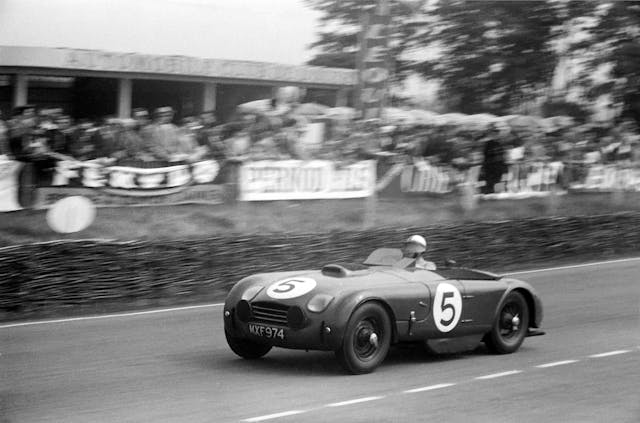
While Duntov’s attempts to drive for Allard were met with criticism and almost amounted to his outright dismissal from GM, Porsche had been impressed by his Allard drives. It extended to Duntov an offer to drive the silver cars from Stuttgart in 1955. The Porsche opportunity was more warmly received by GM management based on better timing, if nothing else. Cole felt that GM could learn a lot from Porsche when it came to air-cooled engines and rear swing-axles, as the company was experimenting with rear-engine, air-cooled cars long before the Corvair surfaced in 1960.
Porsche’s 1954 effort was to feature four 550 Spyders. The 550 was a simple yet elegant mid-engine machine that was to become best known as the car that James Dean drove to his death on a California highway in 1955.
Duntov and his codriver, Olivier Gendebien, were set to compete in one of the 550s. Duntov’s car was powered by a 1.1-liter flat four with twin spark plugs per cylinder, while the other team cars had 1.5-liter engines of the same configuration.
When one of the Porsche teams dropped out after only four laps, racing director Huschke von Hanstein decided to run the other three as conservatively as possible. However, after only an hour and a half, the Duntov/Gendebien 550 had lapped the remaining 1.1-liter cars at least once. Driving in a steady rhythm around the 8.3-mile circuit, Duntov learned that there were advantages to having less power. He was able to adopt a much smoother driving style compared what he had previously used in the Allard cars, with their torquey Cadillac and Chrysler engines. Later, some mechanical glitches and a huge rainstorm caused some unforeseen challenges, but Duntov managed to handily win his class.
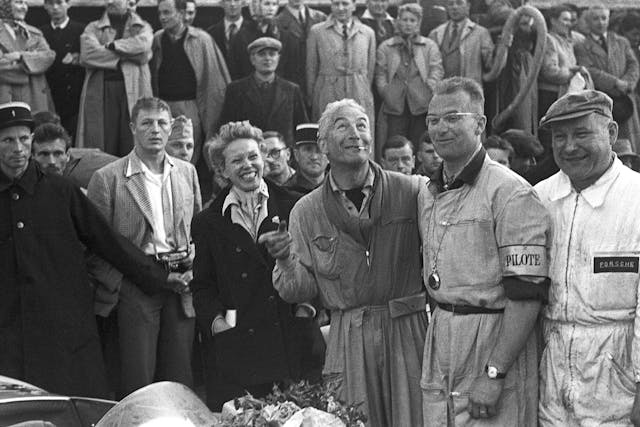
During the race, Duntov noticed that the handling of his car deteriorated as the amount of fuel in its tank decreased. The fuel tank was located over the front wheels, so with a full tank the front-to-rear weight distribution was 49/51. When empty, it was 45/55. Thinking he knew how to compensate for this phenomenon, Duntov told Ferry Porsche that he’d like to discuss the issue during his prearranged visit to the Porsche engineering facility at Zuffenhausen. Zora had an idea about a front stabilizer bar to help cure the oversteering problem.
Upon arrival, he began working with engineers Helmuth Bott and Leopold Schmidt. Porsche didn’t have a skid pad at the time, but Chevrolet, thanks to R&D head Maurice Olley, was already employing this technique. At Zuffenhausen, Duntov suggested they find an area wide enough to create a skid pad, and such a surface was found at nearby Molsheim airport. There, Duntov showed Bott a dozen tests that GM used to evaluate handling. Bott was impressed with the controlled conditions and measurability of Duntov’s methodology, and he tried different toe-in and rear-wheel camber settings as well as an antiroll torsion bar connecting the front wheels, an addition which also helped reduce oversteer.
Bott and Duntov stayed in close contact after Duntov returned to Detroit, and Duntov sent Porsche many sketches of his stabilizer bar design. After several months of development, Bott tested Duntov’s stabilizer bar design on a Porsche 356 road car, and the car showed marked improvement. Dr. Porsche then asked Bott to begin the same work with the new race car, and Duntov claimed he knocked 30 seconds off its lap time at the 14-mile Nürburgring track. “Like day and night,” Duntov said. “And 1955 Porsche, all Porsche, has a front stabilizer.”

While Porsche did not publicly advertise that a Chevrolet engineer had helped them solve a major problem, the German automaker privately gave Duntov credit, along with an unofficial job offer. Porsche even offered him a new 356 as a goodwill gesture. But Duntov politely declined. He already had what he really wanted—the visibility and respect of the entire Porsche organization.
There were other times when Duntov might have been persuaded to join Porsche had the right position been offered. “There was a time that he wanted to become chief technician for Porsche,” said Anatole Lapine, a friend and design staff contemporary of Duntov’s at GM who later went on to become design director at Porsche. “Ferry would have loved to have the guy on his team—lots of exchange.”
Even though Duntov elected to stay at GM, he corresponded with Bott, von Hanstein, and Ferry Porsche himself for many years afterward, becoming particularly close with von Hanstein. Duntov clearly thought that a bigger opportunity existed at General Motors, which rapidly became the largest corporation on the planet.

***
Epilogue: Duntov was invited back to drive the 1.1-liter 550 Spyder at Le Mans in 1955. He won his class again, but the event was marred by the greatest disaster in motorsport history when the Mercedes of Pierre Levegh came in contact with Lance Macklin’s Austin-Healey and veered into the stands, killing 80 people. Duntov and codriver August Veuillet went on to claim a bittersweet victory, but from that moment forward, all of Duntov’s driving exploits were behind the wheel of a Chevrolet.
***
Jerry Burton is the author of Zora Arkus-Duntov: The Legend Behind Corvette, Bentley Publishers, Cambridge, Mass., 2002.
***
Check out the Hagerty Media homepage so you don’t miss a single story, or better yet, bookmark it. To get our best stories delivered right to your inbox, subscribe to our newsletters.
The post When Porsche almost stole “Mr. Corvette” from GM appeared first on Hagerty Media.
]]>
The Corvette E-Ray is a hybrid, with a drivetrain that powers the front axle via an on-board battery and single electric drive motor. That has put it on the wrong side of the National Council of Corvette Clubs competition rulebook, rendering the E-Ray unwelcome at future track events organized by NCCC. The ban even extends to those who just want to spectate.
This news, reported on CorvetteForum.com, highlights the quickly-evolving landscape that the push for more battery-electric and hybrid powertrain vehicles has created. The specific rule that was amended in the 2022–23 competition rulebook is in section 1.8.1 number 14, and it outlines that any vehicles that possess a “lithium-type battery pack” are to be excluded from competition.

The NCCC’s Michigan website says there are “234 Clubs, in 16 regions, both east and west of the Mississippi … comprised of approximately 17,500 members. The Council’s competition database for 2023 includes mostly low-speed autocross events, but also various types of concours, rallies, cruises, and a handful of time trials.
The second part of this amendment even goes so far as to require that if these vehicles are driven to events, they can’t park with the other Corvettes:

NCCC’s rulebook may strike some as overly cautious or even a little extreme. As CorvetteForum.com points out, however, they’re not operating in a vacuum. Summit Point Motorsports Park in West Virginia recently put a “tactical pause” on hybrid and electric vehicles, “purely based on ensuring we establish an EMS response policy and procedure based on technical knowledge provided by the electric and hybrid electric vehicle industry community,” said the track’s Director of Motorsports Operations.

Many Corvette owners are also keenly aware of Chevrolet’s recent recall efforts regarding Bolt EV fires. Like the Bolt, the E-Ray uses lithium-ion pouch-type batteries sourced from LG Chem. Two years ago the National Transportation Safety Board released a statement regarding the risk posed to first responders handling an incident involving high-voltage lithium-ion batteries. The statement outlined not only the shock risk but also the thermal runaway potential that can lead to re-ignition of what was thought to be a controlled or extinguished fire.

Statistics confirm that gasoline cars actually experience a higher incident rate of fire than pure battery-electric vehicles, but hybrids fare the worst. Perhaps the bigger concern is that our present ability to control and extinguish a gasoline-fueled fire considerably exceeds that of battery fires; until the technology and equipment readily available to first responders catches up, organizers may further amend rules and regulations to fill the gap. We expect hybrid and EV proponents, not to mention E-Ray owners, may in the meantime feel that such policies represent a disproportionate reaction to the degree of risk.
The conditions of track use may subject the electric portion of the Corvette E-Ray’s drivetrain to rapid charging and discharging. Of course, it would be hard to believe that Chevrolet engineers did not account for this when crafting a 655-horsepower supercar that they expect some drivers to bring to the track. How the E-Ray behaves long-term and in the real world will become clearer when the first production examples reach customer hands later this year.

***
Check out the Hagerty Media homepage so you don’t miss a single story, or better yet, bookmark it. To get our best stories delivered right to your inbox, subscribe to our newsletters.
The post Corvette E-Ray banned from competition by NCCC appeared first on Hagerty Media.
]]>
VIN #001 Corvette E-Ray raises $1.1M for charity
Intake: At Barrett-Jackson’s Palm Beach Auction last weekend, Chevy auctioned off the first retail-production Corvette E-Ray. Rick Hendrick, chairman and CEO of the Hendrick Automotive Group and owner of the Hendrick Motorsports NASCAR Cup Series team, placed the winning bid of $1.1 million. All proceeds from the sale will be donated to an education nonprofit called DonorsChoose, which connects donors directly to teachers with classroom requests in low-income public schools.
Exhaust: Hendrick added the E-Ray to his stable of other VIN #001 Corvettes, including the first 2020 Corvette Stingray ($3M), the first C7 Corvette ZR1, and the first C8 Corvette Z06 ($3.7M), all of which were also auctioned off for charity. — Nathan Petroelje






First electric Porsche 911 built for California tech titan

Intake: Matt Rogers, cofounder of connected home technology firm Google Nest, is the first American to take delivery of an EV-converted Porsche 911 from British specialist Everrati. The “Signature” model features a carbon-fiber widebody kit finished in Mexico Blue with a Bridge of Weir dark blue leather interior. It was hand-built in the U.S.A. by Everrati’s partner, Aria Group, in Irvine, California. The car is powered by a 62-kWh battery pack which enables it to cover more than 200 miles on a full charge and take advantage of DC fast charging.
Exhaust: Rogers is so taken with his Everrati that he has invested in the British firm. “I have been a huge fan of the 964 since I was young,” he says. “And as we rapidly move into the age of electrification, I am thrilled to immortalize this iconic machine. It captures the zeitgeist perfectly, being sustainable and environmentally conscious while also keeping the character of the air-cooled Porsche era.” —Nik Berg
Hyundai fixes Elantra N’s only flaw
Intake: Irreverent and unusual, the Elantra N delivers delicious front-wheel-drive fun for $33K. Our only gripe? That angry-catfish face. Hyundai’s just fixed that, as this YouTube video above reveals. The “New Elantra N,” presumably the 2024 model, adds horizontal elements that calm and settle the visage: Viewed head-on, body-color blades anchor each corner. Each headlight ditches its boomerang shape and single-bulb element for an LED blade above twin rectangular elements. A light bar connects the two headlights, paralleling a body-color blade that divides the grille into top and bottom sections. The H badge on the nose is now matte black. The red-edged chin diffuser remains. There’s also a new 19-inch wheel design—if you can take your eyes off that now-harmonious face.
Exhaust: Well, we need one. Yesterday. —Grace Houghton







Lamborghini celebrates 60 with Huracán trio







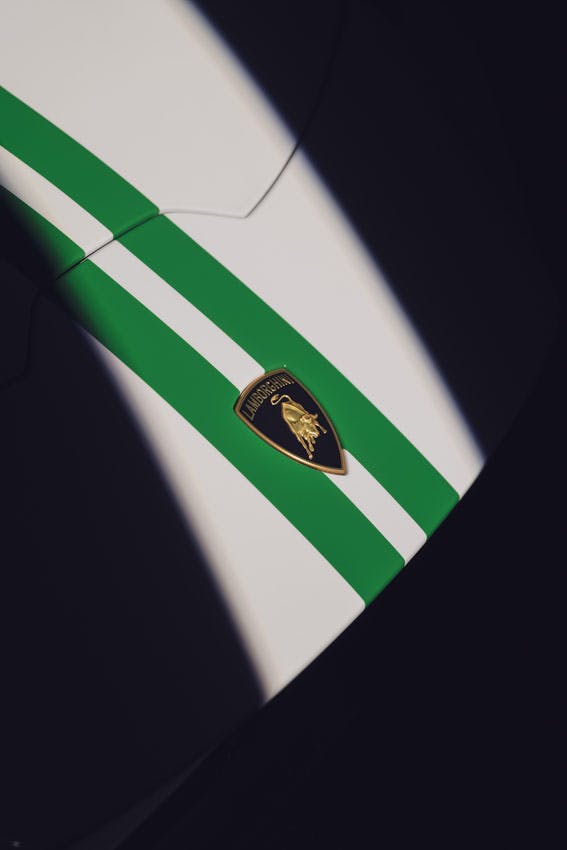





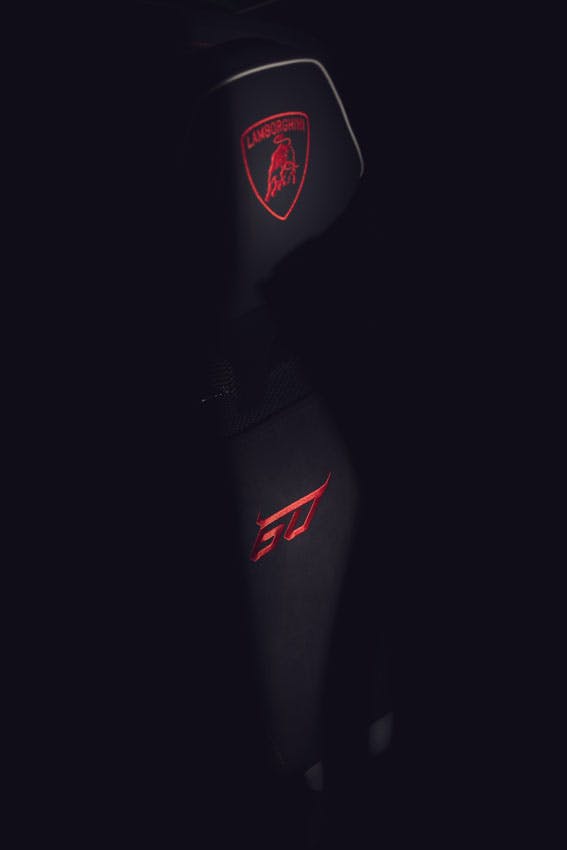


Intake: To celebrate the brand’s 60th birthday, Lamborghini has announced a trio of limited-run, special-edition versions of the three gnarliest Huracáns: the STO, Tecnica, and EVO Spyder. Just 60 units of each variant will be produced. The Huracán STO will get two special liveries—the first is a blue-on-blue exterior with a black, gray, and blue interior; the second livery features a gray and black exterior with a black, gray, and red interior. The Huracán Tecnica’s two liveries will incorporate the red, green, and white colors found in the Italian flag: The first is a black, gray, and red exterior with a black and red interior; the second is a white and green exterior with a green and black interior. Finally, the Huracán EVO Spyder’s two liveries: Blue and white exterior with a black, blue, and white interior, or a green and white exterior with a black, red, and white interior.
Each of the 60th Anniversary Edition Huracáns will get a “1 of 60” plate on the interior as well as a “60th” logo painted on the doors and embroidered in the seats. They will debut on April 21 at a special event as part of Milan Design Week.
Exhaust: Turning 60 is as good an excuse as any to don some fancy new colors. Expect these cars to be anything but subtle—just as Lamborghinis should be. — Nathan Petroelje
Polestar’s 4 kills rear window for backseat comfort




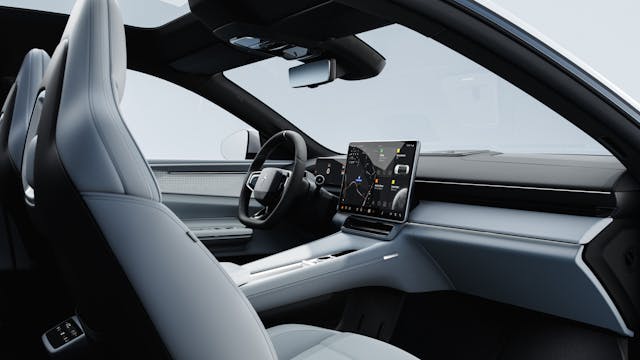
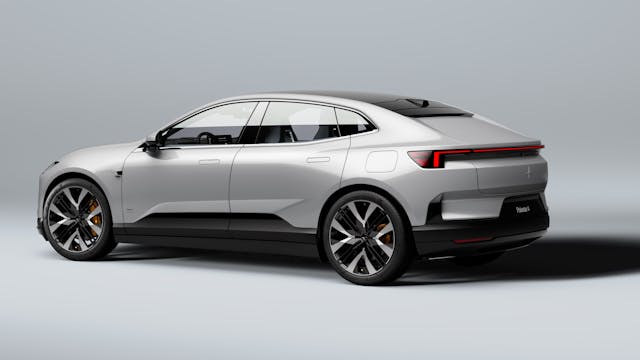
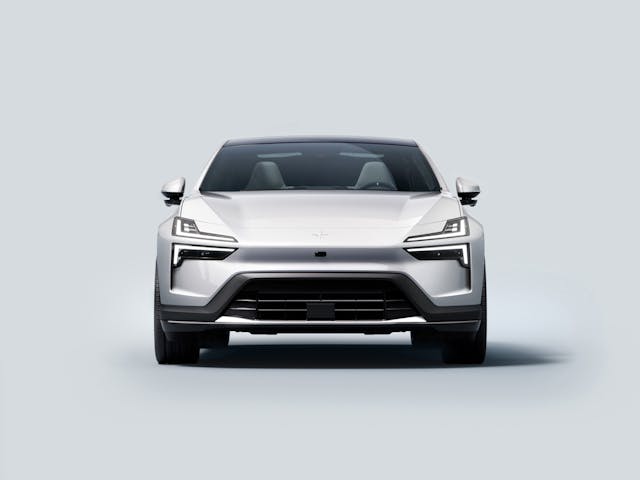


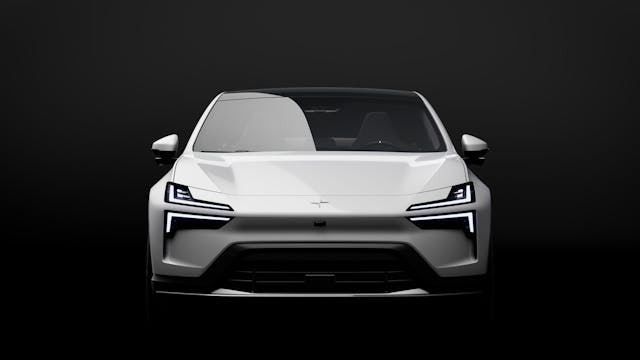
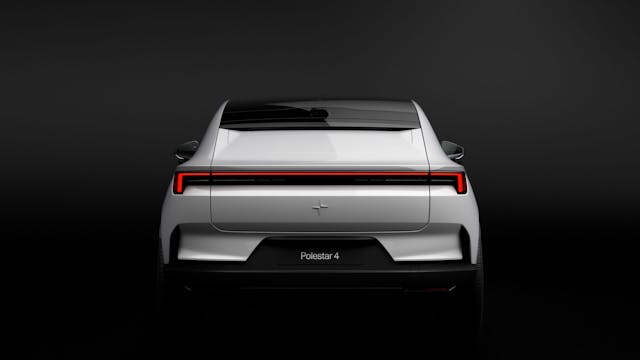




Intake: Polestar’s new electric SUV coupe, and the brand’s fourth model, debuted recently at the Shanghai auto show. The design throws coupe aerodynamics and SUV spaciousness into a blender, drawing inspiration from the brand’s Precept concept car by eliminating a rear window in favor of more room. The changes are all made possible by a camera-aided rearview “mirror” system. “Immersive” is the buzzy adjective that Polestar is pitching for the experience of rear-seated riders in the 4. The model is the company’s second SUV, coming in under the Polestar 3 in terms of size and price with a length of 4839 mm (190.5 inches), a width of 2139 mm (84.2 inches), and a height of 1544 mm (60.8 inches), costing $60,000. One notable way the 4 bests the 3 is on zip, jolting out 544 hp from a 102-kWh battery that gets 300-plus miles of range. China gets first dibs on the vehicle at the end of 2023, while North America will have it in 2024.
Exhaust: Polestar would like you to believe that by riding in the back of the rear windowless 4, you will feel cozier than a swanky cave rental on Airbnb, but reality says that the jury is out. Only time and objective testing from the masses will determine whether this SUV design swing will be a hit or a miss for electric luxury. — Bryan Gerould
2024 Lincoln Nautilus gets massive screen, new sheetmetal














Intake: Lincoln has unveiled the 2024 Nautilus, a heavily reworked version of its midsize luxury SUV. The biggest news is inside, where a massive screen spans the entire width of the dashboard. Combined with new ambient lighting and three new scent cartridges housed in the center console, Lincoln hopes to make your time in the Nautilus as refreshing as possible. A Revel Ultima 28-speaker audio system will bathe the cabin with all types of auditory indulgence.
While on the go, Lincoln’s BlueCruise 1.2 hands-free driving assist stands ready to handle highway jaunts. The outside features new sheetmetal and new LED headlamps and taillamps. Power will come from either a 2.0-liter turbocharged four-cylinder, good for 250 hp and 275 lb-ft of torque, or a hybrid setup that employs the same engine plus a 100-kW electric motor for a total system output of 310 hp. The former engine will be mated to an eight-speed automatic, the latter to a CVT. The adaptive suspension will smooth road imperfections. The 2024 Nautilus will arrive in North American showrooms in early 2024. No word on pricing yet.
Exhaust: The Explorer-based Nautilus needs to make some waves for Lincoln. Brand sales have been declining for the past four years as the portfolio of Ford’s luxury brand grows stagnant and rivals increasingly focus on EVs. We haven’t heard anything from Lincoln about an all-electric offering yet—which is concerning, especially since cross-town rival Cadillac already has two electric offerings in the pipeline. — Nathan Petroelje
***
Check out the Hagerty Media homepage so you don’t miss a single story, or better yet, bookmark it. To get our best stories delivered right to your inbox, subscribe to our newsletters.
The post $1.1M for Corvette E-Ray VIN #001, Elantra N fixed, Lambo primps aging bulls appeared first on Hagerty Media.
]]>
“It was a great sale for gamblers, and some of them could’ve come up aces.” So said Dave Kinney, publisher of the Hagerty Price Guide, of Gooding’s Estate of Mark Smith auction. He added, however, that other bidders may have bought into some cars that needed serious reconditioning before they’d be back on the road.
Which brings us to this 1963 Chevrolet Corvette Roadster, bought for $52,640, including fees. Did the buyer nab a winning hand with this nicely appointed second-gen Vette?

Let’s see how the deck stacks up. 1963 was a good year for Corvette. Chevy kicked off its sports car’s second generation with a design now considered to be among the best to come off an American assembly line. But that was the coupe with its famous split window; ’63 convertibles, while attractive, have never carried the same panache.
Despite that, this 54,000-mile convertible example acquits itself well with some attractive options. Equipped with air conditioning, a hardtop, and the 340-hp L76 327 cubic-inch engine—second only to the 360-hp Fuelie 327 that year—the Smith Corvette was an attractive configuration. From the photographs, the paint looked good from afar but showed its age up close. The interior appeared worn but serviceable, and the engine bay featured a mix of fresh-looking bits and items that could use some reconditioning. The real wildcard, however, was that the car’s mechanical condition, like that of many other vehicles in the auction, was unknown.



Values of condition #1 (concours-ready) L76 convertibles are up just 11 percent since 2018, to $136,000, but the condition #4 (Fair) values have been on the move, up 47 percent to $53,500. Factor in another $12,500 for this car’s optional A/C (likely dealer installed) and $3700 for the hardtop, and this car could fetch $69,700 if it were in #4 condition. It appears the sale price baked in at least some of the unknowns.
This car is a good reminder that the Corvette market has long been big enough to serve different enthusiast groups. Condition #1 values for a best-of-the-best 1963 Split-Window with a fuel-injected 327 cubic-inch engine is up 42 percent since 2018 to $327,000, while the condition #4 value is up 18 percent to $111,000.
Compare that to the values of the L76 convertible (and the knowledge that there are drivetrain options out there with even more approachable values), and it appears that the collectors are pursuing the perfect fuelie Split-Windows, while the drivers/home restorers are going for the convertibles.
We hope this one finds its way back to the road for some top-down fun.

***
Check out the Hagerty Media homepage so you don’t miss a single story, or better yet, bookmark it. To get our best stories delivered right to your inbox, subscribe to our newsletters.
Via Insider
The post How much of a gamble is this barn-stored ’63 Corvette? appeared first on Hagerty Media.
]]>
Few ideas are genuinely new in the car industry by the time they reach production. Take Chevrolet’s much vaunted eighth-gen Corvette (C8), which was unveiled just three years ago and arguably created more media frenzy than any other Vette before it. The reason?
After nearly 70 years of front-engine, rear-drive evolution, Chevrolet had installed the car’s V-8 engine aft of the driver. But the idea was not new to Chevrolet; the company’s mid-engine ambitions had been brewing for half a century.
In 1968, Zora Arkus-Duntov, aka Mr. Corvette, wanted to take the model in a completely new direction. His interest in mid-engine configurations had started more than a decade before when, as Chevrolet’s director for high performance, he recognized that the best way to keep drivers cool in endurance races was to mount the engine behind them.
With the C3 Corvette launched in 1967, Arkus-Duntov built two prototypes—named XP-882 (for “experimental project”)—as an early vision of the C4. Radical in every way, the low-slung cars were 8 inches shorter and 5.8 inches wider than the C3, while shaving 700 pounds from the production car’s weight.
Though Arkus-Duntov had floated the mid-engine idea to Chevrolet years before with the CERV and Astro concepts, none of those vehicles flaunted the Corvette’s crossed flags. 1970’s XP concepts changed that. Still recognizable as Corvettes, each prototype’s V-8 engine was mounted transversely between the cockpit and rear axle. If it reached production, the recipe would transform not only the Corvette’s chassis dynamics but also how the car would be perceived by prospective buyers.
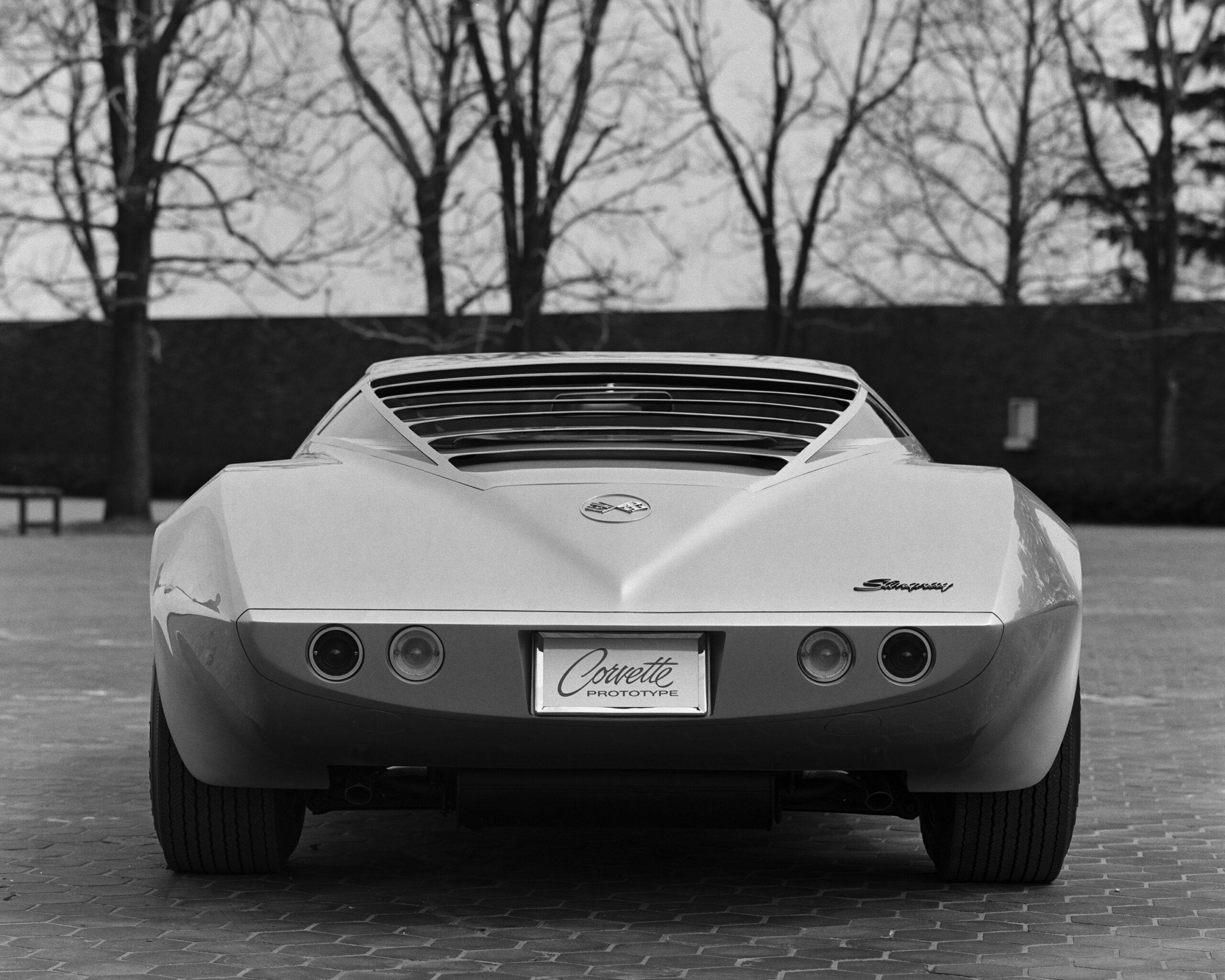
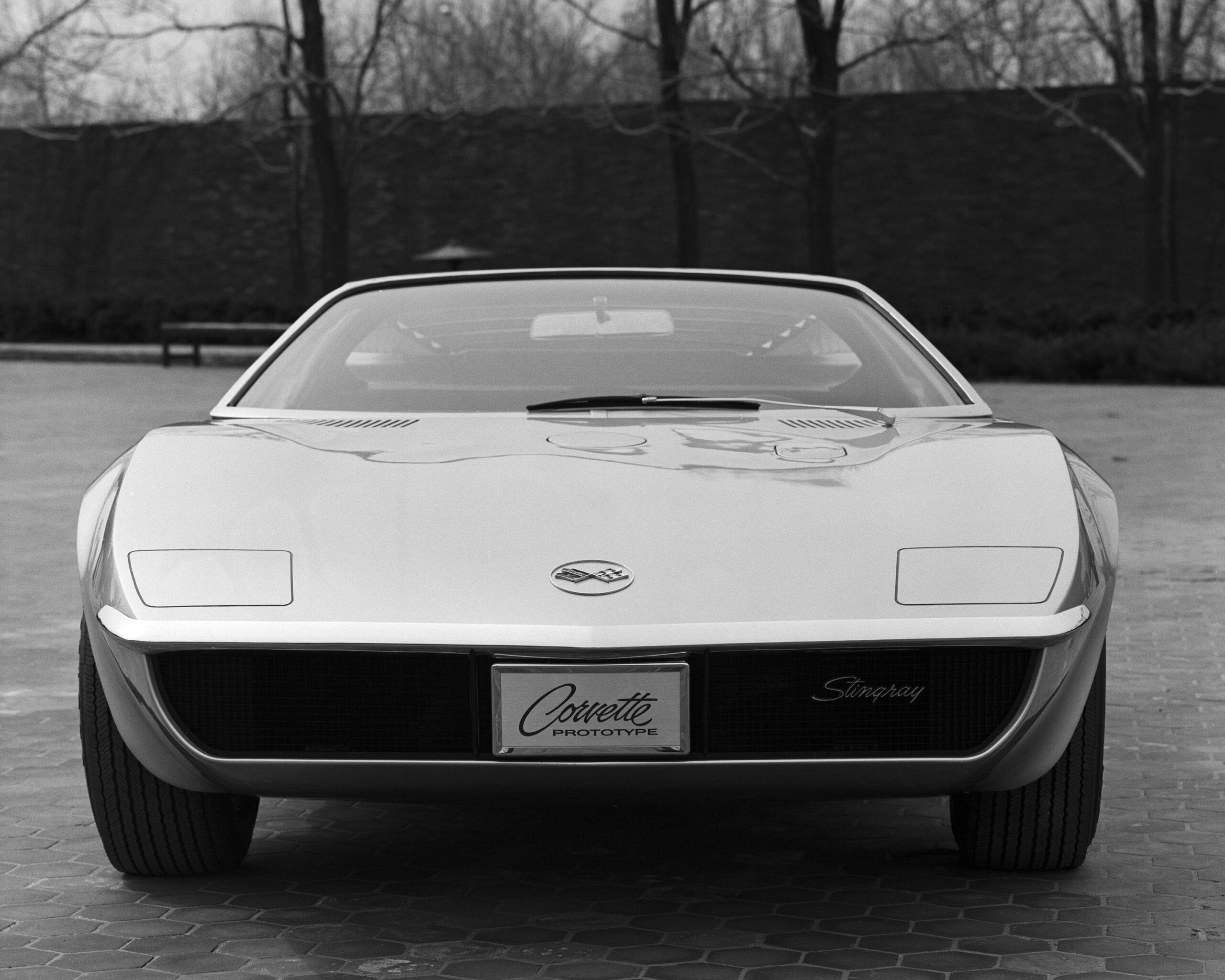

Maybe it was too much, too soon. John Z. DeLorean, Chevy’s general manager, rapidly canned the project on grounds of cost and complexity, but then made a remarkable volte-face after Ford announced its new association with De Tomaso and started to sell mid-engine Panteras in its U.S. dealerships. As a result, one Corvette prototype was hastily prepared for the 1970 New York Motor Show, where it received broad acclaim, with Motor Trend noting, “Chevrolet roared out of the sun with the throttle wide open and the wind shrieking, and watched their tracers stitch into the shining sides of the new De Tomaso.”
Buoyed by the bonhomie towards a potential mid-engine C4, Chevrolet went a stage further. The company had been busy with a Wankel rotary-engine program, the license for which it had recently paid $50 million. Taking XP-882 as a base platform, Chevrolet grafted together two twin-rotor motors to create a highly advanced, 420-horsepower engine. Renamed XP-895, the prototype now wore more rounded bodywork, flared wheel-arches, and NACA ducts in its bonnet.
Problem was that, being made from steel (versus fiberglass, like a production Corvette’s body), it weighed in at 3500 pounds, so the body was reformed in aluminum, giving a 40 percent weight reduction but adding massively to the would-be production costs.
All this came to naught when a combination of ever-tightening U.S. emissions regulations and an impending global fuel crisis impacted demand for performance cars. It also became clear that the C3’s production life was likely to be extended, despite the fact that it its performance had been well and truly neutered, at its worst delivering a paltry 165 hp from a 350-cubic-inch (5.7-liter) engine.



To top it all, the one man whose mid-engine vision for the Corvette had never waned—Zora Arkus-Duntov—finally threw in the towel, retiring from General Motors in 1975, frustrated that no real progress had been made in producing the concept to which he’d committed so much.
And the story may well have ended there, had it not been for yet another twist to the tale.
Barely a year after Arkus-Duntov left, mid-engine sports cars started to appear everywhere: Ferrari introduced the Dino, 308 GTB, and Boxer; Fiat was making hay with the X1/9; and Lamborghini had a new poster boy with its Countach.
GM’s design chief, Bill Mitchell, previously a mid-engine sceptic, couldn’t avoid the obvious trend and ordered a re-think of XP-895. The emissions-hungry rotary unit was pulled and replaced by a good ’ol 400-cubic-inch (6.6 liter) V-8, and the concept toured the show circuit as the Aerovette, with GM hinting that this could indeed be the new Corvette C4.
But once again fate had other plans. Arkus-Duntov’s replacement as the Corvette’s chief engineer, Dave McLellan, believed that such a major overhaul of the Vette’s basic design principles was a step too far. The cost of re-engineering the platform would have been considerable, and there was genuine concern about alienating traditional Vette buyers, who were becoming older and more focused on comfort. (Geez, they were even ordering automatic gearboxes on the C3!)
Fast forward nearly 40 years, however, and those buyers were dying out. Successive Corvette series (C4–C7) had successfully carried the torch for the brand, but by 2020 a new buyer was in the frame—someone younger and more susceptible to the charms of European sports cars, with their inherent sophistication and mid-engine configurations.
Small wonder that Chevrolet, with its C8, finally bit the bullet and put the cart before the horse.
***
Check out the Hagerty Media homepage so you don’t miss a single story, or better yet, bookmark it. To get our best stories delivered right to your inbox, subscribe to our newsletters.
Via Hagerty UK
The post Chevrolet took 52 years to make the Corvette mid-engine appeared first on Hagerty Media.
]]>
Throughout the generations, Chevy’s Corvette has built a name for itself punching well above its price tag to spoil the party for more exotic metal. The new mid-engine C8 Corvette is the best foil yet to the European performance party. The new Z06, with its flared body, sonorous flat-plane-crank V-8, and track-decimating performance, feels like the closest approximation of an American Ferrari yet. Meanwhile, the all-wheel-drive, hybrid Corvette E-Ray could, if you squint, come off as an American take on much of what Lamborghini stands for these days. But how closely does Chevy’s mid-engine monster hew to those Italian exotics, really?
You can probably guess where this is going; time to bust out the green flags and the stopwatches.

The latest episode of Jason Cammisa’s Ultimate Drag Race Replay features a world-first in-depth look at just how impressive the new Chevrolet Corvette E-Ray is in a quarter-mile shootout. We’ll save the hard results for the video, but we had a chance to speak with Cammisa about some of the discoveries that surface while filming the episode.
Rather than focus on how the Corvettes stacked up against a Ferrari F8 Spyder and Lamborghini Huracán EVO RWD Spyder (we’ll let the tape answer those questions), our discussion with Cammisa centered around how differently the two variations of the C8 Corvette go about their rapid antics.
A few quick stats to kick it off: The Corvette Z06 makes 670 horsepower from its 5.5-liter LT6 engine. That engine has to push 3670 pounds using just the rear wheels. The E-Ray, on the other hand, makes a combined 655 hp between the 495-hp LT2 pushrod V-8 from the regular C8 Stingray and a 160-hp electric motor placed on the front axle. The E-Ray tips the scales at 3924 pounds, but it employs all four wheels to get that mass moving.
Despite being nearly 250 pounds heavier and 15 ponies in the hole, can the E-Ray hold its own?

Cammisa touches on this a bit in the episode, but one of his biggest discoveries was just how different the E-Ray and the Z06 behave from the jump. “The Z06 is a bit of a handful off the line,” he admits. “To get an optimal launch in the Z06, you have to dial in launch RPM and tire slippage for whatever surface you’re on. The E-Ray, on the other hand, has virtually no variance between launches; it’s just dead-straight, wicked fast, and alarmingly consistent. Just put your foot on the brakes, hit launch control, and send it.”
On our first ride-along in the car earlier this year, we were stunned by how forceful the E-Ray accelerated. Still, some were disappointed when they learned that the electric motor up front was only good for 160 hp, figuring that more power would have resulted in an even quicker Vette. When we asked Cammisa about the output of the E-Ray’s electric motor, he had a different opinion:
“Trust me, 160 horsepower is all it needs here. When you launch the E-Ray, there’s so much weight transfer to the rear that you don’t have that much grip on the front tires. It’s already putting 495 horsepower to the rear tires, and even that 160 horsepower going to the front wheels is basically maxed out. You could put a 200-horse motor up there, or a 300-horse motor up there, but it wouldn’t really gain much from a 0–60 standpoint.”
It’s also worth remembering that there are gnarlier hybrid C8s in the pipeline. “Once we see a hybrid C8 with the Z06 motor in the rear, or even eventually a twin-turbo motor in the rear, we’ll likely see the output of that electric motor increase,” Cammisa says. “Or maybe we’ll even see two electric motors up front with torque vectoring. Putting the engine in the rear means that the sky’s the limit when it comes to packaging driveline components.”

We concluded our chat by asking Cammisa a simple question: “Who’s going to love the E-Ray?”
“You’ll love the E-Ray if you drive it around town,” he says. “To me, [the E-Ray] is a Stingray-plus-plus, without any minuses. It’s also incredibly consistent off the line, and I think drag racers will come to appreciate that part of it.”
Here’s another thing they’ll appreciate: During the filming of the show, the E-Ray was able to completely recharge its tiny 1.9-kWh battery using just the kinetic energy recovered from the end of a hard quarter-mile run and the added distance covered getting back to the start line. Sure, the E-Ray was placed in an ultra-aggressive, energy-recovery mode to achieve that, but imagine being able to unleash every last drop of that instantaneous electric torque each time you made a pass.
Be sure to watch the entire video to see just how impressive the new E-Ray is in a quarter-mile drag race.
***
Check out the Hagerty Media homepage so you don’t miss a single story, or better yet, bookmark it. To get our best stories delivered right to your inbox, subscribe to our newsletters.
The post Exclusive: Just how fast is the Corvette E-Ray? appeared first on Hagerty Media.
]]>
I didn’t really grow up around classic cars, but I have always admired the combination of design and history that comes with them.
My first love of cars came during high school, when I got into Audis after my father purchased a new A4. The experience of all-wheel drive plus a turbo got me so excited about driving, and I’ve owned Audis ever since, including two S4s, an RS4, and an RS7. They’ve all been engaging driving experiences, but something was missing for me when I got behind the wheel.
Fast-forward to 2019, when my family and I purchased our first home. I finally had a garage, with more space than I needed for daily drivers. Thinking of how I might fill a spot, I started browsing auctions and found a 1958 Auto Union 1000 Sonderklasse for sale from a private museum in California that fall.
I knew that my beloved Audi brand had derived from Auto Union and was aware of its prewar racing pedigree, but I didn’t know the company had built and sold street cars. Through research into the postwar history of Auto Union, I found that the marque was sold in the U.S. in limited quantities through Studebaker dealers; Daimler-Benz, which owned Auto Union at the time, had an agreement with Studebaker-Packard to sell its cars.



I quickly fell in love with the design and obscure history of the 1000, bid on it, and won. I’d never thought of owning a three-cylinder two-stroke before, nor about owning a car with 44 horsepower. However, when it arrived in New York several days later, I realized it had a list of problems, having sat for many years in the museum. Game on.
The biggest challenge was the clutch: This example is equipped with a Saxomat automated manual transmission, which was a rare option. Sourcing parts became a fun challenge, and to date, I’ve built a list of sources from Germany, South Africa, Argentina, and other countries.
Good thing, because my passion for classics had just taken off.
I picked up my second Auto Union, a 1960 1000SP with a tuned two-stroke and a column-mounted four-speed, on Bring a Trailer in March 2020. I loved the look of the pillarless coupe 1000 when I first saw it, but upon laying my eyes on a 1000SP for the first time, my adoration was at another level.

This particular example is one of 5000 coupes built over a seven-year production run, which ended when Auto Union was sold to Volkswagen in 1964. It was delivered in late 1959 to Baden-Baden, Germany, reportedly to a race car driver named Eckhard Schimpf, who raced it at the Nürburgring in ’60 and ’62. It was driven at races around Europe for nearly two decades before being crashed at some point in the late 1970s.
It was imported to Canada, then brought to the U.S. in 2002 and traded in at Sewickley Audi in Pittsburgh on a new A6 in 2007. The dealership displayed it for a while before putting it into storage for more than a decade, and it finally made its way to my garage as a pandemic project.



The SP needed a full restoration. As with the 1000, finding parts and learning its quirks has been an endeavor, but I’ve involved some great local shops (Bob, Leo, and the crew at Briarcliff Classic are magicians!). In addition to its racing provenance, the 1000SP became an award winner at the Radnor Hunt Concours and was displayed at The Amelia this March.
I love finding cars that people don’t see often. I also look for something in a car’s history or design that jumps out at me as unique. The Pennant Blue 1954 Corvette I purchased in 2021 fit the bill perfectly.
The beauty of these cars is apparent from any angle, but this one stood out because it had been owned by a General Motors executive in Germany for 30 years. Plus, it was fully restored and ready to enjoy.
The highlight of my first year of ownership of the car was receiving a Top Flight Award from the National Corvette Restorers Society, meaning that close to 100 percent of the car is as it was when it left the St. Louis factory.
It’s slow and handles like a tank, but it is one of the most beautifully designed American cars ever to have been produced. And it totally got me to go outside of my Audi bubble.





Even further outside that bubble is the 1964 GAZ 69M, a former Soviet military radio-communications vehicle that I acquired last summer. It is fully restored as well, with a flathead four-cylinder mated to a three-speed, and it will drive over anything. It’s super fun. It sits up high. It’s loud. My kids love it.
I am fortunate to have a wife and two young sons who have gotten into classic cars almost as much as I have, with my boys often helping out in the garage. I worry that most kids in their generation won’t learn to drive manual transmissions—or come to appreciate these rolling works of art. They have the bug, though, and it keeps them off screens and hopefully will continue to spark a similar passion within them.

Which brings me to my latest acquisition—a 1947 Lincoln Club Coupe with the remarkable flathead V-12 and a column-mounted three-speed. It’s a stunning design with room for all four of us. It sat for a few years, so I’m still working through some challenges, but it has already been a load of fun.
As I’ve started building my collection, my passion has grown with each new vehicle and piece of history I learn about them. You can feel the soul of a classic car when you drive it, something modern cars simply can’t deliver. Assembling these rolling works of art over the past three years has been a joyous responsibility for me. More important, it has given me the opportunity to share this passion with others, especially my boys as they grow up.


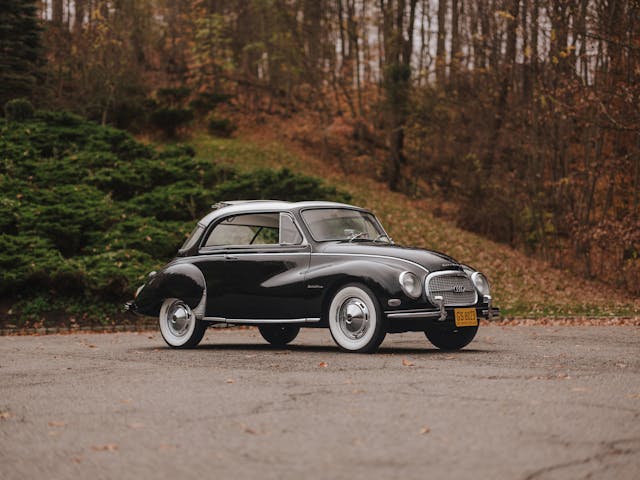





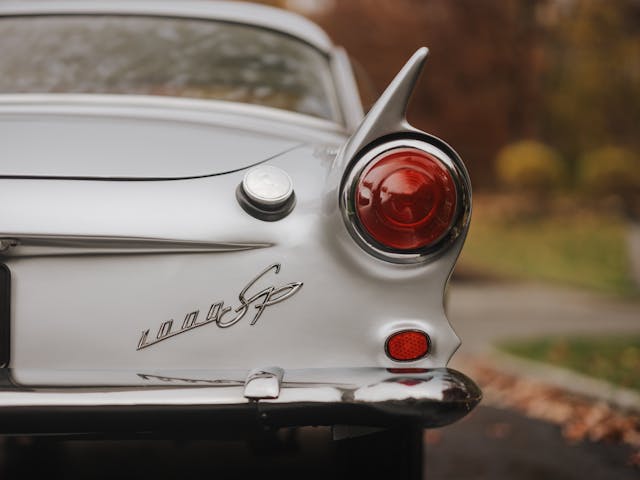




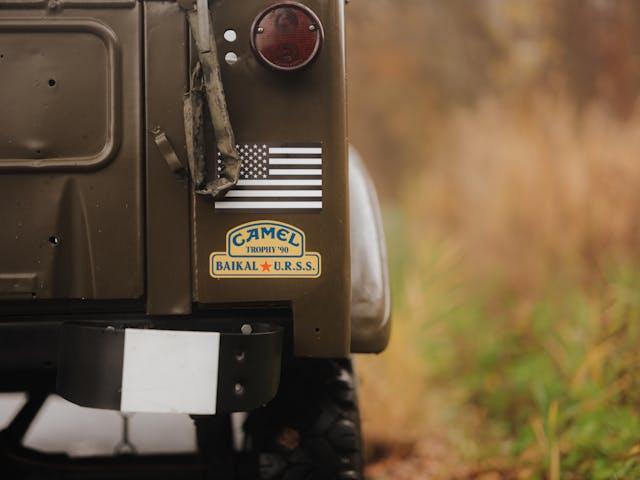

***
Check out the Hagerty Media homepage so you don’t miss a single story, or better yet, bookmark it. To get our best stories delivered right to your inbox, subscribe to our newsletters.
The post How I found what modern cars are missing appeared first on Hagerty Media.
]]>
Want a better understanding of what’s driving collector-car values? Sign up for the Hagerty Insider newsletter.
You feel it right away. Start the new eighth-generation Corvette Z06 for the first time, and that exhaust bark instantly lights off those chemicals in your brain that make you giddy, hyper-aware, and maybe a little nervous all at once. This is no anodyne appliance that silently whisks you to warp speed with all the personality of a pallet of lithium-ion batteries. You’re in for a sensory treat—a little drama to go with your power and grip. But what’s all that personality worth, and would you buy it without a safety net?
That first question—what’s it worth—was initially answered when Chevy released the MSRP on the Z06 last summer. The C8Z starts at $106,695, with convertibles coming in at $7500 more, and ticking every single box could get you north of $160,000. That’s serious coin, but the market had a different, more pronounced response. Dealers across the country have seemingly raced to one-up each other with who could offer the most expensive Z06, with many well above the quarter million mark.
Of course, the over-sticker phenomenon is nothing new for car enthusiasts in the 2020s, nor is it limited to dealers. Though big sales have surely occurred on the private market already, this is the first privately-owned C8 Z06 to come up on Bring a Trailer (the first C8 Z06 to show up on BaT did so seven days prior: a dealer-offered 70th-Anniversary model that was bid up to $222,000 but failed to meet reserve). Chevy has taken steps to mitigate flips of their top-dog Corvette (more on that in a second), but market demand is strong, and this Black 2LZ-trimmed convertible sold for a cool $232,000 including fees, a full $103,820 over MSRP.

How much Z06 does the new buyer get for that princely sum? Well, this one offers solid street-car specs. The 2LZ package lands you in the middle of the Z06’s trim offerings, securing nice-to-have options like the performance data recorder, an upgraded stereo and navigation, and blind spot/rear cross traffic monitoring (legitimately helpful in such a wide car with a tight rearward field of vision). The fact that it’s a convertible amplifies the enjoyment of that screaming 5.5-liter flat-plane crank V-8, though you don’t get to see it like in the coupe. The GT2 seats are an attractive and comfortable add on—they hold you well but aren’t overly track-oriented. Conspicuously absent are the Z07 package or individual aero bits, along with the carbon-ceramic brakes, but truth be told, none of those options are necessary if you aren’t tracking your Z06.

It’s at this point that the Z06 and its value (in both senses of the word—what it brings to the table relative to others, and the massive price) beg for a bit of context. The Corvette’s long been been a model that punches well above its class and MSRP, and the new Z06 has continued that tradition with a shelf full of awards and accolades.
It also doesn’t hurt that the Z06 laps comfortably quicker than that perennial track favorite, the Porsche 911 GT3, a rare car that’s long commanded mark-ups. Given the timing of the Z06’s introduction, its own relative rarity, and its tremendous bona fides, the market has pushed the Z06 beyond the traditional Corvette value proposition. Even with the premium, the Z is still more affordable than its competition, but at $200,000-plus, most enthusiasts are priced out.

But let’s say you do have the money and you don’t want to wait to order a Z06. This is where the second question—the one about the safety net—comes in. A brand-new one owned by an individual, not a dealer, pops up on your favorite auction site, and it’s exactly how you’d order it. There’s a catch, though—GM voids the warranty if the car is sold within six months of the original purchase, and the seller bought the car new two months ago. Do you try your hand? Seventeen bidders did in this instance.
Yes, design elements and components of that high-tech V-8 were track-tested within an inch of their lives in IMSA’s grueling endurance races, but two early engine failures have been publicized, and Chevy honored the warranty in both instances. Those aside, there’s a lot of tech in any new car, much less one designed with the Z06’s capabilities, and nothing’s fool-proof. Heck, something as minor as a window switch can break. If you’re able to spend $200K on a car, these potential pain points might be of lesser consequence, but similarly-priced cars with a warranty are out there at dealers. The decision comes down to whether you prefer additional peace of mind or access to the right car at the right time.
It’s not just buyers who need to weigh their options: GM’s policy impacts sellers, too. The General’s carrot-stick approach enables those who keep the car for six months to receive an award of 500,000 My Chevy Rewards Points (a $5,000 value), while those who sell their Z06 within that same window will be ineligible to place vehicle reservations or place a sold order with a dealer for certain high-demand models.

This adds up to yet another twist: market forces and GM’s efforts to reduce flipping have created a thread-the-needle scenario, the outcome of which remains undefined. Seller Kenraabe1 indicated in the comments that he was “willing to work with the purchasing party on a deal to delay title transfer for (4) months which would take care of the [warranty-voiding] problem.” Is that a viable solution, or is the Bring a Trailer transaction language enough for GM to claim that the vehicle wasn’t retained for the full six months? Given that this is new ground for all parties and the auction just ended, it’s unsurprising that a member of the Corvette team had no comment when I posed the question.
While a fresh challenge for GM, other companies have ventured into this territory before. Ferrari is perhaps the most famous, with a decades-old set of eligibility requirements and policies that stipulated buyers couldn’t sell their car for a period of time. It wasn’t long before owners came up with an end-around by placing their car in the name of a newly-created LLC and simply selling the LLC, including its only asset, the car. Ford had its own requirements for buyers of the latest generation of their limited-run GT, and settled a suit with professional wrestler John Cena in 2018 over his early sale of one.
What’s all this mean? If you’re a C8 Corvette Z06 buyer or seller, you have some decisions to make before you pull the trigger. More broadly, though, the market’s rewarding Chevy’s best Corvette execution to date with mark-ups previously reserved for European brands. That’s great for Corvette’s overall image, but it’s also causing some of the model’s faithful to be left behind.






***
Check out the Hagerty Media homepage so you don’t miss a single story, or better yet, bookmark it. To get our best stories delivered right to your inbox, subscribe to our newsletters.
Via Hagerty Insider
The post How much over sticker would you pay for a new Corvette Z06 … with no warranty? appeared first on Hagerty Media.
]]>

Let’s not kid ourselves: Being a car enthusiast can be a pricey endeavor. Like any hobby that involves expensive gear and gadgets (golf, photography, skiing, boating …), keeping a fun weekend car is often dauntingly expensive.
We’ve found 12 vehicles made in 1993 or later, each of which costs less than 20 grand in running and driving condition. Each has plenty of creature comforts, and some have real handling prowess. All are vehicles that you can enjoy owning, tinkering with, and possibly showing off at your local car show or caffeine-adjacent cruise-in.
We know that $20,000 is not cheap, but we’ve selected vehicles that are well-preserved for their age, with values based on the Hagerty Price Guide’s 1-to-4 vehicle-condition rating system. (For the full breakdown of our scale, click here.) Vehicles in #3, or Good, condition are very well maintained and ready to hit the road, though they will have cosmetic flaws visible to the naked eye. #2 condition, or Excellent, vehicles drive and present like new.
Let’s get started.
2006 Dodge Charger SRT8

#3 (Good) value: $16,900
It sure doesn’t feel like Dodge returned to Hemi-powered muscle cars 17 years ago, but here we are. The 6.1-liter Hemi in the early Chargers is down a bit on power compared to the current crop of 6.4-liter beasts, although the 425-hp output and snarling exhaust are enough to make you forget the comparison rather quickly. Also, the tall, aluminum intake manifold on the 6.1-liter easily makes it the best-looking third-gen Hemi to ever go into a Charger, so pop that hood every chance you get.
The earlier Charger models have just the right amount of brawny flair to make them stand out in a sea of FWD sedans. They’ve got to be some of the best buys in muscle sedans today.
1995 Subaru SVX L AWD

#2 (Excellent) value: $16,600
There were many strange and interesting vehicles to come out of Japan in the ’90s, so we’ll forgive you if you’ve forgotten—or never even knew—about the Subaru SVX.
The two-door, four-seat grand tourer was designed by Giorgetto Giugiaro, who also penned the DeLorean DMC-12 and original Golf. The SVX has a striking greenhouse dominated by curving side windows that necessitated a rather unique solution to allow the vertical portions to roll down. We drove one of these quirky coupes and enjoyed the smooth, 240-hp 3.3-liter flat-six and the stares that the rare coupe drew from confused onlookers.
Considering the SVX was a low-volume car and the sole recipient of its flat-six engine, this car might be expensive to maintain long-term. On the other hand, it does turn a lot of heads for 16 grand.
1993 Ford Taurus SHO

#2 (Excellent) value: $10,300
Who doesn’t love a sleeper? Ford pumped out hundreds of thousands of boring, reliable Tauruses every year, making it the most popular car in America from 1992–96. The majority of them were equipped with an automatic transmission and a 140-hp, pushrod, 3.0-liter Vulcan V-6. Optional on sedans and standard on the heavier wagon, the 3.8-liter Essex V-6 brought additional torque (but no additional power) thanks to increased displacement.
The SHO (Super High Output) model, on the other hand, featured a DOHC version of the 3.0-liter with an improved block and an all-new top end developed by Yamaha. Doubling the number of valves meant the V-6 could breathe a whole lot better, allowing it to rev to a peak of 220 hp at 6200 rpm. The additional 80 horsepower completely transformed the SHO and enabled it to sprint from 0 to 60 mph in under seven seconds when equipped with the manual transmission. In 1993, an automatic was optional for the first time and nearly 3 out of 4 buyers preferred it, with contemporary reviews from Motor Trend praising the automatic version’s smoothness.
Whichever SHO you pick, five-speed or auto, expect it to fly under the radar and bring a smile to your face.
1999 Ford Mustang Cobra SVT

#3 (Good) value: $16,000
The Ford Mustang GT has been a great performance bargain for years. For that reason, it’s easy to forget that, in the early days of the Modular V-8, the standard GT wasn’t terribly exciting. With its “Performance Improved” two-valve cylinder head, the 1999 Mustang boasted 260 hp, an increase from 225 hp the year before.
There was clearly more in Ford’s Modular V-8, and the 1999 SVT Cobra unlocked it thanks to DOHC, four-valve heads. The massive heads and imposing intake, topped with a coiled cobra, looked great under the hood, but owners were disappointed with the model’s performance. Ford recalled the cars and replaced the intake manifold, stating that the initial run of manifolds had been miscast and didn’t flow as intended. The factory made good with a new intake, cat-back exhaust, and a new tune, making the 320-hp 4.6-liter the most powerful naturally aspirated Mod motor to go into a factory Mustang until the fabulous Coyote debuted for 2012.
We’ve got good news for fans of convertibles: The droptop Cobra is even more affordable, with a #3 (Good) condition value of $14,900.
2000 Chevrolet Corvette

#3 (Good) value: $17,400
Corvette made several big moves when the fifth generation (C5) launched for the 1997 model year. Not only did chassis and layout improve by leaps and bounds, with the switch to a torque tube and rear-mounted transmission, but the fifth gen ushered in the LS1 V-8. This was the first application of the third-generation small-block, the only engine that had any chance at dethroning the original Chevy small-block as the go-to V-8 for the average Joe’s engine swap.
Low-mileage, well-preserved Z06s of this generation still provide excellent value, but enthusiasts have known about them for quite a while. It’s no secret that this 2023 Bull Market pick is a fantastic track machine. However, the base C5 still offers plenty of road-hugging grip, and it has a hatch that makes it a practical grand touring machine. (The trunk is pretty well known, at this point, for its ability to swallow two golf bags.) Plus, if you are so inclined, the Z06 suspension goodies are a bolt-on affair. Prices have softened a bit on the entry-level C5s, with values down 11 percent since October of 2022.
1991 Honda Civic Si

#2 (Excellent) value: $15,600
With a standard manual transmission and manual steering, the original Civic Si was a pure, mechanical joy. Later models added more finesse, but even with smoothed edges, they are still a visceral experience. We’ve seen prices for Honda hot hatches and coupes skyrocket over the last several years, and the prices for the 1991 model have gone up 25 percent since this time last year. For buyers of a certain age, these are prime collectibles. Get behind the wheel and you’ll understand why.
2004 Porsche Boxster S

#3 (Good) value: $18,000
Let’s not put too fine a point on this: It’s a droptop, mid-engine Porsche that you can drive for less than $20,000.
2009 Pontiac Solstice GXP

#2 (Excellent) value: $18,500
The Pontiac Solstice was made during a time when General Motors was taking risks and putting quite a lot of low-volume vehicles into production. Enthusiasts should take advantage of the spoils.
Yes, there’s a serious lack of luggage space thanks to some interesting packaging decisions that make this car rather impractical for a long trip, much less a daily driver; but the Pontiac Solstice and its Saturn Sky platform-mate are quite fun to drive, often described as smaller Corvettes. The Solstice GXP and its cousin the Sky Redline are powered by 260-hp, turbocharged Ecotec 2.0-liter inline-fours and their generous wheelwells can fit a decent amount of tire to provide lots of grip.
Values for these attractive convertibles are holding steady and a #3 (Good) condition GXP can be had for just about half ($10,700) of this list’s $20,000 threshold.
2006–2007 Subaru Impreza WRX

#3 (Good) value: $15,300
Subaru finally gave American buyers the chance to own a rally-bred WRX in 2002 and a generation of buyers has reveled in the nimble, AWD performance compact in both sedan and wagon versions.
WRX fans have lots of opinions on whether the Bugeye (2002–3), Blobeye (2004–5), or Hawkeye (2006–7) version looks best, and we can make arguments for all three of them. However, it was only the Hawkeye that got a displacement boost, using the 2.5-liter EJ255 rather than the 2.0-liter powerplant used by its predecessors. There’s a downside to the increase in displacement and torque that came from this new engine, as the mill is notorious for head-gasket issues. Hopefully by now these cars have enough miles for their owners to have sorted those out, and you’ll be able to find a driver-condition (or #3) car and enjoy AWD turbo motoring.
If you prefer a different look, and a bit more luxury, the badge-engineered Saab 9-2X Aero wagon uses the same 230-hp turbo four and has an identical price tag.
2002 BMW Z3 3.0

#3 (Good) value: $15,500
Sometimes Miata is not the answer. The most powerful non-M version of the classic BMW roadster, the 3.0-liter iteration of the Z3 packs an M54 inline-six that delivers a smooth 228 hp suitable for spirited driving or for road-tripping. Where else are you going to get an inline-six roadster at this price and with looks this striking? Prices are up just over five percent compared to a year ago, perhaps pulled in that direction by the less common Z3 coupe, whose values are up by more than 25 percent.
2006 Pontiac GTO

#3 (Good) value: $19,800
Imported from Australia, the 2004 GTO brought a capable chassis with independent rear suspension, a powerful V-8, and a comfortable interior—available in quite the color palette—to fill in while the Camaro was on hiatus. The GTO’s detractors bashed it for being a hot-rodded two-door version of a family sedan with some hood scoops thrown on, completely forgetting that the original 1964 GTO was a hot-rodded two-door version of a family sedan with some hood scoops thrown on.
Contemporary reviews from buff books were positive and the rather sedate design has aged nicely. While the car was launched in 2004 with a 350-hp, 5.7-liter LS1, 2005 and 2006 models received a 400-hp, 6.0-liter LS2, making them the most desirable models in the short production run. This one barely squeaks onto the list: Enthusiasts know a good thing when they see it, and prices have remained steady.
2003 Jeep Wrangler Rubicon

#3 (Good) value: $19,300
Not everyone’s idea of a weekend drive includes a road, so we couldn’t finish this list without a 4×4. The inaugural Jeep Wrangler Rubicon seemed like the perfect vehicle to wrap things up.
The 2003 model year saw not only the introduction of the Rubicon package, with its beefier Dana 44 axles, dual lockers, and 4:1 low-range, but also a mid-cycle update across the TJ Wrangler lineup that included an automatic overdrive transmission replacing the prior three-speed auto. Of course, a five-speed manual was also optional and the Rubicon’s deep low-range would make three-pedal crawling a much simpler affair. It’s been 20 years since Jeep launched the Rubicon trim, and the prices on the TJ (1997–2006) Rubicons continue to scramble up, so it might not be long before spending $20,000 on a TJ Rubicon means a trail-battered example that requires serious repair.
For those of you who want to spend less than $20,000, there are still plenty of viable project vehicles, especially if you don’t mind sacrificing some late-model conveniences. If you prefer to do some wrenching and restoring of your own, your options are even more vast. Scored a good deal on a modern collectible such as these? Let us know in the comments below.
***
Check out the Hagerty Media homepage so you don’t miss a single story, or better yet, bookmark it. To get our best stories delivered right to your inbox, subscribe to our newsletters.
The post 12 modern, collectible vehicles under $20,000 appeared first on Hagerty Media.
]]>
To this day, I cannot understand why the C4 Corvette (1984–96) is so underappreciated. Actually, no, that’s a lie, and I apologize for misleading you, dear reader.
The C4 was unpopular relative to the more approachable Camaro, and its level of performance wasn’t necessarily appreciated by the Porsche crowd, who sought prestige and Germanic build quality. Factor in the “boring” modernist styling, and the C4 Corvette found itself in a tough spot right from the get-go.
But that’s not to say there aren’t some real gems in the C4 lineup, specifically among the special-edition cars. These six beauties have the hallmarks of steady collectibles, thanks to their limited production numbers and rare trim items.
Which one is your favorite? Let us know in the comments if we missed anything!
1993 Corvette ZR-1 40th Anniversary Edition

A 40th birthday party usually means you are “over the hill,” but is that even possible when you’re the King of the Hill?
Keep in mind that the Corvette’s 40th Anniversary was also the same year that the King received a 30-horsepower boost, bringing the output of that fabled dual-overhead cam V-8 to a grand total of 405 ponies.
Getting that power boost with a monochrome ruby red trim package made the 40th Anniversary Edition (AE) that much more appealing; carpets and leather seats matched the exterior paint, ditto the wheel’s center caps. The special “40” emblems on the clamshell and headrests were thin and understated, utilizing the Corvette’s round logo as the zero in “40.

Like Mercedes with its modern-day AMG Black Series, Chevy even splurged for a unique ZR-1 clamshell emblem to ensure everyone knew this wasn’t a base model.
While the 40th Anniversary Edition may not be on the top of your list, remember that it could be ordered with a wide-body kit and 405 ponies under its ruby red clamshell. Celebrate in style while putting the hurt on Ferrari Testarossas!
1996 Corvette Grand Sport

I reckon more than a few Corvette fans believe the Grand Sport should take the top spot on this list. Fair enough, as I certainly do appreciate the mandatory six-speed manual paired with the LT-4 motor, a mill sporting significant changes over the already impressive LT-1 small-block. Chevrolet took great pains to make a good transitional motor between the ZR-1’s LT-5 and the forthcoming LS-1 for the C5 Corvette.
The Arctic White stripe over the Admiral Blue body ensured that the Grand Sport looked like no other C4, and the red hash marks over the front wheels complete the retro C2 Grand Sport look. Throw in the optional Torch Red leather interior, and you’ve got yourself a truly exceptional special-edition C4.
Last time I checked, these limited-production Grand Sports (1000 built) can sometimes fetch more than a ZR-1. I reckon it’s the bold look of the Grand Sport livery combined with the fender flares used to house the ZR-1 style wheels. There’s nothing subtle about the Grand Sport, and that might be the best thing about it.
1988 Corvette 35th Anniversary Edition



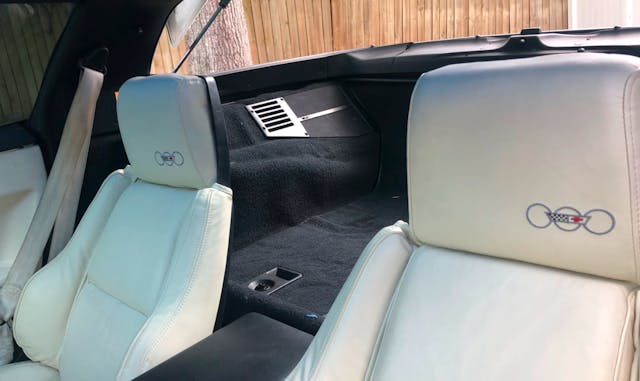
The early C4 body (1984–90) was one of the more iconic cars of the 1980s, as it blurred the lines between American muscle and sophisticated European sports car. That sleek, angular styling certainly fit the bill for shows like Miami Vice. While the drug kingpins may have preferred Italian exotics, the C4 was adequate transportation for a mid-level employee (or his accountant). And why not get one in the same color as the, ahem, product that was making Miami so wealthy?
The 1988 Corvette 35th Anniversary Edition (AE), by color palette alone, might be the most period-correct C4. The hallmark black rub-strip around the body had a fresh coat of powder, as did the wheels. Before the Acura NSX made it cool, the 35th AE painted the roof black to let the white body truly shine. Seats, center armrest, and door cards got snowed in, but the most shocking white-out of all was the steering wheel atop a black steering column.
Much like the 40th Anniversary Edition, the earlier 35th AE utilized the Corvette’s round emblem, creating a tri-hoop affair with circles dedicated to the original Corvette logo. The emblem was seen on the clamshell, the headrests, and the center console.
It’s a good look: How can you go wrong with black and white?
1986 Indianapolis 500 Pace Car

Perhaps the black-and-white treatment is a bit too basic, even for the modernist contours of a C4 Corvette. In that case, how about a yellow convertible with a graphite leather interior? And understated bodyside decals proclaiming this car paced the field at the 1986 Indianapolis 500?
Consider the fact that 1986 was the first year of the C4 Corvette convertible, a body style missing since its departure after 1975. A new yellow color was introduced to accompany the droptop model. Naturally, both new features were applied to the car that actually paced the 1986 Indy 500. But, no matter the color, all 1986 Corvette convertibles were technically pace-car replicas and came with the same emblems and door decals. Perhaps that’s a disappointment for some, but how great is it to celebrate the return of the droptop Vette with a special edition for everyone’s taste?
1995 Indianapolis 500 Pace Car

And then there’s the complete opposite. For the 1995 running of the Indy 500, the Corvette donned a radical Pace Car (RPO Z4Z) paint scheme of purple over white, with a red stripe/unfurling flag decal to accentuate the scheme.
Like the 1986 model, every ’95 Pace Car was a convertible—although this time each one sported a white top. A set of ZR-1-style five-spoke wheels rounded out the package, while interior differences were limited to a pair of bucket seats finished in black/purple leather with Indy 500 graphics embroidered on the headrests. The ’95 Pace Car is quite rare (527 made) and its design was a clear influence on the 1998 C5 Corvette Pace Car that would follow.
1986 Malcolm Konner Commemorative Edition




In case you didn’t know just how valuable a good dealership is to an automaker, witness the Malcolm Konner Chevrolet franchise and its history as the world’s largest Corvette dealer. Not only was this franchise known for moving Chevy’s metal fiberglass, but it also took a majority stake in the investment needed to create the Corvette Challenge series. That race series began out of necessity because the C4 was just too darn good for the Porsche 944 Turbos and the others in SCCA’s Showroom Stock GT class.
As a token of its appreciation, Chevrolet probably felt obligated to let Konner and Co. drum up its very own special-edition C4.
The vehicle itself wasn’t terribly unique: RPO code 4001ZA was a modest $500 package that brought you a unique silver-and-black paint treatment, decals within the exterior emblems, and a gold plaque on the console. Just 50 examples were made—20 coupes with the Doug Nash 4+3 manual transmission and 30 coupes with the automatic gearbox.
While the Malcolm Konner Commemorative Edition is at the bottom of our list, there’s one more example that might be the best C4 Corvette of all time: The very special unit that came equipped with RPO code B2K …
(Dis)honorable mention: 1987 Callaway Twin Turbo







It’s difficult to add the Callaway Twin Turbo to this list with a straight face, as it was far, far more than a “mere” special edition. Sure, you could order it straight from a Chevy dealership using RPO order code B2K, and it sported unique trim that ensured you’d never confuse it for any other C4 Corvette. But even mentioning the Callaway in this list feels … dishonorable?
That’s because the Callaway Corvette sported twin turbochargers, twin intercoolers, 382 horsepower, and a stunning 562 lb-ft of neck-snapping torque. It was 49-state legal, came with a warranty, and the upgrades were brilliantly packaged to fit within the C4’s low-slung hood and sports-car undercarriage.
More to the point, the Callaway Twin Turbo wasn’t a special edition: It was the ultimate edition of the C4 Corvette.
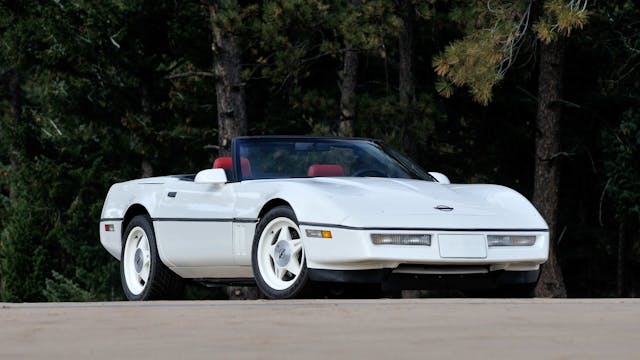


***
Check out the Hagerty Media homepage so you don’t miss a single story, or better yet, bookmark it. To get our best stories delivered right to your inbox, subscribe to our newsletters.
The post 6 rad special-edition Corvettes of the ’80s and ’90s appeared first on Hagerty Media.
]]>
Perhaps the most recognizable Chevrolet Corvette, the third-generation (C3) model dates back to the early 1960s and the first of the “Mako Shark” concept cars. While no production car ever truly recreated the magic of these designs, it is easy to see designer Larry Shinoda’s original Mako Shark II in the C3’s DNA. People loved them, too. During its 14-year run, the C3 became the most widely produced Corvette generation with over 540,000 cars built.
The C3 Corvette experienced a litany of changes throughout its production run from 1968–82. Early cars wore chrome bumpers and could be had with serious muscle, from hot small-blocks to barely streetable big-blocks. By the end of the series came a sharper focus on styling and better interior appointments, as well as electronic fuel injection. Among collectors, the early chrome bumper cars from 1968–72 are most prized, as they are considered excellent-looking and carry the most desirable performance engines. Smog and impact regulations forced big changes in styling and performance beginning in 1973.

The C3 featured here, and currently up for auction on Hagerty Marketplace, is available for bidding through February 22. Refinished in Can-Am white, the car boasts a white top and Saddle interior. It is a charming older restoration, kept in the loving care of the current owner since 2015 and showing just 33,636 miles at the time of listing. The restoration was completed prior to the current owner’s acquisition, and the listing photos indicate some spidering on the hood—something any C3 owner will tell you is unavoidable on older finishes.

Sitting under that hood is GM’s venerable 350-cubic-inch small-block. This was the standard engine for 1969, rated for a respectable 300 horsepower. Coupled with the M40 automatic transmission, this configuration is perfect for cruising or the occasional spirited back road drive. The Corvette is also factory-equipped with air conditioning and a luggage rack, as well as seat belts, which were added by the current owner. Not a miles-long option list, true, but this car is fairly representative of the average Corvette on the road in 1969.
If you’re looking for an early C3 on which you can rack up satisfying miles without guilt, look no further. For my money, it’s more fun to own a Corvette you can drive without worrying about affecting your NCRS judging score.
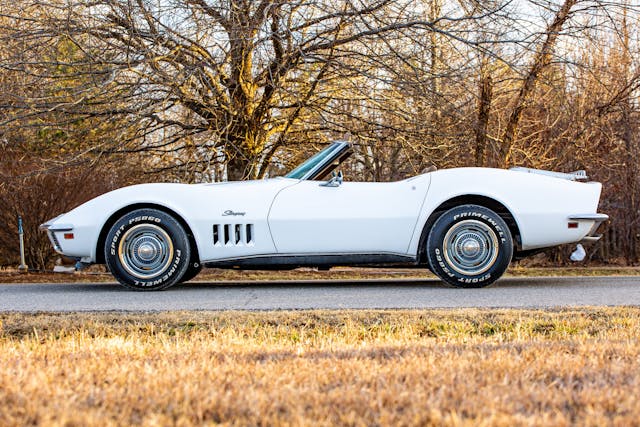
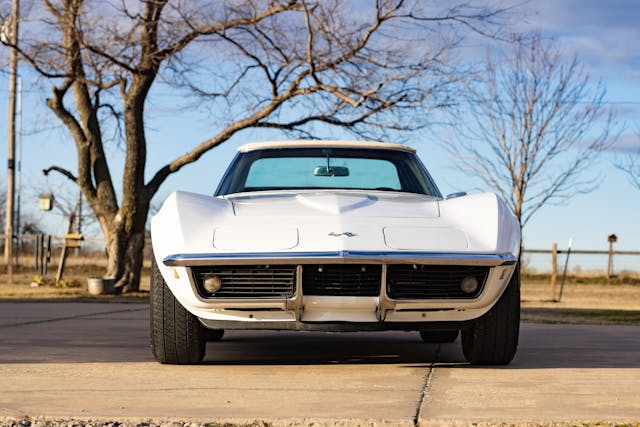





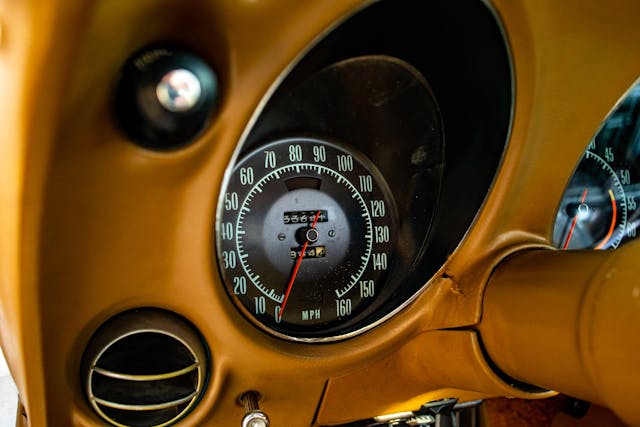


***
Check out the Hagerty Media homepage so you don’t miss a single story, or better yet, bookmark it. To get our best stories delivered right to your inbox, subscribe to our newsletters.
The post Auction Pick of the Week: 1969 Corvette Stingray Convertible appeared first on Hagerty Media.
]]>
Toyota premieres the 2024 Grand Highlander
Intake: Advertising an “adult-sized third row,” Toyota showed off the new Grand Highlander just prior to its formal introduction at the Chicago Auto Show. “There is definitely a need in the market for a midsize SUV that prioritizes interior comfort in all three rows and Grand Highlander is the ultimate option,” said Lisa Materazzo, group vice president of Toyota Marketing. “This 3-row model takes the Highlander legacy to an entirely new space while also keeping on our promise to deliver on electrification.” Three powertrains are offered: A 2.4-liter turbo gas engine, a 2.5-liter hybrid with a manufacturer-estimated 34 combined MPG, and the top-of-the-line, 362-horsepower Hybrid Max. The Max has standard AWD; it’s optional on the other two models.
Exhaust: The Grand Highlander was designed in the U.S., and will be built in Indiana. No pricing information was offered. The current Highlander starts at just over $35,000, so we’d expect this much larger, better-appointed model to clock in at about $47,000 with some basic options. — Steven Cole Smith
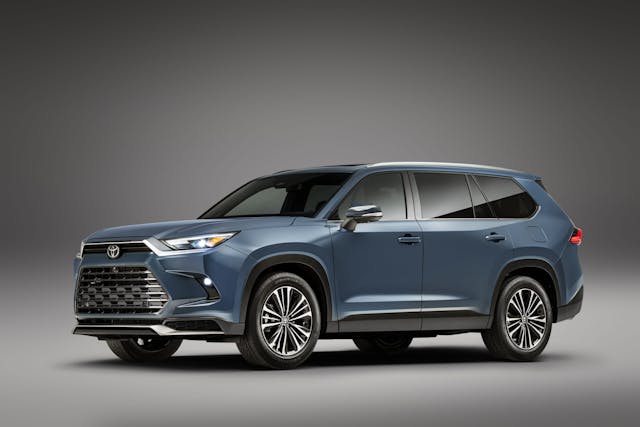









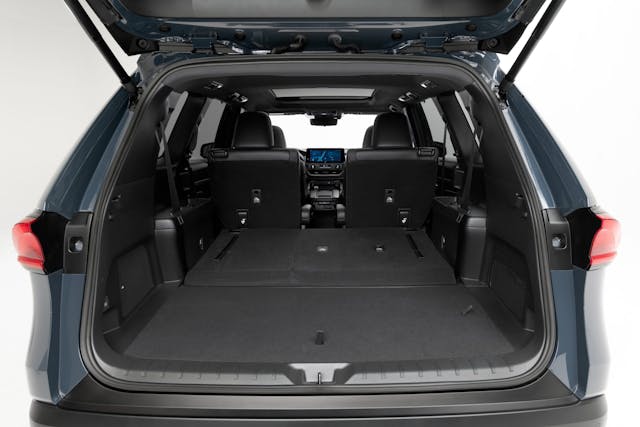

The littlest Ferrari is now ready to race




Intake: The cutest car to wear a Prancing Horse badge is now available with an extra gallop. The Little Car Company has just launched a special edition Pacco Gara edition of its 3/4 scale Ferrari Testa Rossa J which has been designed to take to the track. A software upgrade boosts power from its electric motor to almost 22 horsepower, the steering rack has a quicker ratio for tipping into turns, the disc brakes are drilled, plus there’s a bolt-on roll bar and Sabelt harness to hold driver and passenger in place. The dampers and brake bias are also adjustable so junior racers can fine-tune their setup for each circuit. “Every element of the Pacco Gara has been developed with, and signed off by, the team at Maranello and is focused on paying homage to one of history’s great racers, while also offering drivers a substantial, tangible taste of what it feels like to be behind its wheel,” says CEO Ben Hedley.
Exhaust: When we drove the Testa Rossa J our first thought was that it would make a great Little Racing Car, but whether anyone spending north of $130,000 on one of these for their boy or girl racer would risk it all on track is another matter. — Nik Berg
J.D. Power: Charging network has problems

Intake: At least 1-in-5 charging attempts by drivers failed last year, according to a J.D. Power study released on Wednesday, says Automotive News, and EV sales are doubling the installation rate of new public charging stations. The number of failed charging attempts went from 15 percent in the first quarter of 2021 to 20 percent in the first quarter of 2022 and rose to more than 21 percent by the third quarter, according to J.D. Power’s Electric Vehicle Experience Public Charging Study. “We can’t add new chargers and let all those old ones fall into a state of disrepair,” said Brent Gruber, executive director of global automotive at J.D. Power. “We have to manage the maintenance of those as well because that’s the only way we’re going to meet the consumer demand.”
Exhaust: We personally have had this problem repeatedly, and have found the most reliable chargers in our area to be, of all places, at Walmart. Charger installation, and the maintenance of existing chargers, has to meet the coming demand as we electrify. — SCS
Tesla top seller in California in 2022

Intake: Tesla’s Model Y and Model 3 electric vehicles were the top-sellers in California last year, outselling Toyota’s RAV4 and Camry models, according to a California New Car Dealers Association report quoted by Reuters. It is the first time a Tesla model topped the annual sales list in California, a major vehicle market where one in five cars is electric. Tesla sold 87,257 Model Y electric SUVs and 78,934 Model 3 electric sedans last year, while Toyota sold 59,794 units of its Rav4 SUV and 55,967 of its Camry sedans. The Camry was the top seller in 2021.
Exhaust: While other charging networks are facing aging problems, Tesla’s Charging network is widely regarded as the best in the business currently. No doubt that adds to the appeal of getting into a Model 3 or a Model Y. — SCS
Ford has no interest in IMSA GTP Prototype racing

Intake: With its new commitment to Formula 1 in partnership with Red Bull, Ford will not be joining Cadillac, BMW, Acura, Porsche, and Lamborghini in sports car racing’s top class, reports Motor Trend. Instead, it will focus its competition efforts on various Mustang programs and F1, plus the World Rally Championship. That’s according to Ford CEO Jim Farley and Ford Performance Motorsports global director Mark Rushbrook. “No, I don’t think we’re much into [racing] Prototypes at Ford,” Farley said.
Exhaust: This has to be disappointing news for IMSA and its fans, who had been anticipating another Ford/GM battle at the top of the sports car racing food chain. Ford will participate in IMSA GT3, though, with its new Mustang. which debuts on track at the 2024 Rolex 24 at Daytona. There, it will be fighting it out with the new Corvette GT3 car. — SCS
New tech, styling lead updates for 2024 Chevy Trailblazer

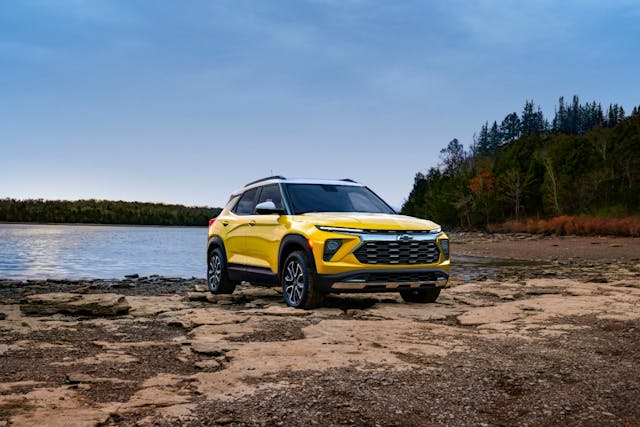



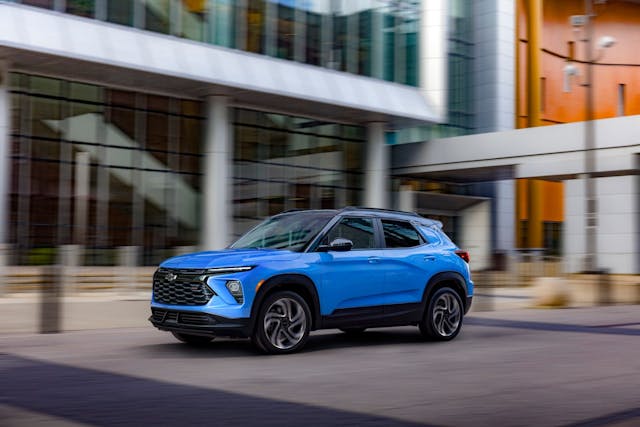
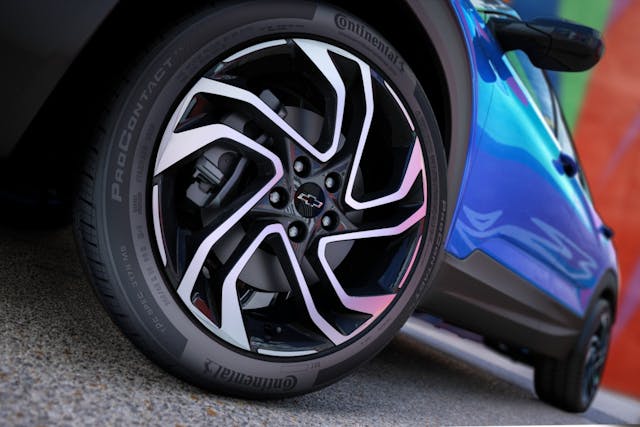

Intake: Chevrolet has announced a raft of updates for the 2024 Trailblazer, its compact SUV focused geared towards active buyers. There’s a new front fascia and lighting, plus a different grille design depending on the trim you pick (LS, LT, Activ, and RS). The range-topping RS trim will get new 19-inch wheels, and two new colors—Copper Harbor Metallic and Cacti Green—join the existing paint colors. Inside, a new 11-inch central infotainment screen is now standard, and the instrument cluster now uses an 8-inch screen instead of analog gauges. Powertrains are unchanged; lower-trim cars will get a 1.2-liter turbocharged inline-three good for 137 hp, while upper trims get a 1.3-liter turbocharged inline-three good for 155 hp. All 1.2-liter-equipped cars will get a CVT transmission, as will FWD versions of upper-trim cars with the 1.3-liter engine. If you opt for an upper-trim car with the 1.3-liter engine and AWD, you’ll get a nine-speed automatic. Base price jumps by $1000, up to $24,395, and the top trim Activ and RS models will start at $28,395.
Exhaust: Trailblazer sales were down more than 30 percent year-over-year when you compare 2021 to 2022, so it was about time for a refresh. More screens seem to be what the young buyers who might opt for a vehicle like this want, so the interior updates make sense. Will the price hike push off buyers? Time will tell. — Nathan Petroelje
Mini wants to save the stick

Intake: Manual transmissions have all but disappeared, but a study by Mini USA suggests there’s still some interest in shifting for yourself. Some 63 percent of respondents agree that learning how to drive a manual transmission “is a rite of passage and an important life skill.” Additionally, “fun to drive” was the top characteristic that respondents most associated with a manual transmission vehicle. However, despite this, less than a quarter (24 percent) of all respondents indicated they own a manual-equipped car. Not knowing how to drive a manual was one deterrent, and 53 percent of those who did not know how to drive a manual were interested in learning. It just so happens Mini offers a manual driving school in Thermal, California for $499.
Exhaust: As of November 2022 production, Mini announced the return of manuals in its Cooper, Cooper S and John Cooper Works 2-door hardtops, so they are doing there part to save the manuals. If you’d like to learn how to drive a stick but don’t want to hike out to California, Hagerty also offers a program that will teach you how to drive a manual. — SCS
The post Toyota’s new Grand Highlander, kids can race the littlest Ferrari, aging woes for EV charge network appeared first on Hagerty Media.
]]>
Corvette fans have had a lot to celebrate in the last few years. The C8 debuted to much fanfare, the Z06 launched to rave reviews, and now the E-Ray has been unveiled, using hybrid tech to take the model to another level of performance. But don’t think that you’ve got to spring for a six-figure Corvette to enjoy a mid-engine marvel with a little extra jazz. We recently drove a Callaway Corvette B2K 35th Anniversary Edition to see and hear what this limited-run car is all about.

The Callaway Corvette B2K 35th Anniversary Edition was created to honor the relationship between Callaway and America’s sports car, a story that stretches all the way back to the 1987 Callaway Twin Turbo Corvette. This special edition C8, whose B2K alphanumeric recalls the RPO code of that original twin-turbo upgrade, is based on the Stingray coupe or convertible. Once ordered, it will be built at the Corvette’s Bowling Green, Kentucky, assembly plant and, if the buyer so chooses, can be delivered through the National Corvette Museum.

The Carbon Fiber Aerodynamic Group that comes on the B2K package matches a front splitter, rocker panel extensions, rear spoiler, and rear diffuser to give the Stingray a distinct look. That sizable piece of carbon fiber out back works in conjunction with Callaway’s Double D exhaust that replaces the quad-tipped factory setup with mirrored exhaust tips that are relocated in the center, more like a Z06.

Another striking difference with the Callaway C8 is the set of nine-spoke forged aluminum wheels, which together remove more than 26 pounds of unsprung mass from the car. Opening the doors reveals a Callaway Interior Group that is exclusive to the Anniversary Edition and includes engraved, anodized sill plates and a serialized interior plaque along with embroidered floor mats and a set of billet aluminum pedals.



We got behind the wheel of a B2K 35th Anniversary Edition for a quick drive around some damp Southern California mountain roads and a brief blast up a highway. We can’t say how the lighter wheels affect the driving characteristics or the steering feel of a Stingray; such an evaluation would require a back-to-back test and some truly spirited driving. We can, however, report that the exhaust is an improvement.
That’s a subjective evaluation, of course, but we’re not alone in feeling that the Stingray’s exhaust is a bit tame for such a striking and capable car. Callaway’s system allows the LT2 V-8 to be more expressive, and the stainless-steel pipes give the Corvette a sound that’s a bit more exotic. The tune’s not overly aggressive, although it does seem to taunt the driver into giving the LT2 V-8 ever more throttle.

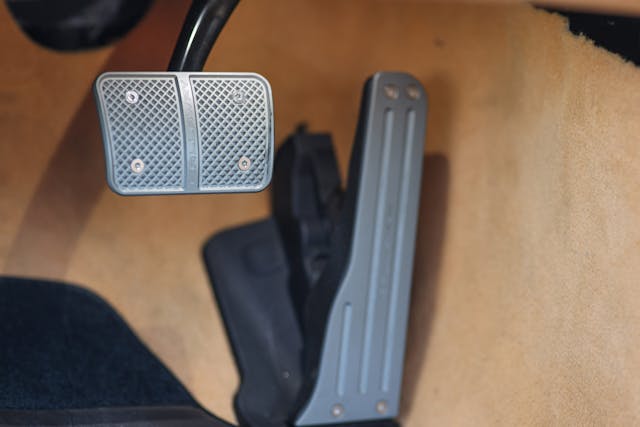
The bad news is that the B2K 35th Anniversary Package sold out almost immediately. The good news is that most of the parts that make this package shine, including the wheels and carbon-fiber aero bits, are currently available. The exhaust is the major piece missing from Callaway’s catalog, but it should be available soon. If you’ve managed to see, or hear, one of the limited B2K 35th Anniversary Editions on the street, just know that it’s not too late to get some of that Callaway performance on any Stingray, even the one you already own.
Check out the Hagerty Media homepage so you don’t miss a single story, or better yet, bookmark it.
The post We drive Callaway’s nod to its first tuned Corvette appeared first on Hagerty Media.
]]>
This question might sound a little familiar, as we discussed your worst engines in our last installment of According to You. And that’s where Hagerty Community member Bob Keith’scomment comes into play:
“Hey one more thing – excellent piece on the Worst Engines – NOW how about an article on the BEST Engines? I would love to read the final survey results for that!”
Me too, Bob! So let’s do it. Your answers should not be regurgitated opinions from others, nor should they be from content consumed online or in a magazine. Only your experience with an engine can help forge such an enviable accolade.
To kick things off, I’ll share my candidate and give you all a sense of what we’re hoping to see in your answers.
Lotus/Mercury MarineChevrolet LT5 V-8

My experience driving a 1990 Corvette ZR-1 ensured that its 5.7-liter LT5 V-8 motor would become my runaway favorite engine. I got to enjoy it for just a few days as a college student, but that was all I needed. The C5 generation (1997–2004), LS1-equipped Corvette was already a couple of years old by the time I met the C4 generation (1984–96) ZR-1, but I couldn’t care less after tasting the sweet, sweet powerband of that LT5 motor. Between the 370 lb-ft of torque and 375 hp on tap and the wide powerband, the experience absolutely blew me away. (That little key on the dash that turns off half of the sixteen fuel injectors when someone else needs to drive it is worth a chuckle or two, as well.)
Then I drove a Lingenfelter stroker version of the LT5 that was bored out to 6.8 liters and made 668 horsepower—the brain-melting commenced for a second time. The big boy Lingenfelter has all the torque of a big block muscle car with the powerband of a VTEC Honda. You simply cannot understate the magnificence, especially when you open the hood and see Lingenfelter’s signature siamesed intake resting atop those massive double-overhead camshaft heads.

The ZR-1 was a tour de force when new, but it’s just as impressive nowadays and still shockingly underappreciated in today’s red-hot collector car market. While it’s a bit complex on the induction side of things, the motors are shockingly reliable and quite trustworthy. Why people don’t lust after this vehicle is beyond me, but the LT5 is clearly the best engine I’ve ever experienced.
And with that, I leave it to you, Hagerty Community:
What is the best engine you’ve ever experienced?
Jump in with your experiences in the comments below.
Check out the Hagerty Media homepage so you don’t miss a single story, or better yet, bookmark it.
The post What is the best engine you’ve ever experienced? appeared first on Hagerty Media.
]]>
Hennessey’s new supercharger kit boosts C8 Corvette to 708 hp
Intake: Texas tuner John Hennessey has released a supercharger package that boosts the Chevrolet Corvette C8 to levels that, he says, surpass the 2023 Chevrolet Corvette Z06. The C8 Corvette Stingray coupe is shipped with an LT2 6.2-liter V-8 engine that, in stock form, delivers 490 hp and 465 lb-ft of torque. To “unleash the untapped potential of the American small-block V-8,” Hennessey’s team fits a high-flow centrifugal supercharger, an air induction system with an air-to-water intercooler, and an optional enhanced cat-back exhaust. Completed with updated high-performance engine software, the “H700” pumps out 708 hp and 638 lb-ft—a 44 percent increase in horsepower and a 37 percent increase in torque over the factory rating. In terms of power output, Hennessey says the supercharged H700 Corvette C8 Stingray even outshines Chevrolet’s flagship C8 Z06, whose naturally-aspirated, 5.5-liter LT6 flat-plane crank V-8 engine produces 670 hp and 460 lb-ft of torque.
Exhaust: The complete Hennessey Supercharged H700 Corvette C8 Stingray upgrade package includes the supercharger, intercooler, engine tune, lightweight wheels, cat-back exhaust, and graphics priced at $49,950. Plus, of course, the car. A power-only package, with just the supercharger upgrade package and warranty, is offered for $34,950. Considering the price of a base C8 Corvette now rests at around $65,000, you’re looking at an all-in price of around $100,000. A base Z06 costs $106,395; which would you prefer? — Steven Cole Smith


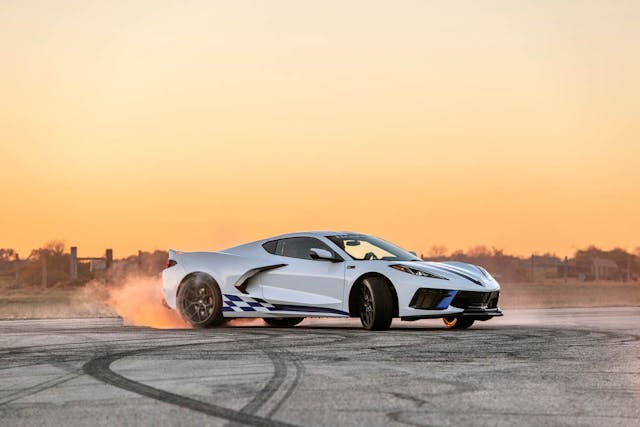







Nissan targets 2028 for EV with solid-state batteries
Intake: Nissan wants to produce electric vehicles with solid-state batteries by 2028, according to a new report from Autocar. The company is working on a pilot plant to produce the batteries by 2025 and intends to ramp up production by 2028 for the first application. Solid-state batteries will offer far superior energy density and much faster charging times, which should result in dramatically increased range and even less time spent charging while on the go. ‘We think we have something quite special and are in a group leading the [solid-state battery] technology,” said David Moss, Nissan’s senior vice-president of research and development in Europe while talking with Autocar.
Exhaust: Remember that bold convertible Nissan showed off a few days ago? Perhaps we’ll get one of those with a solid-state battery that promises 400-plus miles of range one day. The small electric pickup that Nissan is reportedly considering would also be a great candidate for the new battery tech. Nissan may be in a great position, but they’re not the only brand working on solid-state battery tech, as Car and Driver noted. Ford, BMW, Toyota, and a few others are also exploring what is widely considered to be the next big leap in battery technology—and those automakers might have it even earlier. — Nathan Petroelje
Ford has an engineering problem that’s crushing profitability, says CEO

Intake: Ford missed out on roughly $2 billion in profits last year, and CEO Jim Farley has been candid about the reasoning behind that. According to a report from Automotive News, Farley said that Ford currently has a glut of engineers relative to its competitors. “It takes us roughly 25 percent more engineers to do the same work statements as our competitors,” Farley said on Cars & Culture with Jason Stein, a Sirius XM radio show. The surplus personnel isn’t the only reason for missed profits, however; other avoidable expenses and supply chain issues also contributed to the scant bottom line. Farley has pledged to cut $2.5 billion in costs this year and said that job cuts are on the table, but he also told industry analysts that all options are on the table to help scrub costs out of the company, according to the Detroit Free Press.
Exhaust: Ford led the industry in total number of vehicles recalled in 2022, its second straight year atop a list that no automaker wants to rank high on. That Ford is apparently using 25 percent more engineers to make product decisions that still result in this many recalls is all the more troubling. Expect Ford to figure it out, but don’t expect it to be a swift or easy course correction. — Nathan Petroelje
Moto Morini gears up for U.S. return

Intake: Moto Morini, the storied Italian motorcycle maker, is in the process of recruiting dealers who would be ready to re-introduce the brand to America. Founded by Alfonso Morini back in 1937, the company first made its name with 125cc two- and four-stroke bikes, and by kick-starting the career of racing legend Giacomo Agostini. In the 1970s the company upsized with a range of V-Twins, and the 350cc 3 1/2 gained a strong following. A decade later the business was in decline, however, and sold to Italian rival Cagiva. From there on it passed through several owners, and an early-2000s revival failed to take hold. Owned by China’s Zhongneng Vehicle Group since 2018, Moto Morini now offers two bikes: the classic naked Seiemmezzo (6 1/2) which comes in street and scrambler style, and the X-Cape adventurer. Both are powered by 61-hp, 650cc parallel twins and could be back on U.S. roads before the end of 2023.
Exhaust: “Moto Morini is ready to make an immediate and lasting impact in the American two-wheel market,” says the firm. Three decades after the name last appeared atop a dealership door in the U.S.A., it will be a big ask to get riders to consider Moto Morini as a serious Ducati alternative, but at least they seem to finally have the backing that will be required. — Nik Berg
New Mercedes-Benz eSprinter hints at electric vanlife of tomorrow


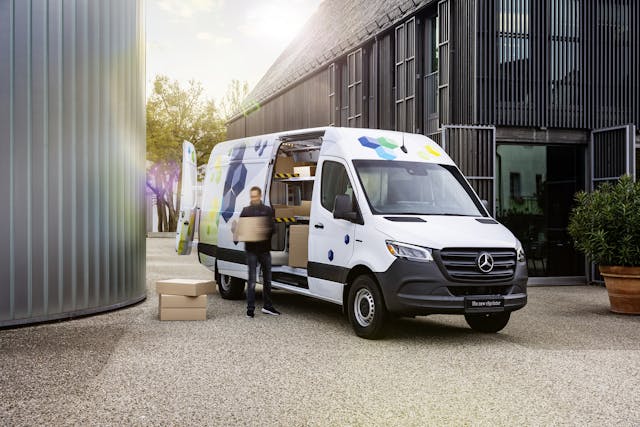





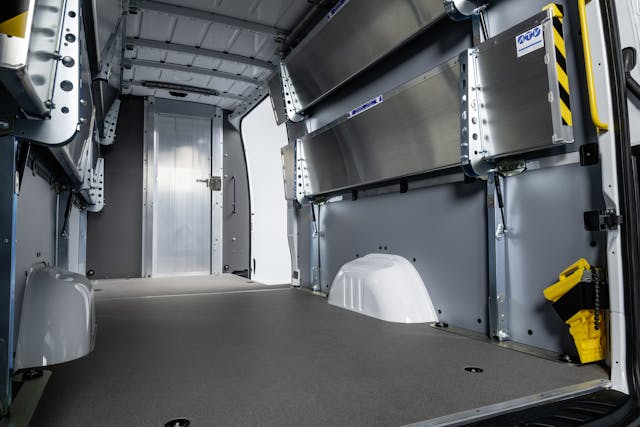
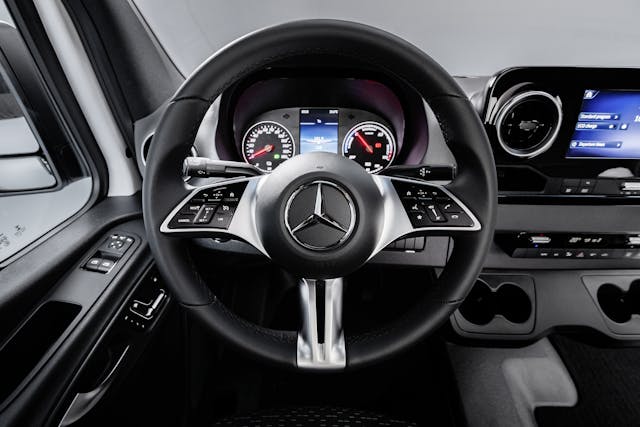

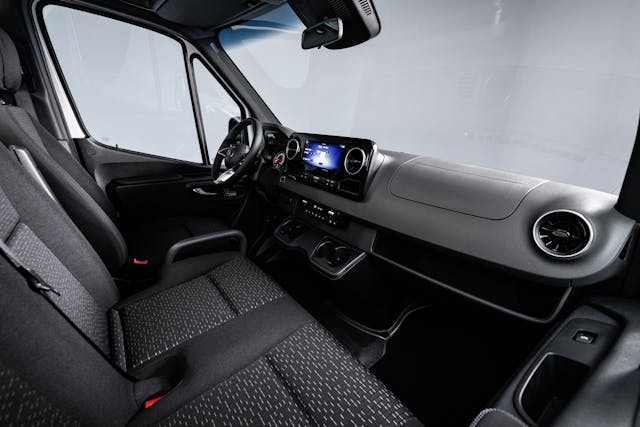
Intake: Mercedes-Benz has unveiled the new eSprinter, the first all-electric van that it will build for as many as 60 markets globally in the coming years. It’s the first electric Sprinter to reach American shores as well; Merc says it will arrive in the U.S. and Canada in the second half of 2023. Initially, it will be offered only in its largest configuration: a long wheelbase, high-roof cargo van that will fit the largest version of the Lithium/Iron Phosphate (LFP) battery on offer, a 113-kWh setup. Mercedes says that on a simulated WLTP test cycle, this configuration achieved a range of 248.5 miles and that on a simulated version of the WLTP city test program, it achieved 311 miles. You’ll be able to choose from two electric motors, the first good for 100 kW (134 hp) of peak output, the second good for 150 kW (201 hp) of peak power. Peak torque on both motors will be 295 lb-ft. The battery will be able to go from 10 percent to 80 percent full in just 42 minutes on a 115-kW DC fast charger, but you can also charge it using AC current at your home at a rate of up to 9.6 kW per hour. The new eSprinter will be produced in three locations: Charleston, South Carolina, Düsseldorf, Germany, and Ludwigsfelde, Germany.
Exhaust: While we’re just seeing the cargo van version right now, that impressive 488 cubic feet of space can easily be put to use by the enterprising folks that like to convert these boxes into rolling homes on wheels. Expect the all-electric vanlifers to be here before you know it. — Nathan Petroelje
Vinfast throttles back on U.S. plans

Intake: Vinfast, the Vietnamese auto manufacturer of electric SUVs that had big plans for the American market, appears to have dialed back. The company has cut 80 jobs in North America, including that of the chief financial officer, reports Bloomberg via Automotive News. Vinfast said the restructuring was aimed at “better serving customers in the region,” and that it has been working with local service providers to improve efficiency. “This also leads to the streamlining of our North American operations and there are certain departments affected by this,” the EV maker said in an email.
Exhaust: Maybe, but canning your CFO while you are planning an American IPO for the company, if indeed Vinfast still is, isn’t a confidence-inspiring move. They had planned to have nearly 1,000 Vinfast vehicles in the hands of consumers last November, but it has been delayed until late this month. – SCS
The post Hennessey’s supercharged C8, Ford has too many engineers, Mercedes-Benz’s new eSprinter appeared first on Hagerty Media.
]]>
Do you love motorsports as much as we do? Sign up for the Hagerty On Track newsletter.
Seldom has a race been so difficult, so downright impossible to handicap as last weekend’s 61st Rolex 24 at Daytona.
Unlike years past, the winds of change were strong in the IMSA preseason paddock. By the time January arrived, a brand-new class containing two new manufacturers, as well as a bevy of fresh-faced teams and drivers, joined stalwart entries for the impending Florida foray. We’re talking more variables than an Algebra textbook.
And from the proverbial control tower, it was IMSA’s job to keep the playing field level and fans enthused.

This balancing issue stems from professional road racing’s new set of common rules agreed upon by IMSA in the United States, and the ACO in France. This year’s legislations and balance of performance (BOP) regulations allow a myriad of new marques to compete at professional road racing’s highest level with the same car. Now, for the first time in decades, a manufacturer could sweep the discipline’s triple crown by winning first overall at the Daytona, Sebring, and Le Mans in France.

This all-new class of Grand Touring Prototypes (GTP) features hybrid-powered fiberglass-shrouded race cars that don’t resemble any sort of road-goer. Last weekend, sleek new designs from Acura, Cadillac, BMW, and Porsche made their competition debut on the Daytona high banks. The group engaged in a fierce battle for 24 hours, with the overall win eventually going to the veteran Meyer Shank Racing Acura team.
With a race under their belt, the fresh field continues on to the Mobil 1 Twelve Hours of Sebring and—most importantly—the 100th anniversary 24 Hours of Le Mans.

Back to the handicap: There was an underlying concern that the new GTP cars (called LMDh in Europe) might not survive the 24 hours, especially given the sophisticated, mandatory new battery-powered systems that require the cars to enter and exit the pits on electricity alone. There was an unspoken fear that one of the fast, proven LMP2 undercards might sneak in for an overall win. IMSA quietly addressed this issue, slowing the LMP2s down by reducing power and increasing weight.
There was no need.
Acura finishes 1-2 in GTP

The GTP cars performed, as a whole, admirably. For the second year in a row, the pink Meyer Shank Racing Acura placed first overall. Its driver lineup was comprised of closer Tom Blomqvist, Colin Braun, Simon Pagenaud and Helio Castroneves, who collected his third straight Rolex triumph. The future hall-of-famer could open his own jewelry store as he now owns three Rolex watches and four Indianapolis 500 rings.
The little Acura twin-turbo V-6 ran flawlessly, but there was concern in the pits about the transmission, which began to overheat eight hours into the enduro. They decided to run it until it stopped shifting, which it never did. Otherwise, the Meyer Shank Acura just suffered the expected niggling problems.


The lead Acura, as well as the second-place car, the Wayne Taylor Racing with Andretti Autosport Acura, completed 783 laps on the 3.56-mile track. Third place and fourth place, the two Cadillacs fielded by Chip Ganassi, also finished on the same lap. In fact, the fourth-place car was only 16 seconds behind the winning Acura.
The Whelen Cadillac was 12 laps back, and the top-finishing BMW, a Rahal-Letterman-Lanigan car, was 15 laps behind. Then, in seventh, was the first LMP2 car, the Proton entry. That car was about four seconds a lap slower than the top Acura GTP car.
The failure of Roger Penske’s Porsche GTPs to finish near the top was the biggest surprise. The two Porsches had more development time and certainly as much testing time as the other marques, but the best they could do was 14th and 42nd overall. If a pre-race pick had to be made, we’d likely have selected the Porsches.
The ninth GTP car, the second of RLL’s BMWs, was never in the game and finished a grim 48th in the 61-car field.
WeatherTech Racing tops GTD Pro

Aside from the Meyer-Shank win, the other feel-good story was the GTD Pro win by WeatherTech Racing’s Mercedes-AMG, led by Cooper MacNeil, in his final race as an IMSA WeatherTech SportsCar Championship competitor. The team finished 17th overall, giving MacNeil a Rolex on his way out of the driver’s seat to work in team management and to help with the family-owned WeatherTech company. Corvette Racing was second in class after leading much of the race, just four seconds behind the WeatherTech Mercedes.
The AWA team won in LMP3, and in GTD, the Heart of Racing Aston Martin GT3 took the class win.
Next up: Sebring
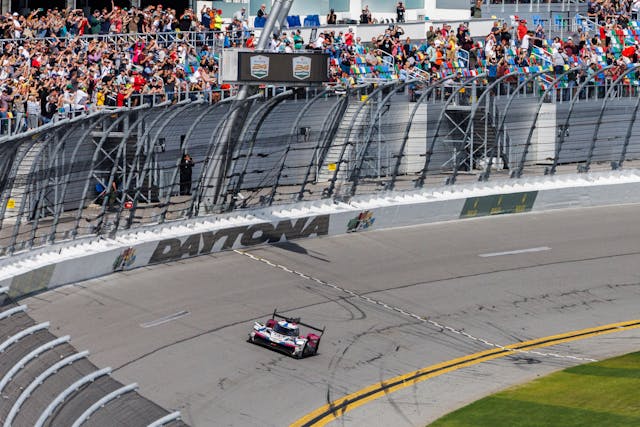
All said, though, the major marvel of the race was the Meyer Shank Acura, which was able to better launch off the corners than the competition. All race long, the pole-sitting Acura seemed to be able to pass the competition at will. The rest of the GTP field has some work to do before March 18, when the 12 Hours of Sebring takes the green flag.
Meyer Shank, on the other hand, looks to take another step toward the triple crown.











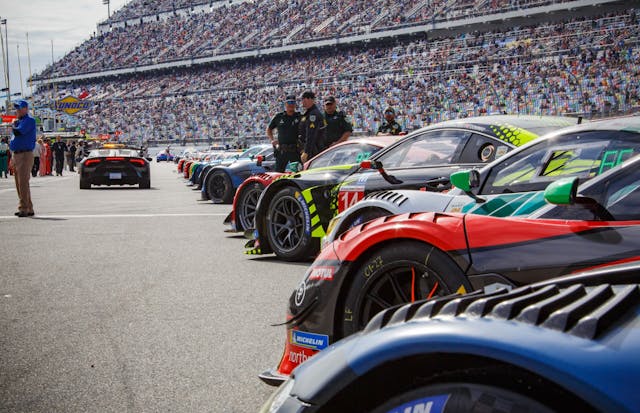




The post Acura throttles disparate Daytona field at Rolex 24 appeared first on Hagerty Media.
]]>
Do you love motorsports as much as we do? Sign up for the Hagerty On Track newsletter.
Chevrolet finally yanked the cover from its new Corvette Z06 GT3.R race car today, at Daytona International Speedway. The big reveal comes exactly one year before the mid-engine racer makes its competition debut at the 2024 Rolex 24.
It’s the first Corvette built to the global GT3 rules, which includes the GT classes in the IMSA WeatherTech SportsCar Championship—the sanctioning body for the Rolex 24 at Daytona. The Corvettes that took to the track last year, as well as the sole yellow Vette that will campaign in IMSA this year, are GT Le Mans-class cars, detuned to roughly meet GT3 regulations.
With an eye specifically toward customer racing, the Z06 GT3.R will be eligible for multiple championships in North America and around the world, with parts and technical support for its customers. For the past 25 years, the Corvette has not been available to customer teams. Come next year, this will change entirely as privateers are expected to field a majority of the Z06 GT3.R racers.

“The Corvette Z06 GT3.R breaks new ground for Chevrolet and the Corvette Racing program,” said Mark Stielow, director of GM Motorsports Competition Engineering. Based on the mid-engine Chevrolet Corvette Z06, this new Vette takes the technology transfer between racer and production car to a new level with more shared components and features than ever before.
“Corvette Racing has been an important influence on the design of Corvette production cars for 25 years,” said Tadge Juechter, executive chief engineer for the Corvette. “Corvette production and racing teams worked together closely in development to maximize the benefits of a mid-engine design, sharing lessons learned that set both programs up for all-out performance on the track.”

The Z06 GT3.R begins life as an aluminum chassis frame from Chevrolet’s Bowling Green Assembly plant in Kentucky. The frame provides a lightweight underpinning for both Z06 and Z06 GT3.R. The skeleton is then shipped to Michigan-based partner Pratt & Miller, where a purpose-built steel roll cage is welded onto a base plate, which is secured to the chassis.
Chevrolet’s motorsports engineering team adds race springs and dampers, competition-specific rotors, calipers, and pads to the rig. The Z06 GT3.R rides on 18-inch front and rear wheels—the same diameter as on the C8.R. The goal was to design a GT3-spec Corvette that is suitable across different tire specifications, balance-of-performance settings, and other customer preferences without sacrificing performance or drivability on a variety of tracks and racing surfaces.

The Corvette Z06 GT3.R will use a 5.5-liter, flat-plane crankshaft DOHC V-8 derived from the production Z06. This version of the LT6 engine began on-track development in 2019 with the initial testing of the C8.R, ahead of its use in the production Z06.
The new racer’s power plant also originates from the Performance Build Center in Bowling Green, the same line on which all production Corvette Z06 engines are built. It shares more than 70 percent of its parts with the production Z06 engine, including the crankshaft, connecting rods, cylinder heads, fuel injectors, coils, gaskets, and a variety of other sensors.
The reveal of the Z06 GT3.R follows a two-year testing program. Virtual simulation through Chevrolet’s Driver in the Loop simulator began in early 2021. The first on-track test of the Z06 GT3.R took place in September 2022, which means the Z06 GT3.R will have a full year of on-track development when it gets into the hands of customers in the third quarter of 2023.

“We’re all very pleased with the results from the track testing program so far,” said Laura Wontrop Klauser, GM sports car racing program manager. “What’s even more encouraging is the correlation between simulator sessions and what we’re finding in the real-world track testing. It’s another level of validation that gives us confidence in the development process.
“This has been an intense but very rewarding process,” Klauser said. “From the time we announced a Corvette GT3 car, I’ve received more inquiries than I can count. It’s a testament to a known product like Corvette, the minds behind design, development and build, and the quarter-century success of Corvette Racing.”
Check out the Hagerty Media homepage so you don’t miss a single story, or better yet, bookmark it.
The post Chevrolet’s new Corvette Z06 GT3.R prepares for worldwide battle appeared first on Hagerty Media.
]]>
General Motors is loud about its EV future, but that didn’t stop its powertrain division from designing an all-new monster V-8 for the Corvette Z06. We might one day look back at the 670-hp LT6 and recognize it as the pinnacle of the Chevy small-block, a swan song sung by engineers who wanted to demonstrate what they could do before everything in the GM stable runs on electrons rather than gas.
This race-bred engine matches the screamers from Porsche and Ferrari, with an 8600-rpm redline and outstanding power from 5.5 liters. It also marks a new spur for the small-block engine, a path that leans toward high rpm rather than boosting for power.
The previous Z06’s V-8 produced 650 horsepower with the assistance of a supercharger, a belt-driven pump that shoves in air. Engine horsepower is directly related to the amount of air that flows in and out, because the more air an engine breathes, the more fuel it can burn, and thus a more forceful boom drives the piston down the cylinder. A turbocharger is a pump like a supercharger, but the turbo is driven by exhaust gases. Engines with either pump—which are often called blowers—are known as boosted. Conversely, an engine without the pump is called a naturally aspirated engine.

As with every engineered product, there are pros and cons to each when it comes to power, fuel economy, cost, and the character or feel of the engine. Blowers are relatively easy-to-adopt bolt-on horsepower-makers, but they have a certain noise and the power delivery often surges, whereas naturally aspirated engines typically pull in a consistent way. As rpm increases, so does the power.
The LT6 began with the accountants, who greenlit a blank-sheet engine that would not be compromised by having to share parts with pickups. They were probably strong-armed by GM’s famously petrol-fueled president, Mark Reuss. In any case, you can hear the glee in the voices of the two main players for the LT6 engine: Jordan Lee, chief engineer for all small-block V-8s, and his colleague, assistant chief engineer Dustin Gardner.
“We wanted the Z06 to scintillate all the senses,” says Gardner. “What you feel and hear from the engine is such a huge part of the experience. The mechanical and screaming cacophony of a naturally aspirated engine is the sweetest of music, and that’s what we aimed for.”

Though they biased the engine design for character, they also knew that the 2023 Z06 had to offer at least as much power as the previous model. That meant 650 or more horsepower without the aid of a blower. Furthermore, this new engine was going to be a derivative of the small-block V-8, an engine that debuted in 1955. Heritage matters to Corvette fans—and to Corvette engineers. “One of the things Corvette customers love about the small-block is low-end torque,” says Lee. “Even at low engine speeds, when you just dip on the throttle, it goes. We had to preserve that.”
High-rpm power and low-rpm torque are usually not bedfellows. Torque is a force applied in a circular motion, like a wrench turned on a nut. Horsepower is the rate at which torque is applied—how fast the nut was turned. Keep torque constant but increase the engine speed, and the horsepower rises. Conversely, maintain engine speed but increase torque, and horsepower increases. Small, light, and revvy engines, like those in a motorcycle, might boast high horsepower at 14,000 rpm but not enough torque to move a 3500-pound car from a stoplight. Tractors, on the other hand, can yank a stump from the earth with their slow, high-torque engines at idle.

High rpm and high power dictated a flat-plane crankshaft. This maximizes scavenging—the effect where exhaust gas from one cylinder actually sucks spent gases out of an adjoining cylinder’s exhaust port, which increases airflow. With a flat-plane crank, the exhaust pulses of one cylinder directly aid the breathing of another cylinder on the same bank, in a way not possible with a conventional V-8 cross-plane crankshaft. Remember, the more air that flows in and out of the engine, the greater power it can produce. The firing order of flat-plane cranks also adds to a distinct, quite pleasing wail.
Flat-plane cranks are standard in Italian supercars but rare in American engines because they cause more vibration. A century ago, Cadillac dropped 180-degree crankshafts for 90-degree units, and most V-8–makers quickly followed suit, sacrificing some power for smoothness.
Vibration can be mitigated by how the engine is mounted in the chassis, and there was more flexibility with the Corvette now that the engine resides in a roomy bay behind the driver. The best strategy, though, is to not just mitigate vibration but to generate less of it to begin with. “It’s really the stroke—the distance the piston travels in the cylinder—and the weight of the piston assembly that drive vibration with a flat-plane crank,” says Gardner. That meant lightweight—but expensive—materials such as titanium for the connecting rods and a shorter-than-usual stroke.


After numerous iterations and computer models, Lee and Gardner landed on an 80-millimeter (3.1-inch) stroke, nearly a half-inch shorter than the standard Corvette V-8—which is why the LT6 is called a short-stroke engine. The shorter stroke also kept the piston speeds in check, which is another concern for high-revving engines.
If you could see a piston in a running engine, it would be a blur, as if it’s traveling supersonically. But the peak speed is roughly 4500 feet per minute, or about 50 mph. The piston’s back-and-forth motion, however, is the killer. In a typical engine running at 6000 rpm, the piston zips from top speed to zero back to top speed in a microsecond. If we remember that acceleration is the change in speed over time, then we can see that increasing engine speed—or piston stroke—also ups the acceleration. Go too fast, though, and the piston fatigues, cracks, and then—boom.
Not to worry, Lee assures us. “With our 80-millimeter stroke, we didn’t come close to the limit for piston speed. We probably have some room to grow there.”
Next came the bore size, which is the diameter of the piston. There are numerous factors at play, including how close the cylinders are to each other, which is defined by the distance from the center of one cylinder to another—the bore center. Here, history played a role. “Yeah, there’s a huge following of small-block lovers who appreciate the engine’s history,” says Lee. “Even though the LT6 is all new, we kept one dimension that is the DNA of the small-block: the 4.4-inch bore center.”

The 104.25-millimeter (4.1-inch) cylinders are packed in shoulder to shoulder. The 104.25-millimeter bore and 80-millimeter stroke yielded 5.5 liters, the combined total volume of all the cylinders and a good compromise between an engine that can rev and one with decent low-end torque. It also happens to be the maximum engine displacement for production-based cars in the 24 Hours of Le Mans, where Corvettes won their class eight times.
Once Lee and Gardner defined the LT6’s foundational elements, their attention shifted to maximizing horsepower and making sure that the power gets to the tires by reducing parasitic friction. Friction rises exponentially with engine speed. Double the engine speed and frictional losses triple or more. A major contributor is the engine oil, which the crankshaft usually bathes in. “If you move your arm or your hand through water, there’s resistance,” explains Lee. “That’s a crankshaft trying to move through oil. You want to remove the oil from around the crankshaft.” Achieving that goal is one reason the LT6 has an all-new aluminum block with a shallow oil pan.
The LT6 is a so-called dry-sump engine because the bottom of the pan is not a reservoir for oil, as is typical in many engines. Instead, there’s a separate tank that holds 8 quarts. Typical engines have only one oil pump, but the LT6 has seven. Four evacuate oil from around the crankshaft. Two vacuum oil from the cylinder heads, and one pumps the oil back in. About half a quart of oil circulates through the engine, and small nozzles squirt oil on the bottom of the pistons to cool them. The rest of the oil spins in the tank like a centrifuge, which removes any trapped air.
5 key areas of engineering significance

- Big Lungs: Two 1.5-gallon intake plenums are connected via three computer-controlled butterfly valves and optimize air-pressure pulses to feed more air into the cylinders.
- Exhaust Help: In the LT6, there’s a Y-shaped manifold for every two cylinders. The design takes advantage of the flat-plane crank to improve exhaust scavenging, or when the exhaust flow from one cylinder actually sucks exhaust from another, thereby improving the engine’s breathing.
- Four Cams on Top: NASCAR engines aside, shooting for 8600 rpm means going overhead cam. The valvetrain has to be as light as possible, with as many valves per cylinder as possible. And meeting torque and emissions targets requires independent control of both the intake and exhaust valve timing.
- Short Stroke & Light Weight: The Italians have been making short-stroke screamers for decades. Now the Corvette has one, with half an inch cut from the base Corvette’s stroke for a 3.1-inch stroke, which means shorter and lighter rods, a more compact crankshaft, and faster spin-up.
- Dry-Sump Oil System: Rather than a bottom oil pan, the LT6 has a side-mounted reservoir and dry-sump system for better lubrication at high revs and during high-g cornering, when a sloshing wet sump might lead to starvation. Seven pumps extract not just oil from the bottom but also oil mist in the crankcase, reducing air drag on the crank as it spins.
“That crank,” says Lee, “can spin with a vengeance, with very little restriction.” It also spins with a fury thanks to a massive breathing system. Since the Corvette engine is behind the passengers, no longer in position to block the driver’s view, engineers were not as constrained as they were with previous small-blocks. That meant the space- and cost-saving pushrod valve actuation, which is most often paired with two valves per cylinder, was ditched for four camshafts that sit on top of the valves. That arrangement enabled four valves per cylinder and the largest air paths they could machine into the heads.
Which brings us to the LT6’s pair of massive, lung-like 5.5-liter (1.5-gallon) intake plenums, which are canister-like chambers that feed air to the cylinders. Tubes inside the plenums direct air to the intake valves, and the plenums are connected by three butterfly valves. This is where things get interesting and complicated.

The air moving inside the plenums and traveling to the valves is constantly accelerated by the downward-drawing piston and then it abruptly stops. “These columns of air,” says Lee, “compress and decompress, like springs.” Those air columns and pressure waves help the LT6 cram even more air into the cylinders. If the intake valves, for example, open at the optimum moment when a column of air is already expanding, then more air goes into the cylinder.
Defined by dozens of characteristics such as the size and shape of those plenums, the runners inside them, and the exhaust system, the optimum moment when an air column is expanding typically occurs over a narrow rpm range. The butterfly valves that connect the intake plenums help widen that range. The LT6’s breathing capability emerges from the whole system, including the intake parts, the variable valve timing, and the exhaust, which is itself defined by the flat-plane crank.

“When things are really on the boil,” says Lee, “10 percent more air is getting crammed in the cylinder than it displaces normally.” A naturally aspirated engine usually strives to inhale the full volume of the cylinders, its displacement, so in a perfect scenario, where losses don’t exist, an engine builder might hope to get the LT6 to ingest 5.5 liters. Its trick intake and exhaust systems, however, take advantage of the physics of airflow and actually inhale 10 percent more. This is like having a boosted engine without the blower.
Lee, Gardner, and the development team spent eight years designing and experimenting to land on the answers we’ve simplified here. Their work didn’t just match the outgoing Z06’s 650 horsepower but surpassed it and delivered a high-rpm wail that gives any gearhead jelly legs. The LT6 sets a new record for naturally aspirated V-8 engines, eclipsing the 622 horsepower achieved by Mercedes-Benz with its 6.2-liter, V-8–powered AMG Black Series coupes of 2013–2015. Energized by this new V-8, Z06 C8s are expected to click off the 0–60-mph run in just 2.6 seconds.
The party is not over, however, as the LT6 will likely someday be boosted by a pair of turbos and installed in the upcoming Corvette ZR1. Assume 800 or more horsepower in a car available at the Chevy dealer. Sure, EVs are coming—General Motors talks about little else these days—but the 2023 Z06 is proof that we remain in a golden age for internal-combustion engines.
Check out the Hagerty Media homepage so you don’t miss a single story, or better yet, bookmark it.
The post Heavy Breathing: The Z06’s LT6 is a love letter to internal combustion appeared first on Hagerty Media.
]]>
Do you love motorsports as much as we do? Sign up for the Hagerty On Track newsletter.
Twenty-five years ago, Corvette roared back onto the professional sports car scene, fielding two new winged racers for the 1999 Rolex 24 at Daytona. This weekend, the Chevrolet Corvette C8.R race car will hit the Daytona high banks, looking to start the program’s Silver Anniversary in style.
While the Corvette’s racing history does, of course, date back much farther than that, this streak was started when Chevrolet management struck a deal with Michigan-based car builder Pratt & Miller in 1998 to construct a C5 Corvette (the C5 road car debuted as a 1997 model) called the C5.R, with “R” for racing. Since then, the partnership has endured, and is one of the longest in the pro road racing paddock.
The C5.R debuted at Daytona in 1999. It was the second and final Rolex 24 sanctioned by the Sports Car Club of America, before the new NASCAR-owned Grand Am series took over. The Corvette was racing in the GT2 class; the No. 2 car with Ron Fellows, Chris Kneifel and John Paul, Jr. finished third behind a pair of Porsche 911s. A second Corvette, the No. 3, suffered multiple issues, and drivers Andy Pilgrim, Scott Sharp and John Heinricy finished deep in the field.

Once the gremlins were worked out of the burgeoning program, the C5.R went on a tear, racking up the wins from Daytona to Le Mans. Fun fact: The Corvette’s 25-year racing streak does not include all 25 races at Daytona—the Corvette didn’t race there in 2002 due to rule changes. That year, the program raced in the American Le Mans Series, winning nine of 10 events, plus the 24 Hours of Le Mans.
And a who’s who of road racing talent filled the seat throughout the C5.R’s six-year run. Max Papis, Johnny O’Connell, and even a pair of Earnhardts spent time behind the Katech-developed 7.0-liter V-8.
The C5.R was followed by the C6.R, C7.R and the current mid-engine C8.R. While the current IMSA WeatherTech SportsCar Championship rules require the Corvette to race under the global GT3 rules, the current C8.R is a GT Le Mans-specification model that has been modified to meet the rules. (This Friday, we’ll get a look at the new purpose-built C8.R GT3 car that will debut next year.)

So what would it mean to win this weekend? It would be a “big deal,” said Jordan Taylor, one of three drivers this weekend. “It’s also the last year for the C8.R before the new GT3 Corvette comes out, so we’re hoping to have a big send-off for it. The Rolex 24 is the perfect place to do that. We won it in 2021 so it’s been a couple of years.
“Whenever you come to the Rolex, you race for the win; you’re not really thinking of the championship or anything like that. With this being Corvette Racing’s 25th season, it’s a big achievement. The team has an amazing history in endurance events so I think when you look at what caters to this team, it’s usually these types of events where you need to execute for all 24 hours.”

Winning is “why we’re here,” driver Tommy Milner told Hagerty. “Daytona is a huge part of our goals this season—to win big races. It would be a big deal and would be great do it in the 25th season of this program. You only get to 25 years as a partnership with GM and Pratt & Miller by having success and both sides growing together. They’ve done a great job in the past and no reason to think we won’t do it again this year.”
The C8.R will have to pass some cars to win, though, as it qualified fourth in the nine-car GTD Pro class, behind a Mercedes, an Aston Martin and a Lexus. The group celebrating 25 years will have 24 hours.
TV coverage for the race starts at 1:30 p.m. ET Saturday on NBC. It will bounce to Peacock and USA before concluding on Sunday on NBC from noon to 2 P.M. ET. For more information on broadcast times and the race lineup, go to IMSA.com.
The post Corvette Racing to hit 25-year milestone at Daytona appeared first on Hagerty Media.
]]>
Challenging the staff at Hagerty Media with loaded questions has become a thing here at Our Two Cents. The mission is to inform and entertain the reader, and this time is no different. I asked everyone for their opinion on the most underrated vehicle currently on the market. Not a very loaded question, you say?
Consider the fact that we are staffed with several overachieving over-thinkers. There were concerns, as it wasn’t clear if I meant a new, used, or properly classic vehicle. Okay fine, you guys can pick one or give me all three. We have experienced some seriously underrated new vehicles, we all know what we’d buy if a used pre-owned car was in our future, and we all believe there’s a classic that’s clearly in need of more recognition.
Sam Smith: C5 Corvette

The mythical man himself, Editor-at-Large Sam Smith, came in hard with one of the most underrated performance cars on the market. Nicely done, Sam:
“Most underrated vehicle new or used? For real people? The C5 Corvette. Period, bar none, full stop. If you know, you know; if you don’t, you probably read that line and made a face.
There are cars with better steering and more refined ride and handling, cars with interiors that don’t feel ported over from some forgettable 1990s GM SUV, cars quicker off the line and more forgiving at the limit. But in dollars per horsepower, in reliability, in all-out (and accessible!) pace, in moddability, in the ability to make you feel special at the wheel. They should be more expensive. The only reason they aren’t: GM built a lot of them, and Corvettes carry a certain…image. Which not everyone wants.
Whatever. Great car. And they’re everywhere, at reasonable prices, in good shape.”
Conner Golden: Lexus LC, Shelby GT350, Bentley Continental R

Our Features Editor decided to present a new, used, and classic offering for this episode of Our Two Cents. His points are rather convincing:
“New: I can’t really think of an underrated new car, considering you are still unable to walk into a dealership and purchase a new, enthusiast-oriented vehicle without additional dealer markup or some other hassle on the showroom floor. Maybe the Lexus LC 500? It’s very much an Aston Martin as told by Lexus. Incredibly special interior for a mass-production car, distinctive and original design that borrows from nothing, incredible fit and finish, and a wonderful high-revving, free-breathing V-8.
Used: pre-owned metal that’s underrated has to be 2016–2018 Shelby Mustang GT350. It’s an incredibly cool car that absolutely will be a collector’s favorite in the near future. Cars with modest miles (sub 30k) are still “only” hovering at or around $5000 above original MSRP. Get ‘em while you can, folks…
Classic: The most underrated collector car has to be the 1993–2002 Bentley Continental R. My God, this was the most expensive production car for a few years, and you can purchase a nice-ish example for between $35,000–$50,000. These things were $271,000 when new—in 1992 dollars! They have incredible road presence, and were handcrafted at every detail. They drive like the nicest, softest F-150 you’ve ever experienced, but I can’t think of a better trans-continental bruiser for road trips. It’s ruinously expensive to maintain, but for $45,000 or so, you should have plenty in the budget left to keep it chugging along.”
Eddy Eckart: 1993–02 Camaro/Firebird (F-body)

Senior Editor Eddy Eckhart hit the same nail that Sam Smith did, only at a more affordable asking price, with an extra pair of seats for kids. (Or very compliant adults.) Not showing appreciation for these F-body products would be a crime, even the earlier models with the LT1. Perhaps especially the LT1, as they are much less desirable but still pack a helluva punch. No matter, here’s what he said:
“Fourth-gen F bodies are one of the most overlooked used/near-collectible performance cars right now. The highlight—for me, anyway—is the 98–02 Camaro SS (I’ll take a ’99 in Hugger Orange with t-tops and a six-speed, please). Third-gen cars, led by the IROC Z, have seen values take off, but the better-in-every-measurable-way 93–02 cars have remained relatively steady. They’re excellent cruisers, and with the manual transmission can get close to 30 mpg on the highway. Go to a drag strip or a road course and you’re bound to see one—Camaros and Firebirds of this era are excellent platforms for any kind of racing. And who doesn’t like T-Tops?
The only downsides are that they’re a little under-braked and the looks—especially the WS-6 Trans Am—aren’t for everyone. Go get you one before the word gets out!”
Kyle Smith: Honda XR650L

Editor Kyle Smith does a good job representing motorcycles amongst the car-obsessed masses here at Hagerty Media, and he certainly picked a winner in our book:
“For me it’s the Honda XR650L. I admit my bias as I am a documented Honda XR fanatic, but the tried-and-true nature of an air/oil cooled 650cc thumper that can still be purchased right off the showroom floor for $7k is pretty amazing. It’s a go-anywhere, do-anything machine that (for someone with a tall enough inseam) can be a one-bike solution for any two-wheel fun you seek. Throw in that the 650L has been relatively unchanged since its 1993 introduction, so parts and knowledge are plentiful, and suddenly low-mile used 650Ls become an amazing deal.
New or used, I just can’t see a situation where an XR650L is a bad choice for a person looking to have fun on a motorcycle.”
Nathan Petroelje: Honda Element
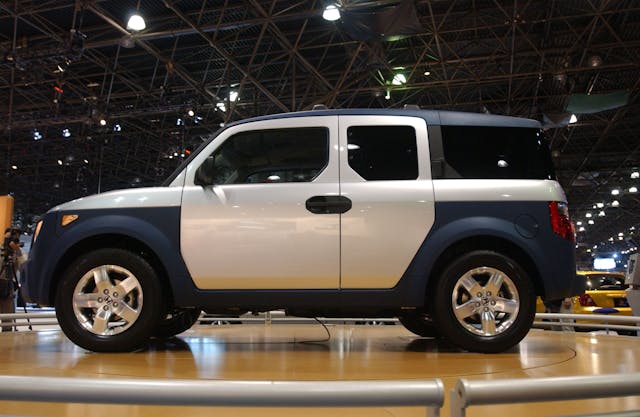
Associate Editor Nathan Petroelje has utility on his mind. It’s snowing at his house in chilly northern Michigan right now, and we’ve had to deal with him complaining about subjecting his Mitsubishi Montero‘s carpeted interior to the salty, sandy mix of crap underfoot more than we deserve. But we’re starting to think all of his whining was just him setting up the long game to swoop in and pitch this loveable toaster—well played, sir.
“I tend to think of underrated as it relates to the whole ‘you don’t know what you have until it’s gone’ sentiment. Yes, the Honda Element was nearly peak toaster-on-wheels (though the outright throne belongs to Scion’s xB in that department), but it was also deeply utilitarian, friendly as the day is long—this was a Honda, after all—and neat and funky in its own way. Folks drove the wheels off these things—several hundred thousand mile examples are commonplace. But if you could find a low mile example, particularly one with all-wheel drive? Between four driven wheels (with good winter tires!) and those plastic floors, and you’ve got yourself a wicked little winter warrior that will put a smile on your face perpetually. They’re not terribly expensive—four-figure ones are plentiful, and a great daily driver can be had for right around $15,000.
They have cult followings in certain areas, but by-and-large, I think they’re overlooked and underappreciated by society in general—for the mindset of the product planners, and for how useful they were.
Now, if only we can get big H to gin up a modern take on this quirky design!”
Sajeev Mehta: Elantra N, Aztek, Mark VIII

Okay here’s the deal: I don’t think my beloved co-workers are taking my questions seriously enough. A Corvette’s depreciation curve very rarely sinks low enough to reach that true “bargain” status. Everyone’s gonna want a Bentley in theory, and there are plenty of repair shops that will keep them running for a reasonable fee (considering the asking price for parts, that is). My beef stems from underappreciation via depreciation and neglect.
New: The Hyundai Elantra N has all the car guy cred needed in its track-tested bones, and they come with a manual transmission and a wicked pair of front buckets. But will people line out the door for one like a Mustang, VW GTI, or more expensive metal that provides no more fun per dollar than the little Korean that could? Well, perhaps that’s a possibility. But while all new cars seem to hold their values better these days (when’s the last time you saw an advertisement for Truck Month?) it’s a safe bet that the N-spec Hyundais will depreciate harder than anything else in its class. Which leads to neglect . . . and scrappage . . . and a seriously rare and underrated classic in the coming years.

Used: Do you think all crossover utilities are kinda awful? If so, how much worse was the Pontiac Aztek? Sure, the styling is disturbingly crude, which is what we all focus on. But the absolutely vulgar commitment to functionality and practicality cannot be understated. It’s based on a GM’s ubiquitous U-body minivan platform, so the seats pop out with ease. The Aztek was designed for camping, for crying out loud! Be it classic Fiat Multiplas, Malaise-y AMC Pacers, or the Pontiac Aztek, these underrated statements to neglect and depreciation usually get their day in the sunlight—eventually. But the Pontiac can’t get there soon enough, because I reckon it’s aging better than your average crossover utility from the 2000s. Simply put, it deserves better than a death next to an early Ford Escape in the junkyard.
Classic: The Lexus LC reminded me about my personal bias toward the Lincoln Mark VIII. I’ve owned two, and my current one feels as good as a new car (ancient four-speed gearbox notwithstanding) in terms of performance and eye-catching styling. Yet these minimalist, 280-plus-horsepower machines lack the classic car cache of their wood-paneled Lexus and Mercedes counterparts. I reckon they sell for less than a Northstar V-8-equipped Cadillac Eldorado that’s about to munch on a head gasket, too. If I’m right, that’s the textbook definition of an underrated automobile.
The post Our Two Cents: The most underrated vehicle on the market? appeared first on Hagerty Media.
]]>
Seventy years ago, on January 17, 1953, forty-five thousand people attending General Motors’ Motorama at New York’s Waldorf-Astoria hotel witnessed a sports car revolution. It was the birth of a racing-inspired, American two-seat roadster—at an attractive price. With Chevrolet today unveiling the E-Ray, its first-ever hybrid, all-wheel-drive Corvette, in New York, let’s take a look back.
The Waldorf’s plush velvet grand ballroom was decorated to the rafters hosting what amounted to an early modern American auto show. Guide models were adorned in designer gowns. Choreographed orchestras, singers, and dancers provided background entertainment. While GM’s top four divisions all presented dream machines, it was the company’s entry-level Chevrolet brand that stole the show.
At this juncture, the Corvette was but a hypothetical showroom sibling to Bel Air sedans and Chevy pickup trucks. Leave it to Harley Earl, perhaps the most powerful and influential design boss in automotive history, to ram his Corvette concept through the corporation and to the Waldorf with minimal resistance. Soon, the Vette was on its way to an assembly line.


In the fall of 1951, Earl provided GM’s one-off Buick LeSabre to serve as the pace car at a major Watkins Glen, New York, road racing event. Thoroughly dipped in the day’s European sports cars at that meeting, Earl returned home convinced that America deserved its own sports car capable of running with contemporary British and Italian two-seaters.
“Project Opel” began in a secret corner of GM’s Detroit design department with four of Earl’s most trusted designers diligently advancing his whim toward reality. Half a dozen GM sculptors and engineers soon joined the team.
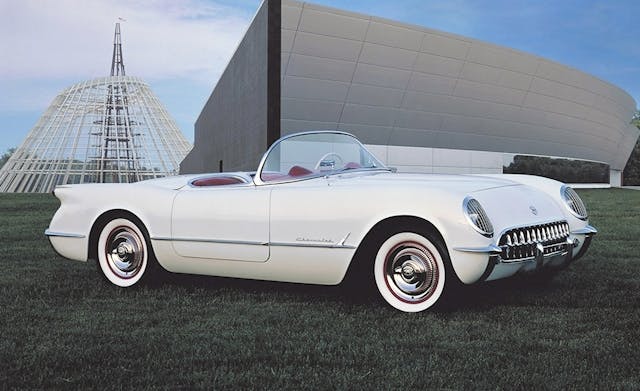
Project Opel was no pipe dream. With a wide, low body over a lean 102-inch wheelbase, its form blended aggression with Fifties modernity. Chassis and driveline components varied only where necessary from hardware in production throughout GM. Boxing the frame rails was deemed necessary because of the engineers’ desire to experiment with molded fiberglass for the body—a material less stiff than traditional steel stampings.
Less concerned about the mechanical details, Earl’s styling team borrowed an existing Chevy six engine, two-speed Powerglide automatic transmission, and rigid rear axle from GM parts bins. To add zing, the inline-six was boosted from 115 to 150 horsepower with higher compression, more aggressive valve timing, and triple carburetors. With an eye on weight distribution, the engine was mounted as low and as far rearward as possible.

Throughout 1952, Project Opel advanced through clay model to wood and plaster forms for upper management review. While there was widespread enthusiasm for the project, GM President Harlow Curtice withheld production approval until he had some customer feedback in hand. That hesitancy didn’t hinder engineers from assuring that Project Opel could make a swift pivot to the production line.
The first running prototype wearing “engineering car #852” and “EX-52” labels was finished a few days before Christmas 1952. Still missing at this juncture was a compelling name. Myron Scott, a member of Chevy’s public relations department raised his hand to suggest CORVETTE. In 1935, the clever Scott had created the Soap Box Derby with Chevy’s backing.
During World War II, the Corvette name was employed by the British Navy for its compact fast attack ships. Bringing the right ring to the game, the Corvette nameplate replaced engineering code identifiers only days before the Motorama show’s opening.

Attendees were clearly excited viewing the Corvette and were anxious for answers to their how-soon, how-much inquiries. Lacking proper market assessment, Curtice took the pulse of the crowd; on the show’s second day he announced that production would commence as soon as possible.
While there were hopes of eventually using steel for the Corvette, between July and December of 1953, 300 salable fiberglass-bodied Corvettes were built at an interim production plant in Flint, Michigan. Today, those cars are priceless collectibles even though their driving and performance attributes are modest by any standard.
You’d rightfully expect that the 852/EX-52 Motorama show car would be the uncontested Mona Lisa of this limited-production group. That’s not the case; with no thought of saving the show star for future admiration, it was unceremoniously parted out after accumulating 111 miles on the 1953 U.S. show circuit. The chassis was rebuilt and modified for use under the 1954 Motorama Chevy Nomad Station Wagon. The body was shipped to GM’s proving grounds where engineers lit it afire to assess the flammability of fiberglass body panels.

On the brighter side, one individual in the Corvette’s debut crowd was about to greatly energize its cause. Zora Arkus-Duntov, a 43-year-old, Belgian-born, unemployed engineer and race driver, was smitten by the Corvette at first sight. While he thought this was the most beautiful automobile he’d ever seen, he was deeply disappointed by what laid under the fiberglass panels.
Determined to remedy those faults, Arkus-Duntov wrote compelling letters to Chevy’s chief engineer Ed Cole and other GM managers that earned him a job as an assistant staff engineer at Chevrolet. On May 1, 1953, Arkus-Duntov began his GM career and promptly began converting the Corvette from a shallow beauty into a world-class sports car. The rest is history.
Seventy years later, Arkus-Duntov is long gone, but his driving spirit shines brightly, and particularly throughout the Corvette’s eighth generation.





Check out the Hagerty Media homepage so you don’t miss a single story, or better yet, bookmark it.
The post On this day in 1953, America met the Corvette appeared first on Hagerty Media.
]]>
For a detailed technical breakdown of the Corvette E-Ray, beyond the scope of this First Ride, click here.
It’s a cold, damp day on Black Lake. The 40-degree weather and intermittent drizzle at GM’s Milford Proving Grounds skidpad are not ideal for the hard launch of a sports car. Bill Wise, the development engineer at the wheel, is not concerned.
“Do you get motion sickness?” he says. “Because with launch control, this thing seriously takes off.” The growl of a Chevy small-block rises in pitch before a plateau, ready to let loose when Bill releases the brake pedal.
“Not in a car,” I say.
Those words are barely out of my mouth before all four of the E-Ray’s wheels hook up. Butterflies hit my stomach. The acceleration is surprisingly aggressive—ruthless and immediate, like a Tesla, but made stranger, a moment later, by the combination of V-8 roar and space-age electric motor whine.

The rate at which scenery melts does not decrease with each shift snapped off by the gearbox. I am simply pressed further into my seat. As Wise stomps on the brakes, the E-Ray converts kinetic energy to electricity, then feeds that juice to the 1.9-kWh battery pack nestled in the tunnel between the seats. We come to a halt.
The faint whine of an electric motor, the crazed four-wheel clawing at launch—these are strange phenomena for a Corvette. Like watching Rambo in Italian—familiar characters, but a language you’ve never heard them speak.
The E-Ray is unlike any other Corvette. It is the first Vette with all-wheel drive. The first to use an electric drive motor. And the first to see 60 mph, from rest, in just 2.5 seconds. That’s a tenth faster than the 670-hp Corvette Z06. The 1500-hp Bugatti Chiron, with its four turbos, sixteen cylinders, eight liters, and $3 million price, does the same job in 2.4 seconds. The E-Ray will start at $104,295.
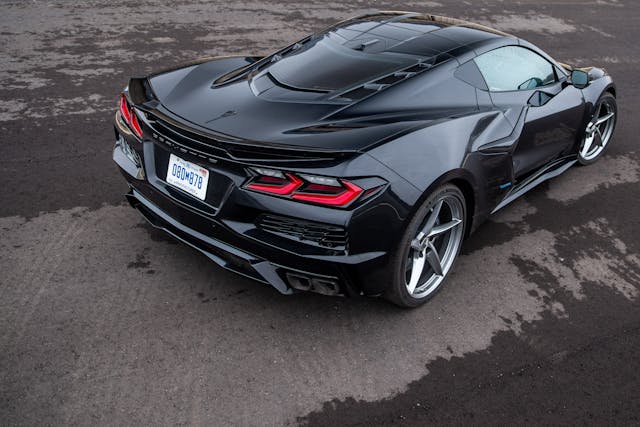
Many sports-car fans raise their eyebrows at the H-word. “Hybrid” can bring to mind a bean-shaped commuter like the Toyota Prius, but the E-Ray is nothing of the sort. More appropriate comparisons would be the McLaren P1, the Porsche 918, or the Acura NSX—performance cars of unquestionable focus, capable of harnessing electricity for performance and drivability, not just fuel economy or reduced emissions. It helps to remember that the E-Ray was baked into the development of the eighth-generation Corvette (C8) from day one, so the car is no afterthought.
General Motors claims for the E-Ray a total of 655 system horsepower, a combination of the 495-hp LT2 V-8 driving the rear axle (essentially the engine from the current Corvette Stingray), and the 160-hp, 125 lb-ft battery-electric arrangement powering the front. Both front wheels are driven by a single electric motor, via an open differential. From the right seat, the E-Ray’s front wheels seem to respond instantly to the throttle pedal. If the driver asks for more than 30 percent throttle or requests more than .15 g of straight-line acceleration, the V-8 wakes up.


The E-Ray shares its wide body, its suspension setup, and its Magnetic Ride Control dampers with the Z06. Several engineers, however, told me that the former car’s development brief was completely different: all-weather capable and angled more toward daily driving, while offering performance significantly beyond that of the base Stingray (and within spitting distance of the Z06’s ability).
“This thing is a champ in the snow, even on the standard all-season tires,” Wise says. “And here, on those same tires, you can take advantage of so much mechanical grip.”


He shows me. We knife toward the middle of the 67-acre Black Lake, entering an autocross-like cone course at roughly 90 mph. “This was never slated as an out-and-out track car, like the Z06, but it is just as capable around a race track.”
Wise stabs the throttle and cranks the steering left at the entry to a long sweeper. As the E-Ray scrubs speed, he initiates what feels, at first, like a rear-drive Corvette slide. He adjusts the car’s angle of attack with his right foot, the steering wheel hardly moving. Just before the turn’s apex, the E-Ray begins to briskly accelerate toward corner exit, never breaking the slide.
I’m at a loss. “Damn, Bill.”
“Only five minutes behind the wheel, you’d be doing the exact same thing, corner after corner,” he says. “It’s that approachable.”
Wise keeps driving. The course changes, the long sweepers replaced by a series of quick direction changes. The E-Ray negotiates the tighter corners with ease, flat and stable, the nose quickly taking a set.

Hybrids often suffer from mass bloat, a ballooning of curb weight over similar internal-combustion-only models. A visit to Milford to meet a preproduction Corvette usually means hearing someone in Chevrolet engineering declare that “every gram has to earn its way onto the car.”
This approach is common in the development of high-performance cars, but the Corvette team does it better than most. The engineers there seem to take joy in justifying each component or material down to the tiniest detail. The battery, for example, is not from GM’s Ultium family, where the hardware and its controls are generally larger and storage-optimized for long range. The E-Ray’s lighter, pouch-type LG battery was better suited to the car’s performance focus, its front axle’s demands for frequent and significant energy flow.

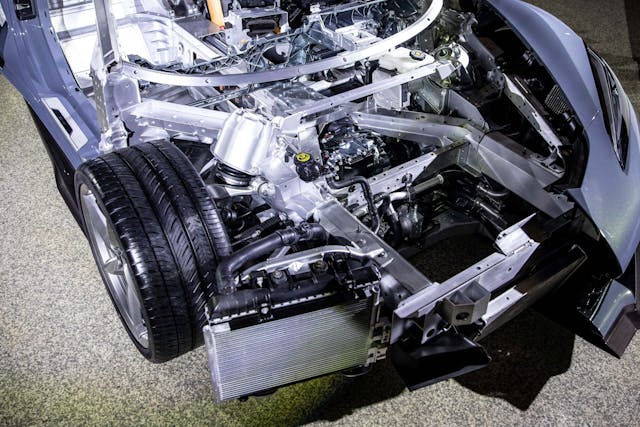
That axle system adds about 260 pounds of curb weight. Mass-reduction efforts to offset that gain include standard carbon-ceramic brakes and a lighter, lithium-ion chemistry for the gas engine’s 12-volt battery. The electric drive unit’s housing is magnesium, with associated fasteners and the bottom of the drive battery’s housing in aluminum. The aluminum brace between the front shock-tower tops is claimed to genuinely improve steering feel at speed, helping compensate for the slight changes in front suspension geometry required by the packaging of that front axle.
Important, too, is how little the added mass shifts balance forward. Thirty-nine-point-four percent of the Z06’s weight sits up front, 60.6 percent in the rear. The E-Ray shifts that distribution by only 1.5 percent, to 41/59.
We’ll feature a full drive of the E-Ray on these pages soon. In the meantime, from the passenger seat, the car holds promise. It feels meaningfully more exciting and interesting than the Stingray yet more tractable and comfortable than the monstrous Z06.


By switching the Corvette to a mid-engine layout, after decades of the engine up front, the C8 vaulted America’s sports car to new dynamic heights while realizing a dream envisioned by some of the car’s early creators. An all-wheel-drive Corvette with a battery and an electric motor was not on the minds of those men, but I suspect they’d find this car a triumph of engineering.
Perhaps even more than the Stingray or the Z06, the E-Ray reflects the technology and ingenuity of the current moment. Just thinking about the ride gives me those butterflies all over again.
2024 Chevrolet Corvette E-Ray
- Price: $104,295 (coupe)
- Powertrain: 6.2-liter V-8, eight-speed dual-clutch automatic transmission; 1.9-kWh pouch-type lithium-ion battery, permanent-magnet electric motor
- Horsepower: 655 from total system (V-8: 495 hp @ 6450 rpm); (e-motor: 160 hp)
- Torque: (V-8: 470 lb-ft @ 5150 rpm); (e-motor: 125 lb-ft)
- Layout: All-wheel-drive, two-seat targa-top coupe or convertible
- Curb weight: 3984 pounds
- EPA-rated fuel economy: TBA
- 0–60 mph: 2.5 seconds
- 1/4-mile: 10.5 seconds @ 130 mph





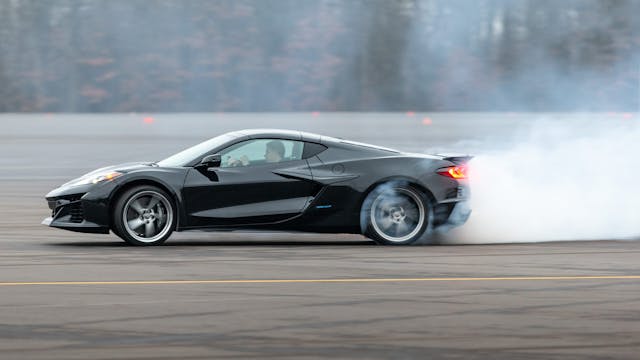













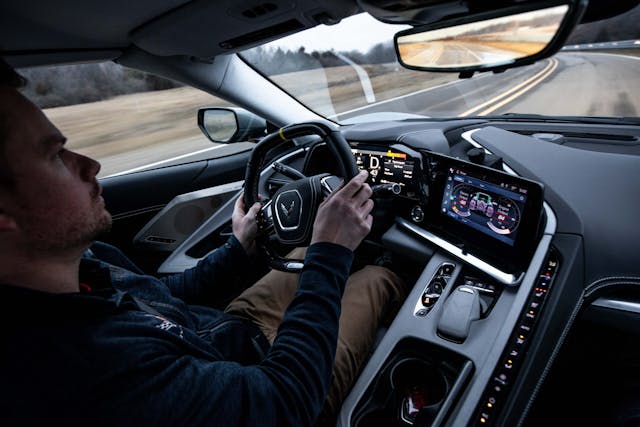
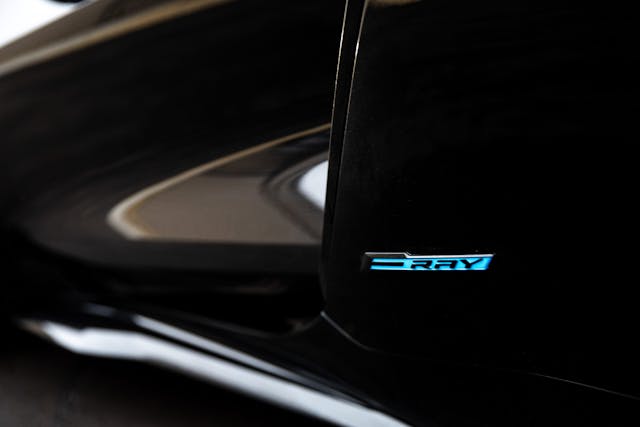




The post 2024 Corvette E-Ray First Ride: A Vette like no other appeared first on Hagerty Media.
]]>
Thus far, the eighth-generation Corvette has been defined by a number of firsts. It’s the first production Vette with a mid-engine layout. The first to offer a dual-clutch automatic transmission. And, in the Z06, the first Corvette V-8 with an exotic flat-plane crank. With the 2024 Corvette E-Ray, we can tack a few more firsts onto the list: first hybrid Vette, first with all-wheel drive, and the first to hit 60 mph in 2.5 seconds.
“In 1953, the enthusiastic reaction to the Chevrolet Corvette concept kicked off seven decades of passion, performance and American ingenuity,” said General Motors president Mark Reuss. “E-Ray, as the first electrified, all-wheel-drive Corvette, takes it a step further and expands the promise of what Corvette can deliver.”
(To get a sense of just how special the E-Ray is, we sat shotgun with the E-Ray lead development engineer on an enlightening, tire-smoking thrill ride around a skidpad at GM’s Milford Proving Grounds. Please click here to read about that ride-along experience.)
If you’re here for the hard numbers, wait no more. Here’s everything we got from our visit to Milford:
Powertrain

Let’s start with the known quantity, the LT2 V-8. It’s essentially a carryover internal combustion engine (ICE) from the Stingray Z51, making 495 hp and 470 lb-ft of torque, delivered to the rear wheels via the same Tremec eight-speed dual-clutch automatic transmission and electronic limited-slip differential.
Up front is the electrified drive axle, completely decoupled from the rear. A single permanent-magnet electric motor directly drives front wheels via an open differential. There is no plug-in functionality. Drawing energy from the 1.9-kWh lithium-ion battery, the motor can provide up to 160 hp and 125 lb-ft of torque. Combined with the gas engine, that’s a total system output of 655 hp—15 fewer than the Corvette Z06. Engineers chose this type of drive unit, rather than, say, in-wheel electric motors, for its packaging efficiency as well as its functional simplicity.
The battery is a pouch type, with 80 cells divided evenly into 4 modules (20 cells per module). All battery components are housed within the Corvette’s central tunnel—an aluminum backbone for the space frame that, aside from cooling hardware running through the top, is empty in the Z06 and Stingray. This is but one example of how the E-Ray was, from the get-go, planned as part of the C8 Corvette’s development.


LG makes the battery cells, which are packaged and assembled at GM’s Brownstown, Michigan battery plant. While the Ultium cells that are used in GM’s EVs are designed for large storage and long-range, the E-Ray’s battery is small and optimized for in-and-out power flow. Using a power inverter that also fits neatly inside the tunnel, the electric motor can serve as a generator to charge the battery during coasting and other driving situations. (There are six driving modes, one of which is called Charge+ and focuses on feeding the battery.) Regenerative braking also aids in battery charging.
The electric front axle can propel the Corvette E-Ray at speeds up to 45 mph, at which point the V-8 will fire, bring up the rpm to match speed, and the transmission will engage to ensure a smooth addition of torque. The process takes a couple of seconds. The V-8 will kick on before 45 mph if the driver requests more than 30 percent throttle or 1.5 g of acceleration, or if the HVAC system is manually activated. The front axle can work in concert with the LT2’s cylinder deactivation, which means highway efficiency can be maximized with four-cylinder hybrid power.
In so-called Stealth Mode, which exclusively uses the front axle, the E-Ray has about 4 miles of all-electric range.

eAWD
While quiet start-ups that don’t annoy neighbors are helpful, and pure-EV capability at city speeds will make the E-Ray usable in European cities that ban downtown emissions, those are not the only reasons GM built the E-Ray. Corvette engineers insist that the combination of all-wheel drive and on-demand torque makes for a special, approachable high-performance sports car experience, to say nothing of the increased capability and control in foul weather.
According to Lead Vehicle Development engineer Mike Kutcher, the main advantage of the electrified front axle is its ability to pull the E-Ray out of a curve. “We tuned it to behave and feel primarily as a rear-wheel-drive car on corner entry and in the mid-corner, settled properly with our eLSD tuning,” Kutcher noted. “Then, with the rear hung out, you can call on the front axle for the torque to power out of the curve.
“What some manufacturers are doing on the ICE output shaft, we do via controls on the front axle. We took this approach for the modularity benefit, and to do it we have to use advanced propulsion controls.”

There is no clutch on the front axle, so the E-Ray uses brake-based torque vectoring there instead. The software’s different drive modes allow for varying degrees of yaw on the rear axle, but as the rear end loses stability the E-Ray will shift the percentage of torque the driver requests to the front axle. Using a combination of data such as speed, acceleration request, steering angle, and available traction (friction coefficient), the car’s software can determine where it thinks the driver is trying to point the car.
As Lead Performance Engineer Bill Wise explained, the hybrid system provides additional composure that is noticeable on any surface. And on a road course, it’s no less capable than the Z06: “The E-Ray was never slated as an out-and-out track car, but we’ve put just as much track work into it in development. It is as capable as the Z06 around a race track. But the front axle allows us to reduce some compromises; we can improve stability, for example, by leaning on that front axle … and not only is it fast, but the peak is so broad that you can throw the average customer into it and not have them in over their head.”

Wise also said that the E-Ray is “a champ” in the snow. Using the same dedicated winter tire as the Z06, the E-Ray turns into a “rocket ship,” but the standard all-season tire is no joke, he said. “This car does things in the snow you wouldn’t imagine the Corvette would be capable of. Where an average car on our snow circle would do 45-55 mph, the E-Ray will do 75-80. It’s almost scary.”
Chassis
The E-Ray shares its wide-body proportions with the Z06, meaning it sits 3.6 inches wider than the Corvette Stingray. It shares the Z06’s wheel and tire size: staggered 20 x 10-inch wheels with 275-width tires up front and 21 x 13-inch rears with 345-width tires. Standard fitment is the Michelin Pilot Sport all-season tire, wrapped around five-spoke wheels unique to the E-Ray. The Z06’s Michelin Pilot Sport 4S summer tire is available as part of an optional performance pack, which also unlocks carbon-fiber wheel options and a taller wicker bill for the rear decklid.
Weight savings was a big focus on the E-Ray. Brembo-brand carbon-ceramic brakes are standard, the electric drive unit case is made of magnesium and held together with aluminum fasteners, and the 12-volt combustion engine battery is a lighter, lithium-ion unit. It weighs 3774 pounds, or about 265 pounds more than the Z06.

“Considering the performance enhancement of all wheel drive as we’ve done it here, compared to if we did it in a conventional mechanical way, that is certainly very light,” said Corvette Chief Engineer Josh Holder.
The electrified front axle effectively shifted overall weight balance forward by 1 percent, to 41/59 front/rear. The battery is structurally integrated into the chassis, and the bottom of the pack is reinforced with an aluminum plate—rather than the carbon-composite piece in other Corvettes—for extra rigidity.
The E-Ray suspension features specific spring rates and roll rates. “It’s to help react to the added front mass and optimize the tire contact patch,” explained Holder. The standard Magnetic Ride Control (MR 4.0) feature three distinct settings but is generally tuned softer than the Z06 and firmer than the Stingray Z51, but closer to the latter on that spectrum. The stabilizer bar tuning is common in the rear, and only slightly different up front.


Wherever possible, the Corvette team sought to minimize changes compared to the Z06. If something required adjustment it got it, but engineers maintained an “if it ain’t broke, don’t fix it” approach to the E-Ray chassis. On the front control arms, for example, the bushings are identical but the geometry had to be slightly modified to make room for the drive axle. This resulted in a slightly taller shock cap, which engineers compensated for with a unique “tower-to-tower” brace made from aluminum. The brace, they say, adds stiffness and improves down-the-road feel through the steering wheel.
Design
Aside from the subtle changes to the front grille, plus some web-like bumper inserts in the space between the taillights and rear diffuser, the E-Ray sports a mix of Stingray and Z06 cues. While the body shares its footprint and overall shape with the Z06, the square-tip quad exhaust has the same layout as the Stingray.

The E-Ray will have four finishes for its aluminum wheels, three finishes for the carbon wheels, fourteen paint options (including the new-for-2024 Riptide Blue, Seawolf Gray, and Cacti), and a model-specific Electric Blue stripe package. Inside it’s more familiar fare, but the E-Ray’s debut does bring with it a new Artemis Dipped interior, which reads in person like a greenish gray and will only be available on 2024 Corvettes.
The only differences to the E-Ray cockpit compared to other Corvettes are the unique power output and electrical system efficiency display modes, as well as the physical button on the driver’s side of the center tunnel. The button can change the drive mode to Charge+ on demand, making it easy to ensure the battery is charged up for later use.



How it stacks up
In terms of price, the E-Ray sits in the Corvette lineup pretty much right alongside the Z06, which starts at $106,395. The E-Ray 1LZ coupe starts at $104,295, while the 1LZ convertible starts at $111,295.
Engineers told us that the E-Ray is more of a corollary to the Z06 than it is positioned below it, though the latter car is unquestionably more of a scalpel on the track. Here’s Bill Wise, performance engineer, on how he sees the difference:
“The E-Ray is incredibly approachable. Because we’ve got the big, wide tire package from the Corvette Z06, it means a lot of added capacity from a mechanical grip standpoint. More so than you’d have on the Stingray, but then you don’t have quite the Z06’s power. The performance peak ends up being really broad, which means you can drive the E-Ray up on the peak of the tire for a long time.”

If this sounds a bit like the Corvette Grand Sport from the outgoing C7 generation, which combined the Z06’s chassis with the Stingray’s V-8, you’re not far off the mark. But without a doubt, the hybrid component brings a new dimension to Corvette performance.
Kutcher, the E-Ray’s lead development engineer, said it best: “We took what’s already great about the Stingray and asked how we could make it better. What we got is the quickest Corvette ever, all-wheel drive capability, electrification—a totally different kind of step up. A totally different car than the Z06, and still a Corvette.”
The E-Ray goes on sale this year—precisely when, GM is not saying. We can’t get behind the wheel soon enough.




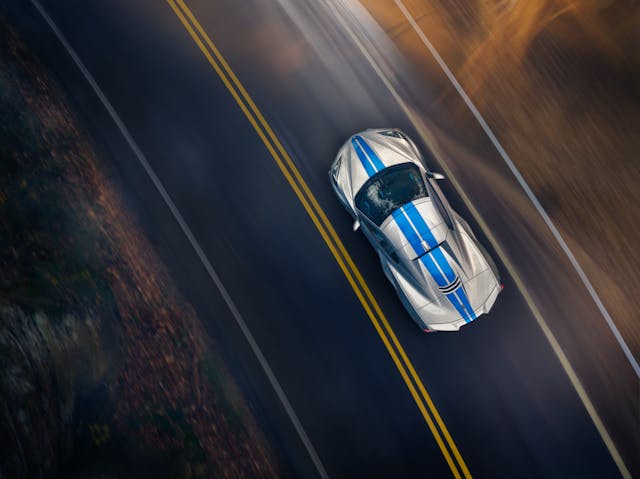




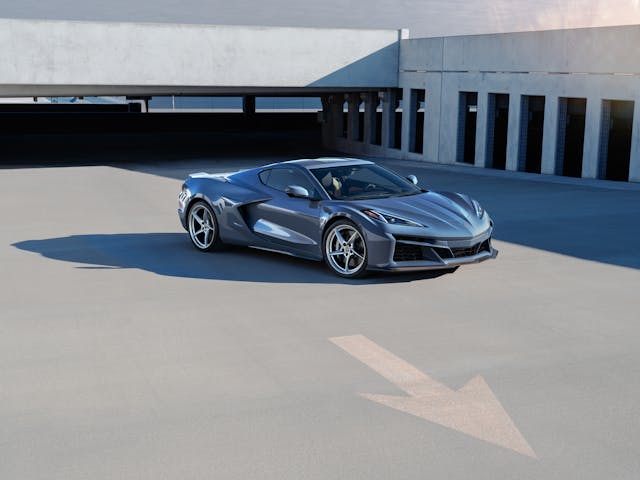







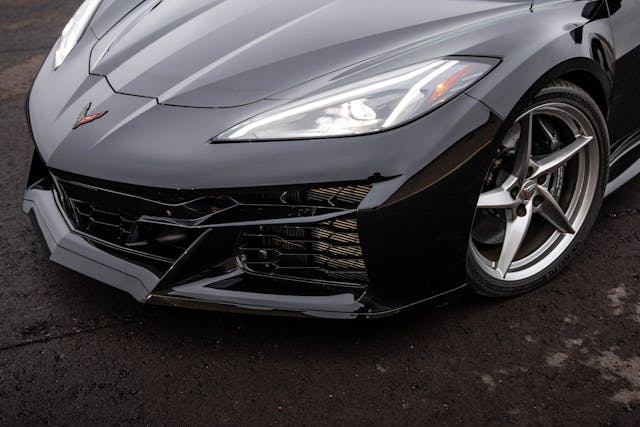















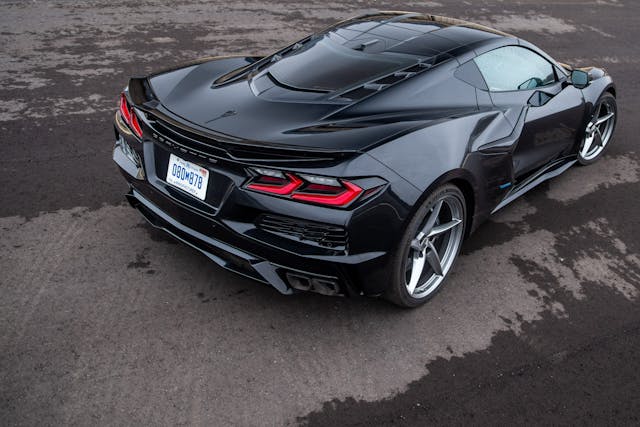














The post 2024 Corvette E-Ray Revealed: 655-hp, AWD hybrid is the quickest Vette ever appeared first on Hagerty Media.
]]>
The upcoming launch of an all-wheel-drive, hybrid C8 has been one of Team Corvette’s worst-kept secrets. The E-Ray name was discovered ages ago, and spy photos keep popping up. Then there was the configurator leak just a month back, and more spy shots confirmed the look. Finally, thanks to an Instagram post by Corvette, we now know that we’ll get to see the full hybrid Corvette package on January 17, which is also when we can expect select members of the media to get their first in-person looks and ride-alongs.

So what can we glean from this short video? Well, the snowy location provides a big hint that it’s AWD but the real solid info comes from the soundtrack that’s split between a V-8 growl and the near silence of electric-only propulsion, backed up by a shot of the driver switching between “Stealth” and “Normal” modes to trigger that transition. The Corvette’s center screen displays the modes with a profile photo of the E-Ray and a line in the back of each mode that seems to depict a sound wave. The subdued nature of that sound wave visual in “Stealth” mode seems to imply that there’s much more than just a V-8 powertrain and a variable exhaust that can keep things hush-hush. Indeed, the video leaves little doubt that the E-Ray will be capable of electric-only propulsion.

Now that we have just one more week before the reveal, the time for speculation about the E-Ray is almost over and our myriad questions about the model will soon be answered. What is the battery capacity? What is the electric-only range? Most importantly for many of us, just how much power and performance will be added by those nose-mounted motors driving the front wheels? Since there are no concrete details, we’re wondering if the 83-hp Ultium motor that was revealed almost a year and a half ago will make an appearance up front or if Chevrolet has managed to keep a more special-purpose electric propulsion system under wraps this whole time. A pair of those small Ultium motors would make for a 660-hp AWD hybrid that would have plenty of electric-only grunt to pull the C8 along without help from the 6.2-liter LT2 V-8. What’s more, that sort of power would slot the E-Ray in just below 670-hp Z06, although we don’t recommend thinking of the two as direct competitors within the Corvette family.
What do you think, will the E-Ray’s total horsepower come in under or over the 670 hp of the current Z06?
Check out the Hagerty Media homepage so you don’t miss a single story, or better yet, bookmark it.
The post Corvette E-Ray will bow next Tuesday with an all-electric “Stealth” mode appeared first on Hagerty Media.
]]>
Via the Corvette Nut YouTube fanboy site, it appears that Chevrolet has offered up one of the sanctioned-but-not-sanctioned Corvette E-Ray videos with the new car playing in the snow, using power at all four wheels. The hybrid Vette tears up the snow-capped field (difficult to tell where—definitely been no shortage of snow-capped fields out there) and makes us wish we were in the driver’s seat.
It doesn’t look quite as polished as the official 25-second clip revealed on YouTube before Christmas that pointedly shows all four wheels getting traction in the show, but it appears to be the same place—perhaps Chevrolet just packaged up some outtakes to get us talking about the car. Which we obviously are.
We’re expecting Chevrolet to go formal and introduce the car soon (the Chicago Auto Show in mid-February, perhaps? Should be some snow to play in there), and perhaps give us a price.
The base coupe starts at $65,895, and we’re anxious to see if you’ll have to buy some pricey packages to get the hybrid E-Ray. Another $10,000–$15,000 perhaps? It’ll be way under the $105,300 Z06, but adding batteries and a couple of motors up front isn’t cheap, so we’re wild-guessing $79,900.
We’re especially interested in checking out the packaging since the Corvette doesn’t have a lot of wasted space under the skin to begin with. We’ll be curious about the extra weight as well. All this off-roading makes us wonder if, down the road, Chevrolet plans to raise the ride height and bolt on some all-season rubber to take on the Porsche 911 Dakar and Lamborghini Huracán Sterrato.
While you’re busy goofing off at work—if you’re even there—let us know in the comments if you think an all-wheel-drive, hybrid Corvette is the right next step for America’s sports car.






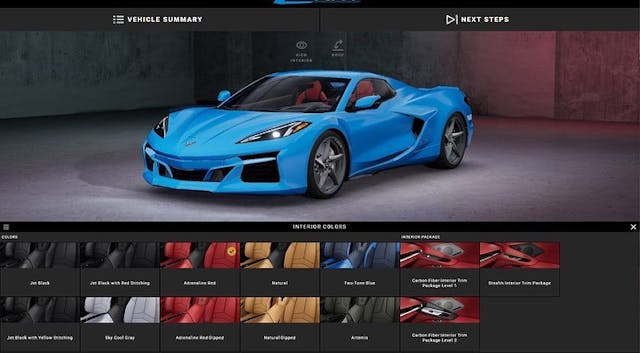



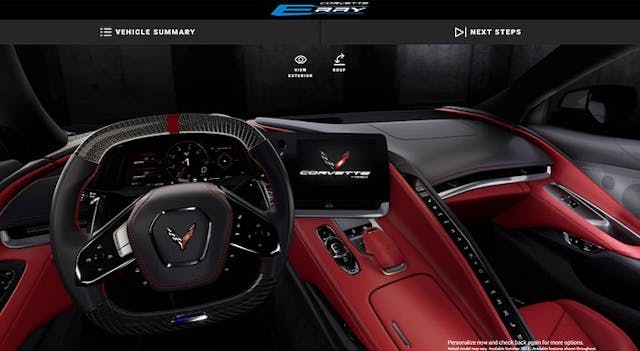

Check out the Hagerty Media homepage so you don’t miss a single story, or better yet, bookmark it.
The post Watch the AWD Corvette E-Ray play in the snow—again appeared first on Hagerty Media.
]]>
In the collector car world, there are varying interpretations of the term “rare.” Where does one draw the line? A thousand examples? A couple hundred? A few dozen? However you define it, this 1969 Corvette ZL1 convertible is certifiably, no excuses, a rare beast.
This C3-generation ZL1 is one of two, to be precise, which means opportunities to buy them do not come up frequently. However, RM Sotheby’s announced yesterday that it will auction off the famous Vette at the company’s Phoenix sale in January. What we have here is perhaps a once-in-a-lifetime chance to own the rarest Corvette produced. If it sells, the car has a legitimate shot at becoming the most expensive Corvette ever sold at auction.
If you’re sitting there asking “what the heck is a ZL1,” allow us to illuminate. Chevy’s famous L88-code, 427-cubic-inch big-block engine hit the scene in 1967. You may recall from our article on the $2.7M L88 Corvette sale last year that this big-block was an all out racing engine one could order straight from the Chevy dealer. L88s were very high-compression V-8s with aggressive cam setup. Chevy advertised a respectable 430 horsepower, but these engines were widely rumored to make more like 500 hp in period. While the L88 put down impressive numbers, big-block Chevys are incredibly heavy lumps of iron. Gobs of grunt sure helps, but shedding weight from the front of the car does a lot more for balance and overall power-to-weight ratio. That’s why the ZL1 got an aluminum-block L88.
Even the ordinary L88 wasn’t widely publicized, so the trick was knowing how to order it. Buyers had to cough up nearly $1000 on top of a car whose base price was just over $4000.
If you thought the L88 was an expensive option, the ZL1 was prohibitively so. Just the engine alone added more than $4700 to the price tag with zero other options selected, which was more than double that of the base Corvette. That cost was a big reason only two Corvette owners decided to take the plunge.
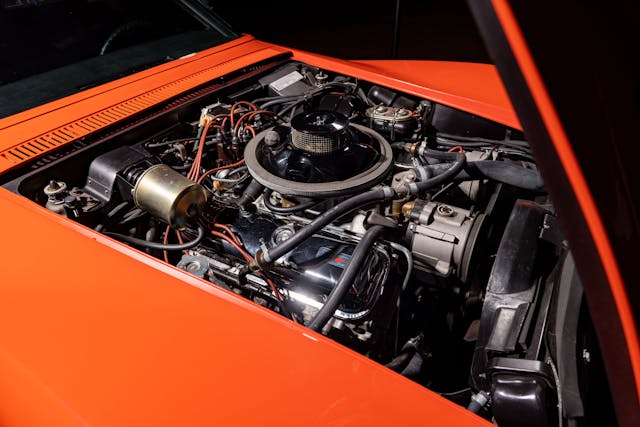
For a little more background, this will be the first time since 1991 that a Corvette ZL1 comes to public auction. The car that changed hands more than 30 years ago is this orange convertible’s sister—a yellow and black coupe that was auctioned off for $300,000 reportedly after being seized by the DEA. RM Sotheby’s car due to cross the block in Arizona next month has never been offered for public sale; it was last sold in 2007, when the current owner bought it from the original owner. It then received a restoration by Kevin Mackay in 2014 and was certified by Bloomington Gold as the first of the two ZL1s produced. It’s since been extensively shown and displayed.
Naturally, a one-of-two Corvette ZL1 doesn’t come cheap. RM Sotheby’s is listing an estimate of $2,600,000–$3,000,000. Such a result would put the sale price in the category of top three Corvettes ever sold at auction. However, given that it’s such a rare and special vehicle, with no public sales for over three-decades, and a high degree of excitement sure to surround it, a final price is anyone’s best guess.
With the all-time Corvette auction record sitting at $3.85M for a 1967 L88 Coupe, the ZL1 has a fair shot at setting a new record. Whatever happens, don’t expect an offering like this to come around again for a very long time.







The post One-of-two 1969 ZL1 is holy grail of Corvettes, could sell for $3M appeared first on Hagerty Media.
]]>
The temporary, premature publishing of the C8 E-Ray’s configurator showed us what to expect when Chevy finally decides to unveil its hybrid, all-wheel-drive Corvette. Thanks to some hard-working spy photographers, we can see the real thing and no longer have to wait to confirm some interesting cosmetic details.
Just to refresh your memory, the long-speculated hybrid, all-wheel-drive Corvette is expected to use electric motors up front and place its battery cells within the tall center tunnel that helps keep the Corvette rigid despite not having a fixed top. The added power and grip should elevate the E-Ray to another echelon of performance above the already very impressive Stingray.


Back to the photos, don’t let the Z06 badge fool you, this monochrome gray E-Ray convertible caught while out testing shows that the configurator leak was right on the money. While the E-Ray uses the widebody and side scoop of the Z06, the wide-set exhaust exits are shared with the 6.2-liter V-8-powered Corvette Stingray as opposed to the center-exit exhaust found on the Z06. Photographers also noted that this car was missing the characteristic flat-plane V-8 howl from the 670hp LT6.


To further differentiate itself from the Z06, the E-Ray will wear more body-colored trim including the side intake, engine cover, and rear fascia grilles. This Hypersonic Gray Metallic example shows that the only black trim remains on the roof, the front grille mesh, and the rear bumper’s rear valance and diffuser. Considering Corvette’s high level of customization right from the factory, we would expect plenty of those trim pieces to also be offered in carbon fiber. Of course, Chevrolet is still holding all of the cards regarding the power specs and performance metrics, which is where the E-Ray could make things very interesting.

The post Corvette E-Ray hybrid caught without camouflage appeared first on Hagerty Media.
]]>
One of the first things we ogled at the 2022 SEMA show was the gorgeous roster of cars slated to compete in the Optima Ultimate Street Car Invitational (OUSCI). The competition pits heavily modified hot rod street cars against one another in a series of timed competitions. With both late-model performance cars and pro touring takes on classic muscle in attendance, we couldn’t decide which style was hotter. One pro touring build held our attention so long that we stood there, mouth agape, for a while until the owner happened to arrive on the scene.
Garrett Randall’s 1970 Corvette has been an OUSCI competitor for the past several years. The mean green machine has spent the last four years in its current configuration, complete with oodles of black trim and autocross handling upgrades typical of the pro touring style.

The car’s original owners, a married couple in the San Francisco Bay Area, competed in autocross with the car. They sold it in the late 1970s to a fellow racer who affixed flares to accommodate wider rubber. When Chris Gonzales at JCG Restoration and Customs bought the car, he planned to reimagine the car as a pro tourer. He tore the car down to bare bones, which included removing the old fender flares and building new ones from scratch. The current look further exaggerates the flared-fender approach, and it definitely drew eyeballs during our evening photo shoot.
When Randall got involved, his initial plan was to buy a number of components from the ’70 Corvette for a separate C3 project he had cooking. Instead, Gonzales offered to sell him the whole project whole hog. After some quick calculations, Randall determined to move forward with the car as the basis of his dream road-hugging Stingray.


Texas-based JCG Restoration completed the car using a build plan similar to Gonzales’ original vision. The recipe included the muscular—and somehow very appropriate—fender flares and matching flared rockers the Vette sports today.
The color, F8 green, is borrowed from Mopar’s Charger and Challenger swatch. However, the deep emerald hue looks like it could have been an option from Chevrolet back in 1970—save for the fine metallic base. The color looks fantastic on the Corvette’s curves, and it’s practical, too; touch-up paint is readily available.
Army green pigment and bulging, muscular wheel wells? You can see why Randall opted for “C3Rambo” on his license plate.



Under the green fiberglass, JCG Restoration used Van Steel control arms with JRi coilovers and custom, adjustable anti-roll bars to keep the rubber planted. The deep dish rims (a set of 18 x 11.5-inch and 18 x 12.5-inch Forgeline GA3R wheels) were initially mounted with a set BFGoodrich Rival tires—315s in the front, 335s in the rear. But these types of autocross builds are consistently evolving, and Randall eventually went to a square tire setup (equal-sized rubber on all four corners) with Falken RT660 tires, opting for 315s all the way around. Despite being a bit narrower in the rear, the Falkens are stickier and offer extra grip.
Aero was the next major hurdle. “We got rid of the spare tire for weight but that basically created a big air pocket,” Randall explained. “At autocross speeds, it wasn’t an issue, but at larger tracks, it was creating enough lift that it was apparent. I could feel the rear lift and get a little squirrely.” The car’s “Stage 2” improvements addressed the issue with a new front splitter that redirects air, a rear spoiler to improve downforce, and the aforementioned Falken tire setup.
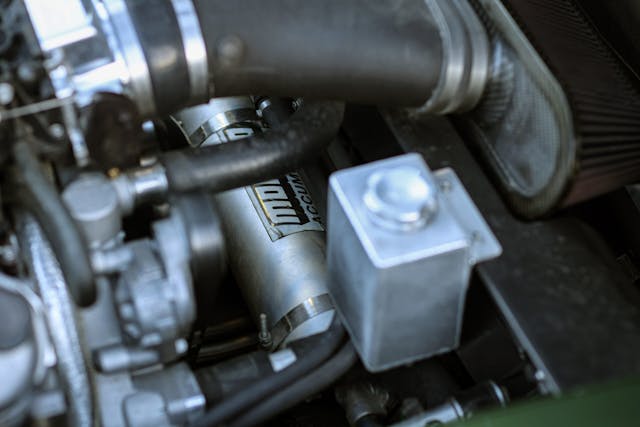
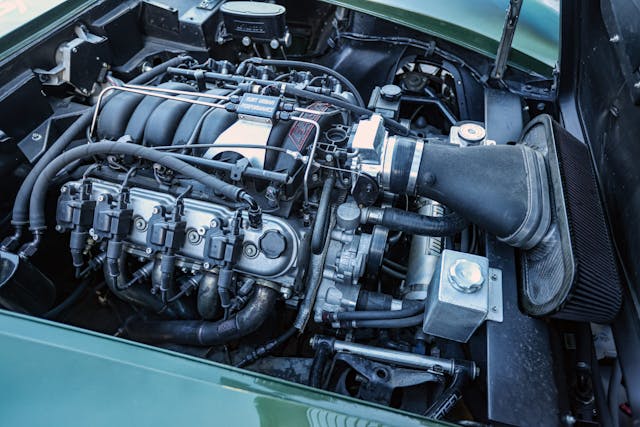
The drivetrain, by contrast, has remained unchanged over the Corvette’s five-year tenure in Randall’s care. The Stingray runs a 5.7-liter LS6 V-8, built by Mullinex Racing Engines and backed by a Tremec T-56 six-speed manual transmission. There are not a whole lot of trick parts in the engine—just a set of ported heads, a FAST aftermarket intake, and a performance camshaft. The setup puts 410 horsepower to the wheels. “Rambo” has a lot of hard miles on it, but it still sounds great and runs well.




Although he’s building an even more powerful ride to take over this car’s autocross and road course duties, Randall still is very much enamored with the green Vette. “It was good for when I was starting out,” Randall noted. “For autocrossing, you probably don’t need more than 500 horsepower.”
If Randall had to do it all over again, he wouldn’t make any major changes. Easier maintenance, maybe. As it sits now, the stereo system in the car—particularly the subwoofer and amplifier located in the cargo area—must be removed to access the bolts for the center section of the rear axle. “The battery is located behind the seat. With the roll cage it’s a pain in the ass to get to,” he explains. Another change would be to add air conditioning. “It’s a fun car to drive but there are days that it’s too hot.”

Randall has owned his share of restored muscle cars, but he consistently returns to his pro tourers when he wants to have fun behind the wheel. Cars like this C3 meld reliability and performance and deliver reasonable fuel economy.
“I love how it handles, how it rides, how it looks, how it sounds.”
Even though Randall is planning a more hardcore, track-focused car with additional power, it sure sounds like this Corvette will stay in his stable for a while. It’s a go-to driver on all but the hottest summer days.
Check out the Hagerty Media homepage so you don’t miss a single story, or better yet, bookmark it.
The post “Rambo” 1970 Corvette Stingray is an autocross show-stopper appeared first on Hagerty Media.
]]>
There’s a certain order of things in the car industry. Some brands and badges just sit higher up on the totem pole of price than others. A Lincoln is more expensive than a Ford, a Lexus more expensive than a Toyota, a 5 Series than a 3 Series, etc. Convention also dictates that a Corvette is supposed to be pricier than a Camaro.
That’s certainly the case when shopping for new cars in 2022, and it was the case in 2012, 2002, 1992 and way on back. If Chevrolet’s pony car is the working man’s whip, America’s sports car is what the owner of the company he works for drives. If the Camaro is attainable, the Corvette is aspirational. You get the idea.
So what?
When going over our quarterly updates to the Hagerty Price Guide recently, we realized the status quo has been upset for a certain Chevy performance pair, specifically from those mustachioed muscle years of the 1980s.
Not only is a Camaro IROC-Z (1985–90) worth more than the equivalent base C4 Corvette (1984–96), it’s worth a lot more. More than twice as much, actually, and this reversal of things predates both the recent boom in interest for all things ’80s cars and ’80s revival events like Radwood.
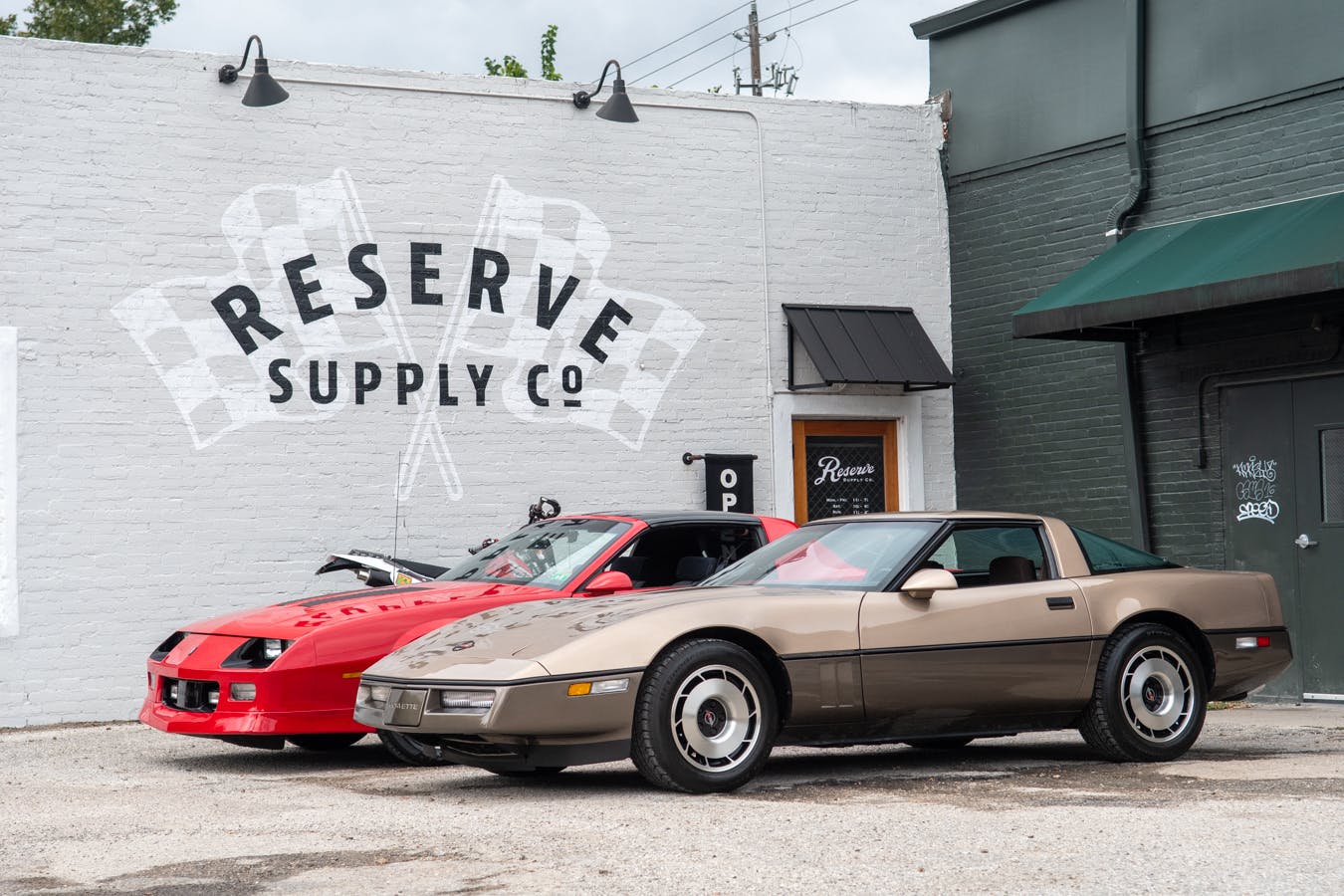

We have a major market anomaly on our hands, then. The situation is sort of like booking a guided African safari for cheaper than a trip to the local zoo, or eating at a restaurant whose steak is cheaper than the burger. To try and understand this contradiction, we found a pair of these star-spangled mullet-mobiles—Sajeev Mehta’s 1985 Corvette and Kay Yasoni’s 1988 Camaro IROC-Z —for a back-to-back drive on a (finally) cool fall morning in Houston, Texas.
We wanted to find out if, perhaps, modern car collectors are on to something that wasn’t obvious to General Motors product planners in the 1980s.
That wouldn’t be unheard of. Some of the hottest cars on the market were, at one point, thought to be attainable or less. A Mini Cooper from the 1960s can easily be worth as much or more than some contemporary Rolls-Royces; a Mazda MX-5 Miata can easily bring more money than contemporary Cadillacs and Lincolns—and that kind of makes sense.
This sort of thing happens all the time in other markets. Vincent Van Gogh died a failure. Now his works are priceless.

Debuting in 1982 and 1984, respectively, the third-gen Camaro and the fourth-gen Corvette were the right cars at the right time for General Motors. Both of their predecessors were long-in-the-tooth and near-caricatures of their former selves by the early ’80s. Thanks to computer-aided design, fuel injection and more sophisticated suspension, the General finally pulled these American sports cars out of the malaise era.
“We needed to get the Corvette back to the performance level of 1970,” said Dave McLellan, the Corvette’s chief engineer during the C4 years. Chevy mostly pulled it off, with Car and Driver calling the first all-new Corvette in 20 years “a true-born, world-class sports car loaded with technical sophistication.”
The Camaro, meanwhile, was another breath of fresh air that brought a completely new look to Chevy’s pony car, leading Motor Trend to award it Car of the Year honors for 1982.
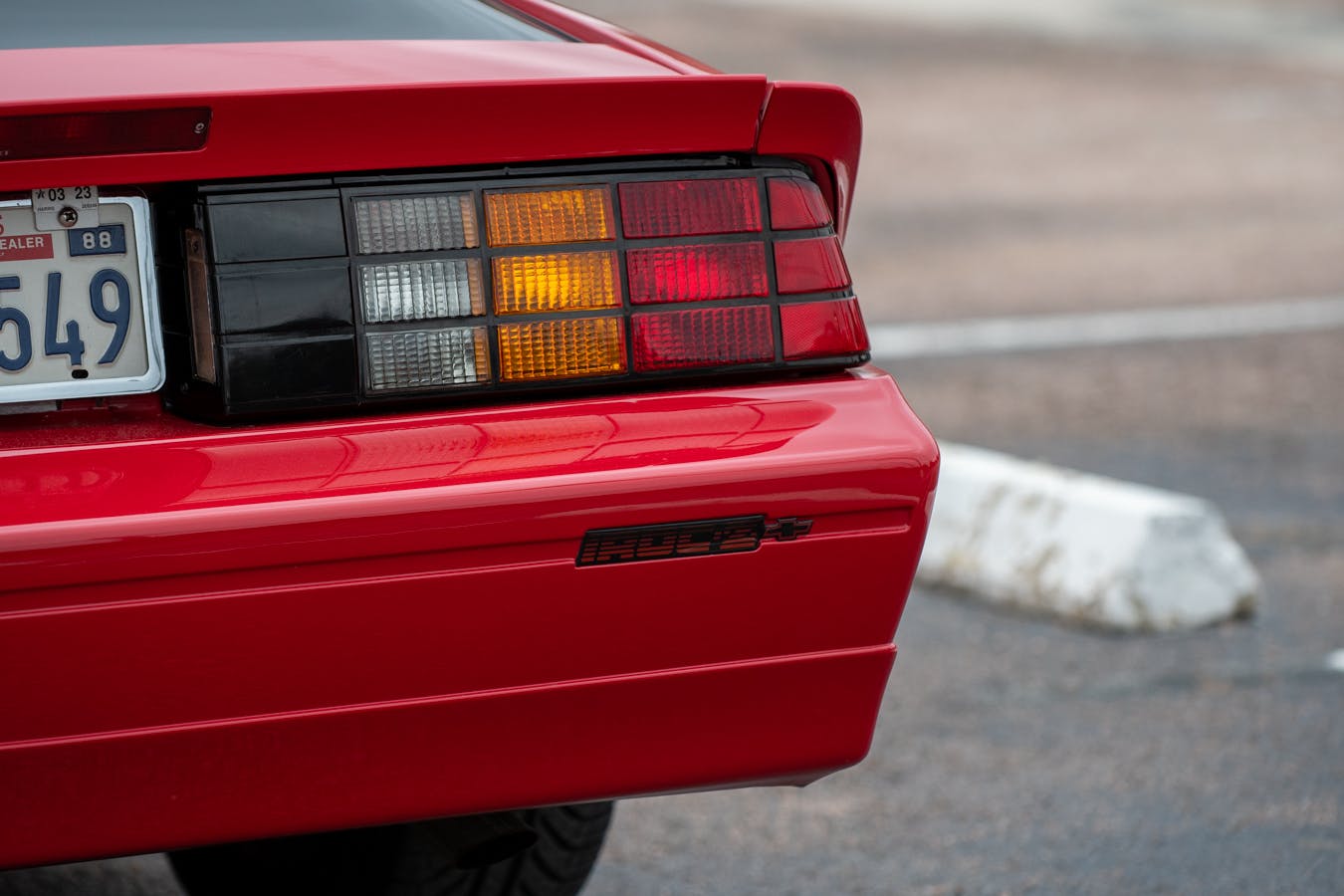



The Z28 was the speediest Camaro upon the third gen’s debut in 1982, but from 1985 to ’90 the top dog in the lineup was the IROC-Z Sport Equipment package, often shortened by funny-haired gearheads everywhere to simply “IROC.”
The $659 option took its name from the International Race of Champions, a race series pitting the stars of NASCAR, Indy, and sports car racing against each other in identical Chevy Camaros.
The actual IROC race cars weren’t much more than Camaro-shaped shells on top of a NASCAR tube chassis. But, like any good car company, Chevrolet was never one to miss a marketing opportunity and slapped IROC decals and a body kit on its latest flagship Camaro. Uprated suspension, bigger sway bars, upgraded wheels and tires, fog lights, and a choice of V-8 engines came with the stickers.
For the second half of the 1980s, the IROC was the Camaro to have, with the most power and, of course, the most flash.

For 1988, Chevrolet slimmed down the Camaro lineup by dropping the LT and Z28 models, leaving only the base coupe and the IROC-Z. Although a taller final drive was paired with the 350 engine, its output kept rising, up to 245 horses for 1990. The International Race of Champions series began using Dodge Daytonas in the ’90 season, so Chevy dropped the IROC-Z package in 1991, reinstating the Z28 as the range-topper.



Owner Kay Yasoni’s IROC is a bone-stock, Bright Red ’88 model with the desirable L98 350 and T-tops, and it has gotten the kind of restoration work normally seen on older, more valuable pony cars. Maybe it’s the color, or maybe it’s because I haven’t seen such a clean third-gen Camaro in 20 years, but this car looks fantastic, even next to the Corvette that was supposed to be the premium offering. Its wedgey angles have aged well.
The inside is straightforward ’80s GM (plastic, lots of plastic) with gray cloth seats and right angles everywhere with square vents, stereo, and switchgear. The only things that are round, other than the leather-wrapped steering wheel, are the simple gauges—speedo on the left, tach on the right, and auxiliary readouts in the middle. It’s more restrained than one might expect for a decal-laden performance car named after a race series, but it is functional.

Easy-to-remove glass T-tops offer a clear view of the sky above, and aside from a hint of red fenders and hood vents, there’s a panoramic view of the road ahead as well. I may have forgotten my Whitesnake cassette, but it turns out I didn’t need it—driving this IROC turns back the clock plenty.
As a performance car, the IROC both then and now leaves something to be desired. As a time machine, though, it’s hard to beat. It’s a fun car that people fall in love with it because it brings back memories and feels very of-its-era.

The crisp body produced 24 percent less drag than the C3, the rear hatch offered more space for luggage, and the clamshell hood offered more room to service the engine. A “uniframe” chassis combined a traditional rail frame with separate frames for the windshield and B-pillar. A removable targa roof bolted in between the A- and B-pillars.
Front A-arms and spindles were computer-designed and for the first time and made from forged aluminum, while the compact multilink rear suspension sported a transverse fiberglass leaf spring. An all-digital instrument cluster gave off Tron vibes in a time when most cars had only recently gotten an itty-bitty digital clock.

Despite that, initial reviews complained of the new Vette’s jarring ride as well as incessant creaking and rattling from the plasticky cabin. GM improved the ’85 Corvette’s ride with softer spring rates, while the 350 cubic-inch, 230-hp L98 engine debuted under the hood. The workhorse L98 would power the base Corvette until it was replaced by the 300-hp LT1 in 1992. Transmissions were still either automatic or, from 1984-88, a “4+3” manual built by Doug Nash that was essentially a traditional four-speed with overdrive on the top three gears.
And even though the IROC has a racy name, the Corvette wouldn’t be America’s sports car without some motorsports history of its own to back up those crossed flags on the hood.
In SCCA Showroom Stock GT racing, C4s swept the Playboy and then Escort Endurance Championship from 1985–87, and there was nothing the Porsche 944 Turbos could do to stop them. So dominant were the Corvettes that they were booted into the single-marque Corvette Challenge series.

The enormous door sills make getting in and out of a C4 a challenge for anyone, least of all for the 50-somethings who typically buy Corvettes. They say you shouldn’t wear a skirt when driving one of these cars, but it’s awkward no matter what you’re wearing.



If the Camaro’s interior is a cabin, the C4’s is a cockpit. A slightly cramped one that nestles you in between the aforementioned sill and an equally tall transmission tunnel, the green and orange glow of that arcade-game instrument cluster greeting you from behind the two-spoke steering wheel.
If squeaks and rattles were standard factory equipment on the C4, as the old joke goes, they left them out when building this one. It was no noisier than the Camaro. We didn’t take the roof off, though, which in a C4 allows the body to flex and creak through corners and over bumps.
Even with the roof on, a C4 lumbers and rolls through corners more than one might expect, feeling planted but certainly not light on its feet. Step on the go-pedal, though, and the car livens up, feeling as though its 230-horse, 330 lb-ft torque ratings are delivering more than what the digital speedometer is reading (a hybrid-analog-digital dash arrived in 1990; dim or failing gauges are common on the earlier cars).
These two bowties weigh within a hundred pounds of each other and share the L98 engine, but the Corvette feels considerably quicker.



When the ’80s kitsch falls away, you’re left with a more purposeful sports car than the contemporary Camaro. The Corvette is lower, quicker, more exciting. It’s a more entertaining experience behind the wheel whether you’re driving it or sitting in traffic. Even the interior’s gimmicks and eccentricities lend a sense of occasion missing in the IROC’s sea of plastic.
Of course, this is as it should be. The Corvette was then, as now, GM’s performance flagship and cost more than even a loaded IROC when new (an IROC could get to $20K with options, but the ’85 Corvette started at $24K).

Why are low-mile IROCs storming through Bring a Trailer for prices over $40,000 and even $60,000 while base C4s in similar condition are lucky to sell in the 20s?
There isn’t one big answer, but there may be a few smaller ones. One is the rarity of good-condition IROCs. Chevrolet sold third-gen Camaros by the lot, but IROCs were expensive. Kay’s red coupe is one of 24,050 IROC-Zs sold in 1988, but only about half of that number came with the big engine.
Also, many IROCs lived hard, well-used lives, and as they aged they were frequently left to the elements. Meanwhile, Sajeev’s C4 is one of nearly 40,000 Corvettes sold for ’85, and if the typical IROC buyer was out looking for a stop light drag, the Corvette owner was a middle-aged family man who only drove it on the weekends. As such, the C4 survival rate is higher, the typical mileage lower.
There’s also the fact that while the IROC-Z is top dog among third-gen Camaros, an early C4 has to look at the taillights of Callaways, ZR-1s, Grand Sports, and even later base cars. Mehta’s bronze beauty is a very nice car, but it’s no “King of the Hill” ZR-1 (although even ZR-1s remain relatively affordable).

Meanwhile, Gen Xers apparently go gaga for third-gen Camaros. Although Gen Xers make up 32 percent of the market as a whole, they own about half of the IROCs insured with Hagerty. IROC values started to soar in 2014, about when this generation of enthusiasts entered their high-earning, mid-life, fun-car-buying years. That’s probably not a coincidence.
Last but not least, there are impossible-to quantify matters of perspective. Even with the old jokes about mullet-wearing owners, these Camaros really play to nostalgia—a powerful force in any collector market. For those of a certain age, the IROC was the attainable car they dreamed of—the car the coolest kid in your high school might have driven. The C4 Corvette, rightly or wrongly, may be remembered as something your buddy’s dad drove, probably while wearing New Balances and high socks.
Even the C4’s technological advancements might work against it in the minds of collectors. It hails from an era when General Motors squandered a fortune on technical solutions, from paint-shop robots that wound up spraying each other to plastic-bodied compact cars that couldn’t match the refinement of contemporary Hondas. It’s also sort of stuck in a middle ground where it’s too new and electronic to really be considered a “classic” in the sense of a C3, but at the same time it lives in the shadow of the much faster (and today not much pricier) C5.
I still don’t get it, though. The massive gulf in value between these cars that used to share showroom space is just too big to make sense, and if one is undervalued, maybe the other is overvalued. Either way, it’s yet another case of why the car hobby is not always a rational one.
Check out the Hagerty Media homepage so you don’t miss a single story, or better yet, bookmark it.

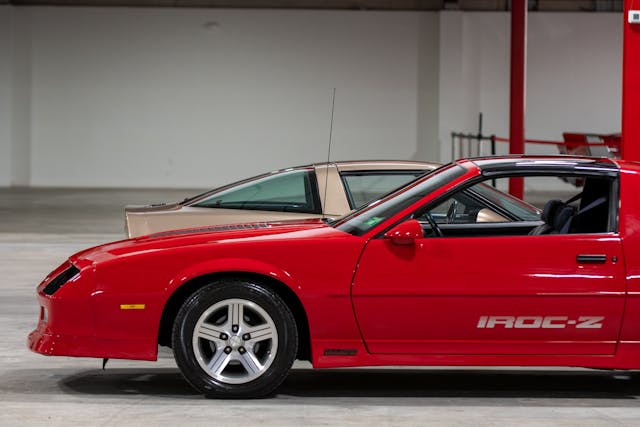


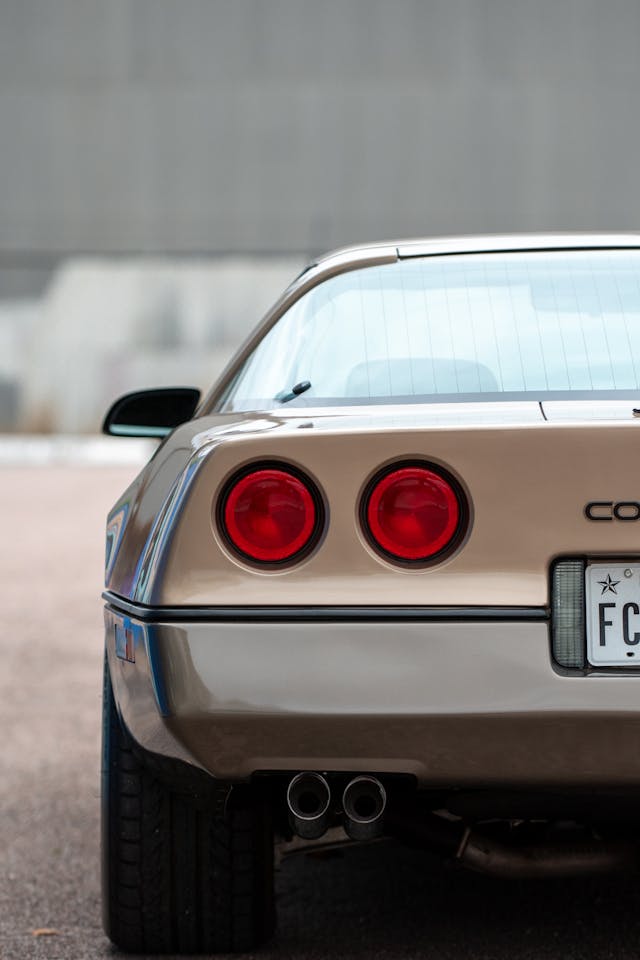
The post Why on earth is an IROC Camaro worth more than a C4 Corvette? appeared first on Hagerty Media.
]]>

Christopher writes:
What manual transmission would fit into a C8 Corvette? How about a manual in a 2021 Toyota Supra 3.0?
Sajeev answers:
This is a fun and thought-provoking question; I love it! I think manual transmission swaps will become increasingly popular in internal combustion vehicles, as they transition away from being traffic-inducing smog factories during rush-hour commuting to a dedicated mode of transport for enthusiastic drives designed for nothing more than enjoyment. Because if you want to lose to an EV with 800+ horsepower, all-wheel drive, and unassailable handling characteristics, you want to have fun doing it, right?
Joking aside, darn near any manual swap is doable with metric tons of money and labor. And hours of homework before starting anything! On the Supra, have a look at the photo above, as you will need a Euro-spec BMW Z4 2.0i for parts. If the 2.0-liter-only, six-speed manual is too weak for a 3.0-liter mill, you might be forced to only grab the pedal assembly, shifter/linkages, NVH parts (i.e. things like rubber boots), and console trim from a donor Euro Z4. The trim parts will be challenging, but fusing Toyota and BMW plastics together will likely create the finished product you so desire. And perhaps the 2.0 transmission can be upgraded internally to handle the 3.0’s torque output. Or perhaps it’s fine as-is?
Let’s assume the 2.0’s manual can handle a 3.0 Supra, but no matter what, you’ll need a computer re-flash to get the car talking to the new gearbox. And that’s another expert you’ll seek online for counsel.
Or perhaps give the folks at EAG a wheelbarrow full of money and let them make it happen on your Supra? Whatever works for you!

The C8 will be far more difficult, as there’s no platform-mate with a manual to borrow things like a bolt-in pedal assembly. But since they use a LS/LT small block Chevy motor, odds are the fine folks at Ultima Sports Ltd. already found a way to adapt a Porsche transaxle to the C8’s engine. Will cubic money be involved in getting them to share their trade secrets? Yes.
Then again, maybe someone like Weddle Industries can make this happen with less pain. Once the bellhousing adapter is sorted, spending the time and money to fabricate a functional set of pedals, a shifter/cable subsystem, powertrain mounts, and ECU tuning will net amazing results. Perhaps someone can scan the C8’s console trim plate, then engineer/3-D print a new one that incorporates a manual transmission shifter/boot. Odds are the wiring harness for all the switchgear will need a bit of work too, but that’s what extra plugs and lengthening wires are for. Oh, and any holes drilled to get shift linkages and/or wires back to the transaxle will likely need reinforcement to ensure the C8’s integrity remains intact. You know, easy stuff like that.
Sigh, this is getting far too complex for most of us. But who knows, when done this can be replicated as a kit, one that others will pay big money for. I see a nice little revenue stream for the forseeable future for anyone crazy bold enough to make this happen for C8 owners. There’s a pretty good chance that General Motors will never offer a stick shift again, so you’ll have no competition. Well, until someone comes out with their own kit by ripping yours off, and offshoring the production on a scale most folks can’t fathom. But hey, ’twas better to have loved and lost than never loved at all, right?
Have a question you’d like answered on Piston Slap? Send your queries to pistonslap@hagerty.com, give us as much detail as possible so we can help! Keep in mind this is a weekly column, so if you need an expedited answer, please tell me in your email.
The post Piston Slap: Of manual transmissions in C8 Corvettes and Supras appeared first on Hagerty Media.
]]>

Around this time last year, the Hagerty staff was abuzz with discussion about a set of spy photos that we believed caught the 2024 Corvette E-Ray out in the wild. Late last night, CorvetteBlogger.com stumbled across what is believed to be the E-Ray, accidentally leaked to the public through the Corvette visualizer (Chevy’s name for the C8’s online car configurator).

What CorvetteBlogger discovered falls neatly in line with the spy photos that we received last year. If the visualizer is indeed correct, the 2024 Corvette E-Ray will utilize the wide-body design of the C8 Z06, replete with the Y-shaped side-inlets and the same front fascia. On the E-Ray, it looks like the front fascia’s horizontal winglets will be color-matched, instead of blacked-out like they are on the Z06. Ditto the inlet covers.
More similarities to the spy shots: The car on the visualizer features exhaust tips placed at the outermost corners of the rear end, a la the standard C8 Stingray. That would lead us to believe that this brute will be powered by the same 490/495-hp LT2 6.2-liter V-8 that you’d find in a normal C8, not the 5.5-liter flat-plane-crank screamer that powers the Z06.

The visualizer doesn’t offer a peek under the front hood, but the E-Ray nameplate all but guarantees an electrified drivetrain. In a recent article covering the news that GM was spinning Corvette into an entire sub-brand, we speculated that the hybrid components would include a battery pack tucked into the C8’s center tunnel, a pair of 100-hp AC synchronous motors for the front wheels, and a motor-generator unit tucked into the eight-speed dual-clutch transaxle. If we’re right this layout would make the E-Ray both the first hybrid Corvette and the first all-wheel-drive Corvette.

The CorvetteBlogger article also noted a few color changes coming for the 2024 model year. According to the visualizer, there will be 13 exterior colors to choose from. Ceramic Matrix Gray, Elkhart Lake Blue, Caffeine Metallic, and White Pearl Tri-Coat will no longer be offered, replaced instead by Carbon Flash Black Metallic (a color that first debuted on the 70th Anniversary special edition), Riptide Blue Metallic, a funky green hue called Cacti, and Sea-Wolf Gray Tri-Coat. Inside, a new greenish-gray color called Artemis will join the mix.

Over at midenginecorvetteforum.com, a number of users were able to sneak onto the visualizer before Chevy took it down, and they posted all sorts of interesting color combinations and detail shots that are worth checking out.
As one might guess, there’s no word on pricing or any concrete details about power figures or performance yet. Expect the C8 Corvette E-Ray to officially break cover next year. Until then, we’re forced to hurry up and wait.
The post 2024 Corvette E-Ray briefly leaked on visualizer appeared first on Hagerty Media.
]]>
Given the rumors that Chevrolet may spin the Corvette into a sub-brand, perhaps including an electric SUV, it’s only natural that some long for simpler times. This list, which originally ran in 2012, reminds us that nothing’s guaranteed—not even the birth of America’s sports car. —Ed.
The Corvette, America’s favorite sports car, has been in production since 1953. Seven decades would provide plenty of time, you’d think, to air its secrets, but there are still a few things that aren’t common knowledge about this American icon.
GM almost killed it
The 1953 model year was really just a dress rehearsal, but when production began in earnest for 1954, there were more cars than buyers, who weren’t impressed with the lack of roll-up windows and modest performance.
GM was seriously thinking about axing the car when Ford announced the Thunderbird. Not wishing to give Ford the PR win for “killing” the Corvette with the T-Bird, GM pressed on and got serious about making it into a real performance car.

The Corvette didn’t originally have a V-8
Although it would seem unthinkable today, the original Corvette wasn’t powered by a V-8. Chevy’s modern small block V-8 didn’t exist in 1953, so for the first two model years, the Corvette was powered by a somewhat anemic six-cylinder motor.
See secret number three.

The savior of the all-American sports car spent his childhood in Russia
Engineer Zora Arkus-Duntov, the man who transformed the Corvette from a pleasant little roadster into a serious, V-8-powered sports car, wasn’t born in America. However, as George Will stated in his 1996 obituary, “He was born to be an American.”
Duntov was born in 1909 in Belgium to Russian parents. He moved back to Leningrad with them as a child, a fact that GM rarely mentioned in the Cold War era of the 1950s. His ashes are interred at the National Corvette Museum in Bowling Green, Kentucky.

There was no 1983 Corvette
It must have killed GM, because 1983 would have been the car’s 30th anniversary, but there was actually no 1983 Corvette.
A complete re-design of the car had taken place and there were quality-control and supplier issues. By the time they were all sorted out, there were just four months to go in the 1983 model year. GM just decided to skip 1983 altogether and the first new C4 Corvettes were all early 1984 models.
In retrospect, maybe they should have skipped 1984 as well: Cars from that model year are known for a punishing ride and numerous faults, not unlike the previous generation’s first-year model from 1968.

The Corvette had a mini-me twin
GM’s German subsidiary, Adam Opel, AG (better known simply as Opel), was suffering with a particularly staid image in the 1960s. Bob Lutz sent stylist Clare MacKichan to Opel spark a little creativity.
Not coincidentally, MacKichan was a Corvette guy and Opel’s little sports car, the 1.9-liter Opel GT, came out looking for all the world like a two-thirds size 1968 Corvette. They’re rare today, but the reaction an Opel GT inspires when parked next to a 1968–72 Corvette is priceless.
Check out the Hagerty Media homepage so you don’t miss a single story, or better yet, bookmark it.
The post 5 Corvette secrets we can’t stop talking about appeared first on Hagerty Media.
]]>
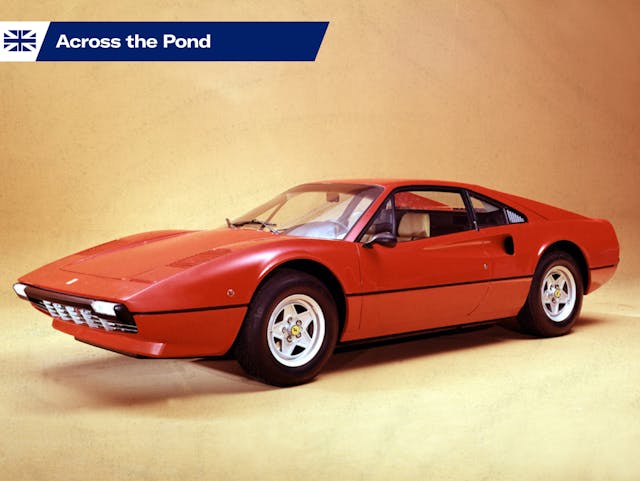
The Corvette may be the most popular fiberglass-bodied car by volume, but it wasn’t the first—and it certainly isn’t the most exotic. Have a read of this list, compiled by our U.K. colleagues, and reinforce your belief in the fantastic possibilities of plastic. —Ed.
Though the British motor industry has been doing fantastic things with plastic for around seven decades, the history of fiberglass body construction goes back even further. In his excellent book Excess All Areas: British Kit Cars of the 1970s, Richard Heseltine charts the use of fiberglass in the United States, kickstarted in 1936 by the Owens-Illinois glass company and its pioneering use of continuous fibers of glass, using the trade name Fiberglas.

Five years later, Henry Ford unveiled the Soybean Car (above), which utilized 14 plastic panels attached to a steel tubular frame. According to The Henry Ford Museum of American Innovation, the body’s ingredients included soybeans, wheat, hemp, flax and ramie.
Today, the use of fiberglass is synonymous with the British specialist and sports car industries, but it’s a truly global affair.
1953 Chevrolet Corvette

The American Bill Tritt had been building fiberglass boats for two years when he was approached by friend Major Ken Brooks. Tritt was tasked with creating a European-style roadster based on the chassis of an old Willys Jeep, in which Brooks’ wife refused to travel. The result was the Brooks Boxer, which became the Glasspar G2, a car credited as being the world’s first fiberglass sports car.
Tritt went on to design and build fiberglass cars for a range of companies, but his role in the creation of the Chevrolet Corvette is often overlooked. The G2 was presented to Harley Earl, General Motors’ vice-president in charge of styling. For Earl, it was a source of inspiration; the use of Glass-Fiber-Reinforced Plastic (GRP) would save money on tooling while underlining the Corvette’s position as the American sports car of the future.
GM’s promotional material extolled the virtues of the Corvette’s “two-passenger, open-cockpit body of glass-fiber reinforced plastic; light, strong, durable, rustproof, quiet and easy to repair.” For New Yorkers at the 1953 Motorama, plastic truly looked fantastic. And so began seventy years of series production.
1958 Jensen 541

On the other side of the Atlantic, Jensen was readying the world’s first four-seater car—and Europe’s first series production performance car—with a fiberglass body. The combination of a 4.0-liter straight-six engine and lightweight, aerodynamic body made it one of Britain’s fastest cars of the 1950s.
Jensen remained faithful to fiberglass construction with the 541R (pictured), 541S, and C-V8, before the arrival of the Interceptor in 1966 saw a return to a steel body shell.
1961 Lotus Elite

The Lotus Elite was one of the most revolutionary and significant cars of the 1950s. Unlike the Corvette, whose fiberglass panels were mounted on a separate chassis, the Elite featured a monocoque built entirely of fiberglass. This was the first time fiberglass had been used for the whole load-bearing structure of the car. The result was a car that weighed about the same as a bag of sugar, with a drag coefficient of just 0.29—in 1957!
The first 250 bodies were built by Maximar Mouldings of West Sussex, before quality issues saw the work being handed to the Bristol Aeroplane Plastics Limited. In an advertisement, Bristol called it “the most advanced car body ever built.” The copywriter probably had a point.
1958 TVR Grantura
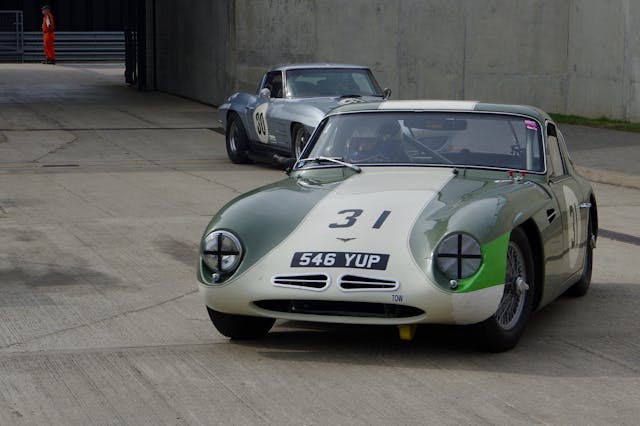
A list of fiberglass cars wouldn’t be complete without a TVR, so it makes sense to feature the marque’s first production vehicle. The Grantura of 1958 featured a fiberglass body molded to TVR’s own tubular steel chassis, with the trailing arms and torsion bars from a Volkswagen Beetle.
Other components shipped in included the windscreen from a Ford Consul and the drum brakes from an Austin-Healey 100, along with a choice of engines sourced from Coventry Climax, Ford, and BMC.
1959 Daimler SP250

In some ways, the Daimler SP250 was the British Corvette. Launched as the Dart at the 1959 New York motor show, Daimler was forced to change the name to SP250 following a trademark complaint from Dodge.
Slow sales meant that the V-8-engined SP250 was the last hurrah for Daimler; the company was bought by Jaguar in 1960, before the axe fell on the sports car in 1964.
1970 Bond Bug
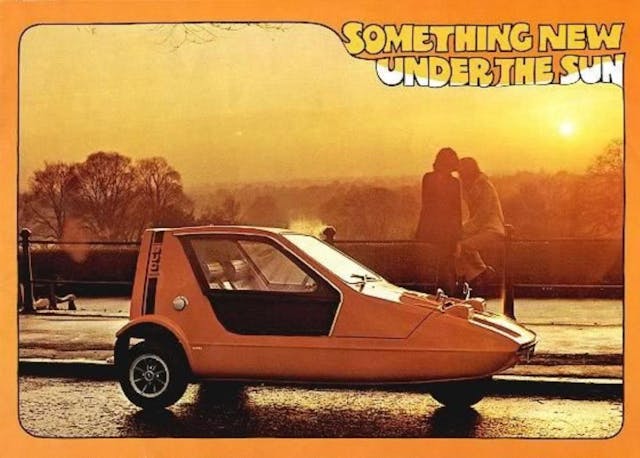
In an interview published in Classic.Retro.Modern. magazine, design genius Tom Karen named the Bond Bug and Marble Run as the two products of which he is most proud. With its orange paintwork, wedge shape, and black decals, the Bug is one of the most 1970s cars of the 1970s. In other news: It’s too long since we played Marble Run.
The brochure delivered a gloriously informal assessment of the benefits of a fiberglass body: “Rap the side of the Bug with your knuckle. There is no hollow, tinny sound; it gives a deep, solid thunk-thunk-thunk. The body of the Bug is made not of metal but of tough, reinforced glass fibre. There is a big advantage to you; because glass fibre cannot rust.”
Makes you thunk, doesn’t it?
1975 Ferrari 308 GTB

Many car names sound better in Italian: Quattroporte (four doors), Topolino (little mouse), Scuderia (stable), and Testarossa (redhead). So, it’s no surprise that the Ferrari 308 GTB “Vetroresina” sounds more exotic than the 308 GTB “Fiberglass.”
This was the first production Ferrari to feature a fiberglass body, but why did Maranello shift from steel? Probably because Ferrari needed to fast-track the development of a new car in response to the slow-selling 308 GT4. The subject of weight also played a part, while some historians speculate that Ferrari used fiberglass in case the car didn’t sell.
By late 1976, just a year after the 308 GTB made its debut at the Paris motor show, cars were arriving in the U.S. wearing steel bodies, although fiberglass cars remained on sale in Europe until the middle of 1977. Various reasons have been tabled for the switch from plastic to steel, including difficulty in finding specialists to repair accident damage, construction that was more labor-intensive than envisioned, and even the fact that fiberglass was never anything other than a temporary measure.
1977 Matra Rancho

Forget all the nonsense about the Nissan Qashqai being the first crossover. Plenty of other manufacturers had previously attempted to blaze the trail, most notably the Matra Rancho of 1977.
Built to satisfy the needs of would-be Range Rover owners who wanted to talk the talk, but didn’t necessarily need to walk the walk, it pioneered the concept of a rough and ready SUV without the ability to venture further off-road than a dropped curb on the Kings Road.
The fiberglass rear section was mounted on a steel frame, the rusting of which doomed too many examples of the radical oddball. Matra stayed true to fiberglass construction with the development of the Renault Espace.
The others

There are countless other fiberglass cars we could have included. The Lancia Stratos, Citroën Bijou, Gilbern Invader, AC 3000ME, Clan Crusader, Vauxhall VX220, and Reliant Scimitar, to name just a few.
A separate list could feature more plastic creations from TVR and Lotus, not to mention the myriad kit cars produced during the boom in self-build vehicles. But before we further extol the virtues of the body material, read how difficult it can be to properly restore a fiberglass body.
Check out the Hagerty Media homepage so you don’t miss a single story, or better yet, bookmark it.
The post 8 fiberglass cars that made plastic fantastic appeared first on Hagerty Media.
]]>
Thanks to the astute engineering and fetching design GM invested in the long-awaited, mid-engine, eighth-generation Corvette, it has become the automaker’s hottest property. New Stingrays are sold out. Used C8s command over-sticker prices. For a spot on the 670-horsepower Z06’s waiting list, passionate fans are begging dealers.
Credible rumors and top management projections point to even more excitement on the horizon. Half-a-dozen additions to the C8 family before the clock strikes 2030 will rouse unprecedented interest in America’s only sports car. GM President Mark Reuss recently mentioned two new editions without providing much detail. He differentiated them by referring to one as “electrified” and the other as “full electric” while touting GM’s goal of adding 30 new BEVs to its roster by 2025.
E-Ray
Some of this should sound familiar, especially if you read my deep-dive article from last May on the future Corvettes. “Electrified” is code for the Corvette E-Ray hybrid due in a year or so. A battery pack inside the Stingray’s hollow center spine, coupled with a 100-horsepower AC drive motor propelling each front wheel and a motor-generator within the eight-speed dual-clutch transaxle will provide improved performance and slippery road poise. Critically, it will also add the ability to drive into European urban centers that prohibit tailpipe emissions. While the 495-horsepower LT2 V-8 is the most likely engine to be tapped for the E-Ray, there’s nothing stopping GM from also adding a 670-horsepower LT6 version to the Corvette lineup for those with a thirst for additional speed.

Corvette EV
While Reuss won’t expound on any details concerning the “full-electric” Corvette(s) heading our way, we and others have been busy speculating and poking around for answers. The first most likely possibility is a five-door hatchback BEV constructed atop the company’s Ultium skateboard platform. The role model here is the Porsche Taycan Sport Turismo. If the GMC Hummer is the platinum brick in GM’s BEV family, this as-yet-unnamed all-electric Corvette will be the company’s .50-caliber bullet. GM designers will have their work cut out combining sleekness and reasonable rear-seat access with a credible exterior appearance.
ZR1
To balance out all of these dancing electrons, the coming Corvette ZR1 will be powered by a 5.5-liter LT7 V-8 consisting of the Z06’s LT6 engine augmented by two turbochargers. Expect a monstrous 850 horsepower, 825-850 lb-ft of torque, and enough raw speed to make Ferrari engineers weep. While this Corvette’s timing is unknown, we’d expect it to serve as the meat in the coming BEV sandwich. Pencil the ZR1 in on your 2025 calendar.
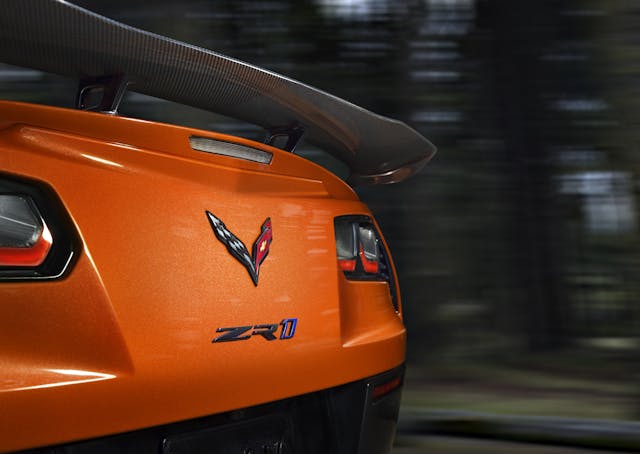
Corvette crossover
To continue Corvette’s growth spurt, there are rumblings (from Car and Driver, among others) that a larger BEV crossover will bow later in the decade under a more formalized sub-brand. Imagine a fully electric Porsche Macan or Cayenne. This brief for this vehicle: ample room and comfort for five adults with sufficient cargo space to support cross-country voyages. GM’s hope, one imagines, is that America will be outfitted with conveniently spaced fast charging stations by the time this Corvette SUV hits our highways.
Zora
To close out the eighth-generation Corvette’s lifetime, a remarkable model to be called “Zora” awaits. Picture the union of E-Ray and ZR1 technology, combining forces into a mega C8 good for 1000 horsepower and torque targets GM engineers are striving to meet between coffee breaks. In case you’re behind on your Corvette lore, Zora Arkus-Duntov was the Vette’s patron saint from the mid-1950s through the mid-1970s and the engineer who identified the need for a mid-engine powertrain layout.
For those who can’t afford the $200,000 price tag likely for the Corvette Zora, GM has an appropriate consolation prize in mind: the next-generation Corvette, nicknamed C9. It’s not a stretch to imagine the C9 Vette will be a more affordable BEV two-seater with no internal combustion engine in the mix. (To read our comprehensive design and engineering forecast click here.)

Shedding the bowtie?
The potential flurry of coming Corvettes begs one additional question—is this sporting champion about to snip its Chevy apron strings? Given the fact that today’s C8 already carries crossed flags inside and out, with absolutely no Chevrolet or bowtie identification, one could argue that ditching the “Chevrolet” in “Chevrolet Corvette” would be something of a formality at this juncture.
Three considerations are almost definitely floating around GM headquarters concerning this subject. The first is fear about rocking the Corvette boat with any break from the Chevy fleet. The second is the strategy of mimicking Genesis’ split from Hyundai dealerships, complete with its own distinct (and more high-end) sales and service facilities. The third alternative is Tesla’s successful circumvention of the entire traditional sales and service model. Instead, the seller-to-customer dialogue would be all digital, via website and cellphones the way Polestar operates. If service is required, the vehicle is hauled off to a facility for work and a loaner if provided to avoid inconvenience.
While GM would show unprecedented courage with such a dramatic expansion of the Corvette product line, we don’t expect the automaker follow Tesla into a fully digital sales and service interface. We’d wager you’ll still purchase the next Corvette in person, perhaps in at a stand-alone showroom in which Le Mans victory décor lines the walls in place of Silverado pickup and Suburban banners.
Check out the Hagerty Media homepage so you don’t miss a single story, or better yet, bookmark it.
The post Corvette sub-brand and SUV on the horizon? appeared first on Hagerty Media.
]]>
Even in his teenage years, Brian Richardson had an eye for Chevrolet Corvettes. Turns out he also had a nose for buried treasure.
Richardson and his identical twin brother, Bruce, bought and sold Corvettes in northern California to help finance their college education in the 1970s, but Brian could never part with one of them: This 1963 convertible, VIN 30867S100003, the earliest-known second-generation (C2) Corvette in existence and now a priceless collectible.
“My mom worked for the DMV, and Brian wanted a fuel-injected Corvette,” Bruce says of his brother, who died unexpectedly two months ago. “He came up with the brilliant idea to have her run the first 20 serial numbers, and he found #00003 in Los Angeles.”
Since Mom Richardson was traveling to Los Angeles anyway, she drove to the address registered with the DMV and spoke to the owner’s wife, who shared two pieces of important information: 1. The car didn’t run, and 2. Her husband had just lost his job. Those two negatives added up to a positive for young Brian, who recounts the story in Larry M. Galloway’s book, Corvette: 1963–1967.

“I flew down soon thereafter and was able to see the car through a garage window,” he told Galloway. “… Later I made a deal with the owner over the phone for $1500. The next weekend my brother and I drove down and picked it up.”
When there simply isn’t another one like it, a car’s value is impossible to pinpoint—or, in the words of our valuation team, priceless. The deal for the Vette—equipped with a 327-cubic-inch, 360-hp V-8 (L84)—was completed on April 26, 1975. Taking inflation into account, the $1500 price tag is the equivalent of $8300 today. As the earliest-production second-gen Corvette in existence, however, it’s in a league of its own. When verified, as this convertible’s status is, the title of “earliest known” holds great weight in the collector market. Such a vehicle can easily sell for more than its top value in the Hagerty Price Guide: In this Corvette’s case, $180,000.
By any measure, Vette was an amazingly shrewd purchase, especially for a 19-year-old college student, but it probably wasn’t all that surprising to anyone who knows the Richardsons.
“We were always into mechanical things, trying to figure out how they worked, learning how to make them work better,” Bruce says. “Our dad died when we were 15. He was a businessman, and he had served as a tank commander in World War II. Our grandfather worked for Lockheed, and all of his tools went to Dad, so we had a lot of them, and we used them a lot.
“When we were 14 or 15, we bought our first car—a three-cylinder, two-cycle German car called an NSU Prince, which is about the size of a Mini Cooper. We drove it around in the back yard. We had go-carts and gas-powered skateboards and …”
Bruce’s wife, Lainey, interjects: “When they were 10, they took apart their mother’s washing machine, fixed it, and put it all back together. Can you believe that? Ten!”

Brian and Bruce went to the University of California-Berkeley and became mechanical engineers. Between them, they have more than 100 patented inventions; Brian specialized in lighting, Bruce in biotech. Brian was also an Olympic bobsledder who competed in the two-man event at the 1992 Winter Games in Albertville, France. In addition to competing, he came up with an innovative sled design that is still in use today. As for Bruce, he and his son, Perry, run AccelRaceTek, a motorsports business in Los Gatos, California, that specializes in high-performance race car training, tech, and service.
In other words, the Richardson brothers never lacked for brains, and Brian’s purchase of a historically significant C2 provides automotive proof.

“It is a genuinely significant car, likely the earliest existing C2 Corvette,” confirms Hagerty contributor and Corvette expert Don Sherman. “Its original fuel-injected V-8 adds to its value, and the ability to trace the ownership chain helps as well.
“Speaking from experience, C2 frames are susceptible to corrosion [rusting] because they were not painted by the manufacturer. Instead, they received a coating of tar-like stuff which didn’t last forever. Since this car apparently spent its life in California, that’s a plus for longevity.”
Not surprisingly, the brothers’ restoration work on the Sting Ray was meticulous.
“The car looked ugly when I bought it,” Brian told Galloway. “It was originally red on red. One of the previous owners painted both the interior and exterior black. They even painted the carpets. The paint job was poor. In many places red was showing. The good news is they didn’t replace the interior. They only painted it. So, I was able to see how it came from the factory.
“I still have the original interior seats, carpets, and door panel covers [the panel shape is slightly different from later production]. The paint on the body looked horrible. The body had only been damaged slightly in the rear. All of the original panels were on the car. As I said, the engine didn’t run.
“I drove the car for a short time and then took it completely apart. At the time, a lot of parts could be bought from Chevrolet. Things like weather strips, glass, and FI parts were still available.”
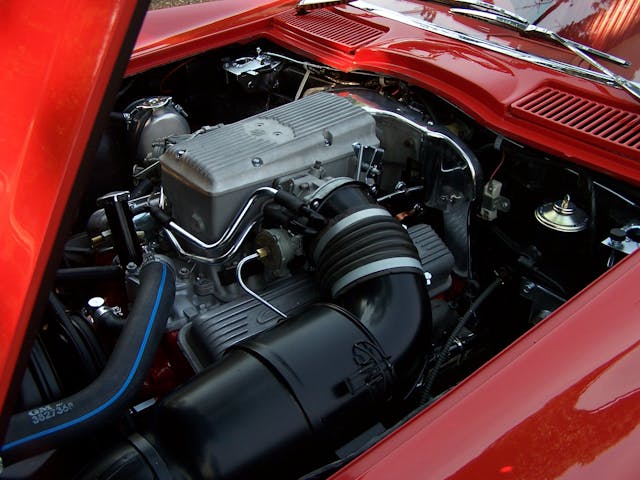
Bruce adds that his brother “wanted to make it as close to its original configuration as possible. We worked on it and had it running within about a year, and we later did a frame-off restoration and got it into a real nice position. Brian also did a refresh about 10 years ago.”
In addition to the car’s Riverside Red paint and 327 fuel-injected engine, it has a four-speed transmission, positraction axle, radio, and both hard and convertible tops. Its aluminum knock-off wheels and white wall tires were also undocumented options.
The body trim plate does not have a date code, but the National Corvette Restorers Society (NCRS) confirms that #00003 was shipped on August 29, 1962 with a dealer code indicating it was for General Motors’ use.
Knowing that Brian’s C2 is VIN #00003, and there is no recorded account of what happened to #00001 and #00002, he reached out to Corvette author and historian Noland Adams in 2009, hoping Adams could shed some light on their whereabouts. Adams, who died in 2017, wrote back, sharing a lengthy account of what he knew. He stated, without hesitation, that Brian’s car is “the oldest existing Sting Ray.”

“Why haven’t the first two Sting Rays, numbers 1 and 2, been found? I think I know why,” Adams wrote. “… First of all, why build pre-production prototypes? The answer is obvious—build them about two months before the production run is scheduled [to begin] to check fit and function of all new, never-used-before parts. Soon, production of the new model will begin, and ill-fitting or ill-functioning parts must be replaced …
“Another consideration is how the pre-production prototypes were dispatched. Assuming a coupe and a convertible model for the year in question, one example of each body style was scheduled to be destroyed in a barrier test …”
Adams wrote that, considering the importance that GM placed on these crash tests, “I am certain that 1963 pre-production prototypes 1 and 2 were prepared for such a barrier test as quickly as possible … Apparently the next convertible in line was #00003, and it was used as a design check.”

Adding weight to Adams’ findings, Galloway’s book discusses the differences between #00003 and production 1963 Sting Rays. Some (but not all) of #00003’s unique features include:
- The front fender upper to the lower panel bonding strip on the inside of the front fenders behind the Fuel Injection emblem is a hand lay-up part and does not have a ‘jog’ to clear the emblem studs as all jobs that follow do.
- The headlight mechanisms are sand-cast and appear to be manually machined; scribe lines made by the machinist are visible.
- The door outer panels have a cutout at the top rear … The stainless-steel trim bead along the top of the door trim panel does not extend the full length of the door trim.
- The windshield reveal moldings were handmade, as there is evidence of hammer marks and welds on the backside. They fit noticeably better than production moldings.
- The car (originally) had holes in the body for power windows and a right-side rearview mirror, which were filled with factory bonding adhesive (not bondo).
- The luggage compartment rear carpet under the rear deck was salt and pepper, like 1962 models, while the rest of the carpet was red.

Considering what similar Corvettes have sold for in recent years, it’s safe to say that #00003 is worth six figures—maybe even seven. Why does that matter? Because even before Brian’s fatal heart attack, he was thinking about what would become of his Corvette, since his wife Lee, son Ian, and daughter Shannon don’t share his passion.
Now Bruce and Lainey are in the process of selling the historic C2 on behalf of the family.
“We haven’t decided where and when,” Bruce says. “We’re considering Barrett-Jackson Scottsdale, or maybe Mecum Kissimmee (both scheduled for January 2023). And everybody seems to be selling cars on Bring a Trailer these days, so that’s an option, too. We’re still trying to figure it out.”
Knowing the Richardsons, they’ll make a smart choice, just like Brian did in 1975.
Check out the Hagerty Media homepage so you don’t miss a single story, or better yet, bookmark us.
The post Bought by a teen for $1500, this ’63 Corvette is now priceless appeared first on Hagerty Media.
]]>

This LBJ-owned ’64 Lincoln Continental is as presidential as they come
Intake: A 1964 Lincoln Continental once owned by former president Lyndon B. Johnson is up for sale on Bring a Trailer. The car was sold new to LBJ Co. of Austin, Texas, and used by LBJ himself at his central-Texas ranch. The stately white drop-top features a power-operated convertible soft top, air conditioning, vacuum-operated door locks, and those sweet, sweet, rear-hinged rear doors. It was reportedly refurbished by the previous owner before finding its way into the collection of the current owner in 2016. Win the lot, and you’ll get the car, a smattering of presidential memorabilia including a removable magnet indicating LBJ’s ownership of the car, and a clean New Jersey title. The 430-cubic-inch V-8 and dual-range three-speed automatic have just 16K miles on them, so this lovely cruiser still has plenty of palatial cruising ahead of it, should you choose. As of this writing, the leading bid sits at $75,000 with five days left to go. All things held equal, that would place it above the $71,000 #2 Excellent condition value for these machines. However, it’s likely to end up closer to the #1 Concours value of $106,000.
Exhaust: President Johnson’s ranch is now open to the public, and you’ll find a handful of White Lincolns still on the property. This video touring the historical park reveals a ’67 Continental outfit with knobby tires, and legend has it that he would drive the cars through small streams for fun. LBJ had a thing for Lincolns and a thing for surprising guests behind the wheel; he used to drive right into a lake with an amphicar that he had. Here’s to hoping the next owner gets as much joy out of this lovely Continental as old Landslide Lyndon himself!

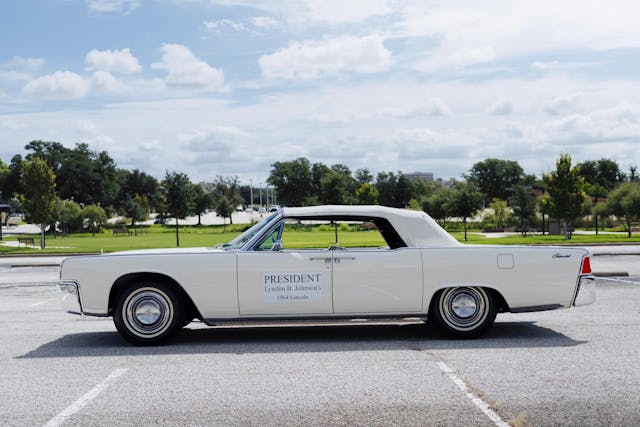
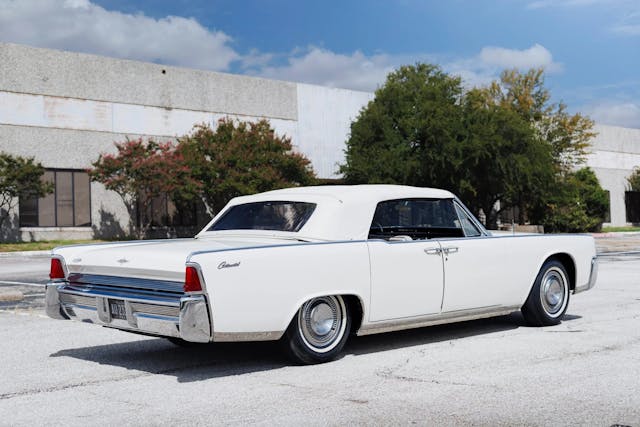






Dead: V-8-swapped Flyin’ Miata




Intake: Colorado-based Miata specialist Flyin’ Miata has announced that it will no-longer offer turn-key V-8-swapped Miatas or the parts necessary for the conversion. In a statement released yesterday, the firm cited increasingly stringent emissions regulations and government entities—who are cracking down on companies that sell “emissions defeat devices”—as the reasons for the package’s demise. Flyin’ Miata will still offer a host of chassis, brake, and suspension upgrades for any generation of Miata, plus the company has noted that now it will turn its drivetrain expertise towards developing even better emissions-compliant engine components, likely just for the four-cylinder engines found in the MX-5 currently. “V8 power by Flyin’ Miata may be gone but you can be sure that this was only one chapter of a very long and exciting story about the world’s favorite roadster,” a line from the statement read.
Exhaust: We’re not surprised that emissions killed the monster Miata (go ahead and tune that to The Buggles’ song as you wish). Still, we had in the V-8-swapped Flyin’ Miata something of a modern-day Cobra, or a Sunbeam Tiger. We’re sad it’s no more. Those V-8-swapped Flyin’ Miatas that already exist just got a whole lot more valuable. To wit: FM’s original LS-swapped ND Miata development mule, lovingly named Indy, sold on Bring a Trailer yesterday for $104,776 including buyer’s premium. — Nathan Petroelje
Chevy’s hard at work on the mid-engine ZR1

Intake: Thanks to the ever-sharp-eyed Corvette fandom, we’ve gotten a tantalizing reminder that Chevrolet is busy developing the apex predator of the C8 family. That is, the most aggressive variant whose driveline does not incorporate some form of electric assistance. Peering into a factory restoration facility in the Corvette Museum, a sharp-eyed fan spotted a Z06 engine mounted on a wooden cart printed with the text: LT6 GAMMA and LT7 BETA. Aficionados will recognize each as Corvette engine codes, the latter alphanumeric expected to refer to the ZR1’s powerplant. The ZR1 moniker has long denoted the most race-tuned Corvette of the line and, since the C6 “Blue Devil,” its engine has been supercharged. The first-ever mid-engine ZR1 is expected to be forced-induction as well, but look for two turbochargers rather than a supercharger. The base, as indicated by the engine above, will be familiar: The 670-hp, flat-plane-crank LT6 found in the C8 Z06. Strapped with the turbos, the engine’s output should rise to over 800 hp.
Exhaust: For the first time, the ZR1 won’t be the be-all, end-all Corvette: That honor will go to the Zora, which will supplement the ZR1’s LT7 with two AC motors, one on each front wheel, giving it all-wheel drive and, most likely, over 1000 hp. GM Authority expects the ZR1 to appear late next year; we’d time its arrival more conservatively, for 2026. —Grace Houghton
Class-action settlement sees Porsche pay up to $1109 per vehicle for skewed emissions claims

Intake: A U.S. judge has granted final approval to a class-action settlement worth at least $80 million to resolve claims that parent company Volkswagen and its Porsche division purposely skewed emissions and fuel economy data on 500,000 Porsche vehicles in the U.S., says Reuters. Lawyers for the Porsche owners claimed the company physically altered gear ratios and manipulated software on test vehicles, so those test vehicles emitted fewer pollutants and were more fuel efficient than the production vehicles consumers bought between 2005 and 2020 model year Porsches. Owners of eligible vehicles may get $250 to $1,109 per vehicle.
Exhaust: Porsche told Reuters that it is “committed to providing our customers with transparent fuel economy and emissions data, and the agreement ensures that customers are fairly reimbursed for any fuel economy changes.” You’d think if anyone had learned not to meddle with mileage, it would be VW. — Steven Cole Smith
SUPER GT’s new alternative fuel has a scent problem

Intake: Having just completed its regular-season race, 22 cars in Japan’s SUPER GT series stuck around and tested a new carbon-neutral fuel at the Motegi track. All apparently went well mechanically, but Motorsport.com reports that some drivers were concerned about the fuel’s smell as it exited the tailpipe, and found that it was an eye irritant. “One driver described the smell of the fuel as ‘like kerosene’ while another likened it to ‘a mix of gasoline and oil from a racing go-kart.’ There were also suggestions that some drivers were struggling with eye irritation when following another car closely, as the exhaust fumes of the car ahead entered the cockpit,” the story said. The fuel is expected to be used next season to replace gasoline.
Exhaust: Most of the drivers did not have a problem with the ETS Racing Fuel, according to the SUPER GT website. Said Toyota Supra driver Hiroki Yoshida: “At the beginning, we started running with the engine performance restricted and then we gradually raised it a bit at a time. And in the end, there was no uncomfortable feeling at all using the carbon-neutral fuel as I drove. There were also no problematic effects on the other parts of the machine. As I ran, however, I did feel something different about the smell of the other cars’ exhaust.” — Steven Cole Smith
The post Own LBJ’s ’64 Continental, Flyin’ Miata’s V-8-swap is dead, ZR1 heart soon to beat appeared first on Hagerty Media.
]]>
The car sold for a high bid of $182,999, and is on its way to its new home — in Helsinki, Finland.
Late this summer, the big orange Reliable Carriers 18-wheeler rolled up to Randy Kent’s door in Sarasota, Florida, and a yellow 2021 Chevrolet Corvette rolled out. Kent, who describes himself as an “enthusiast,” has a small car collection and he was happy to add the C8 Corvette, which he wanted as a daily driver.
It seemed like a pretty good deal when he bid on the car at the Barrett-Jackson auction in Las Vegas in July. The car had just over 50 miles on the odometer, and it was part of the GM Heritage collection. When bidding topped $100,000, Kent hoped it wouldn’t go much higher. It didn’t. Kent bid $104,500, and the car was his.
One of the things that appealed to Kent about the car was that it appeared to be an IMSA GTLM Championship C8.R Edition, a $6595 package when sold. Admitting that he didn’t know that much about C8 Corvettes, he assumed that his car, which was sitting next to one such GTLM Championship Edition, was the same thing, just lacking the graphics. The VIN number ended in 000010, so Kent knew it was an early car.

The motorsports-inspired package was introduced at the IMSA race at Belle Isle, in Detroit, in June of 2021, honoring the 2020 season championship won by the C8.R race car. The package came with a high-wing spoiler in Carbon Flash, yellow brake calipers, black Trident design wheels with black lug nuts and the “Jake” logo on the center caps, exterior mirrors in Carbon Flash, plus black side rockers and splash guards. Inside, the Championship Edition features a Strike Yellow and Sky Cool Gray cabin that mimics the exterior yellow and gray racing theme, with standard GT2 seats, along with yellow seat belts and a C8.R Special Edition numbered plaque.
A plaque? Kent had missed that. Driving to lunch the next day, he glanced down, “and I did a doubletake.” The plaque was there, between the seats, and it read, “C8R Edition 01EX.“

EX, as in “experimental,” 01, as in the first, and maybe only experimental car. Hmm. When the car arrived, it was quite dusty, so Kent took his California Duster to it. In several places, the Duster found some adhesive from the original C8.R stickers, which had been stripped off.
But wait. Kent’s car is a 2021, though it was built in 2020. The C8.R Edition was for 2022, with Chevrolet building only a thousand. Kent had met a GM Design employee at Las Vegas, and they stayed in touch. Kent texted him a picture of the badge.
“Two seconds later,” the GM employee called Kent. His first two words: “Oh, shit!” Kent was told the car was supposed to be stripped or even destroyed, but it was hiding in the Media Building at GM when the other cars met their fate. It had been used as a display car at IMSA races, and apparently was a photo car for GM brochures. And then it was supposed to meet its fate. But this one got away.

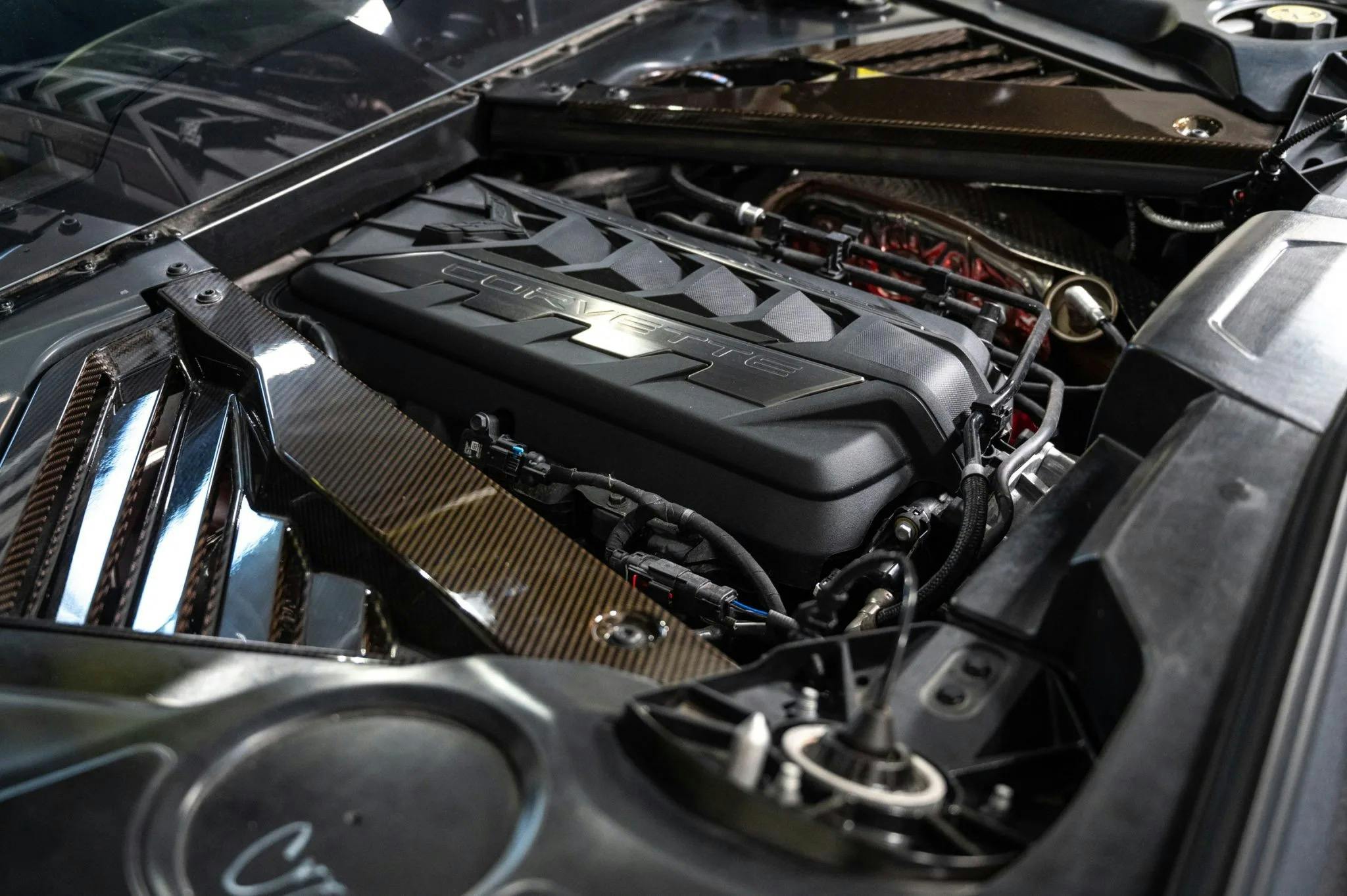
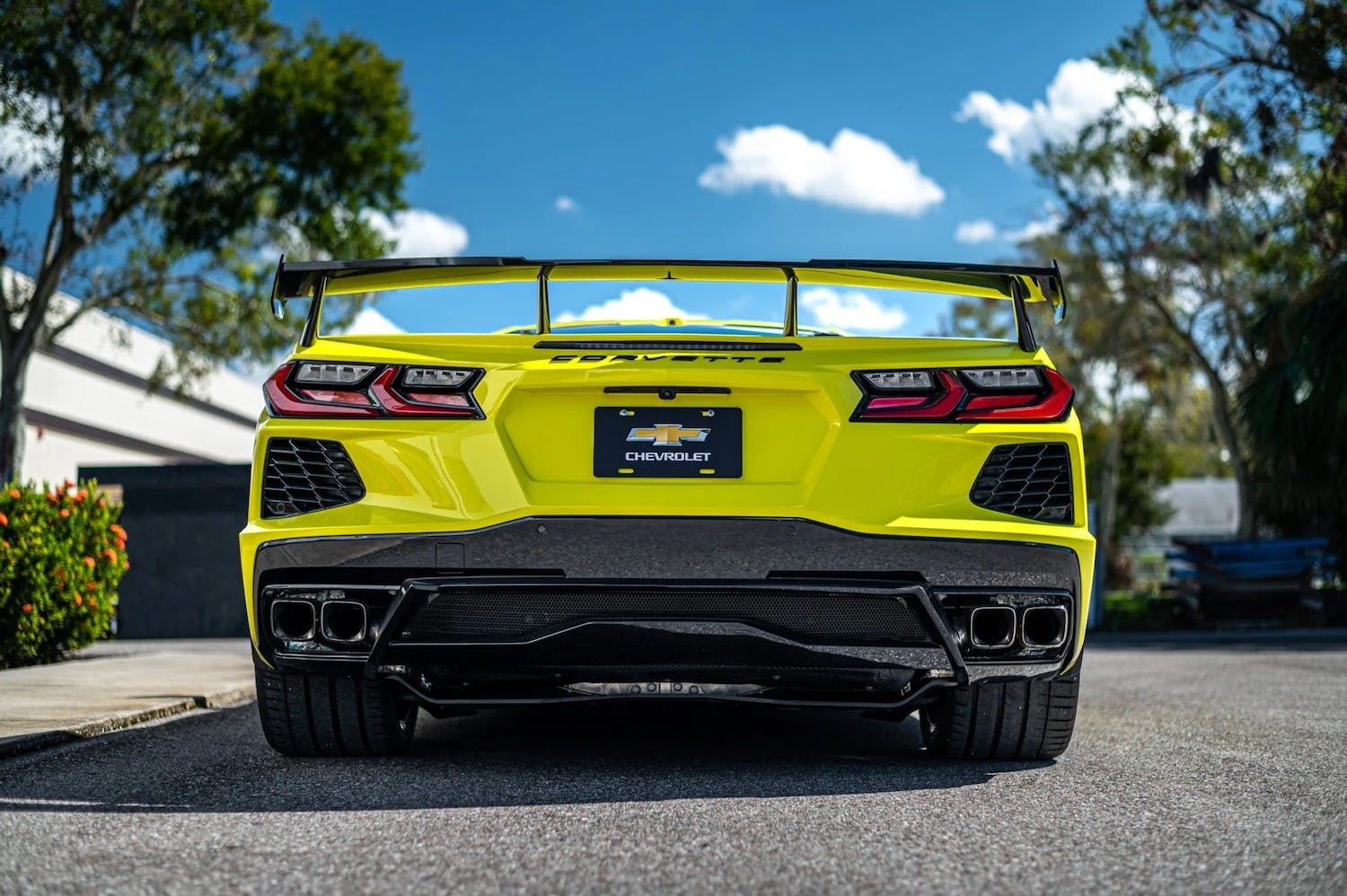
Bottom line: There were only supposed to be 1000 of the IMSA GTLM Championship C8.R Edition cars. Now there were 1001, and one of them was a 2021 model, while the rest were 2022s. Kent had one of one.
He thought about keeping it, but with such low mileage—it still has under 100 miles on the odometer—and its rare status, “I figured this car deserved to be in a collection.” GM sent a tech down the next day to erase some proprietary software, such as a program that has the car speaking to GM in real time, “telling them how it’s cornering, the spring rates, that sort of thing,” and apply some warning stickers. The changes make it a street-legal and entirely insurable car, Kent says.
Now the car is on bringatrailer.com. Bidding is up to $89,200 at this writing, but with four days left on the auction, it’s likely to go much higher. How much higher? Kent, who owns a boat cover company, isn’t sure. After all, “it’s one of one. How do you put a value on that?” A set of C8.R graphics is included with the car, but it looks awfully clean without them.
Meanwhile, Kent bought a 2022 Corvette C8 to drive, with no backstory. And he’s hoping his C8.R-that-isn’t finds a good home.





Check out the Hagerty Media homepage so you don’t miss a single story, or better yet, bookmark it.
The post Update: This Corvette shouldn’t exist, but you can own it appeared first on Hagerty Media.
]]>
When Jerry Seinfeld created a brilliant way to meld comedy and cars into his hit show Comedians in Cars Getting Coffee, we drank it up. Now he’s coming out with a new book about the streaming series, which is like adding cream to your favorite cup of java.
The Comedians in Cars Getting Coffee book (Coffee coffee-table book?) will be available on November 22, timed to coincide with the 10th anniversary of the show’s debut. Publisher Simon and Schuster says it “isn’t just a record of the show but instead an inventive tribute full of behind-the-scenes photos and anecdotes.”

Seinfeld recently announced the book’s release on his Instagram page (@jerryseinfeld).
“The first episode of Comedians in Cars Getting Coffee went online ten years ago—on our own website, without any press or promotion. Just me and Larry David having a funny conversation,” Seinfeld wrote. “We called it a web series because nobody knew what streaming television was. Ten years later, we have produced 84 episodes and we’re on Netflix. It’s a crazy story, and this book seems like a good way to tell it, along with some of my favorite photos and dialogue from the show.”
Comedians in Cars Getting Coffee reinvented the talk show format and drew applause from industry moguls and fans alike, earning multiple Emmy nominations and helping lead the streaming revolution. Each episode features Seinfeld cruising the Los Angeles area in one of his favorite classic cars, accompanied by some of the funniest people in comedy and on television. During their drive they talk about the intricacies of stand-up, the evolution of their careers and personal lives, and whatever else pops into their heads, and the conversation always includes a stop at a coffee shop or diner to continue their conversation.
Seinfeld’s guests have included Steve Martin, Tina Fey, Eddie Murphy, Jay Leno, Martin Short, Will Farrell, David Letterman, Amy Schumer, Seinfeld’s former Seinfeld castmates, and even President Barack Obama. Late comedy legends Garry Shandling, Jerry Lewis, Don Rickles, Carl Reiner, and Norm McDonald also went for rides with Seinfeld, adding a bit of nostalgia to those episodes.
A total of 84 classic cars have been featured, including a 1949 Porsche 356/2 (with Leno), 1966 Jaguar E-Type Roadster (Lewis), 1955 Mercedes-Benz 300 SL Gullwing (Lorne Michaels), 1964 Aston Martin DB5 (Julia Louis-Dreyfus), 1964 Morgan Plus 4 (Stephen Colbert), 1969 Lamborghini P400S Miura (Chris Rock), 1976 Lamborghini Countach LP400 (Jim Carrey), and 1963 Corvette coupe (Obama).

Simon and Schuster says the book, which includes never-before-seen production photos, “dives into the inspiration and creation of segments, the most unforgettable lines from guests, an index of the cars, and some of the most memorable moments from crew members.”
While we wait for word about new episodes of Comedians in Cars Getting Coffee (the last installments were released on July 19, 2019), perhaps the Seinfeld book will satisfy our cravings for now. Until then, please pass the cream.
Check out the Hagerty Media homepage so you don’t miss a single story, or better yet, bookmark us.
The post Seinfeld to release <em> Comedians in Cars Getting Coffee </em> book November 22 appeared first on Hagerty Media.
]]>
In the 1950s, my dad landed a job at Chevrolet Engineering, in the brand-new GM Technical Center in Warren, Michigan. Dad was one of two Chevy Engineering transmission techs.
One summer day in 1959, the department held an employee open house event, and Dad took me to the Tech Center. I was 7 years old. I remember the fountains, the Design Dome, and the turbine cars that looked like spaceships.
Near Dad’s work area, around a privacy curtain, propped up on a white platform, was the neatest little car I’d ever seen: the Chevrolet Engineering Research Vehicle No. 1, or CERV-1, sans body. Dad introduced me to two men standing nearby, Zora Arkus-Duntov and Mauri Rose, then plopped me in the car’s metallic blue driver’s seat. I played with the controls, and at that moment, I became a car guy. Nearly 60 years later, I built my own CERV-1.

The mid-engine configuration was state-of-the-art in 1959. It had taken over Formula 1 and was being considered for Indianapolis. Understandably, Arkus-Duntov wanted to investigate the performance of such a layout, and the CERV-1 was his mule. Tests at the GM proving grounds and several racetracks (including Sebring, as covered in Sports Car Graphic, May 1962) showed its potential. Arkus-Duntov campaigned for a mid-engined production Corvette, but manufacturing costs and conservative management halted his plans.
The CERV-1 had a body designed by Larry Shinoda and Tony Lapine, with side pods, a headrest/air scoop, and a profile that resembled a stingray fish. Several first-gen bodies of slightly different styles and finish were installed on the CERV-1 chassis. My build uses the earliest body style, plus some artistic license. (This early body no longer exists; the car in the GM Heritage Collection sports a late body.) I mixed it up a bit more with a paint scheme of late nose blending to early tail. This Frost Blue Poly over Snowcrest White showed up for testing at Sebring in ’62.
The first step in reverse engineering is to gather all the data you can find on the subject. Fortunately, GM shared development photos with journalists throughout the ’60s, and I was able to find all the CERV-1 pictures and articles I needed.




Period photos show the tubing layout, but before I could design the chassis, I needed the key parts: engine; transmission and quick-change differential; front and rear suspension; seat; and suitable wheels. The engine and seat were easy—a small-block Chevy and a Kirkey. The CERV-1’s independent rear suspension (IRS) made its way into the 1963 Corvette, so I picked up an early IRS and rebuilt it. There were no transaxles available to Arkus-Duntov that could handle a hot V-8, so his team replaced the tail-shaft housing of a four-speed with a Halibrand V-8 quick-change differential. I designed and machined an adapter mating a Saginaw case to a Champ IRS quick-change. My quick-change is narrowed to Corvette IRS dimensions using Speedway Engineering Bells, with a Detroit Locker, custom forged axles, bearing retainers, and through shaft. It looks and works just like Arkus-Duntov’s, but stronger.
At Chevy, Arkus-Duntov needed an approved program to bill CERV-1 expenses. The only program in development at the time was the Corvair, and Ed Cole, then general manager, apparently allowed Arkus-Duntov to use some of the Corvair budget. For front suspension, the CERV-1 used a “leftover” handmade piece from the defunct Corvette SS program, with upper control arms that closely resemble those from a Corvair.

Period photos show the CERV-1 with a Corvair steering wheel. I recalled the column and steering box were also from a Corvair, so I junked one to get its front suspension and steering, which I modified to eliminate bump steer. I changed the ride height, improved damping, and added GM disc brakes. My CERV-1 re-creation should handle and stop better than the original.
Using the Southern California Timing Association (SCTA) rulebook as reference (and with help from Bonneville tech inspector “Kiwi” Paul Gilbert), I designed a frame in 3D CAD to meet or exceed land speed record specs. My CERV-1 development used 3D models extensively, from the frame and body to the transmission and quick-change adapter.

My frame design looks like Arkus-Duntov’s but has much larger tubes; a full SCTA rollcage bolts on, as well. A lot of time on the computer meant I saved countless hours, frustration, and a bunch of money in fabrication. It’s far easier to cut and throw away a virtual tube than a real one. It took 83 iterations and three years to get it (mostly) right.
From my 3D model, I crafted a body master “plug” and a mold. Starting with the belly pan, I laid up the CERV-1 body panels, trimming each and scribing the mold with wheel cutouts and the like. The wheel wells and headrest/air scoop were separate molds, some being designed quickly for single use.
My test engine was a 355-cubic-inch small-block Chevy with ported Vortec heads, a custom roller cam, 10.5:1 static compression, and several other tweaks. I made stainless-steel upswept headers and had them ceramic-coated, inside and out. Overall, it had more power than the original’s 283. I used the 355 for the initial testing and found it to be quite adequate.

Then I upgraded to a 388 stroker with 12.5:1 compression, aluminum heads, a comp roller cam, and a Holley Sniper EFI. It’s cooled with two large aluminum radiators up front and two auxiliary units in the tail. It was modeled after a 500-hp build and absolutely rocks this little one-seater.
In fact, it’s a hoot to drive. A V-8 go-kart. A 1960s Indy car. Visibility is great, and watching the suspension work is a blast. The cockpit is roomy but short, so your knees are brought up a bit, under the Corvair wheel. The hydraulic clutch is light, and shifting via cables from a modified Hurst Competition Plus is smooth.

Aggressive use of the throttle causes wheelspin—any time, any gear. It’s much faster than I thought it would be. In August 2020, I took my CERV-1 to Portland International Raceway (with the 355) and re-enacted Jerry Titus’s 1962 Sebring test. My test driver complained that he pegged the tach at the beginning of the back straight at 165 mph and wanted a taller gear. With the bigger V-8, this car will do 200. Someday I plan to prove that at Bonneville.
In the meantime, you can see my CERV-1 for yourself, on loan to the National Corvette Museum through late next year.
This article first appeared in Hagerty Drivers Club magazine. Click here to subscribe and join the club.
Check out the Hagerty Media homepage so you don’t miss a single story, or better yet, bookmark it.
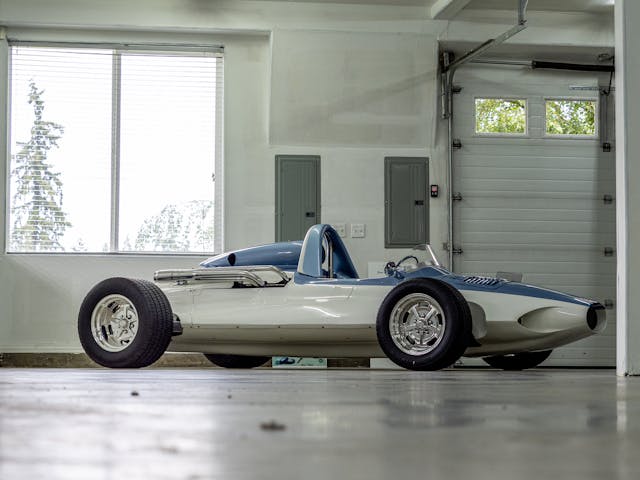




















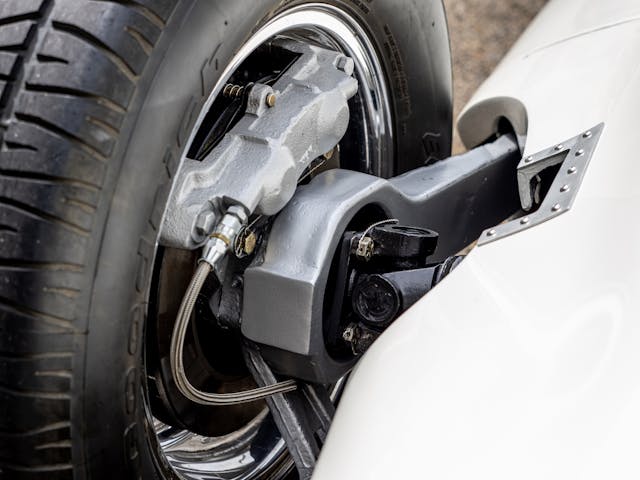

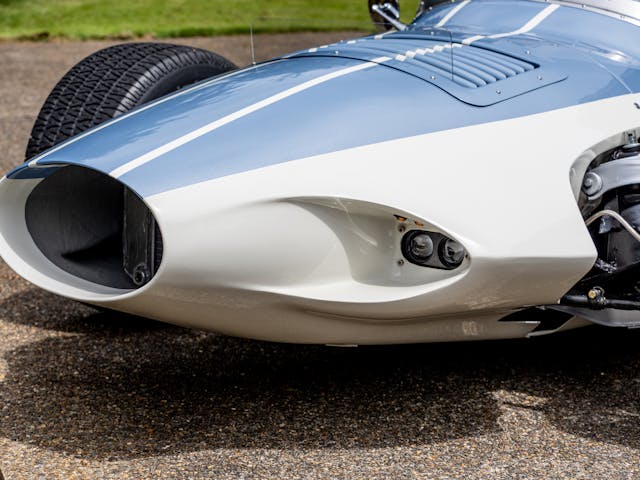





The post CERV-1 replica pays tribute to one of Zora’s wildest rides appeared first on Hagerty Media.
]]>
The smallest details can make or break a restoration. Sometimes in very interesting and frustrating ways, as Richard Martinez has learned over the last six years. That is how long it took for the seizure, ensuing court battle, and, finally, the return of his 1959 Chevrolet Corvette.
All this, over two rivets.
The fasteners in question held the VIN plate to the car and only caused all this ruckus because of a Kansas law intended to curb VIN-swapping of stolen or otherwise questionable cars. During an earlier restoration of the Vette—critically, one that occurred before Martinez bought it—someone replaced the two round-head Phillips screws that originally secured the VIN plate with a pair of pop rivets. Only when Martinez registered his 1959 Corvette was the discrepancy called out, an action which triggered the seizure of the car by the Kansas Highway Patrol. The car remained in impound, despite no evidence that it was stolen or otherwise tampered with. The FBI even decided in favor of Martinez—to no avail.
As a seized asset, the classic Chevrolet languished outside in an impound lot while a legal battle raged. The case was elevated all the way to the Kansas state legislature, who ultimately sent House Bill 2594 to governor Lauren Kelly’s desk. She signed the bill into law on March 22 of this year. It went into effect nine days later, laying the path for the Corvette to be returned to Martinez. He had sustained a significant financial loss: Martinez spent an estimated $30,000 in legal fees to reclaim a car he bought for $50,000, according to Martinez. It would be easy to be frustrated with the Highway Patrol, but according to KCTV 5 in Kansas City, the thought never crossed Martinez’ mind. The law was clear and enforcement fair; the law simply needed reform.
The return of his Corvette should feel like a victory, but Martinez is clear that this journey has been financially and emotionally draining. The car and $20,000 have been awarded to Martinez, but reports cite that there could be as much as $28,000 in damage to the vehicle. $20,000 is the cap that can be awarded by Kansas to Martinez for repairs, which the Corvette desperately needs, after sitting outside for six years. As of this writing, it does not start.
This is not the outcome anyone would have predicted, and it also falls somewhere in between good and bad on the scale of results we would have wished for. Regardless, we applaud Martinez for sticking with the case, and Kansas lawmakers for acknowledging the law needed an update that allowed for vintage vehicles undergoing a restoration that might require the tag to be removed—and honestly replaced. Good on the state for following through to make sure another owner won’t have their car improperly seized.
Check out the Hagerty Media homepage so you don’t miss a single story, or better yet, bookmark us.
The post Corvette returned to Kansas owner after 6-year VIN debacle appeared first on Hagerty Media.
]]>
Whether it’s a fun weekend cruiser or back-road runner, a manual transmission adds a whole lot to the driving experience. More direct engagement between driver and machine goes a long way. That’s especially true when our beloved collector cars are a tonic for the more clinical, modern daily driver.
In many cases, the personality of a car can shift considerably without a sluggish torque converter in the mix. A clutch and a third pedal don’t have to cost big bucks, either. No matter the number of speeds, we bet there’s something you can find out there that would make a fine next addition to your collection.
1997 BMW Z3



Whether you want to go top-town, top-up, or hardtop, this low-mileage Z3 has you covered (or uncovered)! The 1.9-liter roadster is finished in Boston Green with a well-kept beige leather interior and shows fewer than 100,000 miles on the odometer. Its flywheel, clutch, and pressure plate were apparently replaced about five years ago, and its slave cylinder was replaced about a year after, so it should have plenty of more miles of happy shifting yet to give. In this lightweight, four-cylinder roadster, the engagement from a manual is a key ingredient.
1974 VW/Corsair Stripper



According to the seller, this early ‘80s dune buggy is one of about 150 built by Corsair during the ‘80s. Those numbers make it rare, but the fact that it’s a VW-based dune buggy that isn’t trying to copy a Meyers Manx puts it in a completely different category. The unique concept behind the Stripper was that it used a steel tube chassis rather than lots of buggies that used a shortened VW Beetle floor pan as the chassis. The idea was that the car could be run on the dunes without the body as a sand rail, and the body could be installed for use on the street. We just like the way the swoopy creation looks, with its louvered rear hatch making a perfect late-‘70s and early-‘80s styling statement.
1988 Chevrolet Corvette



C4 Corvettes are a bit underrated. They have clean styling, a competent chassis, pop-up headlights, and, most important, a digital dashboard. Who needs a mid-engine platform when you’ve got a digital tachometer that looks like it came from an arcade game? This 1988 Corvette has had significant maintenance, including a new clutch, pressure plate, and flywheel so that the next owner can enjoy shifting the 4+3 Doug Nash transmission for many miles to come. Most of the accessories and the serpentine belt is new, along with a new Magnaflow cat-back exhaust to help that Tuned Port Induction 350 sing. You could certainly spend a lot more money on a car that’s nowhere near as rewarding to drive.
1978 Chevrolet Camaro
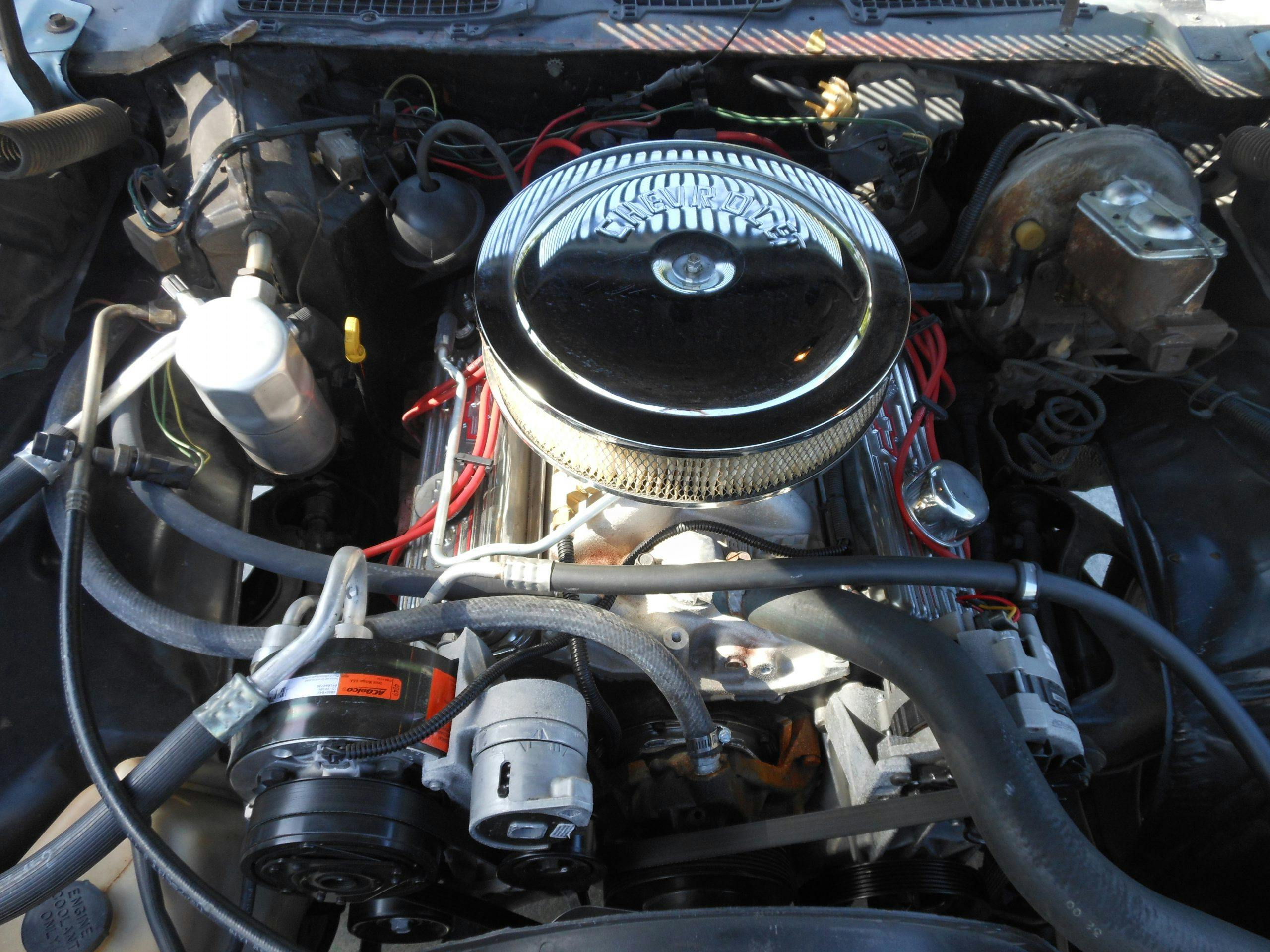


By 1978, the Camaro’s factory engine offerings weren’t much to write home about, with the top offering sputtering out just 170 hp. The body style was still quite sleek, however, making them just as good a project car as earlier second-generation Camaros. Luckily this car up for offer in Homestead, Florida, has a fresh 350 under the hood that replaced its 145-hp 305. Now with over twice the power, rowing the gears is even more fun.
Of course, we also have to mention the blue-on-blue, Canadian tuxedo look. We love it, and not just because Jay Leno is one of our writers. The paint has been refreshed, but that interior is original. We dare you to fight the urge to suit up in jeans and a chambray shirt when getting behind the wheel of this classic.
1989 Ford Mustang GT
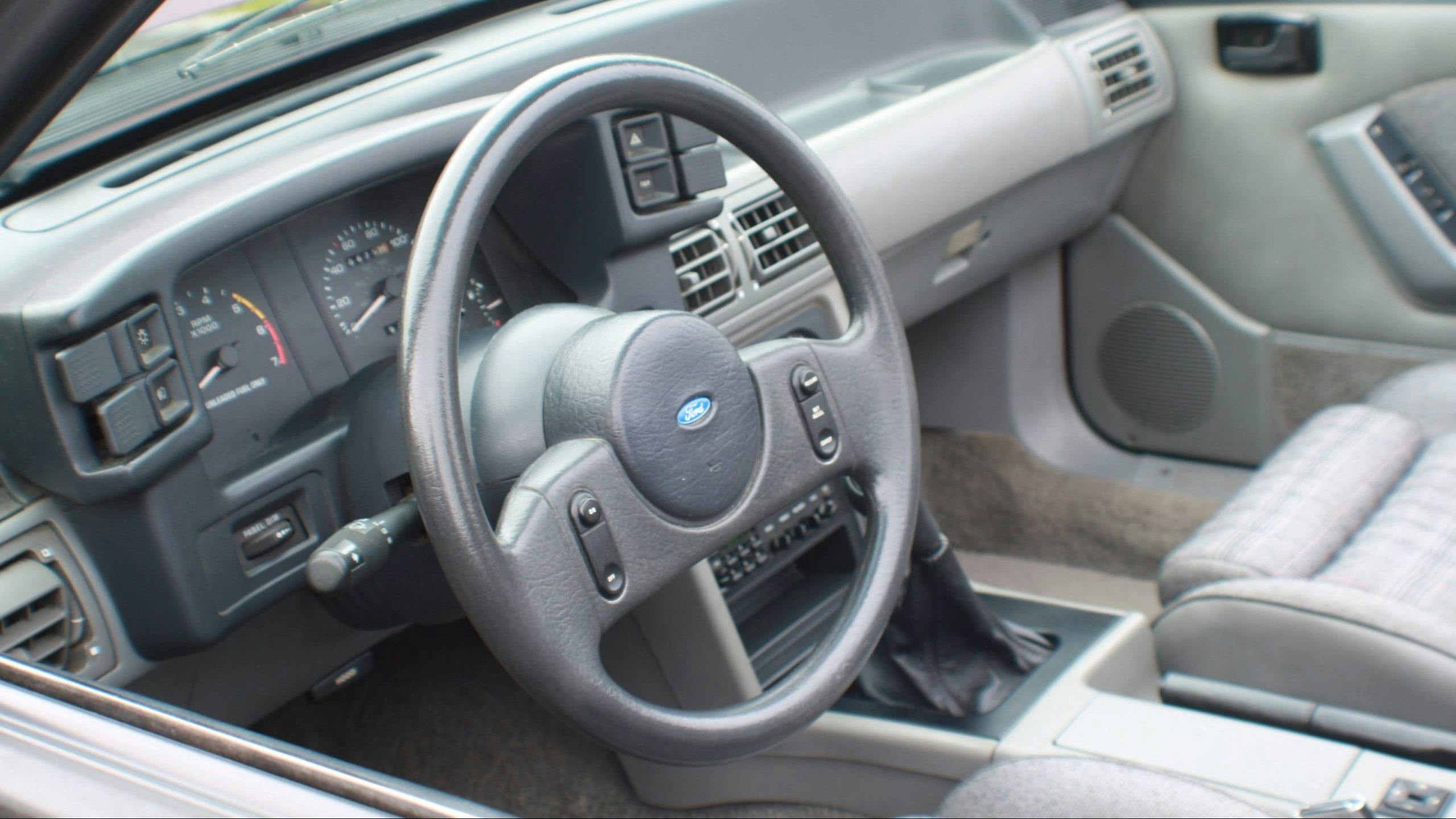


The lightweight Fox-body platform is like a Swiss Army knife and can be put into a variety of roles depending on the driver’s need. Their massive popularity and vast aftermarket of parts to choose from meant that they became the go-to chassis to build into a drag car, track toy, and everything in between. That also means that it has become increasingly more difficult to find clean examples of Mustangs from the ‘80s that didn’t turn into highly modified hot rods. Even this seemingly pristine example has been modified, in this case from automatic to manual transmission. However, if the right factory parts were used, and proper care was taken, this conversion could be seamless. We especially like this Cabernet Red over Titanium two-tone convertible because it does look like a well-maintained original as the interior as well as under the hood has aged quite nicely.
Check out the Hagerty Media homepage so you don’t miss a single story, or better yet, bookmark it.
The post 5 stick-shift classics for sub-$25K fun appeared first on Hagerty Media.
]]>
Fresh off driving the new Z06, I’ve been reminiscing about how Corvettes, particularly the C4 (the fourth generation built from 1984-96), were among the first cars to shape my budding automotive enthusiasm. My dad’s ’89 convertible formed the center of my elementary school car universe—little did we know that our spirited Saturday back road drives in Northern Virginia would lead to my amateur racing hobby and a career writing about cars.
Decades later, the C4 Corvette still represents an engaging sports car entry point. They’re affordable, too, with plenty of variations from which to choose.

“Younger enthusiasts can easily afford a nice, fourth-gen Corvette—they’re fun to drive and have good performance even by today’s standards,” said Harlan Charles, product marketing manager for the Corvette and Camaro, over breakfast ahead of the new Z06 drive. Charles owns a 1990 Corvette (six-speed, Z51) in white with a slate blue interior, and it’s been around the block a time or two. Since new, he’s driven it through 49 states and most of Canada’s provinces.
Why do C4 Corvettes remain so reasonably priced? A big part is because Chevy made so many—358,180 over the 12-model-year run—but that doesn’t tell the whole story.
“When you build a boatload of cars, most of which have been cared for better than your average commuter over the years, you have a supply that generally meets the demand,” said Greg Ingold, editor of the Hagerty Price Guide. “There are enough of them in good shape that if you’re in the market, and you don’t like the first couple you look at, there’s probably another six to choose from that meet your criteria at a similar price point.”
That wealth of quality cars to choose from has created what seems like a permanent buyer’s market for the C4. Even with recent valuation increases, solid drivers with low-ish miles and no major needs can be had for well under $20,000. Of course, newer and more desirable models will fetch more than the median prices. For example, as of our most recent price guide update, the 1995 ZR-1 (the last year of the famous “King of the Hill”) is valued at $27,600 in #3 (Good) condition, well above the median #3 value of just $9600 for base C4s. Nonetheless, with values of other marques from the same era seemingly going off the deep end, a driver-quality, 405-hp ’90s classic for under $30,000 presents a solid deal.
Having spent a day and a half with a 1990 ZR-1 recently, I can attest that Charles is right—C4s represent incredible sporting bang for your buck. The chassis is nimble, the controls well-weighted, and the LT5 engine eager to wind out to 6500 rpm. That said, the base L98 and LT1 engines in the base cars don’t disappoint, either. What they lack in rpm compared to the ZR-1 mill, they make up for in low-end torque and ease of maintenance. The ’84–89 and ’90–96 interiors each offer distinct period GM futurism, which has its own unique appeal.

What should you look for if the C4’s slick looks have caught your eye? While not an exhaustive list, here are a few things to think about: Early cars had a reputation for riding a little rough, though they received incremental improvements over the years. And though that period GM futurism gives them a unique look, C4 interiors also came with period GM squeaks and rattles.
Selective Ride Control debuted in 1989 as an option on the base car, and was standard on all ZR-1s from 1990–95. These three-way adjustable Bilstein dampers offered a tangible difference in ride quality, allowing you to toggle between a softer touring setting or two degrees of added firmness when you needed it. If you wanted full-time performance handling, you ticked the box for the Z51 package. Although only available on the coupe and varying in its contents by year, Z51 typically provided stiffer shocks, springs, and sway bars along with additional cooling capability, performance tires, and steering tweaks. The ZF six-speed transmission, also introduced in 1989, improved the shifting experience markedly from the prior Doug Nash 4+3 unit. The LT1 engine fired up in 1992, cracking the 300-horsepower barrier in a base Vette for the first time in 20 years. Convertibles also reemerged after a ten-year hiatus in 1986. Looking for something a little hotter? Chevy’s in-house ZR-1 (1990–1995) and Callaway’s twin-turbo Corvettes exemplify the era’s American entry into the supercar space.
Expect to pay a premium for certain options: The Z51 package is typically worth an additional $500, as is a glass targa roof on coupes. Hard tops for convertibles fetch an additional $1,000, and special editions, like the 1993 40th Anniversary cars or the 1996 Collector Edition are valued at an additional $3000 ($7500 for Anniversary ZR-1s). Automatic cars typically command 8–10 percent less than a similar manual-equipped Vette.
Despite its relative affordability and being a product of the ’80s, interest in fourth-gen Vettes still skews surprisingly older. Looking at quotes across the last three years, 27 percent come from Gen X (who are 32 percent of the market as a whole), 12% comes from Millennials (who are 21 percent of the market), 7 percent comes from Gen Z (who are 7 percent of the market), and 46 percent comes from Boomers (who are 35 percent of the market). Time will tell if the popularity of all things ’80s and ’90s will begin to draw younger interest to the C4, but we’ve been wondering that for a while now. Till then, there are plenty out there for the taking.
What would I choose? I'd look for a red '89 just like my dad's, but mine would be a coupe with the six-speed and Selective Ride Control. The L98's 245 hp is plenty, and I like the look of the pre-1991 facelift cars. Whatever model or trim strikes your fancy, the C4 Corvette will give you of-its-era character in a platform that's still fun today.
Check out the Hagerty Media homepage so you don’t miss a single story, or better yet, bookmark it.
The post Why the C4 Corvette deserves your attention appeared first on Hagerty Media.
]]>
Hot off an amazing first drive of the new Corvette Z06, and in recognition of the marque’s place as one of the most popular choices among Hagerty clients, we thought it’d be a good moment to throw a little light on America’s sports car.
America’s sports car, like America itself, has almost always been astounding in its diversity. Although it has never strayed from the basic two-seater concept, Corvette’s mile-wide option list has consistently fostered a broad swath of enthusiasts, from the cruiser crowd sporting convertibles with smooth-shifting automatics to horsepower addicts letting loose their roaring big-blocks and subsequent supercharged monsters.
To say this formula has worked would be a joke of an understatement—the Corvette, despite typically being the more pricey of the two, barely trails the Mustang as the most popular car Hagerty insures. A consequence of the everyman appeal is that the Corvette’s reputation has in some circles been more defined by its presence on the boulevard than the marque’s truly rich motorsports history.
And yet, within the broad mix of Corvettes, there have almost always been track-focused models. Many wear famous badges—“Grand Sport,” “Z06”–while others are buried in an alphabet soup of Chevrolet order codes. A few are high-dollar collectibles, but many remain undervalued to this day.
In honor of the debut of the latest and greatest of race-ready Corvettes, the 2023 Z06, we’re looking back at its track-focused predecessors.
First generation (1953–1961): Can you code?

It’s become a trope in articles about the Corvette to note that the first one kind of stunk. Having driven a ’54 with a Blue Flame Six, I’d say that’s unfair or, at the very least, imprecise. It’s a gorgeous piece of retro-futurism that drove at least as well as American passenger cars of its day, which was really the point. Remember that General Motors in the 1950s and at most other points in its history has been a design-first company; its sports cars, from this first Corvette through the Pontiac Fiero and even the fifth-generation Camaro, almost always tend to look better than they drive upon their debut.
The miracle of the C1 Corvette—and the reason the car survived its first decade—was Zora Arkus-Duntov. The engineer, himself a European import, joined GM in 1953 and almost immediately began stuffing Chevy’s Motorama car with mechanicals that made it capable of running with Mercedes and Jaguar. By the late 1950s, small-block V-8-powered Corvettes were fixtures at Daytona and Sebring. Factory-prepped first-generation Corvettes even won their class at LeMans in 1960.

Racing C1 Corvettes tend toward unobtainable, particularly when there’s a name like Cunningham associated with them. To give you an idea, check out our auction report on one of those Le Mans cars. Missing many of its original components and in need of a complete restoration, it nevertheless brought $758,500 at Amelia Island last year.
Fortunately, many of the improvements Arkus-Duntov and crew developed for the track made it to the street as “regular production options.” For instance, checking RPO 684 in 1957 netted heavy-duty brakes and suspension, and RPO 449 got you a so-called “Duntov cam.” The right combination of options transformed early Corvettes into what Chevy advertisements of the day proclaimed to be ”The Real McCoy,” and today bring serious money. For instance, one sold at Mecum Kissimmee earlier this year with several choice RPOs brought $440,000.
First-generation Corvettes would in many ways be eclipsed by the high-performance machines to come in the ensuing decades. Yet in the late 1950s, Corvettes dominated their class in SCCA racing. More important, the car’s achievements in competition directly fed performance improvements on the street. In that sense, C1 Corvettes were the ultimate track cars.
Second-generation (1963–1967) — Grand and sporty

Second-generation Corvette race cars suffered from a case of bad timing. I don’t mean distributor adjustment—rather, GM’s execs adhered more closely than others in Detroit to the 1957 Automobile Manufacturer’s Association ban on corporate-backed racing, effectively tying one of Zora’s arms behind his back. Only 199 race-prepped Z06-package Corvettes made it out the factory door, and the package disappeared after 1963. Even the ultra-rare, lightweight Grand Sports achieved only a few moments of glory in the Bahamas before the suits put the kabosh on things. To add insult to injury, history casts the long shadow of a certain chicken farmer and his Ford V-8-powered AC Ace over the legitimately fast and capable Grand Sports and period Corvette race cars.
Whatever. Sting Rays are awesome. Just sit in a 1963 split-window fuelie—Z06 or not—and listen to the tap-tap-tap of its solid-lifter fuel-injected V-8, and you’ll get it. The collector car market certainly does. Z06 values start just shy of half a million; rare “Big Tank” models, so-named for their optional 36-gallon fuel tanks, usually go for just above that mark. Were one of the competition Grand Sports to hit the open market, it’s safe to say bidding would run well into seven figures.
Third-generation (1968–1982) — Cheap speed

These were the highest production years for the Corvette and they remain plentiful today. Correspondingly, there’s usually more than a few at vintage races—and if you get lucky you’ll see a Greenwood Vette. Naturally, the best and most valuable production performers of the bunch come from early in the car’s long run, before smog controls got their way. The ZR1 package, offered from 1970–72, combined the highest output small-block, the 330-hp LT1, with a close-ratio four-speed and heavy duty suspension. These days those cars can command around $130k—roughly a seventy percent premium over standard LT1 cars. Considering big-block L88 Vettes of the era can command half a million dollars, that’s actually a lot of bang for your buck.
Later third-generation Corvettes offer much less bang: A base 1980 Vette was rated at just 190 hp. Yet the irony is that the very shortcomings of these cars what make them interesting, if unconventional, choices to bring the race track today. Namely, they’re relatively common and, due to their unimpressive performance, remain quite affordable. Excellent examples from the era go for about $30,000. A rough driver—the sort you wouldn’t feel bad about modifying and fitting with a roll cage—can be had for less than ten grand. Before you take to your keyboard to say I’m out of my mind, there’s a Riley-built (yes, of the same Riley Technologies that’s won the Rolex 24 at Daytona 13 times) C3 Corvette that campaigns regularly in the budget-racing Champcar Endurance Series.
Fourth–generation (1984–1996) – The King and its court
My colleague Eddy Eckart has just explained why fourth-gen Vettes remain criminally underrated, so let’s focus here on the practical question of which variant is best suited for track duty. The obvious choice is the 405-hp ZR-1, and it’s not a bad one, considering nice examples can still be had for less than $50,000. Throughout the C4’s run, however, even lesser models were incredibly capable. L98-powered Corvettes so thoroughly dominated their class (and embarrassed the 944 Turbo) in SCCA racing that the league created the standalone Corvette Challenge series. Despite their period performance, they remain downright cheap: a base Corvette from 1992, the debut year for the redesigned, 300-hp small-block V-8, goes for less than $20,000 even in excellent condition. As with all Corvettes, fluency with GM RPO codes can net track goodies: Z51 for heavy duty suspension and bigger brakes (among other things that vary by year), FX3 for adjustable dampers, Z07 in later years for all the above plus some other bits.
I’d be remiss not to mention the last and perhaps the best of the C4s, the 1996 GS, which offered a 330-hp V-8 (called the LT4) along with a stiffer suspension and a rather neat paint scheme that paid homage to those earlier 1960s Grand Sports. Only a thousand were built, though, and a great many of those have been pampered from new, meaning they might be just a bit too nice to exercise regularly on track.
Fifth-generation (1997–2004) — Z06 returns
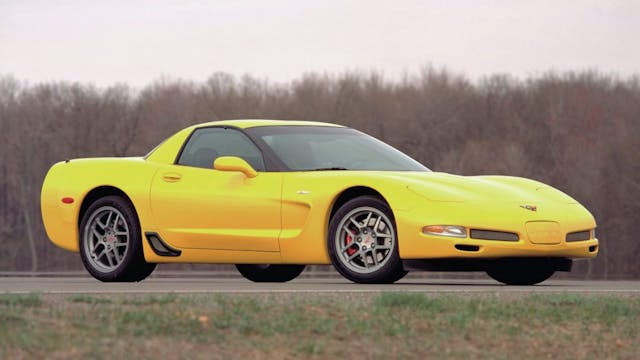
The tip-of-the-spear 2001–2004 Z06 was and remains a performance bargain, what with its 405-hp V-8 (385-hp for 2001), upgraded suspension, and myriad weight-saving measures (most notably a fixed-roof with smaller rear glass). Really nice ones go for about thirty-five grand, which is kind of wild considering that roughly contemporary (and not nearly as capable in stock form) Toyota Supras are going for five times as much.
Yet what makes this generation of Corvette stand out is that it is the first—at least from a modern perspective—that will acquit itself well on track in just about any guise. The car introduced an all-new aluminum-block V-8—the LS1, perhaps you’ve heard of it—and came with a series of handling packages from the get-go. We’d probably look for a fixed-roof coupe, which was slightly more rigid and came standard with the heavy-duty Z51 suspension, but really, it’s hard to go wrong. C5 values bottomed out about four years ago and have since been creeping up, with really nice examples selling for less than $30,000.
Sixth-generation (2005–2013) — Z06, right-sized

Yes, the ZR-1 was the fastest Vette, ever, when it debuted. The Z06, meanwhile, was specifically engineered for track duty and has one of the most memorable modern V-8s—a 7.0-liter that revs with the willingness of a Honda four-cylinder. So why would I suggest the less-powerful, steel-framed Grand Sport? To some degree, it’s a numbers game. The Grand Sport was produced in higher volume than either of the Zs, and surprisingly its production outstripped even the narrow-body base cars from its introduction in 2010 through the end of the C6 in 2013. It’s the less expensive performance variant, and supply means it’s likely to stay that way. If you’re actually looking to visit the track with any regularity, that’s a feature, not a bug.
But I’d also suggest that the Grand Sport is in some respects a right-sized experience. It offers the additional capabilities of Z06-sized brakes and rubber, along with dry-sump oiling and additional fluid coolers. It’s down on power from the LS7, but the LS3 provides plenty of oomph, and with the added grip, the Grand Sport is a little less hairy at the limit that its bigger siblings are known to be. Here’s where I should disclose that I’m by no means a hot shoe. Your tastes and skills may differ. The bigger takeaway is that these early 2000s Vettes come in a variety of highly capable guises. And with the exception of the ZR1, which has rebounded into six figures, they still go for used-luxury-car prices.
Seventh-generation (2014–2019) — Get ’em while they’re used
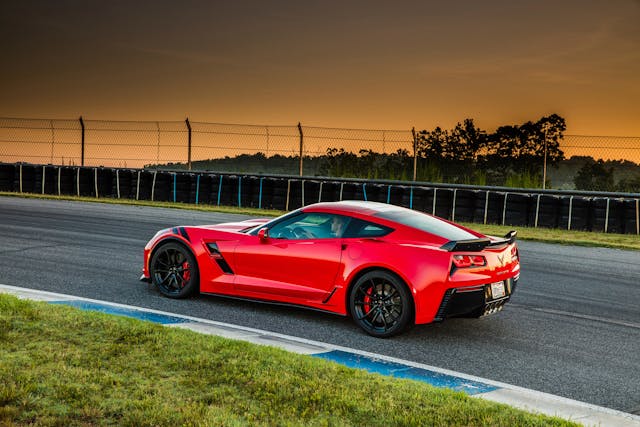
The hottest part of the collector car market at present is so-called “analog” sports cars of the 1990s and early 2000s. The recently-departed C7 Corvette may find itself in that coveted class sooner rather than later. It is, after all, the last Corvette—and likely will be among the last cars, period—to feature a normally aspirated pushrod V-8 up front powering the rear wheels through a manual transmission. What makes this Corvette so clever—and enjoyable to drive on track—is that it actually does employ lots of modern technology, chiefly a computer-controlled rear differential (with the Z51 package) that constantly polishes your driving. The tech works so subtly, and the car is so communicative, that you can simply imagine you’re a more talented version of yourself, while basking in V-8 roar.
Pretty much any C7 with the Z51 package (stiffer dampers, bigger brakes, e-diff) performs amazing feats on track. Higher-spec models take that formula and, to varying degrees, add heaps of downforce, tire, and power. The Z06s of the era, with their supercharged V-8s, have been knocked for overheating on track, although later model years did receive some updates to help matters. Beyond that, however, there’s a simple question of how fast you want to go. If the answer is, ”so, so fast,” there’s a ZR1 ZTK package out there waiting for you, although be warned: they haven’t depreciated. Again, the Grand Sport seems a happy medium for many, pairing much of the Z06’s suspension and aero with a milder normally aspirated V-8. Given that many owners are still making new-car payments on C7s, pricing data on them is much thinner than for earlier models. Yet based on data from Hagerty insurance quotes, it’s safe to say you can find a Grand Sport for around $60,000—slightly less than original MSRP. Just remember to budget for its custom-compound Michelin Pilot Sport Cup tires (more than $2000 a set).
The post The most track-capable Corvettes from every generation appeared first on Hagerty Media.
]]>
Since robot drivers don’t get tired, check the ’gram from behind the wheel, or indulge in a three-martini lunch, they’re obviously safer, right? That’s a hard hypothesis to argue against since a huge percentage of traffic fatalities are caused by impaired drivers. Waymo, the autonomous driver company started by Google, went a step further and tried to quantify just how much safer.
In a recently released study, Waymo created a simulated superhuman driver, who was always alert, whom it pitted against its robots. Not surprisingly, Waymo’s computerized modeling demonstrated that the robot avoided 75% of collisions while the computer-generated “human” managed to avoid disaster only 62.5% of the time. If this sounds like academic navel gazing, the point, according to this article in The Verge, is to develop methods for evaluating the safety performance of robot drivers. The article also speculates that the Waymo study might spur legislators to allow more AVs on the road.
Speaking of legislators, New York announced that it plans to adopt California’s EV mandate. You’ll remember that California announced in August that it will end the sale of gasoline-powered cars in 2035. Well, sort of. The Empire State’s proposed rules differ slightly and will give plug-in hybrids the same status as EVs.
Meanwhile, Akio Toyoda, the President of Toyota, defended his company’s strategy of investing in EVs but not planning to completely switch to an all-electric lineup. Toyoda cited concerns over the supply of battery metals and the charging infrastructure while also pointing out that Toyota’s plug-in hybrids serve most customers for less money than EVs. Interestingly, Toyoda is also bullish on hydrogen-fuel cells, a technology which seems forever in purgatory.
The biggest news of the past week, for us car fans, was the debut of the hottest Corvette ever produced, the new Z06. Hagerty’s Eddy Eckart drove it on-track and wrote this review, and here’s the Cliff’s Notes version: The car’s a heart-stopper—supercar-fast but practical. In traditional Corvette fashion, it’s also a great value. My favorite bit is the engine, a 5.5-liter V-8 that revs to 8600 rpm, produces 670 horsepower, and scoots the Z06 to 60 mph in under three seconds. Top speed is just under 200 mph. Holy moly. Check out Don Sherman’s detailed explanation of this extraordinary powerplant. If this is the last gas-burning Corvette—and that is pure speculation—I can’t imagine a more fitting tribute.

Another car in the “fastest” category is the new Porsche 911 GT3 RS. We’ve produced both a written review and a video. This car has another cracking engine, a 4.0-liter six-cylinder with 518 horsepower, a 9000-rpm redline, and an engine wail that’ll give even the dead goosebumps. We debate all the time if the Corvette and 911 are marketplace rivals. Porsche folks typically respect the Corvette but would not consider owning one. The same goes in reverse for ‘Vette people. Yet the two race in the same classes in GT racing, lure buyers with ever-more-powerful high-performance models, and are proof that at least two companies understand the passion of folks like us.
These are very heady days.
Hear from me every Friday by subscribing to this newsletter.
The post Never Stop Driving #21: The Corvette Z06 and superhuman drivers appeared first on Hagerty Media.
]]>
In celebration of our first drive review of the rip-roaring new Corvette Z06, we got to cooking on a list of the coolest—and most unique—Corvettes to ever cross a finish line. After all, the package began as a low-profile effort to put competition parts in the hand of SCCA’s A-Production racers. This was back in the 1960s, when GM elected to (officially) withhold factory support in motorsports in the years following the tragedy at Le Mans. For less than two grand, “Zora’s Option 6” delivered a 360-horsepower 327-cubic-inch small block, aluminum wheels, a limited-slip diff, and more robust suspension components including a larger sway bar and stiffer springs.
Shortly thereafter, a Z06 first found victory lane at the hands of Mickey Thompson and Doug Hooper. And while Z06-specific victories represent a slim slice of the Corvette’s overall racing triumphs, much of the marque’s success, whether on a road course or a drag strip, should be attributed to those primordial Corvette competitors. Cheers to the Z06; thanks for keeping the lights on.
Betty Skelton’s 1956 Corvette

Naturally, before the Z06 package ever graced GM’s option list, hot-rodded Corvettes still found their way to the track. The model’s first-generation was more than a worthy canvas for go-fast alterations. Many rolled into victory lane in national club racing. Though, arguably more unique than the roll-bar-wearing C1’s that captured checkers from Sebring to Le Mans, were the group of relatively stock appearing racers that performed speed trials on Daytona Beach.
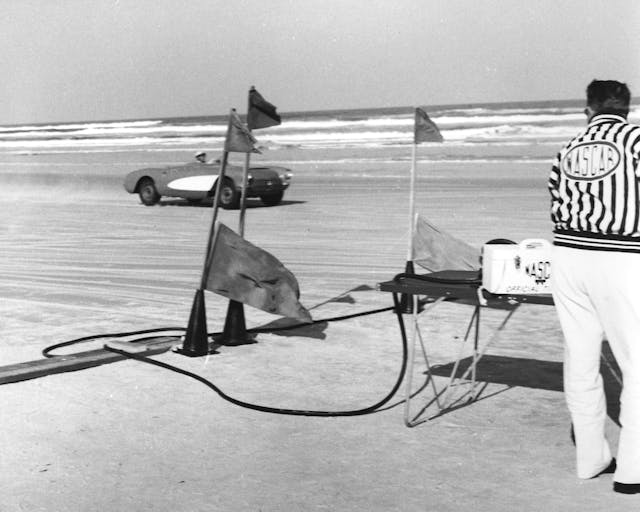
Of the Chevrolet roadster drivers, Betty Skelton was the star. Known as “The Lady of Firsts,” she was an aerobatics pilot, first, before transitioning to competition on four wheels. She was the first woman to pace the Daytona 500 as well as the first woman to test drive for Chrysler. Skelton was also the first woman to be inducted into the Corvette Hall of Fame. Pictured here in 1956 aboard a Vette of the same year, Skelton would end up setting three women’s land speed records on the Daytona Beach course.
Cunningham’s 1960 Corvette at Le Mans

In 1960, Zora Arkus-Duntov and American privateer Briggs Cunningham teamed up to enter Corvette in its first 24 Hours of Le Mans. For the model’s French coming out party, the team used three 1960 Corvettes with go-fast goodies including 283-cubic-inch Fuelies, heavy duty brakes, a beefier suspension, and limited-slip differentials. At the conclusion of 24 hours, one of the three had upset the field of Euro counterparts Ferrari, Aston Martin, and Porsche to win the GT class—and finish eighth overall.

Corvette’s stellar rookie run at Le Mans would set the tone for future landmark performances at the iconic endurance race.
1963 Grand Sport Corvette

Perhaps inspired by the performance at Le Mans in 1960, Zora commissioned and oversaw the development of a lightweight, ultra-powerful apex-eater called the Corvette Grand Sport. His original plan was to build 125 lightweight homologation models to satisfy road racing’s GT rulebook. But in 1963, the program ran head-on into GM’s self-imposed racing ban and had to cease production on the racers. Still, several made it through, and of the finished Grand Sports, Zora and his team distributed them to privateer teams.


Of the rare breed, perhaps the most notable was Chassis #005, which traded hands several times between John Mecom, Jim Hall, and Roger Penkse. Before Penske became “The Captain,” and before Texan Jim Hall ever built a Chaparral race car, they teamed up to drive the Grand Sport in select races, such as the 12 hours of Sebring (shown above).
Don Kirby’s Corvette Funny Car

While many factory stock Corvettes infested the local drag strips from Englishtown to Lions, in period, there are a few more obscure fiberglass creations that turned heads in NHRA’s Funny Car class. Tom McEwen, the Mongoose himself, even ran a rather wicked C3-bodied flopper after his stint in Mopars.
It’s Don Kirby’s candy red second-gen funny that has us absolutely salivating. If you live life a quarter-mile at a time, the name may strike you as familiar. During the glory days of NHRA’s fiberglass funnies, Kirby owned a fiberglass repair and paint shop that was known as the Funny Car Supermarket. There, Kirby and his team could make, paint, letter, and mount a new body. According to a profile in Hot Rod, the shop could churn out 20 painted cars in a month. As a fiberglass repair shop in the 1970s, you can imagine that a fair number of damaged Plastic Fantastics rolled into the garage bays. Perhaps, this is why Kirby elected to utilize a C2 for his personal flopper. “When [Kirby] unveiled his ‘topless’ model, everyone took notice,” wrote Car Craft back in the day. “His first week out produced a 198 mile-per-hour shot at the lights.”
Spirit of Sebring ’76 Greenwood Corvette

Detroit-born brothers John and Burt Greenwood were Corvette’s motorsports strongmen during the 1970s and 80s. John grew up street racing down the Motor City’s Woodward Ave in his 1964 Corvette, before eventually turning to SCCA competition where he won early and often.

The duo’s most famous creations were their wide-body third-gen Corvettes which tap-danced between rulebook margins. Its first iteration debuted on the floor of Cobo Hall for the 1974 Detroit Auto Show. The second group of Greenwood C3s featured coil overs on all four corners and an even more aggressive aero package, like the Spirit of Sebring ’76 pictured here. Under the Revolutionary scheme, boomed a different type of canon—a 467-cubic inch aluminum big-block V-8, producing north of 700 horsepower.
Hendrick Motorsports’ Corvette GTP racer

It may come as a surprise that a mid-engine Corvette raced in professional road racing competition over three decades before the first mid-engine Corvette road car was born. Gm partnered with Lola to create a purpose-built tube frame sports car draped in a very loose interpretation of fourth-gen Corvette bodywork. Save for some stickers and maybe the nose, it was a stretch to call the beast a Corvette. Beginning in 1984, the IMSA grid featured a couple of these GTP racers with car-specific powerplants. Lee Racing campaigned a 5.7-liter V-8 block, while Hendrick Motorsports (pictured here) used a 3.4-liter turbocharged V-6 in its Goodwrench-liveried ‘Vette.
Corvette Racing’s C5.R

In the early-1990s racing manager Doug Fehan convinced GM to campaign its C5 Corvette—which was mid-development—and eventually enlisted car builders Pratt & Miller to transform the develop the model into a purpose-built road racer. The car debuted on the grid of the 1999 Rolex 24 Hours of Daytona.
Two years, one first Le Mans debut, and a first win later Corvette Racing was back at the Florida high banks, this time, with “the Intimidator” Dale Earnhardt and his son splitting driving duties with team regular Andy Pilgrim. That year was also special for the Corvette crew, as the sister car claimed first overall, a rare feat for GT cars.
Corvette Racing’s C8.R

Another Pratt & Miller-built beast, the C8.R debuted in 2020, in conjunction with the release of the mid-engine production car. Featuring a race version of the LT6 small block, the 5.5-liter naturally aspirated V8 propelled the novel car to six class victories in its debut season. A year later, the mid-engine racer won its class victory in the Rolex 24, sweeping the top two steps of GT competition.

Check out the Hagerty Media homepage so you don’t miss a single story, or better yet, bookmark it.
The post 8 essential Corvette race cars you should know appeared first on Hagerty Media.
]]>
When the Z06’s new LT6 V-8 fires up, I can’t help but grin at its bark. Then … I wait, snug in the driver’s seat. Another wave of thick, heavy rain splatters on the tarmac of Pittsburgh International Race Complex.
In some sense, we’ve been waiting to drive this car for decades. A mid-engine Corvette designed for the race track has been on Chevrolet’s to-do list since Zora Arkus-Duntov’s early days with Corvette, yet it never materialized for real. The base eighth-generation Corvette (C8), while excellent in its own right, merely whet our appetite for what everyone knew was coming. We practically salivated when the new Z06 finally broke cover last fall, and with production now underway, we’ve gotten our chance to chow down.

Once there’s a break in the storm and just enough of a dry line on the track, I venture out of the paddock. PittRace is a challenging course under the best of circumstances—a 2.78-mile mix of esses, plunging and soaring elevation changes, and straights long enough to savor the Z06’s IMSA-worthy downshifts into braking zones. Here in the wet, a track like this can highlight a car’s chassis dynamics if you’re willing to push it, and doing so can also lay bare any dirty secrets.
Tap into the throttle for the first time, however, and everyone within earshot will know: this LT6’s wail yields a Corvette like none other. As much as the switch to a mid-engine platform for this generation dramatically altered the character of America’s sports car, Chevy’s flat-plane-crank engine adds a uniquely visceral persona.
The flat-plane-crank, dual-overhead cam engine finds 8600 rpm faster than any 5.5-liter V-8 has right to. “I’m already going that fast?” is something I find myself thinking over and over. There’s no turbo-torque brutality, no silent-electric-tunnel-vision-warp: just rocket-like thrust, delivered across a linear powerband, put cleanly to pavement.



Paired with the LT6 is an eight-speed dual-clutch automatic transmission similar to that of the base car, albeit with a shorter (5.56) final drive ratio and upgrades to the case as well as clutch and lubrication systems. Left in full auto mode on track, the transmission pops off crisp but not harsh upshifts at redline and finds the right gear in every braking zone. In manual mode, using the Corvette’s paddles, shifts are immediate and smooth.
In the run-up to the Z06’s production, much of the coverage has fixated on the engine. That’s justified, since it’s a masterpiece—the highest-output naturally aspirated V-8 in production-car history. (You can read our full engineering breakdown of it here.) But what really stuns me, on this damp track, is how composed the chassis feels. The C6- and C7-generation Z06 Corvettes demanded respect because their control, especially at the limit, was not always on par with their power. This C8 Z06 will still bite you if you’re not careful—it is a 670-hp big-tired mid-engine monster, after all. Yet it’s a well-trained monster. Turn four, a varied-camber downhill right-hander, requires very precise throttle application on exit. On one lap, my foot is more two-pound hammer than the eight-ounce mallet the corner calls for; in that moment, the heavier rear end steps out. In a split second I visualize a stern talking-to from Corvette Executive Chief Engineer Tadge Juechter. Instead, two decent flicks of counter-steer and a little throttle modulation straightens it all out. Wow. This chassis is good.

Chevy’s Performance Traction Management (a sliding scale of computer-controlled stability intervention) wasn’t fully off during my laps, and I’m certain it would have chimed in had I induced too much yaw. Still, a balanced, forgiving chassis provides a lot of confidence to explore this car’s capabilities. This is not true of all prior Z06s.
The chassis likewise exhibits impressive balance through the sequence of esses at PittRace. Set on full stiffness, the steering feels properly weighted and beautifully transmits tire/tarmac conversations. The car transitions side to side with particular poise. There’s a certain tautness to the chassis during lateral weight transfer—enough to confidently initiate quick-pitch changes like you would in a race car. The throttle’s long travel and exacting precision allows you to adjust the front/rear balance seemingly by the gram.
Damp straights on track require longer, more deliberate brake zones, so I don’t get anywhere close to limits of the carbon-ceramic brakes. Nonetheless, the brake-by-wire system provides confident pedal feel. I prefer the middle setting over full firmness, but drivers will appreciate the adjustability.

In the brief window where there was decent grip on track, the Z06’s personality rose to the surface. Nail corner entry, roll into that howl-inducing throttle to hit the apex at the edge of adhesion, and the Z06 screams toward corner exit. That apex-to-track out acceleration, carrying lateral momentum while warping forward amid primal sound and speed—that’s when I realized it. To extract everything out of the Z06 is to bring the best driver out of yourself. This is not one of those supercars where you’re just strapping in for the ride and letting computers do the hard work. That challenge—and the reward when you meet it—is why you buy a car like this.
Not every corner will yield moments of nirvana, especially on the street. And the elements that produce a track darling don’t often translate in a more docile environment. In order to sample the Z06 in the fashion the overwhelming majority of owners will use it, I spirit away a black 3LZ Convertible Z06 for a two-hour loop through Western Pennsylvania back roads.
Luck of the draw got me a car in 70th Anniversary guise. Base MSRP was $125,850, but $34,965 worth of options, including carbon-ceramic brakes ($8495); the painted carbon aero package (also $8495); and the 70th Anniversary special edition package ($5995) topped this car out at $162,210. That isn’t just a lot of money for a Corvette—it’s a lot of money, period. Yet at the same time, for the car you get it’s a screaming deal.

Whether you have the top down or up on the street, there’s no question that the engine’s the star of the show. The flat-plane crank/dual-clutch pairing makes you want to play with the paddles all day long just to hear the rev-matched downshifts and the instant-rpm-reset upshifts. Choose wisely where you let the Z06 play the song of its people, though; it’s sure to draw attention. You can always put the car in stealth mode to close the exhaust baffles if your neighbors aren’t the sort to appreciate this fine Bowling Green melody.
If you’re a stop-light racer, be aware that off-the-line torque feels slightly less potent than in the base car’s pushrod engine (they both make 470 lb-ft, just at different rpm: 5150 rpm in the LT2 and 6300 in the LT6). But the theater in the Z06 makes up for this perception. Likely due to its large displacement for a flat-plane crank engine, it is perfectly tractable around town.
My primary concern going into my road drive was that the pixie dust magic I felt in the Z06 on the track would take away from the base C8 Corvette’s incredible touring capability. With 30 percent stiffer springs than the Z51-package car and unique magnetic damper tuning, the Z06 with the standard FE6 suspension ought to be an excessively firm-riding car. And yet, it isn’t. You don’t forget what you’re in—the Z06 is definitely stiff. (The more track-oriented Z07 package with FE7 setup—curse GM’s alphanumerics—is stiffer still.) But it’s never harsh, and the suspension doesn’t crash over potholes or expansion joints. Only once in the softest mode (Tour) does the car get flustered, thanks to some small, high-frequency bumps. The large 275-section front and enormous 345-section rear Michelin PS4S tires do not tramline or dramatically pull the car on crowned and sometimes rutted asphalt of the Pennsylvania mining roads we traverse. Even the stiffest suspension setting—which really isn’t necessary on the street—isn’t punishing.

Of all the numerous settings available to configure, only one stands out as not suiting the car’s personality. Tour mode’s default steering was so light that I found myself constantly making minor adjustments. On a car so dialed in, light steering weight transfers every tiny hand motion to the rack. Fortunately, it’s easily solved by switching to the customizable My Mode and manually setting the car to soft-riding Touring spec but with heavier steering.
Park a base C8 next to a Z06 without an aero package and most of the differences are subtle. You notice the added width first—3.6 inches at the back of the car. The revised side intakes look like they’ve been pulled off an F35 fighter jet, but overall the Z is cleaner. The angle of the front fascia’s strakes between radiator openings are reversed and now flow with the lines of the headlights and the creases on the hood. Whether you get the standard forged aluminum or the optional carbon-fiber wheels (the latter alone shaves 1.5 seconds per lap on a two-minute circuit), the rollers are more aggressive and motorsport-oriented. At the back, a center-exit exhaust system (thankfully) replaces the awkward square-tipped corner exhaust from the base car.

Add the optional aero package to the Z06 and the supercar vibe comes alive. The rear wing, chin spoiler, and canards—all carbon fiber—integrate well into the design and amplify the car’s visual character.
The interior is mostly carried over from the base car, excepting a different door stitch pattern, Z06 badges on the door sills and waterfall, and a detailed image of the engine on the screen at start up.
Extensive personalization has become a much more integral part of the Corvette formula than in previous models. Chevrolet noticed how much buyers appreciate these custom touches, and I can only assume GM is happy to reap the same kind of profits that Porsche and McLaren have enjoyed from similar programs. Previous Corvettes waded in that direction with carbon packages and anniversary editions, but this Z06 is the first ‘Vette to dive fully into the deep end. Both coupe and convertible are available with the Z07 package, which adds the carbon wheels with Michelin Cup 2R tires, carbon-ceramic brakes, stiffer springs with unique magnetic damper and steering rack tuning, and a full aero package that includes a dramatic rear wing. Add in a massive variety of colors across the interior, exterior, wheels and calipers, and it makes for a Z06 that can either be understated, ostentatious, or somewhere in between. Think Porsche 911 GT3 or GT3 Touring, but with a much broader spectrum of performance from the standard Z06 to the Z07.

Many of those GT3s spend their lives tooling around places like Los Angeles, flaunting their wide fenders and sticky rubber to dinner and back. There’s a good chance you’ll see a lot of track-spec Z06s meet a similar fate, and that’s OK. The more Corvettes that sell, no matter how they are used, justifies their continued existence. That said, if you’re taking a look at a Z06, build it to how you’re going to use it. The options are there to make it your own.
The popularity of the 2019 ZR1 (starting at about $120,000) proved Corvette fans are willing to pay up for something special. With the Z06, the Corvette team took a solid base car, walloped it with a joy-inducing engine, a highly advanced suspension, and a wide array of options. It’s the most capable and configurable Corvette ever. The mid-engine Z06, some sixty years in the making, was worth the wait.
2023 Chevrolet Corvette Z06
Price: $106,395 (base)
Highs: Incredible engine. Excellent on track without penalty on the street. Character galore.
Lows: Ingress/egress can be tricky. Tour Mode steering is too light … and that’s it.
Takeaway: The most capable Corvette ever sets a new benchmark for the American supercar.

















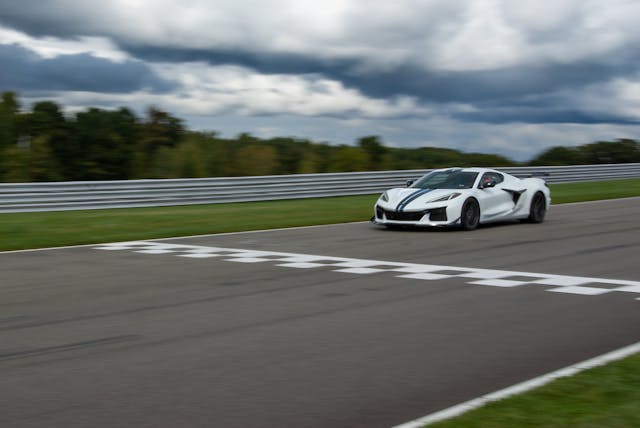







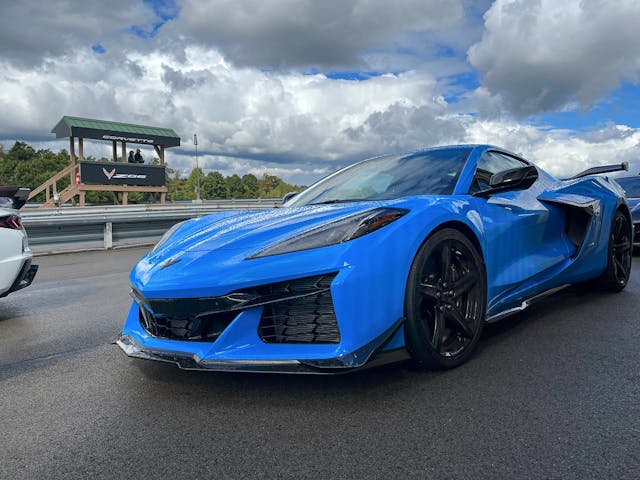


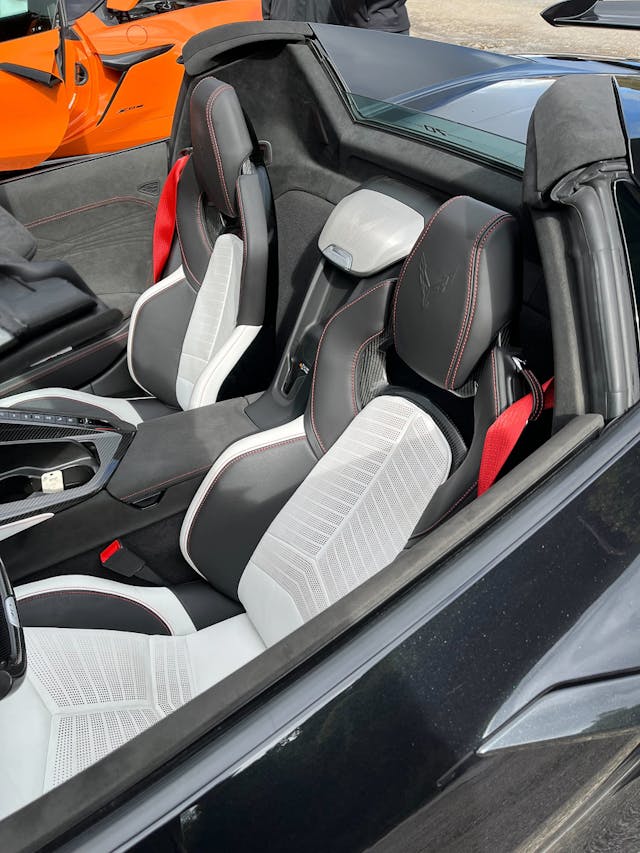



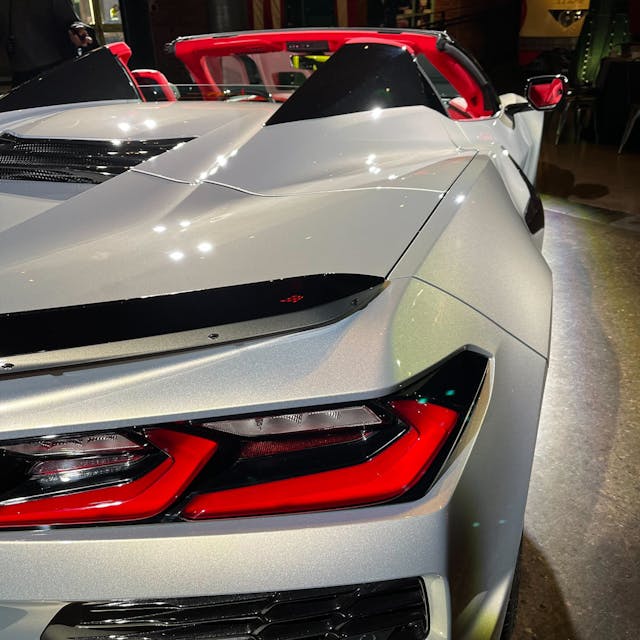


The post Review: The 2023 Chevrolet Corvette Z06 redefines the American supercar appeared first on Hagerty Media.
]]>
Following the 1955 24 Hours of LeMans debacle, when a collision between two competitors resulted in 82 spectator deaths, American automakers put heads together to keep their motorsports participation from attracting the attention of Congressional meddlers. In early 1957, a “gentlemen’s agreement” was contrived to cease and desist direct racing involvement.
That prompted two GM divisions—Chevrolet and Pontiac—which were genuinely serious about motorsports to simply hunker down and keep low profiles. Stealthy cloaks and daggers were implemented to enable continued competition—and victory.
With tantalizing youth market stakes in play, Henry Ford II grew tired of GM (and to a lesser extent Chrysler) eating his company’s lunch. Alas, in 1962 he let loose by announcing the Total Performance advertising campaign. This global initiative authorized direct support of Ford-powered Le Mans racers (GT40s), NASCAR stockers, NHRA drag cars, and Indy 500 machines.
Meanwhile, top GM executives feared a U.S. Justice Department anti-trust investigation of how, exactly, the company had earned more than a 50 percent share of the U.S. car and truck market. That worry kept in place the General’s ban on building and campaigning hotter models for the track. Remember: low profile.
1963: The original Z06

Enter the Corvette’s patron saint (and after 1967, chief engineer) Zora Arkus-Duntov. Having driven five years at LeMans in the 1950s and earning class victories in ‘54 and ’55 factory Porsches, he was no stranger to motorsports politics.
Following the arrival of the (Ford) Shelby Cobras in 1962, Arkus-Duntov understood that Corvette owners needed competition parts to safeguard their Sports Car Club of America’s (SCCA) A-Production turf. The trick was developing a clandestine strategy that would avoid alerting GM’s upper management. To draw potential competitors, Arkus-Duntov gave a new-for-1963 racing package the codename “Zora’s Option 6.” The Z06 (with a zero substituted for the sub-rosa O) was listed as a regular-production-option.
Z06 hardware, offered on coupes for $1818.45, included a 360-horsepower, 327-cubic inch V-8 engine; center-lock aluminum wheels; a limited-slip differential with various final-drive ratios; a 36-gallon fuel tank in the luggage compartment; and a heavy-duty suspension with stiffer springs, larger front anti-roll bar, and larger rear shock absorbers.
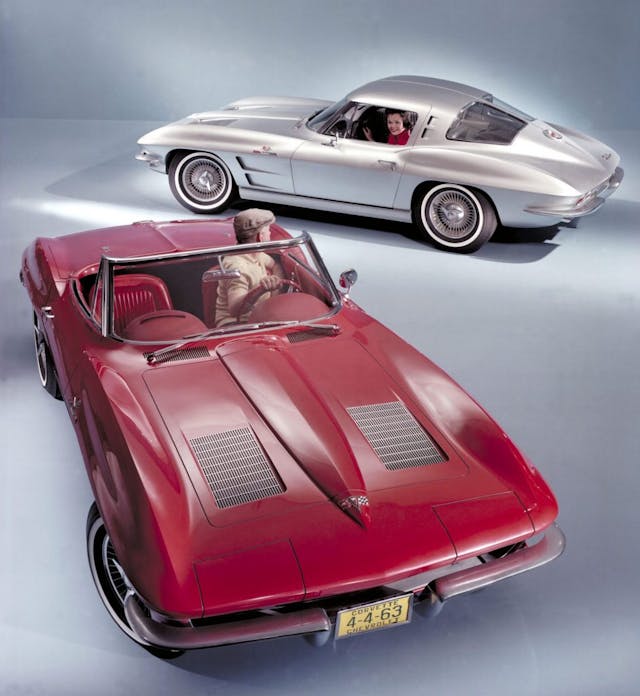
When issues with the wheels arose, they and the large fuel tank were deleted from the package, lowering the retail price to $1293.95 (almost $12,000 today). Z06 equipment was also fitted to a few 1963 convertibles, lifting the total volume for the introductory year to 199 cars. Given the base Corvette’s $4037 price, Z06 was obviously intended only for those with serious off-road intent. To reduce the sting a bit, deleting the heater and defroster yielded a $100 credit.
An epic confrontation transpired in October 1962, when three Corvette Z06s faced off against one of the first Shelby Cobras at the Los Angeles Times three-hour invitational road race staged in Riverside, California. While the Cobra driven by Bill Krause was competitively quick, it DNFed after 90 minutes with a failed rear hub carrier. Two Corvettes suffered major engine issues but the third—fielded by Mickey Thompson and driven by Doug Hooper—beat a Porsche 356 to seize an overall victory.
Shortly thereafter, Chevrolet Engineering purchased one of the early Shelby Cobras, a white car acquired for Arkus-Duntov’s evaluation. The Cobra’s 900-pound weight advantage inspired his 1963 Corvette Grand Sport, a hoped-for 100-car run of ultra-light sports cars which GM nipped in the bud after only five were built.
C5 Z06: 2001 resurrection


For the 2001 model year, decades since the one-and-done 1963 model year, the Corvette team, now headed by Dave Hill, resurrected the Z06 option code. After disappointing sales of the C5 generation’s low-content, manual-transmission-only fixed-roof Z51 coupe, Hill and his team wanted to pursue a higher-performance model from the same body structure. A Z06 arrived for the fifth model year of the C5 generation, fewer than five years after Arkus-Duntov’s 1996 passing..
Higher volumetric efficiency in the C5 Z06 was achieved in the new LS6 5.7-liter V-8 via improved porting and manifolds, more aggressive valve timing, and a redline boosted to 6500 rpm. Titanium exhaust pipes trimmed 19 pounds while special Goodyear Supercar radials shed an additional 23 pounds. Peak output was 385 horsepower—10 percent more than base Corvettes, and output later increased to 405 hp. A six-speed stick-shift transmission was mandatory. Suspension upgrades included a larger front stabilizer bar, stiffer rear springs, and more aggressive camber settings. The unique wheels were one inch wider than stock, while the mesh grille and brake duct behind each door helped distinguish the Z06 from other C5s.
Available only in the fixed hardtop body style for four model years, Z06s cost roughly $7000 more than a base coupe. Overall performance was competitive in its day, with a power-to-weight ratio of 8.12 pounds per hp—better than the 911 Turbo and Ferrari 360 Modena.
C6 Z06s


The 2005 model year brought us the C6 Corvette, and just one year later the Z06 returned true to form, combining minimal weight with maximum power. An exotic hydroformed aluminum frame supplied by Dana Corporation was 30 percent lighter than the steel alternative. Both the engine and the fixed roof were supported by a cast-magnesium structures. The front fenders, wheelhouses, and parts of the floor structure were molded carbon fiber.


A new LS7 small-block V-8 produced 505 horsepower from 427 cubic inches (7.0-liters) of displacement, making the C6 Z06 the most powerful (and fastest) Corvette to date. Special engine features included an aluminum block and heads, dry-sump lubrication, titanium connecting rods and intake valves, and a 7000 rpm redline. Even with larger tires and braking equipment and the larger dry-sump engine, the net weight savings over a base Corvette was 50 pounds.
Car and Driver clocked the 2006 Z06’s zero-to-sixty in 3.8 seconds and the quarter-mile in 11.8 seconds with a 125 trap speed and a 198 top speed.
In spite of its $65,800 base price, over 20 percent of Corvette buyers opted for this Z06 edition. Amid gradual price increases eventually reaching $76,575, it lasted eight model years, closing out the C6 generation in 2013.
Hagerty community editor Gene Leeds has owned a C4 Grand Sport, C5 Z06, C6 Z06, and C7 Z06, but the C6 was by far his favorite. “The C5 was the most fun but build quality was questionable,” says Leeds. “The C6Z truly is the sweet spot, and if I could have one Corvette to daily drive it would be the C6 Z06 Carbon. That 427 was shockingly quick-revving. Sublime. It handled well enough but had great communication and balance, which made up for the lacking steering feel.”
C7 Z06

Following another single-year hiatus, Z06s returned for the seventh-generation Corvette in 2015. Now available as both a convertible and a coupe, customers had the choice of the C7’s seven-speed manual or eight-speed automatic. Adding a belt-driven supercharger to the 6.2-liter small-block boosted the new LT4 V-8’s output to 650 horsepower, again making it the most power Corvette to date. (A feat surpassed later by the 755-hp C7 ZR1.) Variable cam phasing and dry-sump lubrication continued.
The new Z07 option for Z06s included adjustable spoilers, racier Michelin tires, and Brembo carbon-ceramic brake rotors. Two different carbon-fiber ground effects packages were also available. Though sticker prices topping $100K with options (up from the roughly $79,000 base price) were now within easy reach, more than a quarter of Corvette buyers purchased Z06s.
2023 C8 Z06

Recent Corvette customers have had to suffer three model years (2020–2022) without Z06s, creating a waitlist frenzy. Chevrolet will likely make the delay worth their while, with its totally new Gemini LT6 small-block V-8 engine sharing only a 4.4-inch cylinder bore spacing and dry-sump lubrication with its predecessors.
The new two-piece aluminum block is topped with cylinder heads boasting four camshafts and 32 valves. In spite of a displacement decrease to 5.5 liters, output rises to a potent 670 horsepower—nearly doubling the original Z06 engine’s ponies. The domed aluminum pistons and titanium connecting rods are both forged for durability.

A new flat-plane crankshaft with less rotational inertia allows spacing the exhaust pulses evenly to optimize volumetric efficiency. The new LT6 has a screaming exhaust note in place of the motorboat rumble common to every other small-block V-8. The 8600 rpm redline hoot is allegedly capable of rousing the dead.
Up top there’s a pair of molded-nylon intake-air plenums with internal trumpets to expedite flow. Special Helmholtz tuning helps top off the cylinders at a slight pressure without the complication of a supercharger.
The new Z06 bodywork includes wider fender, larger scoops and brake ducts, and an optional carbon-fiber wing. To help stop this hyper-‘Vette, brake calipers are fitted with six pistons in front and four in back.
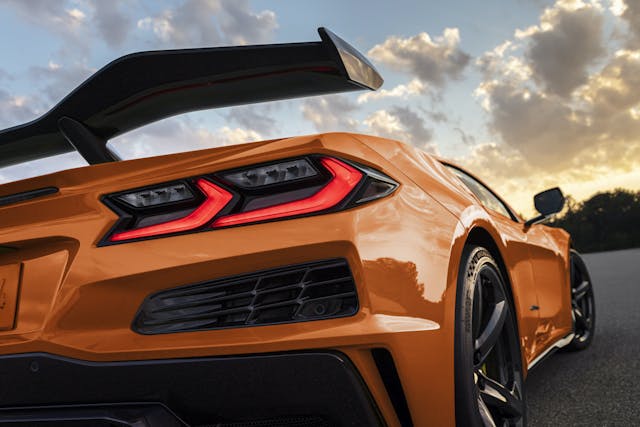
The new Z07 option now includes carbon-ceramic brake rotors, which are 15.7-inches in diameter in front and 15.4-inches in back. The FE7 Magnetic Ride Control and Michelin Sport Cup tires also part of Z07. Possible additions include a full carbon aero package that produces 734 pounds of down force and carbon-fiber wheels that trim 41 pounds of curb weight.
Production at the Bowling Green, Kentucky, assembly plant has already begun. The base price is $109,275 including gas guzzler charge but without the typical dealer greed adjustment. If you didn’t plan ahead with an early deposit, you’re definitely late to this Z06 party; the 2023 model year is sold out. And that glow you see in the heavens? That’s Zora beaming down in delight.
Check out the Hagerty Media homepage so you don’t miss a single story, or better yet, bookmark us.
The post How the Corvette Z06 went from ’60s racing package to modern monster appeared first on Hagerty Media.
]]>

This week, “The Hack Mechanic” answers questions from Hagerty Drivers Club magazine:
Eric Weil writes: I have a ’62 Corvette. As my wife and I age, the standard steering is getting to be too much. I’m considering converting to power steering, but I am uncertain if I should convert to electric power assist or to standard power steering requiring a new power brake cylinder.
Rob Siegel answers: You have three options: 1) Fit a pump and a power-assisted steering box to the original front end; 2) Fit an electric assist to the original front end; or 3) Replace the front end with a power-assisted rack-and-pinion unit. Like many things, it comes down to effort, complexity, cost, and how far you want to move away from originality.
The electric power-steering assist kits are the least invasive, as they use an electric motor mounted in the steering column under the dash and leave the rest of the steering alone. The EPAS Performance kit costs about $1450 but requires cutting your existing steering column. For about $2300, the EZ Electric Power Steering kit comes with its own integrated column, letting you stash your original one. The Steeroids gives you pump-driven power assist and updates the entire steering of the car, replacing the steering box and kingpins with a rack-and-pinion setup, reportedly eliminating the bump steer associated with the original system. At $3500, however, it ain’t cheap.
If you’re satisfied with the way the car steers, the existing steering is in good shape, and you want to make only minimal changes from stock, then I’d go with the electric EZ system. If, however, the front end needs rebuilding anyway, and you want power assist with generally improved steering, check out the Steeroids system.

Jim McDougal writes: I have a problem with the fuel gauge in my ’61 Corvette. For a few years, it read OK when the car was stopped but bounced around between accurate and full when the car was moving. It now always registers full when the ignition is on. I have tried to jumper the gauge ground, but that didn’t work. The sender unit checks out fine. Taking the gauge out is doable but difficult, so any ideas are appreciated.
Rob answers: You say the gauge is no longer bouncing, but a jumpy gauge is a common problem in C1 Corvettes, caused by the use of a shared ground between the tank and the rear lights. The fix is to jumper not the gauge but the sender—to give it its own dedicated ground connected directly to clean metal on the frame. You need to isolate the problem to the gauge, the sender, or the wiring. Check the back of the gauge. The “I” terminal should be receiving 12 volts. The “S” terminal should be connected to the brown wire from the sender, which provides a variable resistance between it and ground. Zero resistance should read empty; 30 ohms or more should read full.
You can test the gauge by disconnecting the brown wire from the “S” terminal and cracking the key. With it disconnected, it should read full. Then connect a jumper wire from the “S” terminal to a perfect ground and crack the key. It should read empty. The problem may simply be that there’s not a good connection between the gauge and the sender, or between the sender and ground.
***
Rob Siegel’s latest book, The Best of the Hack MechanicTM: 35 years of hacks, kluges, and assorted automotive mayhem, is available on Amazon. His other seven books are available here, or you can order personally inscribed copies through his website, www.robsiegel.com.
The post Corvette Conversions: Steering solutions and fuel gauge fixes appeared first on Hagerty Media.
]]>
Chevrolet’s hot-rod Tahoe cribs cop brakes, suspension
Intake: The 2023 Chevrolet Tahoe RST Performance Edition has rolled all of the road-hugging suspension from its police-pursuit cousin and paired it with an intake and exhaust system from Chevrolet Performance for a total of 433 horsepower and 467 lb-ft of torque. That’s an additional 13 hp and 7 lb-ft of torque over the standard 6.2-liter V-8, making this the most powerful Tahoe yet. The RST Performance Edition raided the police pursuit Tahoe for its beefy Brembo brakes and 275/55R20 Firestone Firehawk Pursuit tires as well as its springs, dampers, and chassis tuning. It results in a ride height that’s 0.4 inches lower in the front and 0.8 inches lower in the rear. The added power drops 0-to-60-mph sprints by almost two-tenths to 5.78 seconds, while the quarter-mile elapsed time comes down a full two-tenths compared to the standard RST with a 14.2-second time. Further, the big Brembos and grippy Firestones shaved more than six feet of the SUV’s 60-to-0 stopping, now measuring just 133 feet. To cap it off, the RST Performance Edition comes with the same 7600-pound towing capacity as the standard 6.2-liter RST.
Exhaust: This new package is giving us Tahoe Limited vibes from the end of the GMT400 days, and that’s a good thing. Unlike that short-lived option set, this one adds real power gains. We’re all for performance packages that actually boost output and aren’t just cosmetic. Blues Brothers jokes aside, the slightly lower stance should also improve handling, and stopping a few feet shorter thanks to brakes that are 25-percent larger in diameter could make a big difference in panic halts. —Brandan Gillogly
IndyCar’s Alex Palou sticks with Ganassi for 2023

Intake: Two for one isn’t that bad for the McLaren IndyCar and Formula 1 teams. McLaren team principal Zak Brown went after Chip Ganassi Racing’s Alex Palou, and on the Formula 1 side, sought Alpine’s Oscar Piastri for one of its F1 cars. McLaren got Piastri, but lost out on Palou, who Wednesday said he decided to stay with Ganassi. A bonus for Palou: He claimed on Twitter that he might get to test McLaren F1 cars.
Exhaust: It was an off year for 2021 IndyCar champ Palou, with his only victory of 2022 coming at the finale last Sunday at WeatherTech Raceway Laguna Seca, with the season ending in a fifth-place points position, well behind the 2022 champ, Team Penske’s Will Power. It’s thought that Palou began listening to McLaren’s offer when he became convinced he wasn’t getting the best equipment, but apparently Chip convinced him otherwise. Still, it made for an odd victory lane ceremony. –Steven Cole Smith
Corvette’s “build your own engine” is back

Intake: During the 28th anniversary celebration at the National Corvette Museum in Bowling Green, Kentucky, Corvette owners got a surprise during Corvette Director Kai Spande’s final announcement: The LT6 (that’s the Z06 motor) Engine Build Experience would resume next spring. The program will allow buyers to help build their own 670-horsepower, flat-plane crank V-8 at the Performance Build Center. “We’ve done some things the customers who build their engine will appreciate,” said Spande; rather than join in with the assembly line builders, the plant will have an area only for enrolled customers, where they will work on their engines alongside Corvette engineers.
Exhaust: No price has been set for the Experience, but Corvette Blogger says that when the program applied to C7-generation buyers, it cost $5000. It’s expected to be considerably more than that this time around. But we’d think going hands-on with your own car is worth it. –SCS


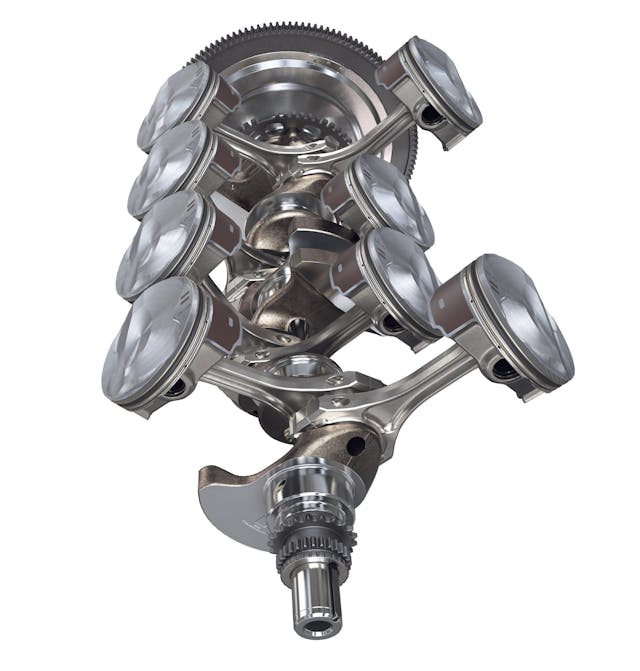
Very orange “King Daytona” Charger takes Hellcat Redeye to 807 hp

Intake: Dodge has announced its fifth of seven “Last Call” models that commemorate the outgoing Charger and Challenger. It’s the 2023 Dodge Charger King Daytona, which traces its lineage to a West Coast drag racing icon, “Big Willie” Robinson, who nicknamed his 1969 Dodge Charger “King Daytona.” The King Daytona, essentially a Charger SRT Hellcat Redeye Widebody with more muscle, has Go Mango paint, orange accents and an 807-horsepower V-8. The Dodge Charger King Daytona follows the previously announced Dodge Challenger Shakedown, Dodge Charger Super Bee and Dodge Challenger and Charger Scat Pack Swinger models.
Exhaust: No price or ordering info yet; that will happen this fall. The next “Last Call” model will be announced September 21, and the last at the SEMA show in Las Vegas, which runs from November 1-4. It will be interesting to see how strong the buyer interest is for seven models spread across the Dodge performance spectrum. So far, this is the most powerful and most orange. –SCS

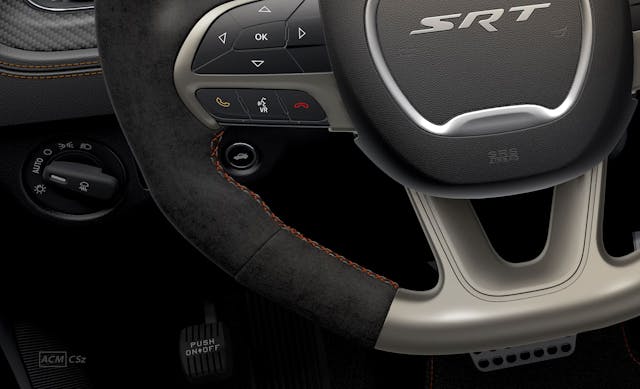



The last 16 new OG Defenders are for sale

Intake: British Land Rover tweaker Twisted ordered 200 Defenders in 2015 to fuel its business and now the final 16 are up for grabs after being stored in a barn for the last six years. With less than 30 miles on the odometer these Defender 110s were some of the last off the production line, and were hand picked by Twisted founder Charles Fawcett: “I went to the Defender production line at Solihull to meet the men and women building the vehicles. These 16 110s were hand-picked for their chassis numbers and build dates. They were all registered in 2016 —after production ceased—identifying them among the last off the line and, arguably, more collectible. They’re special, and when Twisted, each one will be unique. All of the 16 will be Twisted, but exactly how depends on the lifestyle and tastes of the customer. The Twisted way isn’t to tell people what their Defender should be; it’s to work with them to create a Defender that’s the best fit for them.” Prices start at £135,000 ($155,600) plus taxes and build slots open in 2023 to mark 40 years since the 110 was launched.
Exhaust: Fawcett is clearly a man with foresight. Hiding these Defenders away for the last six years can only have added to their value, even before they get a signature Twisted treatment. —Nik Berg
Ford to dealers: Stop fleecing our customers, upgrade your facilities

Intake: Ford told its dealership network how the brand is operating in the future, most notably that all Ford EVs must be sold at “non-negotiable” prices. While not applicable to fossil-fuel powered Fords, another change is an upgrade to support EV charging. Ford has two tiers of compliance: The “Model e Certified Elite” dealership requires a $900,000 investment (including the installation of two DC fast chargers, at least one public-facing) to get the benefit of receiving EV inventory and demonstrator models. The “Model e Certified” dealership requires a $500,000 investment (mostly for a single, public-facing DC fast charger) with less available inventory and no dealer demos. The upgrade is intended as a cooperative effort, as Ford CEO Jim Farley told Automotive News: “We’re not so excited or dogmatic that we want a certain number of people to take it that we’d look past the financial viability of it.”
Exhaust: This news comes as no surprise to some, as Ford took a lot of heat online when journalists and EV influencers found examples of dealers gauging would-be customers with “market adjustments” to F-150 Lightning and Mustang Mach-E. While we can thank Tesla’s one-price business model for changing how the game is sold, those who wanted to be the first Ford EV owner in town via pen stroke to checkbook will be sorely disappointed. Considering the positive momentum of EVs across the country, dealers will be wise to upgrade their facilities to fall into compliance, even if its harder for the smaller, rural, and family-owned dealers in the short term. At least Ford knows to be flexible to its diverse dealer body. —Sajeev Mehta
Shown in full, GranTurismo gets in-house Nettuno V-6



Intake: Having revealed the electric Folgore version in its natural habitat of California, Maserati has headed back home to showcase the new GranTurismo with gasoline in its veins. Shown on the streets of Modena, and powered by a version of the twin-turbo Nettuno V-6 that made its debut in the MC20, and has since been installed in the Grecale SUV, the GranTurismo will be offered in Modena and Trofeo specifications. The Modena version is expected to offer up 523 hp while the racier Trofeo will get the full 621 hp as delivered in the MC20. From the outside it doesn’t look much different from the car that first entered showrooms in 2007, but clearly its under the skin where all the effort has been put in.
Exhaust: Maserati has had a GranTurismo-sized gap in its lineup since 2019 and, much rides on its success. The Nettuno is an epic engine that will provide the power and aural stimulation GranTurismo buyers have always enjoyed, however ultimate speed will come from the electric Folgore. Which will prove more popular? —NB

The post Hot-rod Tahoe cribs cop kit, “King Daytona” Charger tops 800 hp, GranTurismo officially shown appeared first on Hagerty Media.
]]>
Callaway Cars will supercharge your C8 Corvette to Z06 territory
Intake: Callaway Cars, the Old Lyme, Connecticut-based tuning house behind the iconic 255-mph Sledgehammer C4 Corvette, has announced a supercharger kit for the C8 Corvette. The kit was previewed to attendees of the Corvettes at Carlisle event in Pennsylvania, over the weekend. Configured for the C8 Corvette’s LT2 V-8, which already has 495 hp and 470 lb-ft of torque, the supercharger system will come with its own three-year/36,000-mile powertrain warranty that supplements the Corvette’s existing warranties. Callaway says the kit will undergo final engineering tweaks, emissions compliance testing, and performance wringing in the coming months, at which point the final figures for power gains and performance improvements will be announced. Interested in juicing your C8 with some supercharger whine and a heap of extra grunt? Callaway is taking $1000 deposits for serialized production slots now.
Exhaust: Callaway has already announced a performance upgrade for 6.2-liter and 5.3-liter V-8-equipped GM vehicles such as the 2021–23 Chevy Suburban and Tahoe, the 2022–23 Chevy Silverado, the 2021–23 GMC Yukon and Yukon XL, as well as the 2021–23 Cadillac Escalade. The $24,95-and-up kit uses an Eaton supercharger and adds as much as 182 hp to the 6.2-liter-equipped models. Using those power gains as a reference point, we may be looking at a nearly 700-hp C8 Corvette. That’s north of Z06 territory! (The eagerly anticipated C8 Corvette Z06 boasts 670-hp from a 5.5-liter flat-plane-crank DOHC V-8.) Yes, the Z06’s appeal lies in more than just its yowling engine but consider this: The base C8 1LT starts at $65,595 including destination. If the Callaway bits come in at roughly the same price as its current kit, you’re looking at just over $90,000 for a car with even more power than the Z06—which we’ve already confirmed will be a six-figure car. The Callaway upgrade may be the better choice for cost-conscious, power-hungry clientele. — Nathan Petroelje



Honda, LG Energy Solution joining forces to produce EV batteries in the U.S.

Intake: Two years after announcing a partnership with General Motors to produce two future Honda EVs, Honda has announced a $4.4 billion joint venture with LG Energy Solution to build a new battery manufacturing facility in the United States. The plant aims to have an annual production capacity of approximately 40GWh, enough to power 800,000 vehicles by 2030. The pouch-type batteries produced at the new plant will be supplied exclusively to Honda facilities in North America. Its location has not yet been determined, but construction is expected to begin in early 2023, with a goal of starting mass production of advanced lithium-ion battery cells by the end of 2025. By producing the batteries in the U.S., Honda will qualify for the increased EV tax credits by meeting the more stringent requirements of the recently enacted Inflation Reduction Act. However, Honda has been consistently critical of the pro-union subsidy plan because it offers higher credits for union-built EVs, and Honda does not use union labor.
Exhaust: Honda and LG Energy officials ignored the elephant in the room and steered clear of political differences when announcing their partnership. Instead, the two say they are focused on their “shared belief” that expanding local electric vehicle production and ensuring the timely supply of batteries will put them in the best position to target the growing North American EV market. We can’t argue with that, regardless of any additional outside factors that may have played into their decision to join forces. — Jeff Peek
That goofy GT350 mule was indeed packing a Godzilla V-8
Intake: Months ago we saw a Shelby GT350 test mule with a bizarre hood bulge, which Ford is now confirming housed the 7.3-liter “Godzilla” truck engine. Ford Performance employees feature the REVan Evan YouTube channel show how the prototype, which prior to this integration was sitting around otherwise unused, blends a manual transmission calibration for the crate V-8. Those looking for a stick-shifted Godzilla crate motor will get the chance in the fall (the automatic is already available), but one look at the Shelby and it’s clear the truck’s intake manifold is a major issue. Fear not: Ford Performance is making more a car-savvy intake with a straight-shot throttle body.
Exhaust: As Hideto Ogata said in the famous movie, “You have your fear, which might become reality; and you have Godzilla, which is reality.” The act of fitting it to a manual transmission is a given for a crate motor, but the new intake manifold that will fit in more applications is beyond delightful. Will this OHV Ford soon rival the ubiquity of the LS swap? We shall see. – Sajeev Mehta
Scottish startup has its sights on the U.S.A.

Intake: Scotland isn’t exactly well-known for its automotive industry, but new EV manufacturer Munro Vehicles wants to change that. The firm has developed an $88,500 commercial 4×4 and is targeting North American businesses in mining, farming, forestry, and even oil. Munro’s 376-hp electric off-roader features permanent four-wheel drive and locking differentials to give it serious go-anywhere ability with zero tailpipe emissions. The range is limited to around 170 miles, which is why the company is going for the commercial market. Munro will build just 50 cars in 2023, with half set for export to the U.S.A. and Canada, but the firm plans to scale up to 500 units in 2024, and 5000 by 2030. Should demand outstrip supply, then Munro will produce knock-down vehicle kits which could be assembled in the U.S.A and allow it to qualify for the latest $7500 EV tax subsidy.
Exhaust: Munro hasn’t released key information such as payload and towing capacity, but it’s hard to see how it can compete with the likes of the Rivian R1T or the Ford Lightning. They’ll need the luck of the Irish—sorry, Scottish—to succeed. —Nik Berg
One Lady owner Ford Escort fetches over $850,000 at auction

Intake: A 1985 Ford Escort RS Turbo driven by Her Royal Highness, Diana, Princess of Wales for almost three years has just set a right royal record at Silverstone Auctions in the United Kingdom. The People’s Princess was quite the Blue Oval aficionado, but this was her fastest Ford. Diana’s engagement to Prince Charles gave her an Escort Ghia, while this Series 1 RS Turbo was an early family car, with the young princes William and Harry often riding in the rear. Up front would always have been an officer from the Royal Protection Command, known as SO14. According the auction house, the RS Turbo was a stealthy black instead of the standard white at the royal family’s request. SO14 had previously vetoed the princess’s first choice of a red Escort cabriolet. In May 1988 the RS was returned to Ford and sold internally to a manager, appropriately named Geoff King. Later the Escort was offered as a prize on radio station, before being picked up by the latest owner in 2008—a Mr. Windsor. Having collected the whopping £730,000 ($852,000) fee for the car, he could almost afford his own castle now.
Exhaust: A study by Hagerty U.K. confirmed Princess Diana as the most powerful member of the monarchy when it comes to commanding a premium for royally-appointed automobiles. Tallying up four sales, the number crunchers reckoned that having the People’s Princess as a previous owner increased the value of a car by 813 percent. With equivalent Escorts optimistically advertised for £30,000 ($35,000) this latest sale represents an astonishing 2,433 percent rise. —NB
Porsche’s IPO plans are coming along nicely despite market headwinds

Intake: Sources inside Porsche tell Automotive News and other publications that the company expects a valuation as high as $85 billion when it proceeds down the long road to an IPO, perhaps as early as September, based on perceived buyer demand. The names of potential buyers being floated include Red Bull’s Dietrich Mateschitz, T. Rowe Price Group, Qatar Investment Authority and LMVH Chairman Bernard Arnault. Some analysts are surprised that Porsche is going ahead with the IPO in this current market climate affected by inflation, high fuel prices, and the war in Ukraine, but Porsche seems to have confidence that it’s the right time. Parent group Volkswagen and Porsche SE, the company’s biggest shareholder, would have to make a recommendation on the flotation first.
Exhaust: The IPO is not expected to change the way Porsche does business, except maybe to put some money in Porsche’s pockets to help fund further electrification. Only a small percentage of Porsche will be up for grabs, and the shares have no voting rights. VW, and new VW and Porsche head Oliver Blume, will continue on the path already laid out. — Steven Cole Smith
The post Callaway supercharges the C8, Mustang flirts with Godzilla V-8, royal sum for Princess Diana’s Escort appeared first on Hagerty Media.
]]>
While scrolling through a Corvette forum one day, Doug Manista discovered a 1981 Corvette race car that was about to meet its final destination: the cold steel of a car crusher in French Lake, Minnesota. In an instant, the California native was on the phone with a junkyard halfway across the country. A sale was negotiated, and the Corvette’s life was spared.
In a past life, this C3 was a venerable road racer at the hands of Jim Sanborn. The Waterloo, Iowa driver and his widebody Corvette shared the track with the likes of Willie T. Ribbs, David Hobbs, Elliott Forbes-Robinson, and Paul Newman during ’80s Trans-Am competition. Unlike many of the tubeframe beasts that they dueled, the Corvette sat on a stock 1976 chassis. A handicap, no doubt. Still, Sanborn was able to eke out impressive finishes at places like Mid-Ohio and Road America, squarely in the top half of the run sheet.


All good runs come to an end, and eventually the Vette was retired after its last race, an SCCA gathering at Land O’Lakes Raceway in August 1991. Not long after, the decommissioned C3 was tucked away in a Minnesota barn, where it sat for 28 years.
“It was full of dead rats when I found it,” says Manista, gesturing at his reborn racer, parked in the paddock of WeatherTech Raceway Laguna Seca during 2022’s Monterey Motorsports Reunion. The avid racer, who frequently competes in the vintage scene with his two sons, already had a triumvirate of high-polish C2s with pedigrees—a 1963 split-window, a 1965 Fuelie roadster, and a 1965 coupe—so he opted to go a different route with the barn find. After cleaning out the vermin, he sorted the mechanicals, which included original Hurst Airharts (sourced from a DC 3 airplane). Ultimately, however, he left the car untouched.
“I just used some toilet bowl cleaner to put the shine back in the wheels,” says Manista. “It still has the old SCCA sticker on the door.”


The orange-and-white Corvette is a total time capsule, from the deep-dish chrome wheels to the stone-chipped fiberglass nose. (If body panels could talk!) Don’t let the blemishes fool you, though. This thoroughbred gets up and goes, thanks in part to the 355-cubic-inch small-block hunkered underneath the massive air scoop. “Only the block, heads, carburetor, and fuel cell are new parts on this car,” says Manista, who laid down a 1:38 at Laguna Seca on a pair of two-year-old tires during practice for the 2022 Reunion. Then, disaster.

Coming out of Andretti Corner, the big Vette sheared one of its original rear axles. Manista expedited the shipment of a new stick to the track so that he and his crew could install it the next day and have the car ready for the race weekend. But when the new axle arrived, much to his dismay, it had a different flange. Eventually his crew developed a quick fix and the new one was installed.
By Saturday, Manista’s barn find Corvette was back on track—this time with Chris Hines in the drivers seat—dicing it up with the Mustangs and Camaros it once faced in the Trans-Am series more than three decades ago. Hines finished an astounding second in class. From dead rats to fast laps, this Corvette has seen it all and, under Manista’s care, it’s poised to live at least another three decades.

The post Saved from the crusher, barn-find Corvette roars back to racing life appeared first on Hagerty Media.
]]>